December 13th 2022
MP wrongly suggested 436 transgender women committed rape between 2012 and 2018, says Crown Prosecution Service
Bethany Dawson Apr 6, 2022, 4:57 PM
- Sir Bernard Jenkin MP said 436 transgender women committed rape between 2012 and 2018.
- The CPS has told Insider that this is not a correct reading of their data, and Jenkin is incorrect.
- One MP has called on Jenkin to withdraw his comments, saying he is “fanning the flames of hate.”
Top editors give you the stories you want — delivered right to your inbox each weekday. Email address By clicking ‘Sign up’, you agree to receive marketing emails from Insider as well as other partner offers and accept our Terms of Service and Privacy Policy. Sponsored Content by Twilio Meet 6 inspirational leaders creating a better future for developers
A Conservative MP wrongly suggested 436 transgender women committed rape between 2012 and 2018, the Crown Prosecution Service (CPS) has confirmed.
Speaking at an International Women’s Day debate in the Houses of Parliament on 10 March, Sir Bernard Jenkin MP set out his concern that transgender women commit violence against cisgender women. He said:
“Nearly all violence against women is committed by men, but there is a new and growing category of violence against women committed by people who call themselves women but are biologically male. We should always respond positively to people with genuine gender dysphoria, and I deliver this speech with kindness in my heart, but the Sexual Offences Act 2003 defines rape as when a person “intentionally penetrates the vagina, anus or mouth of another person…with his penis” without consent.
The Crown Prosecution Service reports that between 2012 and 2018 more than 436 cases of rape were recorded as being committed by women. The penis is a male organ, so these rapes are committed by men presenting themselves as women.”
Comment Rape was significantly redefined by U.K’s New Labour Governments to include unwanted kissing or physical contact from men. In spite of significant evidence , violence from women on men and their childen is at least as high as that toward women from men. Women also exceed males in harming children. However , it is not taken seriously and usually regarded officially and colloquially, as the men provoking it. Again, evidence that women provoke a lot of domestic violence is ignored, the popular, official and media view being that women never lie. Police are under great pressure to accept this because political masters desperately compete for the feminist vote, which is what Patrick Jenkin is doing.
Feminists have an enormous problem with MTF Transsexuals. They are more comfortable with gay men who are non threatening and happy to be patronised by women. Hate speech only applies where it suits the PC consensus. Transwomen present competition ,often presenting a traditional feminine image, behaviour pattern and value system. Women led by feminists abhor that and have to fight.
There is also the problem that men are increasingly wary of dictatorial tyrannical know all self righteous feminism. So we have increasing MTF women ,along with male admirers. Parliament is riddled with opinionated feminists favourably represented by feminised elite media. Together , they viciously asert the view that only they must refine how males are redefined to suit their requirements. Men are required to change to fit with them in a society embracing feminism as a core value system. Social and economic consequences have been horrendous and on going -notably family collapse and rising youth suicide and mental illness.. R J Cook
September 25th 2022
Transposing by Miss Roberta Jane Cook

I suggest this picture purveys my claim to femininity as my true identity, truth and ultimate complex obvious need. Completion of sex cahnge was overdue and denied me when police told doctors lies that I had sent pictures of a private personal nature, porn videos which did not exist, offensive letters to sensitive parties accusing mysellf anonymously of working as a s ‘ gay escort’ in a home based brothel for my son and his associates. There was no evidence or sign of investigation. All was presented as truth to the GIC for the purpose of destroying my transgender credibility and keeping me under surveilance..
I, as did my ex wife, knew my marriage was over by 1988, but we have to be treated as freaks and forced to conform , as through devices like Myers – Briggs test to get a job.
I stayed married to protect my children in a world that sanctifies sis women regardless of what they do . These sis women perceive us trans ladies as a threat to their efforts to both masculinise their gender while behaving like the worst power maniacs and little Hitlers.
They can say what they like about us but want hate laws and restraining orders to keep themselves and ‘their children safe.’ They perpetuate the myth that sis women never lie, are always victims , care for children ( ironic an Irish woman recenly locked her toddlers into her car and set it on fire ) and fight for equal rights. If it had been a man, there would have been a national self righteous media outburst asserting the need to do more to control male violence It is against this background of liars , posers , manipulators and cheats that the Briggs- Myers job personality test should be judged.
It is very difficult being a transwoman, especially when the police involeve themselves passing messages via the GP declaring me to be a paranoid schizophrenic bi polar delusional and not needing hospital yet but joint medical and police monitoring along with powerful anto psychotic drugs, with alarming side effects including bowel, bladder contro , balance , memory, speechl and dementia.
After nearly 3 years as a patient due for Gender Reassignment Surgery, this and my hormones were stopped, with alarming physical, psychological, social and economic consequences. The4 police for legal reasons I cannot discuss, have hammered home the view to all in sundry, including the medical professional who reported that I have a ‘secure female identity.’ am a fake, a TRANS POSER.
Asking how the relevant pyschiatrists who broke all the rules of diagnosis, did I become so labelled, there was stony silence and the offical reofcrd that I was’ more likely to die by misadventure than suicide.’ A report noted that ‘If Roberta saw all the records about her she would be very upset.’ Both my GP and the gender Identity Clinic have put in writing, and I have reecoded my GP telling me, that they need police permission to disclose them.
This permission as with all records on me has been denied. It is almost funny that they label me paranoid – the clinical definition being ‘abnormal suspicion’. Schizophrenia is multiple personality and hearing voices ( so which one of me is writing this and who is telling me what to write ?) , bi polarism is severe up and down mood swings, delusion is having no sense of reality. Reality was one of the big questions I had to consider when obliged to study philosopy during my first year at University of East Anglia, but these days the police decide what it is !
Added together it is a serious psychosis requiring mind numbing drugs. The GIC ( Gender Identity Clinic ) estimates 90% of its patients are mentally ill but less likely to commit suicide if they have sex change treatment. But the final diagnostician in my case is the police. To them I am a Transposer Transvestite who gets sexual kicks from wearing female clothes as was made clear to me by a party I cannot name, last June. But the source was evident laying on the party’s desk !”
September 19th 2022
Don’t Insist on Being Positive—Allowing Negative Emotions Has Much to Teach Us
Leaning into difficult feelings can help you find the way forward, according to a refreshing new wave of books, says Jamie Waters.
- Whitney Goodman
More from The Guardian
- Consumed by anxiety? Give it a day or two14,415 saves
- Silence Your Inner Critic: A Guide to Self-Compassion in the Toughest Times1,419 saves
- Why Your Most Important Relationship Is With Your Inner Voice3,156 saves
Advertisement

‘Complaining is natural because language converts a “menacing cloud” into “something concrete”. Photo by erhui1979/Getty Images
Eight years ago, when Whitney Goodman was a newly qualified therapist counselling cancer patients, it struck her that positive thinking was being “very heavily pushed”, both in her profession and the broader culture, as the way to deal with things. She wasn’t convinced that platitudes like “Look on the bright side!” and “Everything happens for a reason!” held the answers for anyone trying to navigate life’s messiness. Between herself, her friends and her patients, “All of us were thinking, ‘Being positive is the only way to live,’ but really it was making us feel disconnected and, ultimately, worse.”
This stayed with her and, in 2019, she started an Instagram account, @sitwithwhit, as a tonic to the saccharine inspirational quotes dominating social media feeds. Her posts included: “Sometimes things are hard because they’re just hard and not because you’re incompetent…” and “It’s OK to complain about something you’re grateful for.” It took off: the “radically honest” Miami-based psychotherapist now has more than 500,000 followers.
Goodman’s 2021 book, Toxic Positivity, expands on this thinking, critiquing a culture – particularly prevalent in the US and the west more broadly – that has programmed us to believe that optimism is always best. She traces its roots in the US to 19th-century religion, but it has been especially ascendant since the 1970s, when scientists identified happiness as the ultimate life goal and started rigorously researching how to achieve it. More recently, the wellness movement – religion for an agnostic generation – has seen fitness instructors and yogis preach about gratitude in between burpees and downward dogs. We all practise it in some way. When comforting a friend, we turn into dogged silver-lining hunters. And we lock our own difficult thoughts inside tiny boxes in a corner of our brains because they’re uncomfortable to deal with and we believe that being relentlessly upbeat is the only way forward. Being positive, says Goodman, has become “a goal and an obligation”.
Toxic Positivity is among a refreshing new wave of books attempting to redress the balance by espousing the power of “negative” emotions. Their authors are hardly a band of grouches advocating for us to be miserable. But they’re convinced that leaning into – rather than suppressing – feelings, including regret, sadness and fear brings great benefit. The road to the good life, you see, is paved with tears and furrowed brows as well as smiles and laughter. “I think a lot of people who focus on happiness, and the all-importance of positive emotions, are getting human psychology wrong,” says Paul Bloom, a psychology professor at Yale and the author of The Sweet Spot, which explores why some people seek out painful experiences, like running ultra marathons and watching horror movies. “In a life well lived, you should have far fewer negative than positive emotions, but you shouldn’t have zero negative emotions,” adds Daniel Pink, the author of The Power of Regret. “Banishing them is a bad strategy.”
The timing of these new works – which also include Helen Russell’s podcast (following her book of the same name) How To Be Sad – is no coincidence. In light of the pandemic and now the conflict in Ukraine, it seems trite to suggest a positive outlook is all we need. Strong negative emotions – fear, anxiety and sadness – are a natural response to what’s happening around the world right now and we shouldn’t have to deny them.
These authors want you to know that “negative” emotions are, in fact, helpful. Russell talks about sadness being a “problem-solving” emotion. Research from the University of New South Wales shows that it can improve our attention to detail, increase perseverance, promote generosity and make us more grateful for what we’ve got. “It’s the emotion that helps us connect to others,” she adds. “We’re nicer, better people in some ways when we are sad.”
It’s tougher making an argument for regret, which might be the world’s most maligned emotion, but Pink is game. From a young age we are instructed to never waste energy on regrets. The phrase “No regrets” is inked into arms and on to bumper plates and T-shirts. Seemingly every famous person has a quip about living without regrets (I would know: as someone who tends to linger on thoughts of what might have been, I’ve read them all). Pink says we’re getting it all wrong. “A ‘No regrets’ tattoo is like having a tattoo that says ‘No learning’,” says Pink, who was also a speechwriter for Al Gore, speaking from Dallas, Texas. He became interested in this topic because he couldn’t shake his own regrets about the fact that, while a university student, he wasn’t kind to fellow pupils excluded at social events. “If it has bothered me for a month, a year, or in this case 20 years, that’s telling me: ‘Hey, you might not realise it, but you care about kindness,’” he says. “Regrets clarify what matters to us and teach us how to do better. That’s the power of this emotion – if we treat it right.”
The problem? We’re not taught how to effectively process these difficult emotions. A good starting point is to familiarise ourselves with these feelings by acknowledging them and sitting with them for a beat. That takes practice, says Goodman. “It can include learning how your emotions feel in your body, and what to call them. When we’re able to put a name to a feeling, it makes it less scary. And when something is known, we can figure out what we want to do with it.”
Telling others about it lightens the weight. Complaining is perfectly natural, says Goodman. And articulating it helps us pinpoint what it is that’s bothering us, because language converts this “menacing cloud” into “something concrete”, says Pink. That disclosure could be to a friend, therapist or total stranger. In his Regret Survey, 18,000 people anonymously shared their biggest regrets, while Russell suggests a “buddy” system, in which you make a reciprocal agreement with someone to talk about your worries without interruption. (A note, if you are comforting a friend: listen and ask questions rather than immediately reaching for pick-me-ups.)
Your next step will likely depend on the nature – and severity – of the emotion. To help us sit with sadness, Russell advocates being in nature. Cultural pursuits can help, too. “It sounds a little ‘woo’, but there are lots of studies about the effectiveness of reading therapy and looking at a piece of art – and how music can change our moods,” she says. “Sad music can act as a companion when we’re feeling sad, rather than making us feel lower. I do think it’s liberating when you finally kind of surrender to it all.”
Pink, whose approach is a little more structured, differentiates between regrets of action (wrongs you’ve committed) and inaction (opportunities not seized). For both, you must comfort yourself with the knowledge that everyone has regrets – and recognise that that single thing doesn’t define you. “Don’t look at a mistake as St Peter at the gate passing final judgment on your worth,” he says, but as “a teacher trying to instruct you.” He recommends stepping outside yourself and considering what you would recommend a friend do in a similar situation, whether that’s making amends for past acts, grasping a new opportunity, or ensuring you don’t make a similar misstep in the future.
Crucially, processing negative emotions “should all feel somewhat productive in the end”, says Goodman. Meaning: instead of ending up in a funk of wallowing, with your feelings replaying on a loop, “the wheels are turning, you’re making connections, you’re figuring things out,” she says. That doesn’t mean you need to come out of it feeling happy, or with a neat fix. “Sometimes you just get to a place where you say, ‘That was really hard, and now it’s over or now I’m not dealing with that any more’,” says Goodman. “And if it comes up for me again, I’ll deal with it.”
Leaning into negative thoughts should ultimately leave you with a sense of fulfilment. While we might instinctively think that filling our days solely with joy and excitement is the dream, “if we want to live a meaningful and purposeful life, a lot of pain is going to be part of it”, says Bloom. “What I really want is for people to be able to enjoy the full range of the human experience,” adds Goodman. Armed with the knowledge that you can do it in a methodical way, don’t be afraid to let the darkness in.
September 10th 2022
Full text links

Actions
Share
Page navigation
- Title & authors
- Abstract
- Comment in
- Similar articles
- Cited by
- Publication types
- MeSH terms
- Personal name as subject
- Related information
- LinkOut – more resources
J Psychiatr Pract
. 2012 May;18(3):221-4. doi: 10.1097/01.pra.0000415080.51368.cf.
Inevitable suicide: a new paradigm in psychiatry
Benjamin J Sadock 1 Affiliations
- PMID: 22617088
- DOI: 10.1097/01.pra.0000415080.51368.cf
Abstract
The author suggests that a new paradigm may be needed which holds that some suicides may be inevitable. The goal of this paradigm would be to diminish the sense of failure and inadequacy felt by many psychiatrists who experience the suicide of a patient and to increase understanding of the unique biopsychosocial profile of those whose suicides appear to be inevitable. The author stresses that this proposed paradigm should not be misconstrued as therapeutic nihilism but rather should serve to stimulate efforts to treat this patient population more effectively. Risk factors that place individuals at high risk for suicide are reviewed, including presence of a mental illness, genetic predisposition, and factors such as a history of abuse, divorce, unemployment, male gender, recent discharge from a psychiatric hospital, prior suicide attempts, alcohol or other substance abuse, a history of panic attacks, and persistent suicidal thoughts, especially if coupled with a plan. The author notes that, in those suicides that appear to have been inevitable, risk factors are not only numerous but at the extreme end of profound pathology. The example of Ernest Hemingway is used to illustrate how such a combination of risk factors may have contributed to his eventual suicide. Psychiatrists, like other doctors, may have to acknowledge that some psychiatric disorders are associated with a high mortality rate as a natural outcome. This could lead to heightened vigilance, a more realistic view of what can and cannot be achieved with therapy, and efforts to improve the quality of life of patients at high risk for suicide with the goal of reducing this risk and prolonging their lives. (Journal of Psychiatric Practice 2012;18:221-224).
Comment in
- Comment on “inevitable suicide”. Ellis TE. J Psychiatr Pract. 2012 Sep;18(5):318-9; author reply 320. doi: 10.1097/01.pra.0000419813.52881.52. PMID: 22995956 No abstract available.
- Consequences of “inevitable suicide”. Maniam T. J Psychiatr Pract. 2012 Sep;18(5):319; author reply 320. doi: 10.1097/01.pra.0000419814.30011.c0. PMID: 22995957 No abstract available.
Similar articles
- Prevention of suicide and attempted suicide in Denmark. Epidemiological studies of suicide and intervention studies in selected risk groups. Nordentoft M. Dan Med Bull. 2007 Nov;54(4):306-69. PMID: 18208680 Review.
- Ernest Hemingway: a psychological autopsy of a suicide. Martin CD. Psychiatry. 2006 Winter;69(4):351-61. doi: 10.1521/psyc.2006.69.4.351. PMID: 17326729
- Adolescent suicide. [No authors listed] Rep Group Adv Psychiatry. 1996;(140):1-184. PMID: 8721288
- [In-patients suicide: epidemiology and prevention]. Martelli C, Awad H, Hardy P. Encephale. 2010 Jun;36 Suppl 2:D83-91. doi: 10.1016/j.encep.2009.06.011. Epub 2009 Sep 26. PMID: 20513465 Review. French.
- The suicide of Anne Sexton. Hendin H. Suicide Life Threat Behav. 1993 Fall;23(3):257-62. PMID: 8249036
September 9th 2022
How to Spot the Potential Warning Signs of Suicide
Suicide expert Dr. Mark Russ on recognizing suicidal behavior, and how to help someone who is suffering and may be contemplating taking their own life.

14 Min Read •Mental Health • Story By Courtney Allison
Despite growing public attention and efforts to curb the country’s suicide rate, the statistics are sobering: Suicide is the 10th-leading cause of death in the United States, according to the American Foundation for Suicide Prevention. In 2017, more than 47,000 Americans died by suicide, a 33% increase since 1999.
“Suicide is both a public health problem and, of course, an extremely individual one,” says Dr. Mark Russ, vice chair for clinical programs and medical director at NewYork-Presbyterian Westchester Division. “It’s critically important to continue to raise public awareness of suicide and suicide risk to try to get our arms around this, to do more research to understand the underpinnings of suicidal behavior, and educate people as best we can, including how to intervene on the level of families, schools, employers, and the medical community.”
Stressful life events are unavoidable, but it’s important to remember that painful feelings will not last forever, Dr. Russ emphasizes.
“I think many people feel that what they are feeling in the moment they will always be feeling, and therefore ‘I need to end this in some way,’” he says. “That is not true. We know that moments of emotionally intensely painful feeling tend to come and go. They don’t last forever; that is just sort of the way the brain works. Sometimes, just letting people know that what they are feeling now is not something they’re going to need to bear forever can help — that even if they do nothing, in time, they are likely to feel better.”
How do you know if someone you love is considering taking their life? And is there a way to help? Health Matters spoke with Dr. Russ to better understand what may drive someone to take their life, and potential warning signs of suicide.
Why do you think the suicide rate is rising?
Dr. Russ: It’s unclear why the rate is increasing. It could have to do with more people reporting it, or societal stressors. Some have speculated that it could be related to the opioid crisis, social media, availability of information, bullying, or copycatting. Financial concerns are also a huge stressor for many people.
Who is most at risk?
The rates are rising in middle-aged individuals, particularly among white men, as well as adolescents and young adults. There are also increases among the elderly and the African American community.
We can only speculate, but for a middle-aged man it could have something to do with financial stressors, phase of life, the prospect of losing one’s job, or actually losing one’s job, retirement without adequate resources, or interpersonal issues involving family or divorce. For young people, possible factors include social media stress in terms of bullying, and tremendous social stress around getting into and succeeding in college and beyond.
Suicide is highest in people with existing mental and psychiatric disorders. We believe that there is a genetic component to suicide risk, and we know from studies that suicide can run in families.
What could trigger suicide?
Any kind of a loss is potentially a trigger for thinking about ending one’s life. It’s important to note that there is no absolute scale for loss. You can’t judge the meaning or impact of a loss to an individual. A circumstance or event that one person might regard as relatively trivial may be extremely impactful to an individual based on their experience, their interpersonal dynamics and who they are in the world. Some people may be very sensitive to humiliation or to being slighted. One person may think that’s just a part of life, but for another person it may be devastating.
“Struggling with depression, anxiety, or having thoughts of suicide is not uncommon, yet many people seem to distance themselves from it — perhaps because it’s not the way that people want to see themselves.”
— Dr. Mark Russ
What are the warning signs that someone may be considering suicide?
- A change in someone’s mood or behavior, particularly along depressive and anxious lines, or isolating themselves. This can come across as either a sad mood, a feeling of disconnection, or social withdrawal. People at risk for suicide may isolate themselves. They may be quieter or not enjoy things the way they used to. Adolescents who used to love to engage in sports or play video games may stop doing that. If you get the sense that they are lacking pleasure in life, that is an extremely important warning sign.
- Any statements that express a sense of hopelessness, helplessness, or worthlessness are evidence the individual may be becoming depressed. People may make a direct or indirect comment about suicide. Often, they may use euphemisms, like “I can’t take this anymore,” “I’m at the end of my rope,” “I want to throw in the towel,” or “Not sure how much longer I can go on.”
- Changes in intake of alcohol or use of illicit drugs.
- Signs of intense agitation, anxiety, or feelings of tremendous inner pain. This is an extraordinarily important warning sign of suicide because it may suggest that they are going to act soon.
What do you do if you see these warning signs of suicide?
Awareness is most important. People may deny that they or a loved one could be considering suicide because it’s too painful a thought. The natural tendency is to minimize symptoms and risks when they see them in other people. A loved one, for example, who has just suffered a traumatic life event, or experienced a situation that is painful, problematic, or difficult, might be overwhelmed by it and might be thinking that this is not something they can take anymore. The first step is to consider the possibility that suicide is among the potential outcomes of the situation and to listen very carefully.
How can you be a good listener?
Being a good listener can be tough, and it’s what we in behavioral health spend many years of training to do, because the natural inclination for most people is to jump in and share their experiences, give advice, and make judgments, all of which may not really be helpful in trying to help somebody who may be going through a very, very tough time.
- Keep your ears open and resist the temptation to talk a lot. Be present for the person and don’t interject with “quick” or “easy” solutions. Understand that if there were a quick and easy solution, this person would likely have already thought of it.
- Convey a sense of caring and interest. This can be done nonverbally and verbally, but try to provide a validation and acknowledgment of their current situation without making a judgment about it. Show that you see they are extremely depressed or despondent, and ask if they can tell you more about it.
- Ask questions that are open-ended and allow the person to talk as much as possible. Allow periods of silence. It conveys a respect for the person and an interest, that you’re willing to forgo your own needs in the moment for the sake of helping them. It’s not easy to do, but important.
- Create the time and space for someone to open up. You want to create a space that is private and give them enough time to talk.
What else can someone do to help if they suspect someone is considering taking their life or see a potential warning sign of suicide?
It’s OK to come out and ask “Are you feeling suicidal?” It’s not going to put the idea in their head if it wasn’t there before. Some may say they don’t have suicidal thoughts because it may be too painful to admit or it may be embarrassing because of the stigma associated with mental illnesses and suicide. Sometimes, it’s better to ease into the question by using terms that are less charged, like “Are you feeling overwhelmed?,” “Are you feeling that you can’t go on?,” or “Are you feeling at the end of your rope?” The idea is to normalize the experience and show that it’s understandable for someone who has gone through something difficult to have these thoughts.
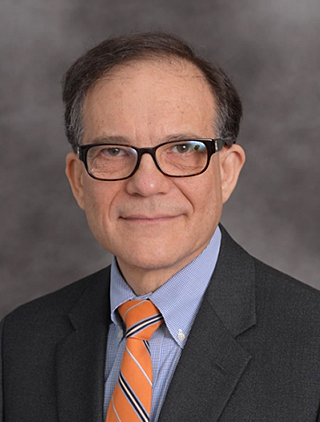
What else is important to know?
Getting someone professional help is critical. You don’t want to be in a situation where you are the lifeline for another human being. That is fraught with danger for that person and for you. Even if the person doesn’t kill themselves, they put you in an untenable situation that you’re not prepared for and will likely cause a great deal of anxiety for you. The best thing you can do is whatever you can to get that person into treatment. It may range from providing a suicide hotline number to actually calling the police and an ambulance to bring them to the emergency room, depending on the acuity of the circumstance.
What if someone has ongoing feelings of suicide?
Often, suicidal feelings can last a long time and be chronic. In addition to treatment, it’s important to create a safety plan. There should be a very clear, and preferably written, point-by-point plan of what a person will do if they feel suicidal. This is hopefully done in the context of treatment, but it’s important for the family to be aware of it whenever possible. The plan can include anything from providing a suicide hotline number to engaging in coping mechanisms they’ve learned as part of therapy, going to an ER, or calling a therapist, friend, or parent. Coping skills may include distracting behaviors, like walking around the block, taking a bath, or watching a funny movie — whatever seems to work for that individual. But a list of activities and steps that they are going to take before they act or harm themselves is useful and important.
Even if they are not suicidal in the moment, these feelings tend to recur. We should have the expectation that they’re going to feel this way again and help them anticipate the circumstances under which these thoughts or feelings are likely to emerge. A young adult with a history of becoming suicidal after they fail a test may not feel suicidal now, but might if they fail another test. Knowing the steps to take to help in the moment to get over the crisis is extremely important.
Is suicide an impulsive act?
Not always. Some people think about suicide for a very long time and plan carefully and basically make a decision that they feel is rational, although others would not agree, that their life is just not worth living. Others may be extremely impulsive, and the suicidal act may come at a moment of heightened emotion, in particular heightened anxiety and this sense of what we call psychic angst — pain in your being that just feels unbearable in the moment and may push someone to do something impulsively. Then, of course, there’s everything in between.
Can you predict who will take their life?
We cannot predict who is going to die by suicide. Most people who experience or exhibit warning signs of suicide don’t take their lives. There are many risk factors, but there is a lack of specificity in those risk factors. Many people get depressed or go through periods of hopelessness. For statistical reasons having to do with the relative infrequency of suicide and lack of specificity of any risk factor or group of risk factors related to suicidal behavior, it makes it impossible to predict who will die by suicide.
There is no blood test. There is no brain scan. There is no psychological test that can tell us if and when an individual will engage in suicidal behavior. We look for triggers and warning signs that have been associated with suicide risk in vulnerable individuals because it makes common sense to do so and can save lives. But in the end, we don’t know what is in the mind of that person who ultimately decides to take their own life. We don’t know that final thought because it’s never available to us. Because of that, there’s a certain degree of humility that I think all of us who work with people who struggle with suicidal feelings have to accept and understand.
Is there still a stigma around mental illness and suicide?
I think it’s getting better very slowly, but it is still a huge problem. Efforts of organizations like the National Alliance on Mental Illness are making an impact, and public figures coming out and sharing their mental health struggles helps too. But I think that the stigma remains a problem, particularly in some communities more than others. When there are cultural prohibitions or consequences to having a mental illness or getting treated for one, it makes it that much more difficult to access care.
Struggling with depression, anxiety, or having thoughts of suicide is not uncommon, yet many people seem to distance themselves from it — perhaps because it’s not the way that people want to see themselves. The sense of emotional well-being is so closely connected to who you are in the world. It’s different than if you have pneumonia or diabetes, if something happens to you — somehow the idea of mental illness isn’t viewed the same way, perhaps because it’s so closely aligned with a sense of self and identity — even though these are brain diseases.
How can people who have lost someone to suicide cope?
Be aware of your feelings and understand and accept the fact that you are going to have very strong feelings about what happened. That’s normal and appropriate, and you will need support. The extent of that support may be limited or may be extensive in terms of getting into therapy.
There is no constructive role for guilt or self-blame — there has already been one casualty, and we need not create any more. Feelings of guilt, loss, anger, and, of course, tremendous sadness are all natural feelings that can be dealt with and understood in the context of the circumstance.
If you are in crisis, please call the National Suicide Prevention Lifeline at 1-800-273-TALK (8255), or contact the Crisis Text Line by texting TALK to 741741.
Additional Resources
- For additional resources on suicide prevention, visit the American Foundation for Suicide Prevention, New York State Suicide Prevention, and the National Alliance on Mental Illness.
September 6th 2022
déjà vu
The Search for Scientific Proof for Premonitions
In the 1960s, a British researcher launched one of the largest ever studies of people who believed they could see the future.
 Ron Burton/Mirrorpix/Getty ImagesChildren looking over Aberfan, Wales, in the wake of the disaster there in 1966
Ron Burton/Mirrorpix/Getty ImagesChildren looking over Aberfan, Wales, in the wake of the disaster there in 1966
When it finally happened, shortly after nine o’clock in the morning on October 21, 1966—when the teetering pile of mining waste known as a coal tip collapsed after days of heavy rain and an avalanche of black industrial sludge swept down the Welsh mountainside into the village of Aberfan, when rocks and mining equipment from the colliery slammed into people’s homes and the schools were buried and 116 young children were asphyxiated by this slurry dark as the river Styx—the anguished public response was that someone should have seen this disaster coming, ought to have predicted it.
Someone did.
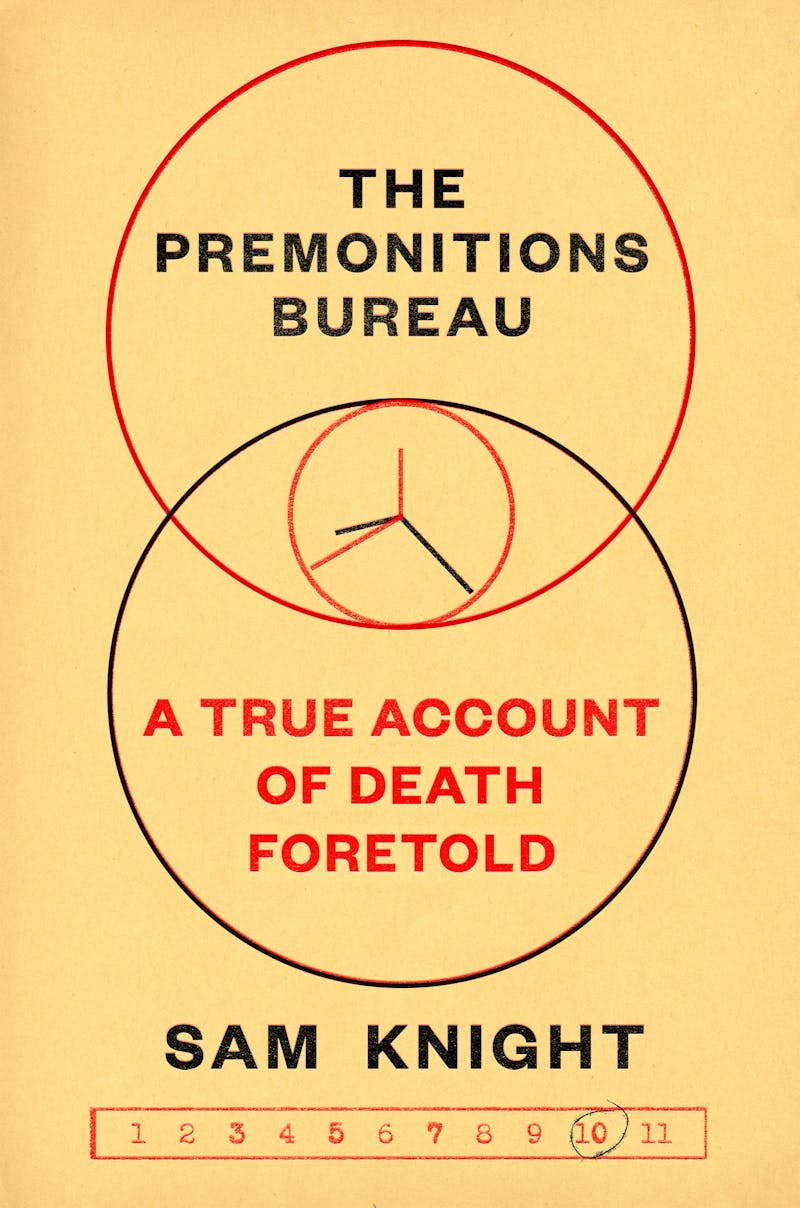
Or at least, they claimed they had. Shortly after the tragedy at Aberfan, several women and men recalled having eerily specific premonitions of the event. A piano teacher named Kathleen Middleton awoke in North London, only hours before the tip fell, with a feeling of sheer dread, “choking and gasping and with the sense of the walls caving in.” A woman in Plymouth had a vision the evening before the disaster in which a small, frightened boy watched an “avalanche of coal” slide towards him but was rescued; she later recognized the child’s face on a television news segment about Aberfan. One of the children who died had first dreamt of “something black” smothering her school. Paul Davies, an 8-year-old victim, drew a picture the night before the catastrophe that showed many people digging in a hillside. Above the scene, he had written two words: The End.
Premonitions this dramatic and alarming are likely rare. But most of us have experienced odd coincidences that make us feel, even for an instant, that we have glimpsed the future. A phrase or scene that triggers a jarring sensation of déjà vu. Thinking of someone right before they text or call. Inexplicably dreaming about a long-lost acquaintance or relative only to wake and find that they have fallen ill or died. It’s mostly accepted that these are not really forms of precognition or time travel but instead fluky accidents or momentary brain glitches, explainable by science. And so we don’t give them a second thought or take them that seriously. But what if we did?
The Premonitions Bureau, an adroit debut from The New Yorker staff writer Sam Knight, draws us into a world not that far gone in which psychic phenomena were yet untamed by science and uncanny sensations still whispered of the supernatural, of cosmic secrets. Knight’s book registers the spectral shockwaves that rippled out from Aberfan through the human instrument of John Barker, a British psychiatrist who began cataloguing and investigating the country’s premonitions and portents in the wake of the accident. Barker spent his career seeking out the hidden joints between paranormal experience and modern medicine, asking scientific questions about the occult that we have now agreed no longer to ask. In Knight’s skillful hands, the life of this forgotten clinician becomes a meditation on time and a window through which we can perceive the long human history of fate and foresight. It’s also a tale about how we decide what is worthy of science and what it feels like to be left behind. It is a story about a scientific revolution that never happened.
Forty-two years old when the country learned of Aberfan, John Barker was a Cambridge-educated psychiatrist of terrific ambition and rather middling achievement. In his thirties, he had been an unusually young hospital superintendent at a facility in Dorset; a nervous breakdown led to his demotion and reassignment, by the mid-’60s, to Shelton Hospital, where he cared for about 200 of the facility’s thousand patients. Shelton was a Victorian-era asylum in western England, not far from Wales, and a hellish world unto itself. Local doctors called it the “dumping ground,” this 15-acre gothic facility of red-brick buildings hidden behind red-brick walls, where women and men suffering from mental illness were deposited for the rest of their lives. One-third of Shelton’s population had never received a single visitor. Like other mental health facilities in midcentury Britain, it was a place of absolutely crushing neglect. “Nurses smoked constantly,” Knight writes, “in part to block out Shelton’s all-pervading smell: of a house, locked up for years, in which stray animals had occasionally come to piss.” Every week or two, another suicide. “The primary means of discharge was death.”
As a clinician, Barker was tough and demanding. He was also complicated (like all of us) and tough to caricature. Barker had arrived at Shelton as calls for psychiatric reform were growing louder, and he supported efforts to make conditions “as pleasant as possible” for the hospital’s permanent residents, including removing locks from most of the wards and arranging jazz concerts. But he also favored aversion shock therapies and once performed a lobotomy—which, to his credit, he later regretted. At any rate, Barker’s true passion lay elsewhere. As a young medical student, he collected ghost stories from nurses and staff at the London hospital where he was training: sudden and unaccountable cold presences late at night, spectral ward sisters who shouldn’t have been there and who vanished when you looked twice. A “modern doctor” committed to rational methods, his interest in all things paranormal led him to join Britain’s Society for Psychical Research, whose members had been studying unexplained occult phenomena since 1882. Barker had a crystal ball on his desk and spent his weekends at Shelton rambling around haunted houses with his son. He was a man caught between worlds who would eventually fall through the cracks.
The day following the disaster, Barker showed up in Aberfan to interview residents for an ongoing project about people who frightened themselves to death. But he realized quickly that his questioning was insensitive—and as he learned more about the uncanny portents and premonitions that were already swirling around the tragedy, he sensed a much greater opportunity. Barker contacted Peter Fairley, a journalist and science editor at the Evening Standard, with his hunch that some people may have foreseen the disaster through a kind of second sight. Days later, the paper broadcast Barker’s paranormal appeal to its 600,000 subscribers: “Did anyone have a genuine premonition before the coal tip fell on Aberfan? That is what a senior British psychiatrist would like to know.”
A gifted scientific popularizer, Fairley shared with Barker a knack for publicity as well as tremendous ambition. Within weeks, the two men had dramatically expanded the project. From January 1967, readers were told to send general auguries or prophecies to a newly established “Premonitions Bureau” within the newsroom. “We’re asking anyone,” Fairley told a BBC radio interviewer, “who has a dream or a vision or an intensely strong feeling of discomfort” which involves potential danger to themselves or others “to ring us.” With Fairley’s brilliant assistant Jennifer Preston doing most of the work, the team categorized the predictions and tracked their accuracy. Their hope was to prove that precognition was real and convince Parliament to use this psychic power for good by developing a national early warning system for disasters. “Nobody will be scoffed at,” Fairley insisted. “Let us simply get at the truth.”
Seventy-six people wrote to Barker claiming premonitory visions of the Aberfan disaster. Throughout 1967, another 469 psychic warnings were submitted to the Bureau. Many of these submissions came from women and men who claimed to be seers, who experienced precognition throughout their lives as a sort of sixth sense. Kathleen Middleton, the piano teacher who awoke choking before the coal tip collapse, became a regular Bureau contact who had been sensitive to occult forces since she was a girl. (During the Blitz, a vision of disaster convinced her to stay home one night instead of going out with friends; the dance hall was bombed.) Another frequent contributor was Alan Hencher, a telephone operator who wrote that he was “able to foretell certain events” but with “no idea how or why.”
The premonitions gathered by Barker ran the gamut of believability. Some were instantly disqualified. Others were spookily prescient. In early November 1967, both Hencher and Middleton warned of a train derailment; one occurred days later, near London, killing 49 people. Hencher suffered a severe headache on the evening of the disaster and suggested the time of the accident nearly to the minute, before the news had been reported. Most of the premonitions appear to have been vague enough to be right if you wanted them to be, if you were willing to cock your head to one side and squint. A woman reported a dream about a fire; on the day she mailed her letter, a department store in Brussels burned. One day in May 1967, Middleton warned about an impending maritime disaster; an oil tanker ran aground. Visions of airliner crashes inevitably, if one waited long enough, came true somewhere in the world. Barker was determined to believe in them. “Somehow,” he told an interviewer, seers like Hencher and Middleton “can gate-crash the time barrier … see the unleashed wheels of disaster before the rest of us.… They are absolutely genuine. Quite honestly, it staggers me.”Visions of airliner crashes inevitably, if one waited long enough, came true somewhere in the world. Barker was determined to believe in them.
For those of us unable to gate-crash time itself, one wonders what it would be like to have this kind of premonitory sense, to perceive the future so viscerally and so involuntarily. It was like knowing the answer for a test, some explained, with cryptic keywords floating in space in their imaginations. ABERFAN. TRAIN. Others had physiological symptoms. Odd smells, like earth or rotting matter, that nobody else could perceive, or a spasm of tremors and pain at the precise moment when disaster struck far away. People who sensed premonitions explained to Barker that it was an awful burden, that they grappled with, as one put it, “the torment of knowing” and “the problem of deciding whether we should tell what we have received” in the face of potential ridicule or error.
Prone to a certain grandeur, Barker believed that the stakes of the project, which he called “essential material and perhaps the largest study on precognition in existence,” were high. Practically speaking, he thought it would help avert disaster. (If the Premonitions Bureau had been up and running earlier, he boldly claimed, Aberfan could have been avoided and many children’s lives saved.) More daringly, Barker thought that proving the existence of precognition would overturn the basic human understanding of linear time. He wondered if some people were capable of registering “some sort of telepathic ‘shock wave’ induced by a disaster” before it occurred. It might be akin to the psychic bonds felt between twins, but able to vanquish time as well as space. Inspired by Foreknowledge, a book by retired shipping agent and amateur psychic researcher Herbert Saltmarsh, Barker thought that our conscious minds could likely only experience time moving forward, and in three distinct categories: past, present, and future. To our unconscious, however, time might be less stable and more permeable. If scientists would “accept the evidence for precognition from the cases” gathered by the Bureau, he said, they would be “driven to the conclusion that the future does exist here and now—at the present moment.” Barker sensed a career-defining discovery just around the corner.
But it was not to be. John Barker died on August 20, 1968 after a sudden brain aneurysm. He was 44 years old. The Bureau, which Jennifer Preston dutifully continued through the 1970s, and which ultimately included more than 3,000 premonitions, represented the last, unfinished chapter of his brief life. He never wrote his book on precognition and fell into obscurity. The morning before he died, Kathleen Middleton woke up choking.
Knight narrates Barker’s story with considerable generosity and evident care. Rather than condescend or deride him as a crank, Knight thinks with Barker: about the strangeness of time and our human ways of moving through it, about how we make meaning from chaos and resist the truly random, about prediction and cognition and our hunger for prophecy. Yet the many disappointments in Barker’s career were not incidental to his significance, and emphasizing them does not diminish him. In fact, his life can also be framed as a tale told much too rarely in the history of science, about how scientific inquiry relies as much upon failure as success in order to function, on exclusion as much as expansion.
Around the time Barker was appointed to his role at Shelton, the American historian and philosopher of science Thomas Kuhn published a book called The Structure of Scientific Revolutions, a landmark work that now structures practically everyone’s thinking without them realizing it. What Kuhn proposed was that scientific research always occurs within a paradigm: a set of rules and assumptions that reflect not only what we think we know about how the universe works, but also the questions we are permitted to ask about it. At any given moment, “normal science” beavers away within the borders of the current paradigm, working on “legitimate problems” and solving puzzles. For a long while, Kuhn explained, phenomena “that will not fit the box are … not seen at all,” and “fundamental novelties” are suppressed. Eventually, however, there are too many anomalies for which the reigning paradigm cannot account. When a critical mass is reached, the model breaks and a new one is adopted that can better explain things. This is a scientific revolution.
For Barker, precognition constituted what Kuhn would have called a legitimate problem within normal science: It ought to be studied using experimental methods and would, he thought, one day be explained by them. But he admitted the risk that modern psychiatry might not ever be able to accommodate the occult, that his work on premonitions could break the paradigm altogether. Hunches and visions that came true might demand a new way of explaining time and energy. “Existing scientific theories must be transformed or disregarded if they cannot explain all the facts,” he lectured his many critics. “Although unpalatable to many, this attitude is clearly essential to all scientific progress.” He seems to have seen himself as a contemporary Galileo, insisting upon empirical truth in the face of “frivolous and irresponsible” gatekeepers. “What is now unfamiliar,” he argued in the BMJ, usually tends to be “not accepted, even despite overwhelming supportive evidence. Thus for generations the earth was traditionally regarded as flat, and those who opposed this notion were bitterly attacked.” Barker wanted the ruling scientific paradigm to make room for the paranormal—or give way.
It wasn’t so implausible, in midcentury Britain, that it just might. A craze for spiritualism and the paranormal had swept the country between the two world wars, and a rash of new technologies that seemed magical (telegram, radio, television, etc.) left many Britons, not unreasonably, to wonder if “supernatural” phenomena like prophecies or telepathy might turn out to be explainable after all. In Barker’s Britain, one quarter of the population had reported believing in some form of the occult. Even Sigmund Freud, nervously protecting the reputation of psychoanalysis, refused to dismiss paranormal activities “in advance” as being “unscientific, or unworthy, or harmful.” In physics, too, Knight points out, “the old order of time was collapsing” by midcentury, thanks to developments in relativity as well as quantum mechanics. For experts, time had become less predictable and mechanisms of causation less clear, both subatomically and cosmically. Barker had been formed, in other words, by “a society in which one set of certainties had yet to be eclipsed by another.”Premonitions became understood not in terms of extrasensory perception but simply misperception: the work of cognitive error or misfiring neurons rather than the supernatural.
But instead of rearranging itself around Barker’s research into precognition, the paradigm shifted away from him and snapped more firmly into place. The walls sprang up, and the questions that interested Barker became seen as illegitimate and unscientific. The Bureau he built with Fairley was not all that successful. Only about 3 percent of submissions ever came true, and in February 1968 a deadly fire at Shelton Hospital itself went unpredicted, to the unabashed glee of critics and satirists. Barker’s supervisors grew skeptical and then embarrassed. As time went on, and the boundaries of the scientific paradigm in which we still live grew less permeable, occult phenomena were explained not by bending time, but with recourse to cognitive science and neurology. Premonitions became understood not in terms of extrasensory perception but simply misperception: the work of cognitive error or misfiring neurons rather than the supernatural.
The popular understanding of scientific revolutions still revolves around big ruptures and great scientists, the paradigm-defining concepts (like heliocentrism, gravity, or relativity) that transform how human beings think they understand the universe: We shift the frame to move forward. Yet there is just as much to be learned from the times when revolutions don’t occur, when scientific inquiry is defined not by asking thrilling new questions, but by the determination that some old questions will no longer be asked. What’s so brilliant about Knight’s account, in the end, is the way it portrays a creative workaday researcher rather than a modern-day Newton or Einstein, a man aspiring to do normal science while the rules shifted around him; the way it conveys the rarely captured feeling of a paradigm closing in around you and your ideas, until it all fades to black. Ian Beacock @IanPBeacock
Ian Beacock is a frequent contributor to The New Republic. He lives in Vancouver, where he’s working on a book about democratic emotions.Want more on art, books, and culture?Sign up for TNR’s Critical Mass weekly newsletter.ContinueRead More: Critical Mass, Books, Culture, Aberfan, Science, PremonitionsEditor’s Picks
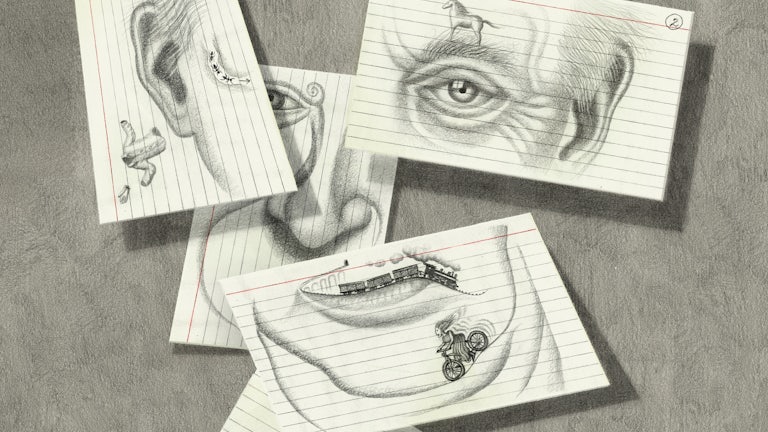

- Terms and Conditions
- Privacy Policy
- Cookies Settings
- Copyright 2022 © The New Republic. All rights reserved.
September 5th 2022
By Melissa Hogenboom23rd August 2022Comments about our looks from our loved ones and friends can cause lifelong insecurities. How can we teach kids to feel confident about their bodies instead?P
Picture the scene: a little girl tries on a sparkly dress, does a twirl and with great satisfaction, smooths it down. The adults around her echo her delight, and tell her how pretty she is. Later she looks at her favourite books, and sees slim people and slender animals going on exciting adventures, while their heavier counterparts are portrayed as slow or clumsy. Sometimes, she notices her own parents fretting about their weight or looks.
By the time she is a teen, her parents may worry how social media influencers are affecting her body image. But research suggests that in reality, her perception of bodies and their social acceptance will have been shaped long before then, in those very early years.
When we think about our relationship with our bodies, it’s often hard to pinpoint precisely where our satisfaction or dissatisfaction comes from. If we cast our minds back to our childhood, however, we may remember a collection of off-hand comments or observations. None of them may seem hugely impactful in themselves. And yet, their cumulative effect can be surprisingly potent.
The writer Glennon Doyle still recalls how her looks as a child earned her praise from the adults around her: “I could see it on their faces… They would light up, and so I learned, this is a currency,” she says on her podcast. But when she grew older and was considered less pretty, that adoration stopped – it was, she says, as if the world had turned away from her.
Whether it comes in the form of compliments or criticism, that kind of attention to body shapes can lay down beliefs and insecurities that are hard to shake off. The consequences can be tremendously damaging, as research shows, with family attitudes and derogatory comments about weight linked to mental health problems and eating disorders. In addition, the broader stigmatisation of overweight children has increased – affecting their self-esteem and of course, body image.
Given how early this awareness of body ideals begin, what can parents and caregivers do to help children feel confident about themselves – and more supportive of others?
From a young age, children are influenced by their parents’ views about physical appearance (Credit: Getty/Javier Hirschfeld)
Family Tree
This article is part of Family Tree, a series that explore the issues and opportunities that families face all over the world. You might also be interested in other stories on childhood and development:
You can also climb new branches of the Family Tree on BBC Worklife and BBC Culture – and check out this playlist on changing families by BBC Reel.
Body shame is taught, not innate
Physical ideals hugely differ across time and different cultures – a quick look at any painting by Peter Paul Rubens, or indeed the 29,500-year-old figurine known as the “Venus of Willendorf“, shows just how exuberantly humans have embraced curvy features. But today, despite a growing body positivity movement that celebrates all shapes and sizes, the idea that a thin body is an ideal one remains dominant on social media, on traditional media, on television, on the big screen and in advertising.
Awareness of body ideals starts early, and reflects children’s experience of the world around them. In one study, children aged three to five were asked to choose a figure from a range of thin to large sizes, to represent a child with positive or negative characteristics. They were for example asked which children would be mean or kind, who would be teased by others and whom they would invite to the birthday. The children tended to choose the bigger figures to represent the negative characteristics.
Crucially, this bias was influenced by others: for example, their own mothers’ attitudes and beliefs about body shapes affected the outcome. Also, the older children displayed a stronger bias than the younger ones, which again indicates that it was learned, not innate. The findings “suggest children’s social environments are important in the development of negative and positive weight attitudes”, the researchers conclude.
“We see the patterns whereby children are attributing the positive characteristics to the thinner figures, and negative characteristics to the larger figures,” says Sian McLean, a psychology lecturer at La Trobe University in Melbourne, Australia, who specialises in body dissatisfaction. “They’re developing that quite early, which is a concern because they potentially have the chance to internalise that perception, that being larger is undesirable and being thinner is desirable and associated with social rewards.”
While parents play an important role in shaping their children’s attitudes and views, it should be emphasised that they are far from the only influence youngsters are exposed to, and can often have a positive effect that can counteract messages from other sources. But the research shows that parents’ views do matter.
Girls as young as five use dieting to control their weight
Another study showed that children as young as three were influenced by their parents’ attitude towards weight. Over time, the children’s negative associations with large bodies, and awareness of how to lose weight, increased. There is often a gender element to these perceptions, with sons more affected by their fathers’ views, and daughters by their mothers’ attitudes. The use of dieting to control weight has even been reported in girls as young as five. Here the main factors were exposure to media, as well as conversations about appearance.
The studies show just how early young children take on the societal perceptions of those around them, paying close attention to how adults behave and talk about bodies and food. That pattern continues, and can even worsen, as they grow older. Research assessing the level of body dissatisfaction and dieting awareness in children aged five to eight found that “the desire for thinness emerges in girls at around age six”. From that age, girls rated their ideal figure as significantly thinner than their current figure. Again, the children’s perception of their mothers’ body dissatisfaction predicted whether the girls then also felt dissatisfied with their own bodies. “A substantial proportion of young children have internalised societal beliefs concerning the ideal body shape and are well aware of dieting as a means for achieving this ideal,” the authors concluded. 
Thinking back, most of us will have experienced off-hand comments or observations during our childhood (Credit: Alamy/Javier Hirschfeld)
The danger of teasing
Many parents may feel shocked to hear that their own insecurities – which may after all be completely involuntary, and not something they wish to pass on – can have such an impact. But some family members also magnify this effect through derogatory comments.
In a study on the effects of teasing by family members on body dissatisfaction and eating disorders, 23% of participants reported appearance-related teasing by a parent, and 12% were teased by a parent about being heavy. More reported being teased by their fathers than their mothers. Such paternal teasing was a significant predictor of body dissatisfaction as well as bulimic behaviours and depression, and also increased the odds of being teased by a sibling. Maternal teasing was a significant predictor of depression. Being teased about one’s appearance by a sibling had a similarly negative impact on mental health and self-esteem, and raised the risk of eating disorders.
The authors suggested that understanding a family history of teasing would help health care providers identify those at risk for “body image and eating disturbance and poor psychological functioning”.
I still have a problem eating in front of my mom. She always criticised my eating and weight starting from when I was six. Maybe even before – 49-year-old study participant
Other research on children aged seven to eight has shown that mothers’ comments about weight and body size have been linked to a disordered eating behaviour among their children. Similarly, girls “whose mothers, fathers, and friends encouraged them to lose weight and be lean” were more likely to endorse negative beliefs about others’ weight, known as “fat stereotypes”. This is especially alarming given the rise in weight-related stigmatisation and bullying.
Even adult women can still feel the pain of weight stigma experienced in childhood, a study found, with the participants mainly pointing to their mothers as the source of such stigma. It was “the most hurtful thing I’ve ever experienced“, one participant said. The study quoted women in their 40s, 50s and 60s describing vivid memories of being weight-shamed by their families, and the profound sadness they still felt. “The constant criticism from my mother about my weight led to issues of self-confidence I have struggled with all my life,” one participant reported. “My father and brothers used to hum the ‘baby elephant walk’ tune when I was around eight–11 years old,” said another. “I still have a problem eating in front of my mom,” a 49-year-old participant stated. “She always criticised my eating and weight starting from when I was six. Maybe even before.”
One respondent recalled her mother putting her on a diet at the age of 10: “My feelings of my lack of attractiveness will probably never go away and have been with me all my life even when I was thinner. It is very painful.”
However, some respondents also said they felt their mothers projected their own insecurities, and perhaps intended the comments and advice to be helpful rather than mean.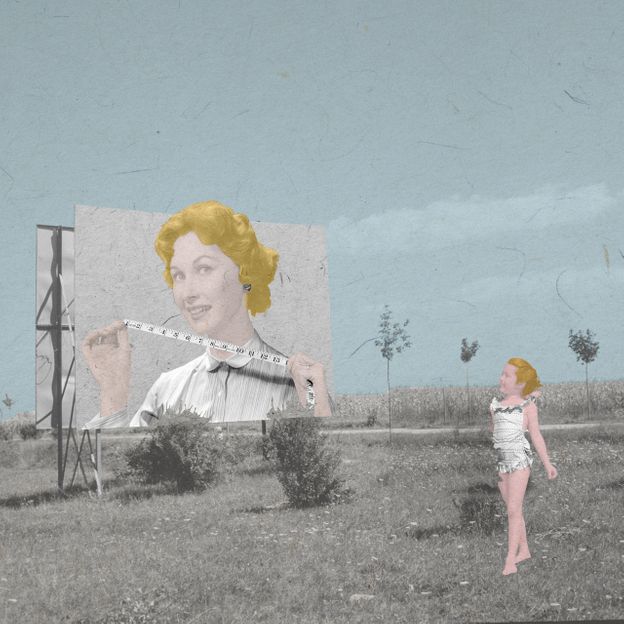
Some adult women still feel the pain of weight stigma experienced in childhood (Credit: Getty Images/Javier Hirschfeld)
Beyond the family
There’s a reason why parental influence is so strong. Rachel Rodgers, a psychologist at Northeastern University, says that when a parent is concerned with their own body image, they will be modelling behaviours that show “this is important”.
“Even if they’re not mentioning the child’s physical appearance, they’re still acting in a way that suggests to the child, ‘this is something that worries me, this is something that I’m preoccupied with’, and so children pick up on that.”
In addition, many parents do tend to comment on what children are eating, wearing, or how they look, often in a well-meaning way, and that can increase the preoccupation with looks and weight. The resulting “thin idealisation” – a preference for thin bodies – sets children up to believe that their “social worth is contingent on their physical appearance and that’s going to lead them to invest in it in terms of their self-esteem, as well as their time and energy”, says Rodgers.
Of course, parents are not the only source of body stigma, especially as the child grows older. Their peers and the media tend to assume a greater role over time. Even toys such as dolls have an influence. One study featuring girls aged five to nine, found that when they played with an extremely thin doll, it changed their ideal body size to being thinner.
Unless they are countered, these influences can reinforce each other. Many studies show that media exposure contributes to appearance ideals – young girls who watched music videos were more focused on their appearance afterwards, for example. If friends then also talk about weight and appearance, that effect can be magnified.
“The way in which media ideals are supported and endorsed by their peers/friends was a more crucial factor than direct media exposure itself,” explains Jolien Trekels a psychologist studying body image at KU Leuven in Belgium, who led research looking into the role friends play on appearance ideals.
On a positive note, it may mean that young people are not just at the mercy of media ideals, but can collectively shape their own responses to it.
The danger of “thinspiration”
The type of social platform and activity also plays a role. One 2022 review found that Instagram and snapchat (both extremely visual) were more negatively linked to body image than Facebook, while taking and manipulating selfies was more damaging than actually posting them.
Unsurprisingly “thinspiration” content that promotes thinness and dieting, also showed negative effects (due to negative self-comparisons), as did fitness-promoting posts categorised as “fitspiration”.
Although viewing posts about exercise has been shown to increase adult exercise among women, it also internalises thin ideals, according to a 2019 study. This means that this early inspiring effect is not necessarily long lasting, as the study notes: “As time passes and women see no major effects of dieting and exercising, they may become frustrated which may consequently result in body dissatisfaction.”
A negative body image is problematic for many reasons. “Self-worth is often intertwined with one’s bodily self-perceptions,” explains Trekels.
This is especially the case for women and girls. Once a negative body image develops, it is a high predictor for eating disorders and depression. The statistics paint a sobering picture. Estimates suggest that up to half of pre-adolescent girls and teens report body dissatisfaction.
A negative body image in childhood is also likely to persist into adolescence. A recent survey of adults by the charity Butterfly, which offers evidence-based support for eating disorders, found that of those who developed body dissatisfaction early on, 93% said it got worse during adolescence.
Focusing more on a child’s interests rather than how they look could improve a sense of self-satisfaction (Credit: Getty Images/Javier Hirschfeld)
Are girls more at risk?
While girls often seem to be more affected by body image concerns, this may in part be due to the fact that more research exists featuring girls, as well as how consistently the female body is objectified and sexualised early on. Emerging research on boys shows a similar level of dissatisfaction, though their body ideals tend to be a bit different, with a greater focus on wanting to be muscular, for example.
“Really everyone in a body can experience body dissatisfaction, it doesn’t matter what you look like on the outside, it’s how you’re thinking and feeling on the inside,” says Stephanie Damiano, who works at Butterfly.
Trekels has noted similar trends: “Generally, we find more or stronger effects for girls than for boys. However, this does not mean that boys aren’t vulnerable to experiencing these influences, too.”
One reason the effect is stronger for girls could be because, from an early age, girls and boys are socialised differently. Girls are often told that their social value lies in how attractive they are, says Rodgers. “That their bodies are made to be looked at, they are supposed to be contained, docile and not take up too much space,” she says. “Boys are socialised to understand that their bodies are functional, that they’re strong, which is a very different message.”
Given how all-pervasive these messages are, what can parents do to counter them and instead nurture a more generous, positive and empowering body image?
First, as the evidence shows, the way adults talk about bodies around children matters. “We would encourage parents or educators not to make comments about body image, even if they’re positive,” McLean says.
Instead, parents should focus on what the children enjoy doing and are interested in, placing “more value on who they are and their special skills and talents and less focus on what they look like”, says Damiano. This helps children get a sense of satisfaction and self-worth that’s not tied to their appearance. It may also mean working on our own self-perception and self-esteem, given that the research shows how easy it is to transmit our insecurities.
Positive family relationships can help to reduce the negative effects of body dissatisfaction (Credit: Getty Images/Javier Hirschfeld)
Family support makes a difference
Damiano also recommends parents avoid talking about weight or constantly telling children to eat healthier foods. “The more we focus on higher weight as being a problem, or certain foods as being ‘bad’, the more guilt, shame, and body dissatisfaction children are likely to feel.”
Instead, parents can talk about exercise as being important for general health and wellbeing, rather than a way to lose weight. Families can also normalise eating healthy meals, rather than overtly talking about specific foods being bad for you. We all like a treat, after all, so it seems counter-productive to teach children to feel guilty about having one. In fact, enjoying treats is known to be key to a healthy attitude towards weight. Watching TV cooking programmes featuring healthy food, can also subtly encourage children to eat healthier foods.
Family relationships can play an important positive part: one study showed that a good relationship between mothers and their adolescent children can reduce the negative effects of social media use on body dissatisfaction. Limiting children’s time on social media can reduce “appearance comparisons” as well as improve mental health.
“The way that parents provide meaning to what the child is seeing”, is also really important, Rodgers says, as it can help a child decode what the images truly show. And of course, not all social media is bad – it can be a source of community and encouragement, too.
Parents may find it useful to team up with schools. The Butterfly Body Bright programme in Australia helps primary school children develop a positive body image and lifestyle choices. In a pilot programme, the children’s body image was found to improve after one lesson. Intervention programmes that focus on building self-esteem have also shown success. Reflecting on these programmes and their messages may even help parents examine their own ideas around weight and bodies, and cast off long-held, harmful beliefs.
As for what we can do at home, an easy change might be to pause whenever we’re about to praise a child’s appearance, and think of something else we like about them, and want them to know. Instead of telling them “I love your dress”, we could simply smile and tell them how nice it is to see them, and how much fun they are to be around.
* Melissa Hogenboom is the editor of BBC Reel. Her book, The Motherhood Complex, is out now. She is @melissasuzanneh on Twitter.
—
Join one million Future fans by liking us on Facebook, or follow us on Twitter or Instagram.
If you liked this story, sign up for the weekly bbc.com features newsletter, called “The Essential List” – a handpicked selection of stories from BBC Future, Culture, Worklife, Travel and Reel delivered to your inbox every Friday.
By Sophia Smith Galer31st August 2022In the digital age, kids need a trusted source they can turn to with questions about love and sex – and research shows how parents can get it right.I
I never got the opportunity to do something that’s almost a rite of passage among British teens – spend a sex education class peeling a condom out of its stiff foil packet and rolling it down a banana. It wasn’t until I was 27 years old that I would finally get to do it, but in a very different capacity. I wasn’t learning how to put a condom on. I was learning how I’d teach somebody else to put it on.
About 15 newly trained sex educators and I sat in front of our computers, condommed-bananas in hand. “We often use flavoured condoms,” explained our teacher over Zoom, “because the smell is a bit more appealing than normal condoms.” He took a moment to look at the participants’ expressions, and obviously found some of them looking less passive than he’d hoped. “It’s really important that you don’t look or feel squeamish when you do this,” he said. “That’s not how you want young people to feel when you’re encouraging them to use these.”
Many parents may feel a similar sense of squeamishness when trying to talk to their children about physical intimacy – though attitudes to sex education can vary widely between countries and families, research shows.
A review of research on British parents’ involvement in sex education found that they often felt embarrassed, for example, and feared they lacked the skills or the knowledge to talk to their children. However, that same review also found that in countries such as the Netherlands and Sweden, parents talked openly to their children about sex from an early age, and that possibly as a result, teenage pregnancies and sexually transmitted diseases were far less common than in England and Wales.
Parents who do feel awkward talking about sex can find themselves in a difficult spot. Many would like their children to know that they can come to them with questions and problems, especially in the digital age, with children coming across graphic online content at an increasingly young age. But they may struggle to decide when and how to start.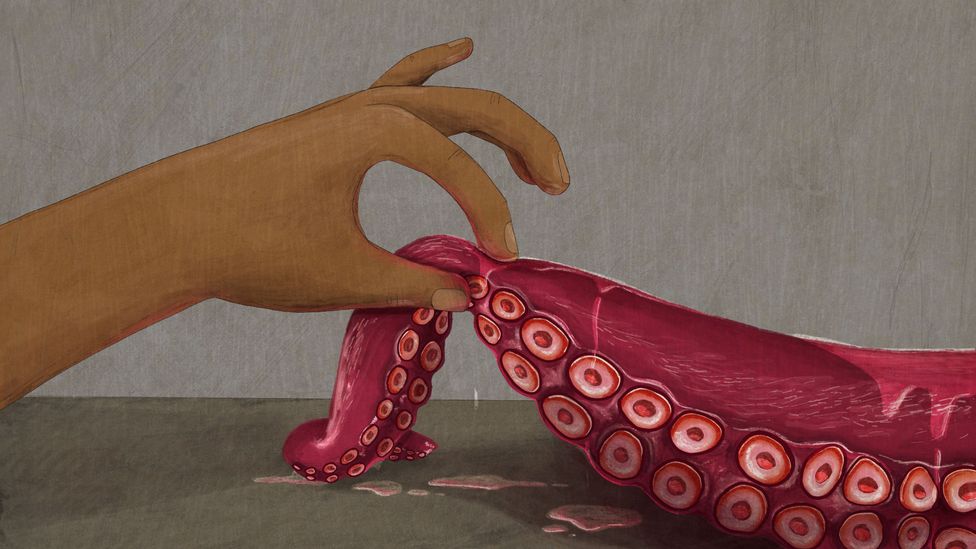
Parents may feel squeamish when trying to talk about bodies and intimacy. (Credit: Prashanti Aswani)
Eva Goldfarb, professor of public health at Montclair State University, co-authored a systematic literature review of the past 30 years of comprehensive sex education. While the review focuses on schools, Goldfarb says her research holds important lessons for parents, too. One basic insight is that sex education has a positive, long-term impact, such as helping young people form healthy relationships. Her advice to parents is not to skip or delay these chats.
“Start earlier than you think,” she says. “Even with very young children you can talk about names of body parts and functions, body integrity and control.”
This includes talking about issues that parents may not even think about as sex-related, but that are about relationships more broadly: “Nobody gets what they want all the time, it’s important to treat everyone with kindness and respect.”
In fact, parents tend to find it easier to talk to their children about sex when these conversations start at a young age and come up naturally, separate research suggests. Answering young children’s questions openly and honestly can set a positive pattern that makes it easier to talk about more complex issues later.
This step-by-step approach can also be beneficial for children in terms of understanding their own origins and identity. For example, research has shown that children who were conceived with the help of sperm donation, and whose parents explained this from the start with the help of books and stories, felt more positive about their origins than those who found out later.
For parents who want to broach the subject of sex but don’t quite know how, research has revealed a number of ways to get started.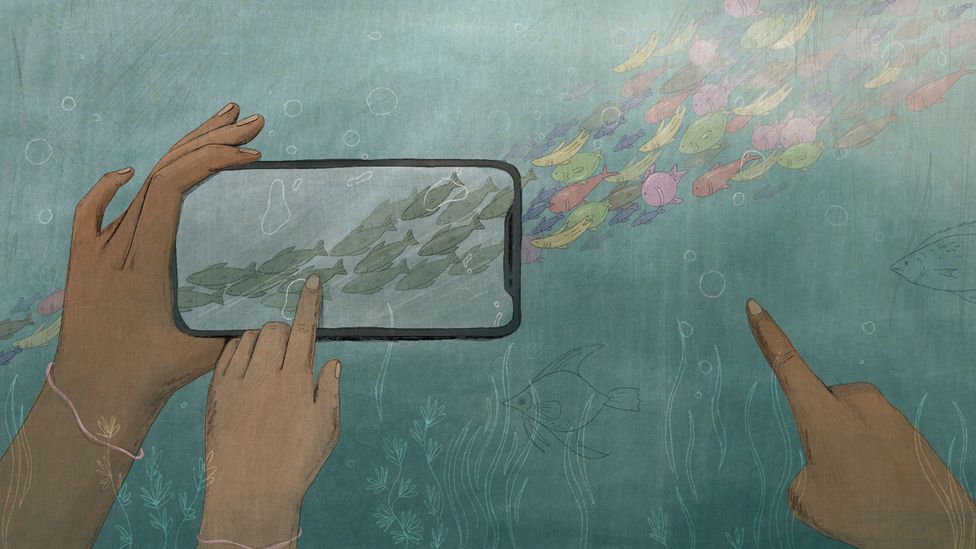
Many parents would like to be a trusted source for their children, especially in the digital age. (Credit: Prashanti Aswani)
What was your own sex education like?
Over the past few years, I have interviewed dozens of sex educators for my book debunking sex myths and misinformation, Losing It. They are pretty much unanimous when it comes to Lesson One of sex education training – figuring out your own level of sex education before considering passing it on to anybody else.
Numerous studies and surveys suggest that adults often do not know as much about sex and the body as they would like to, and may even have completely inaccurate ideas that are grounded in myth or guesswork. For example, many people around the world erroneously believe that the state of a woman’s hymen can prove whether she is a virgin – an idea that has no scientific basis.
Parents’ basic level of knowledge can vary widely. Some may identify with the subjects of a study in Namibia, which found that many parents didn’t talk to their children about sex because they themselves felt that their knowledge about human sexuality, or their ability to explain it, was inadequate. But a survey of almost 2,000 parents of young children in China found that parents’ own sexual knowledge and sex education was generally good, though they were less knowledgeable when it came to issues around child development, which made it difficult for them to be effective educators.
Some of the Namibian respondents also avoided the topic because they viewed sex as taboo, or they thought discussing it was going to encourage young people to have sex. The idea that talking to children about sex will encourage them to think about things that aren’t age appropriate, or seek out sexual experiences, remains common around the world, including in the US. It tends to be linked to the belief that teaching abstinence from sex until marriage is the best way to protect young people’s health and safety.
However, research has shown the opposite. Simply telling teenagers not to have sex has been conclusively proven not to work. The American Academy of Pediatrics calls educational programmes that only promote abstinence “ineffective”, based on a systematic review of the evidence. The review also shows that comprehensive sex education helps prevent and reduce the risks of teen pregnancy and sexually transmitted diseases, echoing the findings in the Netherlands and Sweden.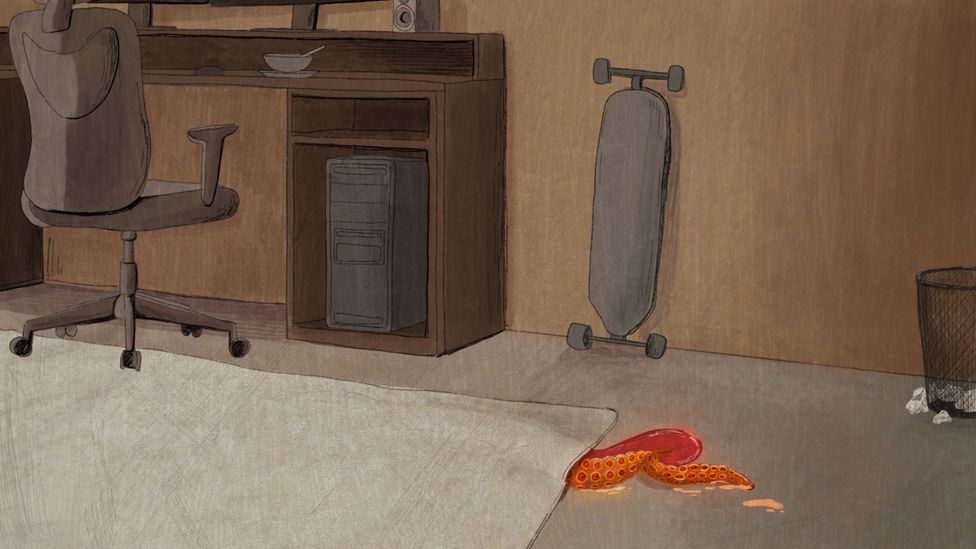
When parents delay or skip the topic of sex, young people can be left vulnerable to misinformation (Credit: Prashanti Aswani)
In fact, when parents, and especially mothers, talk to their teenage children about sex, the teens are more likely to delay having sex for the first time, and engage in safer behaviour when they do have sex, especially in the case of girls. The study of British families suggests that it is important to involve fathers in the conversations, too, also because boys often feel sex education tends to be weighted towards the experience of girls.
In short, teaching young people what it truly means to be ready the first time that they have sex, and what to consider when doing so, is far more likely to lead to protect them than not telling them anything.
In Finland, parents prefer calling sex education “Kehotunnekasvatus” – “body emotion education”
What might be helpful, however, is reframing what exactly parents think sex education is. In Finland, researchers conducted an experiment where they changed the name of sexuality education to “Kehotunnekasvatus” – “body emotion education” – and evaluated how early childhood education professionals and parents felt about the term.
The majority preferred the new phrase as it was “more neutral, downplaying thoughts of sex”. The researchers note that “one problem impeding the promotion of childhood sexuality education has been the lack of terms free from adulthood connotations”, and that using child-centred words might be how many of us are able to talk more easily.
“Using different words for children’s sexuality is not a repressed, evasive or euphemistic representation, but can help adults to see the difference and to overcome their rejections, misunderstandings and objections,” write the authors.
Such changes can come with a risk, though. One study in India observed that altering the name of a local programme to ‘lifestyle’ education ended up being counter-productive, sweeping the sex education agenda “under the carpet”.
Rephrasing or hiding vocabulary around sex and sexual development when talking to young people also risks accidentally tainting the original words with shame, instead of presenting them as a normal part of a frank conversation.
Parents may find that talking openly is easier than they thought (Credit: Prashanti Aswani)
Family Tree
This article is part of Family Tree, a series that explores the issues and opportunities families face today – and how they’ll shape tomorrow. You might also be interested in other stories about children’s health and development:
- How pets give your kids a brain boost
- The healing power of ’emotion coaching’
- Is a vegan diet safe for children?
Climb other branches of the family tree with BBC Culture and Worklife.
Step by step
Parents who are unsure when and how to start these conversations may find it helpful to seek out material for schools. In a UK study in 2016, parents who were shown the books used for their children’s sex education classes felt that they better understood the subject – and also reported that it made them feel more confident talking to their children about sex. Eva Goldfarb says that it can also be helpful for parents to have evening meetings with their children’s sex education teachers and receive information about what their children will be learning at the beginning of the school year.
International guidelines for sex education, such as a comprehensive, evidence-based guide published by Unesco, can also be a good starting point for parents looking for age-appropriate advice. The Unesco guide uses basic, clear ideas around bodies and healthy relationships as building blocks, rather than storing it all up for one big conversation. For a child aged 5-8 years, for example, one key idea is that “everyone has the right to decide who can touch their body, where, and in what way”.
For teenagers, the conversations can include discussions around emotional health, such as what it means to take responsibility for oneself and others, or ways to counter peer pressure, as well as providing specific information about condoms and other contraceptives, according to the guide.
Discussing pleasure can help young people practise more safe sex, have more knowledge and positive attitudes about sex – Mirela Zaneva
One factor has been found to be surprisingly powerful in sex education, but remains relatively little used: pleasure. A new systematic review into health interventions that incorporated pleasure found that explaining enjoyment around sex may encourage safer habits. Programmes that taught people about achieving sexual pleasure were found to improve condom use more than those that focused on the dangers of unprotected sex.
“It’s worth talking about the positives beyond protection, too, such as how using a condom can be fun and can help you connect with a partner,” says Mirela Zaneva, one of the study’s authors and a PhD candidate in experimental psychology at the University of Oxford.
Zaneva found that pleasure tends not to be mentioned much, or at all, in sex education. This means that if your child isn’t hearing about pleasure from you, it’s very likely they’re not hearing about it from school, either. “It is likely that a lot of young people miss out on positive, empowering conversations about sex in their current school sex education,” she says.
She notes that the Pleasure Project, a public health project involved in the research, offer a range of practical tips on how to incorporate pleasure into discussions with young people around sex.
“The evidence so far is that discussing pleasure can help young people practise more safe sex, have more knowledge and positive attitudes about sex, as well as have more confidence and self-efficacy.”
Finding trusted sources
Parents are usually the primary source of sex education for young children, but adolescents tend to tap many sources for information, such as their peers, teachers, and popular culture. And parents may not be the only ones who can feel squeamish. Research undertaken in Ireland found that while in the past, parents’ ignorance and embarrassment were the main obstacles to open discussions of sex, nowadays, it was the young people who tended to block these talks, by claiming to already know the facts, becoming irritated or annoyed, or even leaving the room. That does not mean parents should avoid the subject, but it does show how important it is to frame the chats in a way that make everyone feel comfortable.
“Let your child know ahead of time when you want to discuss something delicate, potentially embarrassing or difficult to talk about. They don’t feel ambushed this way, and they are more likely to be prepared and to talk with you,” says Goldfarb.
Overcoming that squeamishness may even turn out to be freeing experience. After all, sex and healthy relationships – or as the Finnish researchers call it, “body emotions” – are important at any stage of adult life. Young people are at the start of that journey, and have the chance to define values, habits and priorities that can benefit them over a lifetime, not just in intimate situations, but as a part of moving through the world safely and considerately. You may find that it is life-affirming, and not remotely awkward, to be part of that journey.
* Sophia Smith Galer is the author of Losing It: Sex Education for the 21st Century, published by Harper Collins.
—
Join one million Future fans by liking us on Facebook, or follow us on Twitter or Instagram.
If you liked this story, sign up for the weekly bbc.com features newsletter, called “The Essential List” – a handpicked selection of stories from BBC Future, Culture, Worklife, Travel and Reel delivered to your inbox every Friday.
September 4th 2022
Recognizing Suicidal Behavior
In many cases, suicide can be prevented. Learn the risk factors and warning signs, which include depression, change in personality, self-harm behavior recent life crisis and conversation about wanting to die. If a family member or friend talks about suicide, take them seriously. Listen without judgement and encourage them to seek professional help .
What is suicide?
Suicide is death caused by self-inflicted injury with the intent to die.
Suicide is the tenth leading cause of death in the U.S. One person dies by suicide about every 11 minutes. It is the second leading cause of death among people ages 10 to 34, the fourth leading cause of death among people ages 34 to 54 and the fifth leading cause of death among people ages among those ages 45 to 54.
Groups of people who have higher rates of suicide include:
- American Indian/Alaska Native and non-Hispanic White people.
- Veterans.
- Rural dwellers.
- Young people who are lesbian, gay, bisexual, transgender.
What are the situations– risk factors – that could lead someone to consider suicide?
Although you may not know what might cause a friend or loved one to attempt suicide, there are at least some common characteristics to be aware of.
Known factors that increase an individual’s risk of suicide include:
Individual factors
- Has attempted suicide in the past.
- Has a mental health condition, such as depression and mood disorders, schizophrenia, anxiety disorders.
- Has long-term pain or a disabling or terminal illness.
- Expresses feelings of hopelessness.
- Has money or legal problems.
- Has violent or impulsive behavior.
- Has alcohol or other substance abuse problems.
- Has easy access to self-harm methods, such as firearms or medications.
Relationship factors
- Has a history of physical, emotional or sexual abuse; or neglect or bullying.
- Has lost relationships through break-up, divorce or death.
- Has a family history of death by suicide.
- Is socially isolated; lacks support.
Community, cultural, societal factors
- Is ashamed to ask for help, especially help for mental health conditions.
- Lacks access to healthcare services, especially mental health and substance abuse treatment.
- Holds cultural or religious belief that suicide is a noble option to resolving a personal dilemma.
- Has become aware of an increased number of local suicides or an increase in media coverage of deaths by suicide.
What are some of the most common suicide warning signs?
Some of the more common warning signs that a person may be thinking of ending their life include:
- Being sad or moody: The person has long-lasting sadness and mood swings. Depression is a major risk factor for suicide.
- Sudden calmness: The person suddenly becomes calm after a period of depression or moodiness.
- Withdrawing from others: The person chooses to be alone and avoids friends or social activities. They also lose of interest or pleasure in activities they previously enjoyed.
- Changes in personality, appearance, sleep pattern: The person’s attitude or behavior changes, such as speaking or moving with unusual speed or slowness. Also, they suddenly become less concerned about their personal appearance. They sleep much more or much less than typical for that person.
- Showing dangerous or self-harmful behavior: The person engages in potentially dangerous behavior, such as driving recklessly, having unsafe sex or increase their use of drugs and/or alcohol.
- Experiencing recent trauma or life crisis: Examples of crises include the death of a loved one or pet, divorce or break-up of a relationship, diagnosis of a major illness, loss of a job or serious financial problems.
- Being in a state of deep despair: The person talks about feeling hopeless, having no reason to live, being a burden to others, feeling trapped or being in severe emotional pain.
- Making preparations: The person begins to put their personal business in order. This might include visiting friends and family members, giving away personal possessions, making a will and cleaning up their room or home. Often the person will search online for ways to die or buy a gun. Some people will write a note before attempting suicide.
- Threatening suicide or talking about wanting to die: Not everyone who is considering suicide will say so, and not everyone who threatens suicide will follow through with it. However, every threat of suicide should be taken seriously.
Can suicide be prevented?
In many cases, suicide can be prevented. The best way you can help prevent suicide is to:
- Learn the risk factors for suicide.
- Be alert to the signs of depression and other mental health conditions.
- Recognize suicide warning signs.
- Provide caring support.
- Ask directly if the person has considered hurting themselves.
People who receive support from caring friends and family and who have access to mental health services are less likely to act on their suicidal impulses than are those who are isolated from support.
What should I do if someone I know is talking about suicide?
If your friend or loved one is not in immediate danger but is talking about suicide and is showing risk factors for harming themselves, take them seriously. If you can, remove any objects that can be used in a suicide attempt. Encourage them to call – or call together – support services such as the National Suicide Prevention Lifeline: 1-800-273-(TALK) (1-800-273-8255). Conversations are with a skilled, trained counselor and are free and confidential and available 24 hours a day, seven days a week.
If the friend or loved one appears to be extremely distressed, don’t leave the person alone. Try to keep the person as calm as possible and get immediate help. Call 911 or take the person to an emergency room.
A note from Cleveland Clinic
If someone you know is exhibiting warning signs for suicide, don’t be afraid to ask if he or she is depressed or thinking about suicide. Listen without judging. In some cases, your friend or family member just needs to know that you care and are willing to hear them talk about how they are feeling. Encourage them to seek professional help.
If you have suicidal thoughts, know that you are not alone. Also know that help is available 24/7. Call your healthcare provider, go to the emergency room or call the National Suicide Prevention Lifeline, 1-800-273-TALK.
Comment I wrote and presented a seminar paper on suicide in 1973. It is to easy to call the impulse simply mental illness. I have nearly succeeded on three occasions I can remember. The last time was after being locked in a cold dirty dark smelly police cell for 18 hours. I strangled myself under the cover, listening to other prisoners screaming, shouting, swearing and banging. Then, found semi conscious, I was taken to a secure mental health unit for the next 12 hours on August 25th 2020.
Two senior doctors and a senior white female mental health nurse judged me sane and let me go. Since then I have longed to die from natural causes so that my son would not lose the insurance money, and be rid of me. When police lied that I was and am a gay whore, having me labelled a long term alcoholic with alcoholic peripheral neuropathy, paranoid personality with schizopphrenia, delusional and bi polarism, they had me sacked from the truck driving job I loved, costing me a fortune in lost income and credibility. It is quite rational to want to die in such deleterious circumstances, after nearly 15 years of high level police harrassment , lies and persecution. I won’t recover now. It is far too late.
The brain is like any other organ. It can only cope with so much social and economic poison before failing terminally. That is what suicide is, chronic brain failure which the authorities like to fein caring for with anti psychotic drug fed ‘living death.’ R J Cook.



September 3rd 2022
MIT Technology ReviewFeaturedTopicsNewslettersEventsPodcastsSign inSubscribeMIT Technology ReviewFeaturedTopicsNewslettersEventsPodcastsSign inSubscribeBiotechnology
How do strong muscles keep your brain healthy?
There’s a robust molecular language being spoken between your muscles and your brain. By
August 22, 2022
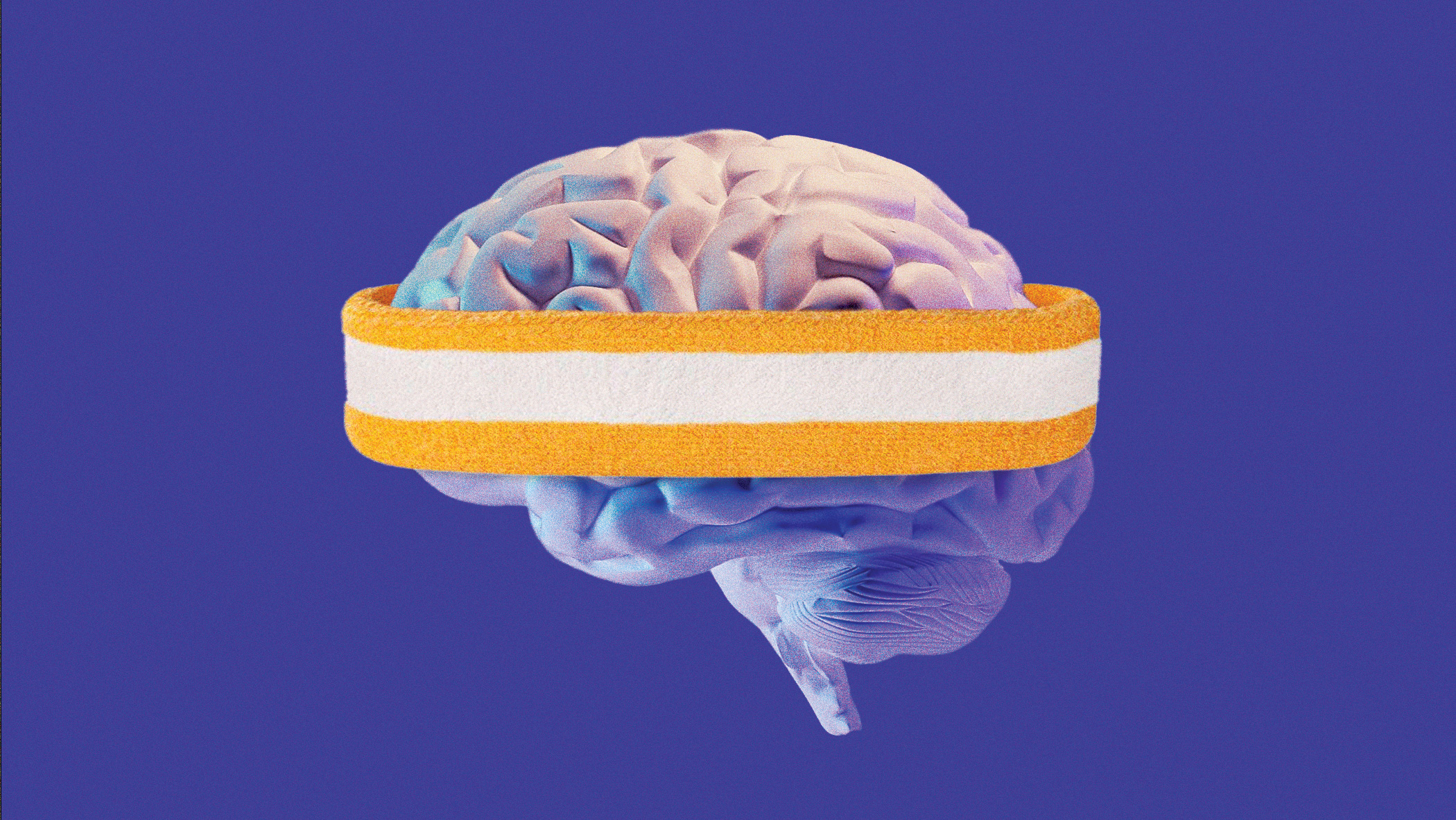
Selman Design
We’ve often thought about muscle as a thing that exists separately from intellect—and perhaps that is even oppositional to it, one taking resources from the other. The truth is, our brains and muscles are in constant conversation with each other, sending electrochemical signals back and forth. In a very tangible way, our lifelong brain health depends on keeping our muscles moving.
Skeletal muscle is the type of muscle that allows you to move your body around; it is one of the biggest organs in the human body. It is also an endocrine tissue, which means it releases signaling molecules that travel to other parts of your body to tell them to do things. The protein molecules that transmit messages from the skeletal muscle to other tissues—including the brain—are called myokines.
Myokines are released into the bloodstream when your muscles contract, create new cells, or perform other metabolic activities. When they arrive at the brain, they regulate physiological and metabolic responses there, too. As a result, myokines have the ability to affect cognition, mood, and emotional behavior. Exercise further stimulates what scientists call muscle-brain “cross talk,” and these myokine messengers help determine specific beneficial responses in the brain. These can include the formation of new neurons and increased synaptic plasticity, both of which boost learning and memory.
In these ways, strong muscles are essential to healthy brain function.
In young muscle, a small amount of exercise triggers molecular processes that tell the muscle to grow. Muscle fibers sustain damage through strain and stress, and then repair themselves by fusing together and increasing in size and mass. Muscles get stronger by surviving each series of little breakdowns, allowing for regeneration, rejuvenation, regrowth. As we age, the signal sent by exercise becomes much weaker. Though it’s more difficult for older people to gain and maintain muscle mass, it’s still possible to do so, and that maintenance is critical to supporting the brain.
Even moderate exercise can increase metabolism in brain regions important for learning and memory in older adults. And the brain itself has been found to respond to exercise in strikingly physical ways. The hippocampus, a brain structure that plays a major role in learning and memory, shrinks in late adulthood; this can result in an increased risk for dementia. Exercise training has been shown to increase the size of the hippocampus, even late in life, protecting against age-related loss and improving spatial memory.
Related Story
This is how your brain makes your mind
Your mind is in fact an ongoing construction of your brain, your body, and the surrounding world.
Further, there is substantial evidence that certain myokines have sex-differentiated neuroprotective properties. For example, the myokine irisin is influenced by estrogen levels, and postmenopausal women are more susceptible to neurological diseases, which suggests that irisin may also have an important role in protecting neurons against age-related decline.
Studies have shown that even in people with existing brain disease or damage, increased physical activity and motor skills are associated with better cognitive function. People with sarcopenia, or age-related muscle atrophy, are more likely to suffer cognitive decline. Mounting evidence shows that the loss of skeletal muscle mass and function leaves the brain more vulnerable to dysfunction and disease; as a counter to that, exercise improves memory, processing speed, and executive function, especially in older adults. (Exercise also boosts these cognitive abilities in children.)
There’s a robust molecular language being spoken between your muscles and your brain. Exercise helps keep us fluent in that language, even into old age.
by Bonnie Tsui
twitterlink opens in a new windowfacebooklink opens in a new windowemaillink opens in a new window

MagazineThe Gender issue
This story was part of our September/October 2022 issue.Explore the issue
- Popular
Deep Dive
Biotechnology
With plans to create realistic synthetic embryos, grown in jars, Renewal Bio is on a journey to the horizon of science and ethics. By
The feud between a weed influencer and scientist over puking stoners
A scientist went looking for genes that cause cannabinoid hyperemesis syndrome. But a public spat with a cannabis influencer who suffers from the disease may have derailed his research. By
Edits to a cholesterol gene could stop the biggest killer on earth
In a first, a patient in New Zealand has undergone gene-editing to lower their cholesterol. It could be the beginning of new era in disease prevention. By
The quest to show that biological sex matters in the immune system
A handful of immunologists are pushing the field to take attributes such as sex chromosomes, sex hormones, and reproductive tissues into account. By
Stay connected
Get the latest updates from
MIT Technology Review
Discover special offers, top stories, upcoming events, and more.Enter your emailPrivacy Policy
MIT Technology Review
Our in-depth reporting reveals what’s going on now to prepare you for what’s coming next.
Subscribe to support our journalism.
© 2022 MIT Technology Review
Cookie Policy
We use cookies to give you a more personalized browsing experience and analyze site traffic.See our cookie policy
September 2nd 2022

Can we diagnose suffering without knowing a person’s history?
Photo by Angelo Rezutto/The Library of Congress
Christos Tombrasis a supervising psychoanalyst with a Lacanian orientation, practising in London.
Edited by Cameron Allan McKean

Sadly, I recall a nice girl for whom I was form tutor. She showed me pictures of her parents last holiday to repair their marriage. Her father had trained as a doctor, coming to Aylesbury to work in a local hospital. This lovely girl with promising life ahead of her, imtrouduced me to her equally beautiful sister -of which she had two.
A few weeks later, I read in the local paper that the father had strangled the younger daughter, laying wait to kill the others before setting fire to the large family home. The doctor feared this world and wanted to take them all to a better place. He was committed to Stone Asylum where he hung himself in the grounds. Friends and colleagues recalled him as a very nice man.
Stone was closed down with mental health care being moved to the old Tindal General Hospital in the 1980s, where my father died from terminal illness in 1962. Just a little way west, along Bierton Road, a new purpose built mental hospital, Whiteleaf, was opened. It is a day and secure unit.
I have personal expereince of this establishment as well as a long history of difficulties with the police who have a Triage Role committing people there. I was referred there to former Aylesbury Grammar School Boy and Nottingham Med School Old Peoples’ mental health ‘expert’ Dr C R Ramsay – Charlie for short.
Curiously he considered me a suitable candidate for sex change treatment. He wrote a glowing referral. But in 2018, with an axe to grind, Thames Valley Police informed him and the GIC via my obsequeous GP Kamble who has met me only once, that I was working from home as a ‘gay escort’ in a brothel for my son Kieran and his gangster associates..
So, biding their time, me awash with oestrogen with my sex change surgery listing overdue in February 2019, while I was working as a truck driver not a whore, Dr Kirpal Sahota announced to me, when I visted her clinic :’You are very elegant.’ She went on to tell me I needed anti psychotic drugs. She informed ny GP I had a secure female dentity and was being prepared for sex change surgery. A few weeks later, after I had been out truck driving for 14 hours, Charlie Ramsay arrived unexpected with a burly mental health nurse and smirking posh medical student. After one hour, having asured me they were not necessarily going to take me to hospital, Ramsay went away. Three days later he uploaded his report that I have a paramoid personality disorder, abnormal psychology, schizophrenia , bi polarism and delusional. Heatlh professionals tell me that I cannot see my related medical records without police permission.
Miss Roberta Jane Cook.

The power of diagnosis is becoming more potent. In 2022, the Diagnostic and Statistical Manual of Mental Disorders (DSM), the ‘bible’ of mental health professionals, appeared on The Wall Street Journal’s bestseller list for the first time. It was also the top-selling psychiatry book on Amazon. Five editions have been published since 1952, and the latest, the DSM-5-TR (2022), is perhaps the most popular of them all. Why? Is it the promise that science can assess and understand human suffering? Is it the belief that this understanding can help us find specific, appropriate and effective treatment for our problems?
These are tempting but misleading promises. Human suffering is not defined by abstract categories. It does not exist independently of humans who are suffering. Useful as the DSM is, any project that seeks to list and categorise psychological problems in terms of some deviation from a definition of what is ‘normal’ runs the risk of forgetting that disorders do not appear out of thin air. They have their own history. They are also part of our histories. Moreover, they do not remain constant; they change just as we change.
From the moment it was conceived in the mid-20th century, the DSM was hailed by many as a liberating and revolutionary scientific project. Not everyone has agreed. It and other diagnostic tools have also been criticised for being vehicles of corporatised medicine, products of bureaucratic health systems, riddled with false categories, and for forgetting that psychological suffering is connected to the society that produced it. However, within this debate, the personal histories of those who actually experience suffering are often overlooked.
Human experience is distributed, non-specific, and flows in time. The checklist-style organisation of the disorders that populate diagnostic manuals and tests – including online questionnaires, mental health apps and personality ‘inventories’ – tend to forget that people have some awareness of themselves as agents in a timeline that is coming from somewhere (the past) and going towards somewhere (the future). This distinctly human feature of our experience, its historicity, has been at the centre of the work of philosophers like Martin Heidegger and psychoanalysts like Jacques Lacan. Less a question about the factual specifics of one’s timeline (what happened when and where), ‘historicity’ in philosophy refers to the fact that we are constantly creating and re-creating self-narratives. This is how we try to make sense of our lives as we move along the myriad pathways that connect our past to our future. These meandering and confusing pathways, full of dead ends and false connections, often contribute to our suffering.
It’s tempting to believe that we can see ourselves objectively reflected in the diagnostic criteria and checklists of ‘bibles’ like the DSM, but our individual stories and anxieties elude easy diagnosis because they do not exist independently of our history or our attempts to articulate them, make sense of them, and fit them into the identities we are constantly trying to form of ourselves.
Robert is finally able to give me a glimpse into his suffering. At this moment, I could try to turn his symptoms into a diagnosis
I am a psychoanalyst working in London. The people who come to see me, mostly self-referrals, are seeking help with those articulations, that sense-making and indentity-construction. Robert (not his real name) first came to see me when he was in his 30s. He came because he was worried about his job at an art gallery, where he felt like an intruder, having nothing in common with his colleagues. Just like his experience in previous jobs, he had a deep, debilitating fear that colleagues and bosses were always watching, waiting for him to make a decisive mistake. This fear would make him freeze. He couldn’t think. He wanted to disappear.
Sign-up to our weekly newsletter
Intriguing articles, practical know-how and immersive films, straight to your inbox.See our newsletter privacy policy
Emotionally Extreme Experiences Are More Meaningful in Life
Peak emotional experiences, not just “negative” and “positive” experiences, are the most meaningful ones in our lives.

- Scott Barry Kaufman
What does it take to live a meaningful life? In trying to answer this question, most researchers focus on the valence of the life experience: is it positive or negative?
Researchers who focus on positive emotions have amassed evidence suggesting that we are more likely to find more meaning in our lives on days when we experience positive emotions. In contrast, researchers taking a meaning-making perspective tend to focus on meaning in the context of adjustment to stressful events. These two areas of research are often treated separately from each other, making it difficult to answer the question about which valence of our emotional life—positive or negative—is most likely to be meaningful.
Both perspectives may be at least partly right. In their classic paper ”Some Differences between a Happy Life and a Meaningful Life,“ Roy Baumeister and his colleagues zoomed in on the different outcomes associated with happiness (controlling for meaning) and meaningfulness (controlling for happiness). Whereas happiness was positively correlated with the frequency of positive events in one’s life and negatively related to the frequency of negative events, greater meaningfulness was related both to a higher frequency of positive events and a higher frequency of negative events, as well as reports of more stress, time spent worrying, and time spent reflecting on struggles and challenges. What’s going on here? How can meaning be positively associated with both positive and negative experiences?
In a 2019 paper, Sean Murphy and Brock Bastian suggest that a focus on emotional valence may have been a red herring for the field. By intentionally pitting “positive” experiences against “negative” experiences, researchers have focused on the difference between these experiences. However, Murphy and Bastian argue that this has neglected our understanding of similarities in how the positivity and negativity of experiences are related to meaningfulness. They raise the intriguing possibility that the more relevant factor may be the extremity of the experience, not the valence. Perhaps both extremely pleasant and extremely painful events relative to more neutral events share a common set of characteristics that might lead them to be found more meaningful.
They set out to test this idea for the first time. Across three studies, they collected reports of the most significant events in people’s lives across the emotional spectrum and measured the meaningfulness of the experiences. In line with their prediction, they found that the most meaningful events were those that were extremely pleasant or extremely painful.
They also looked at various qualities of the event that might explain the impact of emotional extremity on meaningfulness. They found that extreme events were found more meaningful in large part because of their emotional intensity and the contemplation they inspired (e.g., “I find myself analyzing this experience to try to make sense of it”). In fact, they consistently found that positive and negative events inspired contemplation to about the same degree. While the field has focused mostly on how traumatic events inspire contemplation, this finding is in line with research looking at the rumination that often occurs following positive moods.
Their findings also point to the importance of intensity in building a meaningful life, a factor that hasn’t received as much attention in the field as the valence of the emotion. This work is important because it ties together literatures on meaning that have often been treated separately, or even in opposition, to each other. As the researchers note, the “commonalities reveal a more complete and nuanced picture about what determines the events we find meaningful and memorable.”
Rethinking the Good Life
Their findings have a number of important implications for our understanding of the good life as well as our understanding of human nature more generally. On the surface, it may seem perplexing that so many people intentionally behave in counter-hedonic ways, actively seeking out unpleasant experiences.
For instance, in their paper “Glad to be Sad, and Other Examples of Benign Masochism,” Paul Rozin and his colleagues found that 29 initially aversive activities—including watching frightening movies, viewing sad paintings, listening to sad music, eating spicy food, listening to disgusting jokes, going on thrill rides, having a painful massage, and being physically exhausted—produced pleasure in a substantial number of individuals. Rozin and his colleagues ended their paper noting that if “we had a better understanding of the function of sadness, we would no doubt be able to make more sense of this.”
However, the findings of Murphy and Bastian suggest that it’s not the sadness, per se, that is enjoyable, but the intensity of the experiencethat is enjoyable because it leads to a greater sense of meaning. This makes sense from a narrative identity perspective: our life story and our sense of who we are is a carefully constructed selection of meaningful events from our lives. The events that we find most worthy of incorporating into our life story may be those that are most intense. The greater contemplation associated with intense experiences may increase the likelihood that we consider such events self-defining.
Over 50 years ago, Abraham Maslow talked about the importance of “peak experiences,” which he described as “rare, exciting, oceanic, deeply moving, exhilarating, elevating experiences that generated an advanced form of perceiving reality, and are even mystic and magical in their effects…” While people often talk about the euphoria of peak experiences, Maslow often pointed out how overcoming intense challenges and setbacks can be a key trigger for a peak experience.
Similarly, in his 2018 book The Other Side of Happiness: Embracing a More Fearless Approach to Living, Bastian argues that suffering and sadness are actually a necessary ingredients for happiness. He notes that “the most thrilling moments in our lives are often balanced on a knife edge between pleasure and pain… Our addiction to positivity and the pursuit of pleasure is actually making us miserable… without some pain, we have no real way to achieve and appreciate the kind of happiness that is true and transcendent.” Yale psychologist Paul Bloom has also been making sense of the “pleasures of suffering.”
These findings also have implications for the mindfulness craze, and provide a much-needed counterpoint to the the current trend of viewing calm and tranquil experiences as most conducive to a life well lived. To be sure, mindfulness, meditation, and cultivating inner calm can be beneficial for reducing anxiety, improving depression and helping us cope with pain.
However, the intensity of peak experiences may be more likely to define who we are. At the end of our lives, will we look back and remember most poignantly all of the calm and tranquil meditation sessions we had, or will we remember the moments that plumbed the depths of our emotional life, that made us feel most alive?
The views expressed are those of the author(s) and are not necessarily those of Scientific American.
August 25th 2022
Schizophrenia is a serious mental disorder in which people interpret reality abnormally. Schizophrenia may result in some combination of hallucinations, delusions, and extremely disordered thinking and behavior that impairs daily functioning, and can be disabling.
People with schizophrenia require lifelong treatment. Early treatment may help get symptoms under control before serious complications develop and may help improve the long-term outlook.
Products & Services
Symptoms
Schizophrenia involves a range of problems with thinking (cognition), behavior and emotions. Signs and symptoms may vary, but usually involve delusions, hallucinations or disorganized speech, and reflect an impaired ability to function. Symptoms may include:
- Delusions. These are false beliefs that are not based in reality. For example, you think that you’re being harmed or harassed; certain gestures or comments are directed at you; you have exceptional ability or fame; another person is in love with you; or a major catastrophe is about to occur. Delusions occur in most people with schizophrenia.
- Hallucinations. These usually involve seeing or hearing things that don’t exist. Yet for the person with schizophrenia, they have the full force and impact of a normal experience. Hallucinations can be in any of the senses, but hearing voices is the most common hallucination.
- Disorganized thinking (speech). Disorganized thinking is inferred from disorganized speech. Effective communication can be impaired, and answers to questions may be partially or completely unrelated. Rarely, speech may include putting together meaningless words that can’t be understood, sometimes known as word salad.
- Extremely disorganized or abnormal motor behavior. This may show in a number of ways, from childlike silliness to unpredictable agitation. Behavior isn’t focused on a goal, so it’s hard to do tasks. Behavior can include resistance to instructions, inappropriate or bizarre posture, a complete lack of response, or useless and excessive movement.
- Negative symptoms. This refers to reduced or lack of ability to function normally. For example, the person may neglect personal hygiene or appear to lack emotion (doesn’t make eye contact, doesn’t change facial expressions or speaks in a monotone). Also, the person may lose interest in everyday activities, socially withdraw or lack the ability to experience pleasure.
Symptoms can vary in type and severity over time, with periods of worsening and remission of symptoms. Some symptoms may always be present.
In men, schizophrenia symptoms typically start in the early to mid-20s. In women, symptoms typically begin in the late 20s. It’s uncommon for children to be diagnosed with schizophrenia and rare for those older than age 45.
Symptoms in teenagers
Schizophrenia symptoms in teenagers are similar to those in adults, but the condition may be more difficult to recognize. This may be in part because some of the early symptoms of schizophrenia in teenagers are common for typical development during teen years, such as:
- Withdrawal from friends and family
- A drop in performance at school
- Trouble sleeping
- Irritability or depressed mood
- Lack of motivation
Also, recreational substance use, such as marijuana, methamphetamines or LSD, can sometimes cause similar signs and symptoms.
Compared with schizophrenia symptoms in adults, teens may be:
- Less likely to have delusions
- More likely to have visual hallucinations
When to see a doctor
People with schizophrenia often lack awareness that their difficulties stem from a mental disorder that requires medical attention. So it often falls to family or friends to get them help.
Helping someone who may have schizophrenia
If you think someone you know may have symptoms of schizophrenia, talk to him or her about your concerns. Although you can’t force someone to seek professional help, you can offer encouragement and support and help your loved one find a qualified doctor or mental health professional.
If your loved one poses a danger to self or others or can’t provide his or her own food, clothing, or shelter, you may need to call 911 or other emergency responders for help so that your loved one can be evaluated by a mental health professional.
In some cases, emergency hospitalization may be needed. Laws on involuntary commitment for mental health treatment vary by state. You can contact community mental health agencies or police departments in your area for details.
Suicidal thoughts and behavior
Suicidal thoughts and behavior are common among people with schizophrenia. If you have a loved one who is in danger of attempting suicide or has made a suicide attempt, make sure someone stays with that person. Call 911 or your local emergency number immediately. Or, if you think you can do so safely, take the person to the nearest hospital emergency room.
From Mayo Clinic to your inbox
Sign up for free, and stay up to date on research advancements, health tips and current health topics, like COVID-19, plus expertise on managing health. Email Request an Appointment at Mayo Clinic
Causes
It’s not known what causes schizophrenia, but researchers believe that a combination of genetics, brain chemistry and environment contributes to development of the disorder.
Problems with certain naturally occurring brain chemicals, including neurotransmitters called dopamine and glutamate, may contribute to schizophrenia. Neuroimaging studies show differences in the brain structure and central nervous system of people with schizophrenia. While researchers aren’t certain about the significance of these changes, they indicate that schizophrenia is a brain disease.
Risk factors
Although the precise cause of schizophrenia isn’t known, certain factors seem to increase the risk of developing or triggering schizophrenia, including:
- Having a family history of schizophrenia
- Some pregnancy and birth complications, such as malnutrition or exposure to toxins or viruses that may impact brain development
- Taking mind-altering (psychoactive or psychotropic) drugs during teen years and young adulthood
Complications
Left untreated, schizophrenia can result in severe problems that affect every area of life. Complications that schizophrenia may cause or be associated with include:
- Suicide, suicide attempts and thoughts of suicide
- Anxiety disorders and obsessive-compulsive disorder (OCD)
- Depression
- Abuse of alcohol or other drugs, including nicotine
- Inability to work or attend school
- Financial problems and homelessness
- Social isolation
- Health and medical problems
- Being victimized
- Aggressive behavior, although it’s uncommon
Prevention
There’s no sure way to prevent schizophrenia, but sticking with the treatment plan can help prevent relapses or worsening of symptoms. In addition, researchers hope that learning more about risk factors for schizophrenia may lead to earlier diagnosis and treatment.By Mayo Clinic StaffRequest an Appointment at Mayo ClinicDiagnosis & treatment Jan. 07, 2020 Print Share on: FacebookTwitter
Related
Associated Procedures
Products & Services
Schizophrenia
Advertisement
August 24th 2022
10 common phrases that make you sound passive-aggressive in the workplace
Published Fri, Aug 19 202210:00 AM EDT Ashton Jackson@ashtonlinnell
Ashton Jackson@ashtonlinnell
For many professionals, the majority of daily work communication happens through emails. Unfortunately, it can be hard to gauge someone’s tone through a computer — and your emails could be coming off a little aggressive.
Whether intentional or unintentional, being passive-aggressive in the workplace could make others uncomfortable, create tension and even jeopardize your job.
A recent study from WordFinder by Your Dictionary, an online word search tool, collected data from Ahrefs and Google Adwords to find the most-used passive-aggressive work phrases, most of which seem pretty harmless at first glance.
“For better or worse, digital communication, whether it’s through email or direct messages on platforms like Slack, doesn’t let us see each other’s immediate reactions — which is why we look for ways to ‘politely’ express irritation,” WordFinder representative Joe Mercurio tells CNBC Make It. “As a result, employee frustration and miscommunication are at an all-time high, with tone alone being misinterpreted quite a bit in email communication.”
According to the findings, here are the top 10 most passive-aggressive phrases in the workplace:
1. Please advise
2. Noted
3. Friendly Reminder
4. Will do
5. Thanks in advance
6. Per our last conversation
7. Circling back
8. As per my last email
9. As promised
10. As discussed
WordFinder also identified some of the least passive-aggressive work phrases, including “Sorry to bother you again,” “Any update on this” and “I’ll take care of it.”
According to Mercurio, the difference in the delivery of these phrases have to do with timing and attitude. He also urges employees to think twice before sending their emails.
“To communicate effectively, employees should remember not to respond to messages or emails when in a state of frustration. They should also assume good intent, show empathy and encouragement, and avoid digital ghosting. As a rule of thumb: if you feel uncomfortable reading it directed toward you, try rethinking your approach.”
Communication is one of the most important parts of an effective workplace, according to BetterUp, as it “boosts employee morale, engagement, productivity, and satisfaction.” Communication also enhances teamwork and coordination and helps ensure better performance for organizations as a whole.
Mercurio advises professionals to bring the “Golden Rule” into the workplace when it comes to interacting and communicating with others.
“Treat people how you would like to be treated. Start by deciding if the request is better suited for an email or a face-to-face conversation. If it’s something that can be relayed over email, reread the email and think about things like tone and reception. Overall, open and honest communication is the best way people can work together.”
Comment Women excel at passive aggression because of inherent physical weakness due to hormones. Feminists are admitting this hormone issue by blocking transsexual competitors. Hence the expression’ sarcasm is the lowest form ofr wit and a lady’s privilege.’
What concerns me is that this is another example of policing speech and therefore , what and how we are allowed to say and therefore think. Aggression is a natural animal instinct. There are no peaceful wars. Passive people don’t get rich and powerful. Satire is passive aggression has played apart in deflating dangerous politcal egos. Articles like these are about brain training and zombie creation. They are a good back up for the anti psychotic drugs dished out to children along with the anti androgens. This is Grave New World, a world of State approved media and living dead.

R.J Cook.
Check out:
1 in 4 Gen Z employees worry that taking a lunch break makes them look bad at work
Companies’ DEI plans often stall at ‘frozen’ middle management—here’s how to fix it
This 30-year-old Etch A Sketch artist paid off over $13,000 in student loans in 30 days using TikTok
Sign up now: Get smarter about your money and career with our weekly newsletter
August 23rd 2022
Did we all believe a myth about depression?
By Rachel Schraer
Health and disinformation reporter
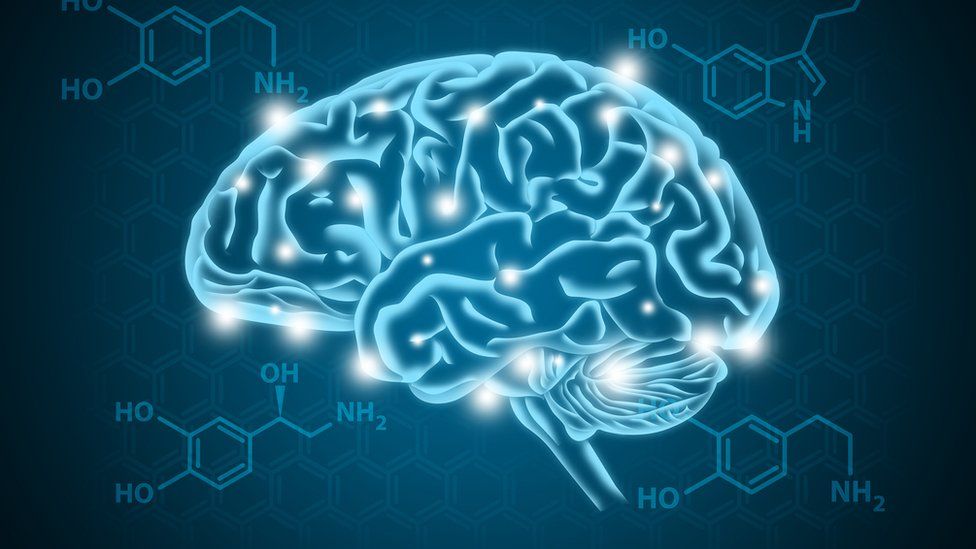
A study showing depression isn’t caused by low levels of the “happy hormone” serotonin has become one of the most widely shared medical articles.
It has provoked a wave of misleading claims about antidepressant drugs, many of which increase the amount of serotonin in the brain.
This research doesn’t show the drugs aren’t effective.
But the response to it has also sparked some genuine questions about how people treat, and think about, mental illness.

After Sarah had her first major psychiatric episode, in her early 20s, doctors told her the medication she was prescribed was like “insulin for a diabetic”. It was essential, would correct something chemically wrong in her brain, and would need to be taken for life.
Her mother had type 1 diabetes, so she took this very seriously.
Sarah stayed on the drugs even though they seemed to make her feel worse, eventually hearing menacing voices telling her to kill herself and being given electroconvulsive therapy (ECT).
Yet the claim she needed the drug like a diabetic needs insulin wasn’t based on any medical evidence.
“You feel betrayed by the people that you trusted,” she says.
Her reaction to the drugs was extreme but the “chemical imbalance” message she was given was not unusual.

Many psychiatrists say they have long known low levels of serotonin are not the main cause of depression and this paper doesn’t say anything new.
Yet the unusually large public response to it suggests this was news to many.
But some made an inaccurate leap from saying antidepressants don’t work by fixing a chemical imbalance, to saying they don’t work at all.
And doctors fear, in the confusion, people might stop taking their medication abruptly and risk serious withdrawal effects.
The National Institute for Health and Care Excellence (NICE) says these drugs shouldn’t be stopped abruptly except in medical emergencies and reducing the dose slowly can minimise withdrawal symptoms.

What did the research show?
This latest research looked at 17 studies and found people with depression didn’t appear to have different levels of serotonin in their brains to those without.
The findings help to rule out one possible way the drugs might work – by correcting a deficiency.
“Many of us know that taking paracetamol can be helpful for headaches and I don’t think anyone believes that headaches are caused by not enough paracetamol in the brain,” Dr Michael Bloomfield points out.
So do antidepressants work?
Research suggests antidepressants work only a bit better than placebos (dummy drugs people are told could be the real thing). There are debates among researchers about how significant this difference is.
Within that average is a group of people who experience much better results on antidepressants – doctors just don’t have a good way of knowing who those people are when prescribing.
Some people who take anti-depressants say the drugs have helped them during a mental health crisis, or allow them to manage depression symptoms day to day.
Prof Linda Gask, at the Royal College of Psychiatrists, says antidepressants are “something that help a lot of people feel better quickly”, especially in a crisis.
But one of the authors of the serotonin paper, Prof Joanna Moncrieff, points out most research by drug companies is short-term, so little is known about how well people do after the first few months.

“You have to say we will continue to review them and we won’t keep you on them any longer than you need to be on them,” something which often doesn’t happen, Prof Gask agrees.
- ‘Stopping medication made my depression twice as bad’
- Nearly half million more adults on antidepressants
- ‘My anti-depressant withdrawal was worse than depression’
While there are risks to leaving depression untreated, some people will experience serious side-effects from antidepressants – which the serotonin study’s authors say need to be more clearly communicated.
These can include suicidal thoughts and attempts, sexual dysfunction, emotional numbing and insomnia, according to NICE.
Since last autumn, UK doctors have been told they should offer therapy, exercise, mindfulness or meditation to people with less severe cases of depression first, before trying medication.

How was the research talked about?
One typical misleading response claimed the study showed the prescribing of antidepressants was “built on a myth”.

But the study didn’t look at antidepressant use at all.
Serotonin plays a role in mood, so tweaking it can make people feel happier at least in the short term, even if they didn’t have abnormally low levels to start with. It may also help the brain make new connections.
Others have claimed this study shows depression was never an illness in people’s brains but a reaction to their environments.
“Of course it’s both,” Dr Mark Horowitz, one of the paper’s author, says.
“Your genetics affects your sensitivity to stress,” for example.
But people having an understandable response to difficult circumstances might be better helped with “relationship counselling, financial advice, or a change of jobs” than medication.
However, Zoe, who lives in south-east Australia and experiences both severe depression and psychosis, says rebranding depression as “distress” that would go away if we “just fix all the social problems” is also too simplistic and overlooks people with more severe mental illnesses.
Psychosis runs in her family, but episodes are often triggered by stressful events such as exam deadlines.
Zoe says she has found medication, including antidepressants, life-changing and has been able to make a “calculation” side-effects are “worth it” to avoid severe episodes.
And that’s one things all of the experts who spoke to BBC News agree on – patients need to have more information, better explained so they can make these difficult calculations for themselves.
For details of organisations offering advice and support, go to BBC Action Line.
Some contributors asked that their surnames be withheld
Follow Rachel on Twitter or email your stories about antidepressants to rachel.schraer@bbc.co.uk.
Related Topics
August 17th 2022
How Psychology Can Help Fight Climate Change—And Climate Anxiety
Scientists and activists have deployed many tactics to help combat climate change: expanding technologies like wind and solar power, building better batteries to store that renewable energy, and protecting forests, all the while striving to reduce greenhouse gas emissions.
On Aug. 4, during the American Psychological Association’s Convention in Minneapolis, nearly a dozen experts turned the spotlight on another more surprising tool: psychology.
How Heat Waves Could Have Long-Term Impacts on Your HealthPosted 1 Month Ago
“I used to begin my presentations by talking about temperature data and heat-trapping gasses, but now I begin most of my presentations in the same way: by asking people, ‘How do you feel about climate change?’” said Katharine Hayhoe, chief scientist for the Nature Conservancy, a nonprofit environmental organization, during a panel discussion. “I get the same words everywhere: anxious, worried, frustrated, concerned, devastated, overwhelmed, angry, hopeless, horrified, frightened, heartbroken, and afraid.”
Simply simmering in those negative emotions won’t accomplish much: “If we don’t know what to do with them, that can cause us to withdraw, to freeze, to give up rather than take action,” Hayhoe says.
February 25th 2022
| Who Lives, Who Dies: The Remarkable Life and Untimely Death of Dr. Paul FarmerBy Amy Goodman and Denis Moynihan |
| “Who Lives, Who Dies: Reimagining Global Health and Social Justice ” was the title of a talk delivered virtually at the University of Hawaii on February 17th by renowned public health physician Dr. Paul Farmer. He was speaking from a hospital in Rwanda that he helped build along with Partners in Health, the global non-profit organization he co-founded in 1987. Paul Farmer talked of his life’s work transforming healthcare systems worldwide, where too often access to care is reserved for the wealthy while the poor are left to die. With characteristic humility, he described healthcare as a human right and his years of what he called “pragmatic solidarity” in scores of countries. The clinics and hospitals he developed in the world’s poorest regions have saved patients from tuberculosis, HIV, Ebola, cancer and more. Four days after giving his talk, Paul Farmer died in his sleep, of an acute cardiac event. He was 62 years old. “We are gutted by this loss,” Dr. Joia Mukherjee, chief medical officer for Partners In Health, said on the Democracy Now! news hour. “Just a deep, deep sorrow, a sorrow for the whole world…he combined a very fierce intellect with just an absolutely expansive heart and generosity and a real enthusiasm and joy for service and fellowship that was unparalleled. At the same time, he had impossibly high standards — high standards for medicine, that everyone should get a very First World care, that there is no First, Second and Third World, high standards for dignity.” Paul Farmer had an unorthodox upbringing, living with his parents and siblings in a converted bus in Florida. After college, he spent a year in Haiti, where he committed to helping Cange, one of Haiti’s poorest communities. The people of Cange were … Read More → |
| Related |
| Remembering Dr. Paul Farmer: A Public Health Pioneer Who Helped Millions from Haiti to Rwanda We remember the life and legacy of Dr. Paul Farmer, a public health icon who spent decades building … Read More → |
HR manager loses race discrimination case over ‘inner chimp’ comment
Mark Duell for MailOnline
A black HR manager has lost a race discrimination case after her boss asked her about her ‘inner chimp’ during a meeting about ‘Chimp Paradox’ theory.
Lindani Sibanda was offended when Clinisupplies chief executive Paul Cook asked her in a meeting how she kept ‘the chimp at bay’, an employment tribunal was told.
The question was a reference to the ‘Chimp Paradox’, a mind management tool used to differentiate between irrational, emotional thoughts and rational ones.
It was coined by psychiatrist Steve Peters and has been used to help Olympic gold medallists Victoria Pendleton and Sir Chris Hoy to victory on the cycling track.
Read More HR manager loses race discrimination case over ‘inner chimp’ comment (msn.com)
Comment This woman clearly has anxieties about being associated with Monkeys because Chimps have black fur – pink without it- and presumably is typically religion influenced into thinking humans are mini Gods. The reality that we are all primates offends ‘normal’ people. Only so much science is allowed where social control has primacy. The obsession with racism and anti racism is a source of mental illness. The reality of it all being about politics of control is not supposed to be realised – unless of course she was just on the make. I am sure it wasn’t that, but in a dog eat dog world, I would not blame her if she was. R J Cook February 15th 2022.
What Are Precognitive (Premonition) Dreams?
Updated July 15, 2021
Written by
Sarah Shoen

Medically Reviewed by
Dr. Abhinav Singh

Fact Checked
In This Article
- Can Dreams Predict the Future?
- Instances in Which Dreams Have Been Premonitions
- Possible Explanations for Precognitive Dreams
- The Future of Precognitive Dreams
Psychopaths & The Police
13 Clear Traits of a Psychopath (Spot Them)
Read More 13 Clear Traits of a Psychopath (Spot Them) – (drpsychotoday.com)
The link between crime and the antisocial lifestyle aspects of psychopathy (e.g., Self-Centered Impulsivity; SCI) is well established. However, some psychopathic traits may be adaptive in specific institutions and cultures. Lykken (1995) conjectured that socialization within first responder culture may enable “heroes,” to utilize the interpersonal and affective aspects of psychopathy (e.g., Fearless Dominance; FD) in a manner that benefits society. Previous research (Falkenbach et al., in press) suggests that psychopathy and its correlated traits differ between law enforcement officers and the community. The objective of the present study was to bring further clarity to the presence of these traits within the police community and consider the influence of socialization within police culture. Self-report measures were used to evaluate how aggression, behavioral inhibition/activation, empathy, affect, and anxiety were related to factors of the Psychopathic Personality Inventory-Revised. These measures were administered to 1450 police officers, including recruits, detectives, sergeants, lieutenants, and executives. Recruits had lower SCI and behavioral inhibition, and higher FD and positive affect than higher ranking officers. These findings support the hypothesis that there are differences in the expression of psychopathic traits and correlates in those just starting a police.
Read More (PDF) Psychopathy and Associated Traits in Police Officers (researchgate.net)
Is That Cop Dangerous? 4 Tips to Detect Psychopaths in Uniform
Author and lawyer Joseph Tully, November 17th, 2017

Psychopathic cops can be more dangerous than criminals. They are responsible for police brutality, unjustified shootings, false testimony, and many other forms of police misconduct.
Every year, dozens of people who were convicted based on a cop’s testimony, are released from prison because they were innocent. In three out of four homicide exonerations, official misconduct is a factor.
Thousands of Americans have died at the hands of cops in suspicious circumstances. This kind of behaviors are, more often than not, the work of a psychopath.
What is a Psychopath?
One of the problems with psychopaths is that they are incapable of remorse.
For Jon Ronson, author of The Psychopath Test, “Psychopathy is probably the most pleasant-feeling of all the mental disorders… All of the things that keep you good, morally good, are painful things: guilt, remorse, empathy.” For neuroscientist James Fallon, author of The Psychopath Inside, “Psychopaths can work very quickly, and can have an apparent IQ higher than it really is, because they’re not inhibited by moral concerns.”
Psychopaths have cognitive empathy, they can understand what others are feeling, but they lack the ability to feel it, which is known as emotional empathy. “This all gives certain psychopaths a great advantage, because they can understand what you’re thinking, it’s just that they don’t care, so they can use you against yourself,” Fallon explains.
In fact, research has shown that psychopaths are extremely adept at identifying vulnerability.
Psychopaths Often Become Cops
What happens when a person like that, someone who has zero concern for our feelings, is handed a gun and put in a position of power?
An encounter with a psychopath in a police uniform can be a life hazard. That’s why it is so important to be able to detect them. When you are in front of a psychopath, behaviors need to be altered, because normal social behaviors can trigger unexpected responses.
Research has shown that Police Officer is one of the top 10 professions chosen by psychopaths, ranking at number 7.
As I wrote in my book – California: State of Collusion, “Power, such as we give to law enforcement, prosecutors and judges, actually attracts psychopathic personalities who want to exert violent dominance under the color of authority. Innocent people can be subjected to a power trip police encounter, can be arrested by a megalomaniacal cop, jailed by a sadist, prosecuted by a manipulative Machiavellian and judged by a sociopath on an ego trip.”
How to Tell if a Cop is a Psychopath – Watch for these 4 Signs
Next time you dial 911, are pulled over on the road, handcuffed, interrogated, or arrested, watch for these signs to determine if you are in the presence of a psychopathic police officer.
1. They are Ambidextrous
If a cop uses both hands indistinctly, that increases his or her chances of being a psychopath. Research has shown that ambidextrous people consistently score higher on standard psychopathy tests. This has been observed in both male and female individuals.
2. They Maintain Constant Eye Contact and Show Particular Body Language
According to the gold standard for detecting psychopathic personalities, which was developed by Robert Hare, lying is one of the strategies psychopaths use to dominate. Sometimes they lie about things that don’t matter, lying is like a sport for them.
While a non-psychopath will often blink and move about in times of stress, psychopaths remain still and hold consistent eye contact. They always appear confident and secure, and they tend to be still.
Because they lack relaxed and natural movements, sometimes their perfect poise gives way to contradictory movements. For example, a psychopath’s nod may say yes while their words say no. They can also point to the left while talking about something that is on their right.
3. They Speak in a Grandiose Manner
Studies have also shown that the speech of psychopaths has some recognizable characteristics. For example, they use words like ‘because,’ ‘since,’ and ‘that’s why,’ to describe their own actions. They often speak in past tense and use utterances like ‘uh’ and ‘um’ rather frequently.
It is very common for psychopathic cops to speak highly of their own behaviors and blame others for all their problems. It is the mark of a psychopath to take no responsibility for their own mistakes.
4. They Manufacture Negative Reactions
Psychopaths enjoy creating chaos. Afterwards, they feign innocence and put the blame on you for reacting. They are masters of provocation. If a cop baits you into an argument and then pretends to be surprised, watch out; chances are, you are dealing with a psychopath.
Conclusion: Trust Your Instincts and Stay Safe
Not all cops care about justice. Many of them abuse their power. Psychopathic ones beat up innocent men, women, and minors. They shoot unarmed victims and lie to secure convictions. If you ever come across a cop, trust your instinct. If there is even the smallest sign that they might be a psychopath, you must watch your back.
Unfortunately, not all cops are there to protect you. Unfortunately, some will try to harm you and send you over the edge. If that happens, try to remain silent, and put safety first.
Our attorneys are used to dealing with problematic police officers and prosecutors who display psychopathic traits. We have psychiatrists on our teams who can efficiently detect psychopaths. If you have run into trouble with a law enforcement officer, call us, we can help restore your civil rights and hold psychopathic cops and their employers accountable.
Is the Cop Dangerous? 4 Tips to Detect Psychopaths in Uniform (jaildeathandinjurylaw.com)
Life after death? Scientist says experiences ‘incredibly real’ as ‘brain goes haywire’ – September 6th 2021
Sebastian Kettley
Out-of-body experiences are a fairly common phenomenon with an estimated 10 percent of people experiencing them at least once in their life. The OBEs can be triggered by a wide array of factors – from brain tumours to epilepsy – but are often associated with so-called near-death experiences, or NDEs. Cardiac arrest patients, in particular, frequently recall a sensation of floating outside of their bodies or even looking down at their hospital beds from the ceiling.
One woman who temporarily died as a child believes her spirit escaped her body before being sucked right back in.
A similar account was shared by a man who claimed to have left his body after suffering a near-fatal heart attack.
For many people, these experiences are deeply profound and serve to inform their beliefs in God, the afterlife and give them some sort of “meaning in life”.
Scientists are, however, unconvinced about the spiritual aspect of OBEs and instead point to a growing body of evidence that might explain what is going on in the brain during these phenomena.
Dr Jane Aspell, a cognitive neuroscientist at Anglia Ruskin University, has been experimenting with OBEs through the use of virtual reality headsets to better understand how the brain creates an identity of the “self”.
What is the difference between incel and feminism , I ask this as a serious question ? Why are there always excuses for female miscreants and killers but none for men – if equality is the true State & Feminist Goal for the masses , which it isn’t at all ? August 20th 2021.
Interesting.
https://www.bournbrookmag.com/home/sympathy-for-the-incel
Mother, 31, held her head in hands as she appeared in court accused of murdering two-year-old son at family’s £500,000 suburban homeA mother held her head in her hands as she today appeared in court over the alleged murder of her toddler son. Natalie Steele …Posted August 19th 2021

Robert Weiss Ph.D., MSW
Love and Sex in the Digital Age
7 Key Reasons Why Some Women Cheat – Posted July 7th 2021
Women are unfaithful nearly as often as men.
Posted August 29, 2018 | Reviewed by Lybi Ma

Source: Sementsova Lesia/Shutterstock
First things first: If you’re female and reading this wondering why I’m only writing about women who cheat, know that a post I published a few months ago — “13 Reasons Why Men Cheat” — has become one of my most widely read.
But now it’s time to look at female infidelity.
There is a common misperception that it’s only men who step out on their partners and that women are always faithful. To that, I say: Who are all these men cheating with exactly? Do heterosexual men only cheat with single women and each other?
The simple truth is that approximately as many married, heterosexual women cheat as married, heterosexual men. Research suggests that 10 to 20 percent of men and women in marriages or other committed (monogamous) relationships will actively engage in sexual activity outside of their primary relationship. And these numbers are likely under-reported, possibly by a wide margin, thanks to denial and confusion about what constitutes infidelity in the digital era. For example: Are you cheating if you look at porn? If you flirt on social media? If you have a profile on Ashley Madison that you check regularly, even though you never hook up in person?
To help couples answer these questions, I offer you my fully functional, digital-era definition of what it means to cheat:
Infidelity (cheating) is the breaking of trust that occurs when you keep profound, meaningful secrets from a committed primary partner.
I like this definition for four primary reasons:
1. The definition speaks to the most basic element of what happens when we cheat on our partners. We betray their trust. In such cases, even more than our sextracurricular activity, it is the lying and the secrecy of betrayal that wounds a beloved and unknowing partner (male or female).
2. The definition encompasses both online and real-world sexual activity, as well as sexual and romantic activities that stop short of intercourse: everything from looking at porn to kissing another man/woman to something as simple as flirting (now commonly referred to as micro-cheating).
3. The definition is flexible depending on the couple. It lets couples define their own version of sexual fidelity based on honest discussions and mutual decision-making. This means that it might be just fine to look at porn or to engage in some other form of extramarital sexual activity, as long as your mate knows about this behavior and is okay with it.
4. The definition helps the cheater understand that the problem he or she created occurred the moment he or she started lying to accommodate or cover up his or her infidelity. The harm is not a spouse finding out the bad news — the harm is that it was covered up.
None of that, of course, explains why women cheat. Nor does it address the fact that women and men often cheat for very different reasons.article continues after advertisement
So Why Do Women Cheat?
Typically, females step out on a committed partner for one or more of the following reasons:
- They feel underappreciated, neglected, or ignored. They feel more like a housekeeper, nanny, or financial provider than a wife or girlfriend. So they seek an external situation that validates them for who they are, rather than the services they perform.
- They crave intimacy. Women tend to feel valued and connected to a significant other more through non-sexual, emotional interplay (talking, having fun together, being thoughtful, building a home and social life together, etc.) than sexual activity. When they’re not feeling that type of connection from their primary partner, they may seek it elsewhere.
- They are overwhelmed by the needs of others. Recent research about women who cheat indicates that many women, despite stating that they deeply love their spouse, their home, their work, and their lives, cheat anyway. These women often describe feeling so under-supported and overwhelmed by having to be all things to all people at all times that they seek extramarital sex as a form of life-fulfillment.
- They are lonely. Women can experience loneliness in a relationship for any number of reasons. Maybe their spouse works long hours or travels for business on a regular basis, or maybe their spouse is emotionally unavailable. Whatever the cause, they feel lonely, and they seek connection through infidelity to fill the void.
- They expect too much from a primary relationship. Some women have unreasonable expectations about what their primary partner and relationship should provide. They expect their significant other to meet their every need 24/7, 365 days a year, and when that doesn’t happen, they seek attention elsewhere.
- They are responding to or re-enacting early-life trauma and abuse. Sometimes women who experienced profound early-life (or adult) trauma, especially sexual trauma, will re-enact that trauma as a way of trying to master or control it.
- They’re not having enough satisfying sex at home. There is a societal misconception that only men enjoy sex. But plenty of women also enjoy sex, and if they’re not getting it at home, or it’s not enjoyable to them, for whatever reason, they may well seek it elsewhere.
As with male cheaters, women who cheat typically do not realize (in the moment) how profoundly infidelity affects their partner and their relationship. Cheating hurts betrayed men just as much as it hurts betrayed women. The keeping of secrets, especially sexual and romantic secrets, damages relationship trust and is incredibly painful regardless of gender.
If a couple chooses to address the situation together, couple’s counseling can turn a relationship crisis into a growth opportunity. Unfortunately, even when experienced therapists are extensively involved with people committed to healing, some couples are unable to ever regain the necessary sense of trust and emotional safety required to make it together. For these couples, solid, neutral relationship therapy can help the people involved to process a long overdue goodbye. But cheating doesn’t have to be seen as the end of a relationship; instead, it can be viewed as a test of its maturity and ability to weather the storm.
Comment I can only conclude that these women are immature greedy attention seeking fun lovers with scant interest in the welfare of any unfortunate children they may have. Robert Cook
A Generation of Sociopaths review – how Trump and other Baby Boomers ruined the world – Posted July 6th 2021
Bruce Cannon Gibney’s study convinces Jane Smiley of the damage her own American generation has done

Jane SmileyWed 17 May 2017 07.30 BST
The day before I finished reading A Generation of Sociopaths, who should pop up to prove Bruce Cannon Gibney’s point, as if he had been paid to do so, but the notorious Joe Walsh (born 1961), former congressman and Obama denigrator. In answer to talkshow host Jimmy Kimmel’s plea for merciful health insurance, using his newborn son’s heart defect as an example, Walsh tweeted: “Sorry Jimmy Kimmel: your sad story doesn’t obligate me or anyone else to pay for somebody else’s health care.” Gibney’s essential point, thus proved, is that boomers are selfish to the core, among other failings, and as a boomer myself, I feel the “you got me” pain that we all ought to feel but so few of us do.
Gibney is about my daughter’s age – born in the late 1970s – and admits that one of his parents is a boomer. He has a wry, amusing style (“As the Boomers became Washington’s most lethal invasive species … ”) and plenty of well parsed statistics to back him up. His essential point is that by refusing to make the most basic (and fairly minimal) sacrifices to manage infrastructure, address climate change and provide decent education and healthcare, the boomers have bequeathed their children a mess of daunting proportions. Through such government programmes as social security and other entitlements, they have run up huge debts that the US government cannot pay except by, eventually, soaking the young. One of his most affecting chapters is about how failing schools feed mostly African American youth into the huge for-profit prison system. Someday, they will get out. There will be no structures in place to employ or take care of them.
The boomers have made sure that they themselves will live long and prosper, but only at the expense of their offspring. That we are skating on thin ice is no solace: “Because the problems Boomers created, from entitlements on, grow not so much in linear as exponential terms, the crisis that feels distant today will, when it comes, seem to have arrived overnight.” As one who has been raging against the American right since the election of Ronald Reagan, as someone with plenty of boomer friends who have done the same, I would like to let myself off the hook, but Gibney points out that while “not all Boomers directly participated, almost all benefited; they are, as the law would have it, jointly and severally liable”.

Gibney’s theories about how we boomers got to be sociopaths (inclined to “deceit, selfishness, imprudence, remorselessness, hostility”) are a little light: no experience of the second world war, unlike the Europeans; coddled childhoods owing to 1950s prosperity; and TV – “a training and reinforcement mechanism for deceit”, not to mention softening viewers up for ever more consumption of goods.Advertisement
My own theories are based on my experience of the cold war. I think that the constant danger of nuclear annihilation and the drumbeat on TV and radio of the Soviet threat raised our fight-flight instincts so that some of us became overly cautious (me) and others overly aggressive (Dick Cheney). I also think that our parents were not “permissive”, but that they produced too many children in an era when there was nothing much for the children to do but get out of the house and into trouble – few time-consuming tasks around the house or on the farm, plus bored mothers and absent fathers, who felt a sense of despair when they compared themselves with the shiny advertisements of middle-class perfection they saw everywhere, not just on TV. This was what America had to offer – washing machines, high heels, perfect hairdos, Corn Flakes, TV dinners, patriotism and imminent destruction.
Gibney’s book includes more than 100 pages of documents and notes, and he is best at analysing the financial details of the various forms of national and environmental debt that our children and grandchildren will eventually have to pay. He slides around the obvious – to me – solution of just shooting us so that we can’t suck social security dry (I am not in favour of shooting even rats: the gun rights advocate Wayne LaPierre, born the exact day I was due in 1949, though I came six weeks early, is surely the ultimate example of this book’s sociopaths, completely indifferent as he is to the lives lost to the gun rights lobby). Yet Gibney does convince me that those of us born between 1940 and 1965 (his definition) are a drag on the future.
His last chapter concerns what can be done before it is too late. “Remediating the sociopathic Superfund site of Boomer America will be expensive,” he writes. “In money alone, the project will require $8.65 trillion soon and over $1 trillion in additional annual investment.” Then he asserts that it can be done, that the investment will pay off, that “it will be helpful to view reform as a process of manageable fiscal adjustments”. Good luck with that, and I say that with deep sincerity. As I watch my fellow boomers, Paul Ryan, Donald Trump and Mike Pence grin and fistbump at the idea of killing their fellow Americans with their newly passed health bill, I suspect that no one, not even their children, can redeem these people.
The first sociopath I actually knew, in the 1980s, was born in 1961, just like Joe Walsh. In the 80s, he was in finance. When, over dinner, I objected to off-shoring jobs and destroying unions, he said, in a sneering, Ayn Randian way: “They don’t have a right to those jobs!” He ran through his millions and is now in jail for pimping his girlfriend. I doubt he has learned a thing.
Read A Generation of Sociopaths and hope for the best. Gibney is more optimistic than those who predict an imminent third world war, than the scientists who warn of sudden climate shifts and the end of antibiotics, and even – in one sense – than the evangelicals who believe in the Rapture. He also has a better sense of humour.
A Generation of Sociopaths: How the Baby Boomers Betrayed America is published by Hachette. To order a copy for £17.84 (RRP £20.99) go to bookshop.theguardian.com or call 0330 333 6846. Free UK p&p over £10, online orders only. Phone orders min p&p of £1.99.

Donnie Darko – Mad World – YouTube
StoriesPart of Broken hearts not broken brains
As a psychologist, I can tell you that Dominic Cummings is an enemy that few would wish to cross May 28th 2021
Emma Kenn

For a man undergoing a national, and very public grilling on one of the most controversial and divisive situations that the UK has ever experienced, from my professional opinion as a psychologist it would appear that Dominic Cummings seemed unnaturally comfortable.
Even the relaxed open-collared white shirt he chose to wear during his inquiry yesterday (26 May) seemed more fitting for a casual meal out with friends, as opposed to discussing an alleged national catastrophe – and one that he was very much a part of.
It was worryingly easy for Cummings to betray Boris Johnson, the man who once employed him as a close ally, and who invited him into his circle of trust. To the less discerning viewer, his apparent openness may perhaps wrongly be interpreted as transparency, authenticity, and even honesty. But practising for 23 years as a registered psychologist therapist, with a BSc in psychology, an advanced diploma in therapy, a masters in integrative therapy and 14 years experience as a media psychologist, I have a few observations.
In cases where someone so effortlessly offers up damning anecdotal information, it is potentially less about stating facts, and more about positioning themselves as the perfect sniper, seeming to carefully assassinate every single layer of their perceived enemy, a deeper and more discerning analysis is required.
At every single point when questioned during Wednesday’s inquiry, he was very much in charge. He appeared not to see this as an interrogation, and he appeared to feel firstly in control, and secondly superior to those requiring his responses. While initially, his body language was closed, as he became more comfortable with his performance, his open posture, in my opinion, betrayed him – becoming both emotionally and literally laid back in his chair was at complete odds with the content of his conversation, particularly in regard to his own responsibilities and failures where the Covid strategy is concerned.
At every single opportunity, he carefully offered his analysis of certain important players, and he was clever in his tactics, using first names where Chris Whitty and Patrick Vallance were concerned, casting these as the heroes in this unravelling, and suggesting that he held a “closer” relationship with these apparent “good guys”, while he simultaneously dismissed professionals like Professor Carl Heneghan, and Sunetra Gupta – two highly accomplished experts in their fields – as if their views were irrelevant, dangerous even. To me, as a psychologist, this offers further insight into his feelings of superiority and righteousness in regards to his own behaviour.
While he did apologise for the role that he played, this apparently heartfelt statement fell short due to his constant blame of others. To be truly responsible and accountable for one’s own actions, it is essential that personal culpability is fully acknowledged. Instead, Cummings constantly rationalised that he was entirely powerless and beholden to an out of control, chaotic and personally irresponsible prime minister, and in particular the health minister.
Yet, there was a flaw in his own argument towards the prime minister, as by Cummings’s own admission, Boris Johnson didn’t wish to lock down at all. Instead, he saw the long-term potential catastrophe on the economy as a bigger burden for society to bear. Yet, Johnson did lock down – again, and again – which makes little sense if he was indeed the chaotic megalomaniac Cummings would have you believe.
When he suggested wanting a “dictator” with “kingly authority” to oversee the Covid crisis, it seems to me he was likely referring to himself. His judgements of most of those who surrounded him were full of contempt, and while it is possible that Matt Hancock could have made huge errors of judgement and failures that will be exposed, the vitriol that Cummings had towards him seemed personal, as opposed to professional.
There is absolutely no doubt that Dominic Cummings is a master of spin, brilliant at his work and an enemy that few would wish to encounter. He portrayed himself as a victim of circumstance and a good man who found himself silenced by a foolish leader, and while each will come to their own conclusion as to his integrity, it is always worth asking oneself if, placed in a similar position, would you be so willing to potentially destroy those you once counted as close colleagues and friends with such ease?
Lockdowns remain a contentious issue, their impact will be felt for generations to come and their effectiveness in the scientific world is still being fiercely debated, meaning that whatever Dominic Cummings’s personal feelings are, they are not enough to cast Johnson as the villain.
Emma Kenny is a psychological therapist (MBACP)
Meet the People Who Believe They’ve Traveled to a Past Life
Christopher was an ancient Egyptian prisoner. Stephanie’s dating the man who had her murdered. They and many others swear by the controversial benefits of past-life regression. Posted April 19th 2021
- Michael Stahl

Could past-life regressing be far less time-consuming and costly than traditional forms of psychotherapy? Illustrations by Micky Walls
Christopher Benjamin was imprisoned in Ancient Egypt, alone, barefoot and cold. The stone wall he leaned against felt frigid and bone dry. Through a small cutout in the high ceiling of his cell, a single beam of sunlight taunted him. Gazing up at the peephole, he sensed that the world on the opposite side was far warmer — but certainly not more welcoming.
“I felt like I had really screwed up because I told these people in charge what they were doing wrong,” Benjamin says. “I kind of shot my mouth off. … They did not like what I told them, and so they put me in this dungeon.”
Not a single soul was around to save him. “I’m screwed,” Benjamin thought to himself. “There’s no way out.”
Fortunately, in a version of reality more adherent to its traditional definition, there was an exit: his therapist’s office door.
The unsettling visions and sensations Benjamin experienced while imprisoned thousands of years ago were part of what he thinks may have been a past life. His mind traveled to that time and place during a session of past-life regression, a practice in which a person, under hypnosis or in a meditative state, experiences a memory that they believe is from a time when their soul inhabited another body.
Some who engage in past-life regression do so simply out of curiosity about their former selves, perhaps discovering they were a knight in shining armor — or the town wench who waited on one. But others hope to treat a range of mental health issues, including phobias, addictions, anxiety and depression, which they believe could have sprung from a past-life trauma. By reliving their trauma’s origin story, they hope to better understand, and possibly ameliorate, the emotional damage lingering in their current life.
The American Psychological Association is deeply skeptical of past-life regression’s viability, and there are serious questions about the ethics of using it as a treatment. But the practice’s most steadfast backers contend that its impact can be immediate, and far less time-consuming and costly than traditional forms of psychotherapy.
Eli Bliliuos, a Manhattan-based hypnotist who often employs past-life regression in client sessions, says that “just the shift in perspective” about a traumatic event, which can materialize instantaneously with past-life regression, “can be profound.”
In psychoanalysis, an analyst will explore their patient’s life events, particularly those from childhood, in order to bring unconscious material into the conscious mind. Then they work to restructure the personality adversely affected by those repressed, emotionally damaging experiences. This process can take months or even years.
But, Bliliuos says, “In hypnosis, you go always to the most important memory you’ve experienced,” whether that’s in this life or perhaps a previous one. Thus, in past-life regression, a reckoning can begin right away.
Christopher Benjamin — a 58-year-old Milwaukee resident who asked that his real name not be used here — started psychotherapy in 2012, seeking relief from lifelong anxiety, as well as depression that had more recently developed from what amounted to a midlife crisis. Though his therapist engaged him in typical talk therapy, she also employed some out-of-the-ordinary approaches. She did not hypnotize Benjamin, but instead focused his mind through brainspotting, a type of exposure therapy. Brainspotting administrators guide the patient’s eyes across their field of vision as they recall an upsetting event. Eventually, their eyes locate a position that activates feelings associated with the memory.
“All of a sudden, it’s sort of like magic, you’re blabbing out something that was completely hidden,” Benjamin says.
After a few moments of the patient’s eyes fixing on that point, their discomfort slowly fades — not unlike how someone with a fear of heights might grow more at ease the longer they remain atop a ladder.
In the brainspotting sessions, Benjamin recounted memories from his present life, like his uncle’s suicide 30 years earlier. He’d never truly grieved the loss, and he had an unexpectedly emotional response to the memory in his therapist’s office. He was, as he puts it, “a complete mess.” But reliving the memory helped him recognize for the first time that his family has a history of mental illness, which proved oddly comforting. It wasn’t his fault that sadness seemed to consistently find him; it was genetics. He realized he just needs to work harder than most to live a more emotionally healthy, content life, and he’d already taken that upon himself by seeking therapy.
When Benjamin visited Ancient Egypt during another round of brainspotting, he was focused on one particular manifestation of his anxiety.
“I can’t speak up,” Benjamin says. “I am deathly afraid of saying anything to offend people.”
His therapist asked him to think of an instance in which he felt betrayed by something he’d once said. Soon, his thoughts drifted from present-life memories down into the dungeon. Benjamin says it became “sort of self-evident” that he’d tapped into a past-life memory. He emerged from the past-life regression “more mindful” of the root of his anxiety, and determined to conquer the fear of speaking up that haunts him in this life.
Belief in reincarnation dates back to at least the oldest scriptural texts of Hinduism, written nearly 3,000 years ago in India. Greek philosophers like Socrates and Plato also entertained the idea, as did some Gnostic Christian groups from the turn of the first millennium, as well as 17th-century Jews who practiced Kabbalah. Today, 33 percent of American adults believe in reincarnation. (American women subscribe to the belief at a 12 percent higher rate — 39 percent overall — than men do.)
Notions of reincarnation are diverse and nuanced, but for past-life regression advocates like Eli Bliliuos, the New York hypnotist, “The basic belief is that we are souls; we choose to incarnate these bodies for purposes of learning from experience, growing from experience.”
In another past-life regression session, Christopher Benjamin found himself canoeing in wide-open waters, enjoying a day out with a person who he understood intuitively to be his younger brother. As the elder sibling, Benjamin naturally accepted the responsibility of caring for him, of protecting him from danger.
“It was really, really blue and wavy, choppy water,” Benjamin says, “and I don’t specifically remember how it happened, but he went overboard.”
His little brother disappeared, into the void of the water.
“And I’m freaking out, and then I can’t find him,” Benjamin continues. “And the rest of [the memory] is the dread of having to tell everybody what happened. That was hideous.”
Before this particular past-life regression, Benjamin was talking with his therapist about a strange preoccupation he’d developed with a co-worker, whom he found himself always trying to protect. In the canoe that day, Benjamin sensed that his past-life brother was a previous incarnation of the co-worker. The past-life version of Benjamin blamed himself for the man’s untimely death, but experiencing the memory altered Benjamin’s perspective about why he obsessed over his co-worker in this life. On some core level, Benjamin wanted to look out for him, to protect him. Going back to his past life, he says, helped him move on.
“After the session, I’m like, Oh, OK. Well that happened way back in the past, and I don’t have to worry about that anymore,” Benjamin remembers.
Sigmund Freud introduced the concept of regression in the 1890s, utilizing it in psychoanalysis, at first via hypnosis and then in talk therapy. Through regression, his patients could confront childhood events and traumas that continued to create emotional stress in their adult lives.

The Search for Bridey Murphy, a book written by Bernstein and published by Doubleday, became a best seller in 1956 and was adapted into a movie. The 1995 New York Times obituary for Virginia Tighe — later Virginia Mae Morrow — said, “Bridey Murphy became a 1950s phenomenon rivaling the Hula-Hoop. There were Bridey Murphy parties (‘come as you were’) and Bridey Murphy jokes (parents greeting newborns with ‘Welcome back’).” The Times also reported that The Search for Bridey Murphy “triggered an interest in reincarnation and the use of hypnosis to regress a subject to early childhood, and perhaps beyond.”
During the following two decades, Ian Stevenson, then chair of psychiatry at the University of Virginia, chronicled about 3,000 cases of people from around the world, mostly children, with past-life memories, and Morris Netherton wrote what he claimed to be the first book in the field of past-life regression therapy.
Dr. Brian L. Weiss has been perhaps the most prominent American figure in the practice since the 1980s, publishing 10 books on past-life regression and related subjects. Once a traditional psychotherapist, Weiss — who declined to be interviewed for this story due to his busy schedule — has written that he was a past-life regression skeptic at first. But a hypnotized patient of his, whom he called “Catherine” in one of his books, recounted past-life memories that were so precisely outlined and, as it turned out, historically accurate, that he felt it was impossible she could have invented them.
Weiss has led mass past-life regression sessions, and he conducts five-day training workshops for psychotherapists and others. In a New York Times article that chronicled one of his training workshops, Weiss drew more than 200 people into a meditative state and encouraged them to walk through doors labeled with years such as 1850, 1700 and 1500, where some past-life memories may have resided. Weiss was quoted in the piece as saying, “Any good therapist can use these techniques and you can learn them in a week.” There are also online past-life regression courses, open to anyone, some as short as a few hours long and costing only about $100.
Matthew Brownstein, founder of The Institute of Interpersonal Hypnotherapy, says these quickie training programs are “holding back a glorious profession.”
“I’m actually appalled by what’s out there,” he says. “We worked really hard, myself and other leaders in the field, to make hypnotherapy a federally and state-level acknowledged occupation, and it’s technically illegal to train somebody as a hypnotherapist if you’re not licensed to do so.”
Brownstein adds that if a person could become a medical doctor in four hours, “it wouldn’t make medicine look all that appealing.”
He says the hands-on training offered at a school like his is extremely important. Aspiring practitioners of hypnosis should know that “some very dark stuff can come up.”
“Even though you’re looking for, just say, past-life [memories],” he continues, “there are a lot of other … really out-of-this-world phenomena that occur in the altered state that someone needs to be trained to deal with.” Examples of these special instances, Brownstein says, range from remembrances of alien abductions to “channeling,” when a client acts as a conduit for the spirit of a deceased person and communicates their messages.
Stephanie Riseley rested one hand on her husband’s chest as he died in his hospital bed after a months-long battle with leukemia. Riseley says her husband’s “heart just stopped, and then I had this feeling that he flew through me.”

Perhaps sensing that she was having difficulty forgiving herself for not doing enough to save him, he added: “You must honor what we had together and forget the rest. … Please forgive me. And forgive yourself for not being superwoman.”
Soon thereafter, her husband “started chatting with me and having wild sex,” Riseley says. “I am not the only widow that this happens to, by the way.”
Once she opened herself up to the idea that her husband could interact with her from the beyond, she says, he began running his energy through her body, and orgasms were a regular occurrence. The encounters — sexual and conversational — went on for nearly a year, before he had to move on to his next life.
“He ultimately became a little African girl,” Riseley says.
Riseley, who lives in Los Angeles, wrote a book about these interactions called Love From Both Sides. She is now a hypnotist who trained under Brian Weiss, and began guiding her own clients through past-life regressions in 2004.
She says that over the past eight years she’s also been “dating the man who had me murdered in my direct past life.”
Riseley believes she was a male descendant of the Rothschilds, the famed family of bankers, in her most recent past life. She says she was a Jewish doctor who lived in Germany as the Nazis rose to power. Riseley was married, but cheating with a showgirl, who also slept around with Nazi SS officers. When the past-life version of Riseley told the showgirl he was fleeing Germany with his wife and daughter, the showgirl sold him out to the Nazis, and the whole family perished in the Auschwitz concentration camp.
Riseley also says that she realized during her past-life regression into Nazi Germany that her wife from that past life had been reincarnated as her high school best friend in this life, while the showgirl returned as her current boyfriend.
“In that past life I was a complete narcissist: rich, entitled, totally self-involved,” Riseley says. “I wasn’t appreciative. … And in this lifetime? My lesson is to see what it feels like to be surrounded by complete narcissists.”
From exploring her past life, Riseley says, she is learning compassion and forgiveness. “You’re not supposed to die wanting to kill somebody, that’ll come and bite you in the butt,” she explains. “So I’m forgiving him.”
“Certainly, I can’t prove to anybody that past-life regression is real or not real,” says Eli Bliliuos, “but doing it as often as I do and having people have similar experiences, after a while it sort of proves itself.”
Bliliuos first sought out past-life regression himself in his late teens, after losing both of his parents within a year — his father died of cancer; his mother passed after a fall on icy subway stairs. He says that in his regressions into past lives, he has encountered his parents’ souls, which eased his anguish because he knew he’d come across them again in some future life. His subsequent journeys into other past lives — one sent him to 13th-century Italy, where he was a merchant with an unknown but debilitating illness — have continued to help him improve his outlook on this life.
Bliliuos and other advocates of past-life regression say that you don’t have to believe in reincarnation to benefit from the experience. He recalls one session with a client who told him that they thought their past-life regression was a figment of their imagination.
“That’s perfectly fine,” Bliliuos responded, but he asked them to at least consider whether the vision might be a message from their unconscious. If it had some relevance to their life now, then the important element of the experience was the lesson they took away from it.
“Who cares if it’s ‘real’?” he adds.
As effective as past-life regression may be for some, the practice has drawn plenty of criticism throughout the years. In a 1995 Chicago Tribune article, Dr. Mel Sabshin, who was the medical director for the American Psychiatric Association at the time, said that the organization regards past-life regression as “pure quackery.”
“[P]sychiatric diagnosis and treatment today is based on objective scientific evidence,” Sabshin explained. “There is no accepted scientific evidence to support the existence of past lives let alone the validity of past life regression therapy.”
The American Psychological Association (APA) calls past-life regression “highly controversial,” stating that most hypnotherapists are “skeptical of the practice and do not recognize it as a legitimate therapeutic tool.” The APA adds that “clinicians generally consider actual past-life enactments to be manifestations of psychopathology.”
Since the Bridey Murphy episode entered the zeitgeist in the 1950s, specialists have concluded that the hypnosis-induced interviews were the result of cryptomnesia, which the American Psychological Association defines as “people mistakenly believ[ing] that a current thought or idea is a product of their own creation when, in fact, they have encountered it previously and then forgotten it.” The APA likens cryptomnesia to “inadvertent” or “unconscious plagiarism.” It turns out that when Virginia Tighe — the woman who believed she was once Bridey Murphy — was growing up in Chicago, she lived across the street from a woman named Bridey. Tighe also had an Irish aunt who told her stories from the old country.
Gabriel Andrade, assistant professor of psychology at Ajman University in the United Arab Emirates, published a 2017 medical journal article titled “Is Past Life Regression Therapy Ethical?” He argued that “the reincarnation hypothesis … is not supported by evidence, and in fact, it faces some insurmountable conceptual problems.” He cites the world’s population growth as one example, asking, “Where did these additional souls come from?”

Past-life regression supporters, however, say that a subject will experience the past-life regression, even a ghastly death, only to recognize that their soul carried on, unabated, past the trauma, and they can take solace in that ultimate outcome.
“Nobody comes in [my office] and goes through a traumatic experience they can’t handle,” Bliliuos says. “It doesn’t work that way.”
But, as Andrade says in an email to me: “The client/patient may develop new phobias, and may have increased anxiety and depression, as a result of believing that he/she underwent traumatic experiences, even though these experiences may have never been real in the first place.”
In Andrade’s paper, he pointed to “the Satanic Ritual Abuse moral panic of the 1980s” in the United States as a far-reaching, stark example of the damage memory implantation can cause. Throughout the decade, hundreds of people underwent hypnosis to recover memories of sexual and ritual abuses, allegedly conducted against them during early childhood.
“A thorough FBI investigation was carried out, and no evidence whatsoever was found to support the allegations of sexual and ritual abuse,” Andrade wrote. Because their hypnotists had asked leading questions, “these false memories had come to be perceived as quite real by the subjects … who had to face the troubling consequences of having false memories of traumatic events that, in fact, had never happened to them.”
“My conclusion, then,” Andrade states, “is that it is better to play it safe.” He advocates that people seek out more evidence-based forms of treatment instead.
I am not a person of faith. I thank God for the gift of cookie dough ice cream as I savor the first spoonful out of a fresh pint, but for the most part, that’s about as spiritual as I get. The idea of reincarnation has never seemed plausible to me. I have had brushes with “the unexplained,” however. When I was about 3, and just learning to speak in sentences, I was sitting with my dad and his father, watching 30-year-old 8-millimeter home movies. The clips starred the two of them, great-grandparents and other deceased relatives of mine, as well as an uncle and some cousins, then in stages of toddlerhood and infancy. I’ve no memory of this, but my father says that, out of nowhere, I leaped from my seat, pointed at the screen, and yelled something to the effect of There she is that sunuvabitch!
“You went wild,” Dad tells me in a recent phone call. “And the way you talked was so clear, that was part of the shock of it.”
He has no idea who appeared on the TV that got me so riled up, and he says that my outburst was very out of character. A belief in past lives might suggest that I’d previously been one of my departed family members, or that I channeled someone else’s spirit and shouted out searing anger on their behalf. Personally, I’m pretty skeptical of either explanation.
So when I arrived at a past-life regression group workshop conducted by Johanna Derbolowsky, a Los Angeles–based spiritual healer, I maintained my robust skepticism. The event was held in Midtown Manhattan, at a community space geared toward mindful practices and performances. Derbolowsky, a German immigrant, speaks softly and has a calming presence. She characterized the workshop as a “past-life regression meditation,” devoid of hypnotism. She stood in front of a tightly quartered crowd of 38 attendees, almost all women.
I’ve been in talk therapy for nearly six years — treatment for a moderate panic disorder and depression — and I have experienced continuous progress throughout. In that, I’m a believer. But at the top of the past-life regression session, Derbolowsky mentioned that it didn’t matter if we regarded past lives as legitimate phenomena. She instructed us to close our eyes and focus on breathing deeply. As we relaxed, she told us each to think about something that we’ve frequently worried about. For me, that’s concern about my ability to financially sustain myself as a freelance writer. It often feels as though at any given moment I could be completely out of work. With the cost of living being what it is in New York City, I still have roommates at the age of 41 and no semblance of a retirement fund. The forecast for my future sometimes seems gloomy.
In the session, we each considered our fear, and then Derbolowsky said, “Now, I want you to throw it away.”
Just like that, I stopped worrying for a moment. My body relaxed even more deeply.
After engaging in some group sharing about giving our fears the mental boot, Derbolowsky again told us to close our eyes, breathe deeply and picture a vast closet, teeming with costumes. She then said something to the effect of “Find the costume you’re most drawn to, and try it on.”
I found myself fully engaged in the vision. I picked out an engulfing, furry animal skin shroud, dark trousers and high boots, like something Leonardo DiCaprio wore in The Revenant.
“Now, go out into the world with your costume on,” I recall Derbolowsky saying. “Look around, take in the sights, the sounds.”
I was in a deep wood. It was sunny, but water droplets falling from high above sporadically made the leaves around me flutter. A beautiful deer poked its head out from the foliage, eyeballed me briefly, and then disappeared. I felt at peace, but lonely.
After a few minutes, Derbolowsky told us to take ourselves into “the next scene,” and suddenly it was night. Still alone, I was eating meat cooked over a campfire. Still lonesome, I thought to myself, Look around for your family, but no figures emerged.
I took the vision as a reflection of my real-life loneliness and isolation, due in part to my career choice. (As a freelance writer who works from home, it’s not uncommon for me to go an entire day without having an in-person conversation with anyone.) I’m also currently single and, since childhood, I’ve always felt somewhat disconnected from my family, filling the “weird one” role nicely. The vision gave all of this new weight and immediacy, motivating me to address it somehow.
In a phone interview a few days later, Derbolowsky offers a different observation.
“You came up in the visualization as somebody that’s in the middle of nowhere, and his food and supply just appeared,” she says. “You didn’t have to worry.”
She told me that I am probably a pretty resourceful guy, and that because I’ve figured out how to take care of myself for this long, there’s no reason for it not to continue.
“Yeah, I just have to keep pluggin’ away,” I say.
“Obviously you have to act and look and do,” she adds, “but you also have to know that opportunities will show up.”
Though I took more than I expected away from Derbolowsky’s workshop, it did not reveal that I was once an influential philosopher, a warrior leader, a powerful sultan or any other figure of particular import. The most popular examples of past-life regression found on the internet feature such grandiose characters — like the actress Shirley MacLaine’s yarns of having sex with Charlemagne the Great, and her belief that her dog is the reincarnation of an Egyptian god. To that point, hypnotist Eli Bliliuos says, “If you say that you were Eisenhower, you’re gonna get more hits on your Facebook.”
While Derbolowsky says that one client of hers regressed not only to prehistoric times but also into the body of a saber-toothed tiger, she, like Bliliuos, confirms that most people who experience past-life regressions recount ordinary lives of fairly common folk.

She insists suggesting such fodder is “useless.” The value in past-life regression does not materialize from the status of the person you were, but rather from how the experiences are relevant to your current life.
Along with his visions in Ancient Egypt and of canoeing with his brother, Christopher Benjamin has also had a third notable past-life regression.
“I’m dancing in a group setting and, it sounds so cheesy, but as like a flamenco dancer,” Benjamin says. “It felt like Spain or Portugal — I don’t know. But I’m picturing it was the 1800s.”
Benjamin had told his therapist in session that day that he wanted to focus on the malaise and lack of joy that had settled into his life, compliments of his midlife crisis and his family’s history of mental health struggles. She instructed him to think of a time when he didn’t feel so disgruntled and numb — a time, instead, when he relished life.
“And I’m dancing with this woman, who is extremely beautiful, and I desired her with that, like, burst of passion when you first meet somebody,” Benjamin continues. “It represented being alive, with passion that I lacked.”
As the remembrance continued, he slowly understood that the soul of the woman he’d danced with a couple hundred years ago was that of someone still very close to him today.
“I realized that it was my daughter,” he says, “which is freaky when you think about it because you don’t want to think that way about your daughter, but I did.”
Putting the unwanted implication of incest aside, Benjamin says that the vision “was so refreshing because, when you feel so bad, to see a time when you did feel good is so important. And it made me feel so much better.”
Whatever he may or may not have actually experienced during that dance, Benjamin says he takes great comfort from the fact that he — his soul — is loved, has always been loved, and will always be loved.
Michael Stahl is a freelance writer, editor and journalist based in Queens, New York, whose work has been published in many print and digital publications, including Rolling Stone, Vice, Vulture, Village Voice, Mic, Quartz, and CityLab. His first book, Big Sexy: Bartolo Colón in His Own Words, was published by Abrams Books in May 2020. He is a contributing editor and the layout manager at Narratively.
How Not to Care When People Don’t Like You April 19th 2021
Everyone is disliked by someone. Don’t let it slow you down.
- Rebecca Fishbein
Read when you’ve got time to spare.

When I was in high school, I found out that my friends didn’t like me. One of the girls in my “group” told me I wasn’t invited to a birthday party because “everyone” thought I was annoying—which, to be honest, at 15 I probably was—and for months I was ostracized. It took some time for me to worm my way back into the gang, but until then, I was devastated, and I swore I would spend the rest of my life being likable.
But, as David Foster Wallace (sorry) wrote in Infinite Jest (sorry again), “certain persons simply will not like you not matter what you do,” and no matter how likable you think you are, you’re not going to win over every person you meet. “Remember that it is impossible to please everyone,” Chloe Brotheridge, a hypnotherapist and anxiety expert, tells us. “You have your own unique personality which means some people will love and adore you, while others may not.” Of course, while this concept is easy to understand on its face, it’s difficult to keep your perspective in check when you find you’re, say, left out of invitations to happy hours with co-workers, or getting noncommittal responses from potential new friends, or you overhear your roommates bad-mouthing you. Rejection is painful in any form, whether it be social or romantic, and it’s a big ego blow to get bumped from the inner circle.
Before you freak out, keep in mind that it’s not just normal to be occasionally disliked, but in fact, it’s healthy. Rejection is a way to suss out who’s compatible with whom, and just as getting romantically dumped by someone leaves you open to finding a better suited partner, getting axed from a social group gives you space to find folks that are a little more your speed. Plus, it’s empowering not to fear being disliked—not that you should run around violating social norms, but when you’re not wasting energy molding your personality to someone else’s to be accepted, you’re more likely to find people who genuinely like you for you, and those relationships are far less exhausting to keep up.
Still, it sucks to feel disliked. Here’s how to get through it without falling down a rabbit hole of sadness.
It’s okay to feel the pain
Humans are social creatures, and so we experience painful biological responses to rejection. “Historically it was essential for our survival,” Brotheridge explains. “When we were evolving and living in tribes, being rejected and kicked out of the community would have been a matter of life or death.” When we get rejected, our brains register an emotional chemical response so strong, it can physically hurt. We’re also likely to cycle through a series of responses that’s not dissimilar to the stages of grief. First, the blame game starts. “The first stop on the train is self blame: ‘It’s my fault, I did something to upset them,’” Sean Grover, a psychotherapist and author of When Kids Call the Shots, tells us. Up next is shame: “You feel ashamed, you feel humiliated, you feel weak,” Grover says.
Then, like any dumped individual, you’ll probably try to win back your rejecter. “Not because, necessarily, you want them to like you, but you just don’t like this feeling of being disliked,” Grover says. “It’s, ‘Let me get you to like me so I can feel better about myself.’” Last but not least, you’ll likely feel like you’re a failure, and that’s when it gets dark. “These are very, very, primitive early feelings. For somebody not to like you, it induces a regression,” Grover says. “Generally, that brings you back to high school, middle school, elementary school, when it was all about whether you’re cool or not. Once you get caught in the feeling, it really pulls you under, and then you’re struggling.”
These feelings aren’t exactly pleasant, but they’re also perfectly healthy and normal, so long as you don’t end up dwelling on them, preventing yourself from moving forward.
Know that it’s not (totally) your fault
This type of rejection is literally personal, and it’s easy to start questioning your self worth when someone makes it clear they don’t like you. But we all act out of our own insecurities and unique experiences, and for the most part, being disliked is a measure of mutual compatibility. So, it’s not really that it’s not you but them, so much as it’s both you and them. “This person, this situation, where they are in their life, it’s not compatible to where you are,” Jennifer Verdolin, an animal behavior expert and adjunct professor at Duke University, tells us. “We have preferences in terms of personality, and that’s not to say that your personality is bad. It’s different from mine, and I prefer to hang around people who are similar to me.”
Sometimes, the people who dislike you don’t think certain facets of your personality jibe with theirs; sometimes, you just don’t offer them enough social capital to be worth their time. “Because we’re a very social species with a pretty intense dominance hierarchy, especially when it comes to work, and sometimes in social situations, people make specific strategic alliances and switch alliances as it suits them to meet their needs as they define them,” Verdolin says. “So people will try to achieve status, and a lot of time, whether they like you or don’t like you may have nothing to do with who you are.”
Either way, likability has a lot to do with what you bring to someone else’s table, whether or not you realize it. “We see this in all kinds of species. They preferentially tend to spend time, outside of mating, with either individuals who are similar to them in status, individuals who are similar to them in personality, individuals who are similar to them in some sort of way genetically, so, family,” Verdolin says. “So if you don’t have anything in common that is equally valuable to both parties, then you will likely be rejected. It’s kind of an inevitability.”
But watch for signs of your own bad behavior
While you shouldn’t always blame yourself if someone doesn’t like you, if you’re finding this is a pattern, you may want to take an unbiased look at your own behavior. “When I put people in a [therapy] group, I get to see immediately what problems or tics or bad social habits they have,” Grover says. He recalls a successful, handsome male patient of his who was having trouble holding onto romantic relationships. Though they were unable to solve the problem together in individual therapy, Grover managed to convince the patient to join a group. “Within five minutes, I was horrified,” Grover says. “He gets very anxious in front of people, and to camouflage his anxiety he becomes overly confident, which comes across as arrogant. The women in the group commented that he was becoming less popular the more they got to know him.”
The patient’s anxiety was manifesting in such a way that he had difficulty relating to people in a social setting, but because our own egos tend to protect us from our faults, he wasn’t aware of his bad habits. “I had to help him be aware of how his anxiety manifested,” Grover said. “Anxiety can make people act aggressive or really anxious, and in a group situation it’s super effective to see that.”
One way to find out what’s going on, Verdolin says, is to ask for feedback as to why you’re disliked. Then, if someone tells you, say, you’re annoying, or overly braggy, or self-obsessed, you can take a step back and analyze whether there’s some validity to the criticism.“Ultimately you have to know who you are well enough to say, okay, that information sounds pretty valid, I do tend to do that, I can see why that might not be attractive to other people, so I’m going to work on changing it,” Verdolin says. “You might be being given important information that you should take a look at seriously, and evaluate to see if there’s truth to it.”
Still, remember that while some of your behaviors might turn people off, likability is typically a two-way street. “It is, more often than not, some sort of reflection of [the other person’s] history, their prejudices, their fears,” Grover says.
Remind yourself that making new friends is no easy task
One of my greatest fears is that I’ll start a new job or move to a new place where I don’t know anyone and have to make new friends. Changing your social circle can be isolating; it’s when you’re most likely to feel disliked or suffer from social anxiety. “I think we have a little bit of an unrealistic expectation that we should be able to [enter social groups] anywhere, with all people,” Verdolin says. “When you’re first trying to establish rapport in relationships with people in, say, a new work environment, you’re coming into a dynamic that’s already set in structure. There are already cliques, there are already personalities, there are already dynamics, and you have no idea what you’re stepping into.”
Verdolin suggests that people faced with starting a new job or making a big move start slowly to get a sense of their new social environment. “With animals, sometimes they’ll integrate by having a sampling interaction with everyone else in the group before making decisions, to kind of get a lay of the land, so to speak, before trying to jump right in,” Verdolin says. At a new job, for instance, it might be worth suggesting going to lunch with folks one-on-one, to find the group’s friendliest entry point. “Some people are very welcoming and some people are not,” Verdolin says. Get to know people slowly, and focus your energy on those who seem most receptive, rather than the group’s most exclusive members, or toughest nuts to crack.
Spend extra time with the people who do like you
Even if you find yourself on the outs with some folks, chances are, you’ve at least got a few people you can rely on when you’re feeling low. “Spending time with people that care about you can boost your self-esteem and help you to feel more secure,” Brotheridge says. Besides acting as a balm to your wounded ego, focusing your energies on relationships with people who appreciate you will, in the larger picture, be a much more fulfilling use of your time and social energy.
And keep in mind that the best way to make genuine friendships is to be genuine yourself. “If you just walk around wanting to be liked, it’s very stressful, and people will read that as inauthentic,” Grover says.
And tell the haters to suck it
At least, tell them in your head. Grover says that when all else fails, it’s best to embrace having the occasional enemy. “Delight in it. Really, just enjoy it,” he says. After all, as Grover says, sometimes it’s actually better to be formidable. “If people are jealous or whatever, all feelings are welcome.” You don’t need to go around antagonizing people, but if someone doesn’t like you and the feeling is mutual, you don’t necessarily have to go out of your way to appease them, either.
How the Physical Body Holds Mental Tension
The connection between mind, body, posture, and stress Posted April 18th 2021
If you’ve ever endured a nerve-racking situation followed by a throbbing noggin, it wouldn’t seem far-fetched to connect one with the other. Nearly one in four adults reports experiencing multiple headaches every year in the United States. The World Health Organization estimates 50% of all adults have at least one headache annually. Though there are over 150 types of headaches, tension headaches are the most common and often triggered by stress. Yet while doctors might agree the two can be linked, they still don’t understand exactly how.
Brian Cole, MD, an orthopedic sports medicine surgeon at Midwest Orthopaedics at Rush and a professor of orthopedics, anatomy, and cell biology at Rush University Medical Center, agrees with this sentiment. “The exact reason why stress creates headaches is still unclear. One theory is that muscle tightness in the neck and head, which can reflexively increase with stress, results in dull tension headaches.”
It’s reasonable to presume a relationship between a headache and stressful thought exists because of where the brain is located. Since thoughts tend to be associated with the mind — which is often synonymous with the brain — they all appear to reside in the same place. However, the farther down pain travels in the body — further distancing itself from the head — the murkier the relationship between thoughts and tension becomes.Yes, We Really Are Having More Headaches Right Now — Here’s WhyPeople can experience stress in different ways during the pandemic. Many of those experiences can trigger headaches.elemental.medium.com
When pain is felt, it’s usually assigned to a specific body part. Localizing pain to a certain region inadvertently disconnects it from the rest of the body, thus making its origin harder to pinpoint. For instance, there is a low likelihood a medical doctor would suggest the onset of torticollis, a form of neck strain, is the result of ruminating thoughts. Linking kyphosis, or hunchback, with depression sounds even less plausible. But are connections like these really so hard to believe? Not according to Erik Peper, PhD, a professor of holistic health studies at San Francisco State University.
The manifestation of thoughts in the body
In his study, “How Posture Affects Memory Recall and Mood,” Peper illustrates how thoughts and body tension are interrelated. Participants were asked to recall negative memories while sitting in slouched and upright positions. They were told to do this again, but this time to think of positive memories. Peper’s research found that 86% of participants reported it was easier to access negative memories when collapsed than upright, and 87% of participants said it was easier to access positive images while erect than hunched over.
Peper explains, “If you are in a collapsed position, I think almost everybody finds it harder to access or be really involved in a positive memory and vice versa. When you’re in the upright position, it doesn’t mean you can’t have negative or hopeless thoughts. However, if you keep that opposition — as if you’re slightly removed from the emotional impact, once you’re in the upright position, it’s easier to access the more empowering and positive thoughts. Because thoughts and body are not separate.”
The evolutionary patterns of posture are described in Peper’s book, Tech Stress, where he examines the prevalent symbols of power throughout evolution. “A depressed or collapsed posture is a universal symbol of constricted posture in both humans and animals. In nature, throughout the animal kingdom, collapsed posture indicates submission. On the other hand, erect posture universally indicates leadership.”
But don’t get too excited about straightening your back just yet. There is a difference between sitting tall — which connotes length — and sitting straight. The latter has become a well-known way to command sitting correctly. Thoughts evoked by picturing a “straight” back might resemble a soldier pose, the most common depiction of what “standing up straight” looks like. Yet, if the images associated with a straight back were truly congruent with alignment — or balance for that matter — good posture would not be analogous to a fixed and tense figure.Everything You Know About “Good Posture” Is WrongCould the way you’re aiming to hold your body be making pain worse?elemental.medium.com
The power of habit
The desire to perform activities successfully is a deep-seated norm. “Sitting up straight” is the perfect example of how people may unwittingly arch backs, lift chests, pull back shoulders, and tighten necks — namely contort their bodies — in a strained attempt to do it the “right” way. Because the alternative — collapse — represents defeat.
A century-old method known as the Alexander technique was developed upon the principle of unknown habits. The founder of the technique, F.M. Alexander, was a Shakespearean actor who repeatedly lost his voice during performances. He thought he was doing everything right, yet his problem only worsened.
Alexander sought the aid of medical professionals to fix his problem but to no avail. He came to wonder if perhaps it was something he was doing to himself that caused his laryngitis. He learned that once he stopped repeating certain habits — such as standing soldier-like while performing — his voice returned. More importantly, he discovered the self-imposed pressure to perform successfully resulted in tense and tight positioning that constricted his breathing and voice.
The next time you sense the slightest tinge of stress — whether you’re running late or feeling angry, frustrated, or generally inadequate — just pause. Take note of what is happening in your body. Catching that moment is key.
Common contributing stressors
Wanting to succeed in life is part of human nature. Social comparison theory tells us that individuals determine their own worth based on thoughts of how they stack up against others. Yet, comparison doesn’t always lead to self-improvement. For example, social media has made measuring up seem impossible as it takes a considerable toll on self-esteem and can lead to depression.
In addition to the pressure of achieving or maintaining success, Americans are notorious workaholics. They work long hours, take few vacations, are more likely to work at night or on weekends, and feel pressured for time. It’s no wonder Americans are among the most stressed people in the world.
Beret Arcaya, a master Alexander technique teacher and the founding member of the American Society for the Alexander Technique, describes this as a “habit of thoughts.” She says this is something we do with our brain and we don’t have to. “You don’t have to be on that rat race. You really don’t. But you’ve got to get conscious of when you’re doing it.”
The way you react to each situation is a choice, though until that choice is realized, the reaction remains a habit. When it comes to lack of time, Arcaya explains, “You have to say, ‘Ah, I was just thinking that way again — I don’t have any time, I don’t have any time, I don’t have any time!’ Wait a minute. Stop and feel what happens to your breath.”
Arcaya tells her students there may never be enough time, but that’s fine. There might even be a way out of the rat race if you don’t react to it. She says, “Don’t even argue with the habit. Don’t even argue with ‘I don’t have enough time, or I didn’t have time today.’ It will make you stay in the moment, and that will elongate the time.” In other words, wait before responding to a stressful thought because that delay keeps you in the present.
Psycho-physical pain
Having taught the Alexander technique for over 40 years, Arcaya is no stranger to human behavior and how habits present themselves as tension. A renowned teacher, people come to her when they have exhausted all other options to ameliorate their pain.
One such woman came to her after suffering for years with terrible neck pain. Doctors couldn’t find a way to help her. They didn’t consider her stress level even though thoughts of neglect, abandonment, betrayal, and loss consumed the woman’s life. She developed a wrenching spasm of the neck called torticollis shortly after the passing of someone beloved to her.
Arcaya recalls it was way beyond a stiff neck, the woman was essentially trapped in her pain. The pain made it impossible to eat or walk properly, forcing her to walk sideways. It seemed the woman couldn’t face the events of her life. Her head was turned away, and the tension locked it there. It was as if it was all too much; she couldn’t even look at it.
When asked if she believed thoughts could directly impact the body, Arcaya responded, “Thoughts and the way you think — and the whole way you are when you are thinking — is your body tension. It doesn’t impact it; it is it.”
See it to believe it
As past president of the Association for Applied Psychophysiology and Biofeedback, Peper is an established biofeedback expert. His work focuses on training individuals to learn awareness and gain control of body functions through the aid of electromyography (EMG). During a treatment, biofeedback sensors are attached to the skin to measure the body’s biological signals that are shown as feedback that informs and assists in health improvement.‘Biofeedback’ Could Ease Headaches, Anxiety — and Maybe a Lot ElseBy providing a window onto the body’s inner workings, biofeedback could help people control what was once thought to be…elemental.medium.com
The psycho-physiological principle asserts that “every change in the physiological state is accompanied by an appropriate change in the mental-emotional state, conscious or unconscious, and conversely, every change in the mental-emotional state, conscious or unconscious, is accompanied by an appropriate change in the physiological state.”
Another study led by Peper, who was instrumental in establishing the first holistic health program at a public university in the United States, recorded physiological signals demonstrating the mind-body connection.
A 25-year-old participant who had been playing the piano for 16 years was asked to relax and then imagine playing a musical piece in a series of intervals. Muscle activity was recorded from her right forearm extensor muscles and displayed on a large screen so that other group participants could observe. Each time she imagined playing the piano, the forearm extensor muscle tension increased, even though there was no observed finger and forearm movements. The physiological monitoring showed how her body responded to “playing” only in her thoughts. When recordings of her movement were shown later, she reported being completely unaware of activating her muscles — especially since her forearm appeared to stay in a relaxed position.
If the mere conscious thought of performing an activity (such as playing the piano) can evince body tension, what can be said about the impact of unconscious thinking? This begs the question of what might happen to the body with repeated thoughts of anger, resentment, and hopelessness — or with thoughts of kindness and love.
What you can do (or not do) about your thoughts
According to Arcaya, thoughts don’t have to become tension. She says, “We’re always directing ourselves. We don’t realize it a lot because it is subconscious.” She notes that direction provides a purpose toward a goal that serves to guide or motivate. “To have conscious direction is to take agency over your life. It’s to have self-possession. To take your energy and decide what you will and what you will not do.”
When thought is attached to an expectation and the outcome is unmet, the reaction will translate into tension. That is unless the habitual response is recognized first. The next time you sense the slightest tinge of stress — whether you’re running late or feeling angry, frustrated, or generally inadequate — just pause. Take note of what is happening in your body. Catching that moment is key. Pay attention to your thoughts. Giving yourself even 10 seconds to pause might allow you to substantially calm your nerves and prevent you from going down a familiar spiral that could lead to stress and pain.
Albert Einstein famously said, “The definition of insanity is doing the same thing over and over again but expecting different results.” A habit can only be changed if it is recognized. Then it’s up to you to make the choice of which direction you choose to take. You could repeat the same habit and get the same outcome or pause and see if a new path presents itself. Who knows, you might even bypass a headache (or two or three or 20) along the way.
When the mind is dark, making art is a thrilling way to see – posted April 17th 2021

Adam Zemanis professor of neurology at the University of Exeter Medical School in the UK. His interests lie at the intersection of neurology, psychology and psychiatry. He was chairman of the British Neuropsychiatry Association 2007-2011, and is the author of Consciousness: A User’s Guide (2003) and A Portrait of the Brain (2008).
Edited by Christian Jarrett
In the early 2000s, I encountered a patient who had lost his previously active ‘mind’s eye’ following neural complications arising from heart surgery: he could no longer conjure up the faces of family and friends, visualise places he’d visited or imagine scenes in a novel; even his dreams were now without imagery. Before his loss, the vividness of his imagery approached ‘real seeing’ – afterwards he ‘saw’ nothing in his mind, though he could still think perfectly well about objects and concepts, and he functioned well in everyday life.
I was intrigued: visualisation is, for most of us, such a central ingredient of our mental lives, at work in memory, reverie, dreaming, reading, problem-solving and creativity. Think of an apple for a moment. Was it green or red? Shiny or gnarled? Was there a stalk? Could you have used the stalk to twirl the apple on request? If you can answer these questions, or at least they make sense to you, it’s likely that you experience ‘visual imagery’, as most of us do.
Given his deficit, it seemed remarkable that our patient – MX, as we called him – was able to function so well. In fact, MX was an ideal research participant – intelligent, interested, cognitively intact in all respects bar this single, subtle but striking deficit. Using functional MRI scanning, we showed that, while his neural activity was normal when he looked at famous faces, once he tried to visualise them mentally, he failed to engage the visual parts of his brain as you or I would if we engaged our mind’s eye (assuming you can visualise). His presentation matched a disorder of ‘visual imagery generation’ previously described by the American psychologist Martha Farah, drawing on the background work of another psychologist, Stephen Kosslyn. I found MX’s case fascinating and odd, but unlikely to lead much further. Then events, as they sometimes do, took an unexpected turn.
In 2010, the US science journalist Carl Zimmer described our work on MX’s case in the science magazine, Discover. Over the next few years, 21 people contacted me explaining that they’d recognised themselves in Zimmer’s lucid description of MX, but with one difference – they’d never been able to visualise. For as long as they could remember, they’d been aware of this quirk in their psychological nature: while others seemed to have a somewhat visual experience when they thought of an apple, or their front door, or their last holiday, these folk saw blackness.
If you’re aphantasic, and you want to know what something looks like, one solution is to draw it
Reading around the topic, I discovered that this quirk had been commented on before. Francis Galton, the first psychologist to measure the vividness of visual imagery, recognised in the 1880s that a small number of those whom he approached lacked imagery entirely: their ‘powers of visualisation … [were] zero’. But oddly this intriguing observation had lain in the long grass since. One reason might have been that it lacked a convenient name. So when my colleagues and I came to describe in the research literature the 21 individuals who’d made contact with us, we decided to coin one. At the suggestion of my classicist friend David Mitchell, we borrowed from Aristotle, who used the term ‘phantasia’ to denote the mind’s eye, adding the prefix ‘a’ to denote absence. In 2015, we published our paper reporting these participants as having ‘congenital aphantasia’.
Five years on, I have heard from around 14,000 people with unusual mental imagery capacities, most of them at the aphantasic end of the spectrum, but also a minority with ‘hyperphantasia’, who experience imagery ‘as vivid as real seeing’. Depending on the precise definitions used, aphantasia is estimated to occur in around 3 per cent of the general population, and hyperphantasia in around 6 per cent of the population.
Through questionnaire and face-to-face studies, we have found some consistent associations with these extremes of imagery vividness, helping to assuage the worry that they might simply reflect vagaries of introspection. People with aphantasia are more likely to work in science, mathematics and IT, while those with hyperphantasia are more likely to work in traditionally ‘creative’ industries. Aphantasia is associated with difficulty with autobiographical memory and with imaginary or future thinking; people with aphantasia also tend to be relatively poor at recognising faces (which is intriguing, as this is a perceptual rather than a representational problem) and they’re diagnosed with autistic spectrum disorder at above-average rates. Extremes of imagery tend to cluster in families, hinting at a genetic link or links. Some people with aphantasia report avisual dreams, but many dream visually, which suggests wakeful and dreaming imagery depend on somewhat separate processes. Some lack imagery in any of the senses – no mind’s ear or mind’s nose, for example – while others have vivid imagery in at least one other sense. In short, aphantasia is almost certainly more than one ‘thing’.
You might be feeling that, on the whole, people with aphantasia have a raw deal but, while it has some drawbacks, there are advantages too. For example, lack of distraction by emotional imagery might allow people with aphantasia to be ‘present’ in ways that some of us might envy, and it’s abundantly clear that aphantasia is compatible with high achievement: Craig Venter, who led the first draft sequences of the human genome, Ed Catmull, past president of Pixar Disney and recent recipient of the Turing Prize for his work on computer-generated animation, Blake Ross, co-creator of Mozilla Firefox, and Oliver Sacks, the acclaimed neurological author, have all declared their aphantasia.
We are immensely complex creatures: the possession of visual imagery is one small piece in the huge jigsaw of cognition
When I first encountered people lacking visual imagery in some numbers, I was fascinated by this invisible variation in human experience. I wondered how to make sense of it. My first pass was that it probably reflected an extreme form of the old distinction between ‘verbalisers’ and ‘visualisers’. I assumed that people lacking imagery would be more dependent on language and generally less interested in the visual world, than those with vivid imagery. My colleagues in our Eye’s Mind project at the University of Exeter – two historians, a philosopher, an artist and a neuroscientist – broadly agreed. The finding that aphantasia predisposes people to work in scientific rather than creative trades seemed to bear out this assumption. Imagine our puzzled surprise, then, as aphantasic visual artists got in touch in growing numbers – about 150 so far, alongside a smattering of actors, authors and architects. Why would you want to depict a world you can’t imagine? How can artists create without any imagery to guide their creation?
I realised belatedly, after hearing from these people, that aphantasia might sometimes increase rather than reduce interest in the visual world. People with aphantasia see perfectly well and can have an eye for beauty. In fact, deprived of the ability to contemplate the look of things in their mind’s eye, their visual attention to the here and now might be heightened. And lacking a mind’s eye might also increase the motivation to represent the visual artistically – as my colleague, the cultural historian Matthew MacKisack pointed out to me, if you’re aphantasic, and you want to know what something looks like, one solution is to draw it. This meshed with the report from many of our study participants that they used photography extensively to capture appearances they would otherwise be unable to retrieve. As Sheri Bakes, a Canadian artist who – unusually – had lost imagery following a stroke at the age of 29, told us: ‘The paintings have become the picture inside that I can’t see.’ She wrote elsewhere: ‘After the stroke, I taught myself to paint before I could even walk or speak again properly; it was the only thing I could really do.’
Increasingly struck by the accounts we were receiving, in 2019 we mounted an exhibition of work by aphantasic and hyperphantasic artists at the Tramway in Glasgow and then at the Royal Albert Memorial Museum in Exeter – Extreme Imagination: Inside the Mind’s Eye, curated by MacKisack and the artist Susan Aldworth (now accessible virtually). I would challenge any visitor to ‘diagnose’ which category each artist belonged to. Artists with aphantasia produced works ranging from the photorealist to the abstract, conjuring vivid detail as well as suggestive ambiguity. But their accounts of their artistic process were distinctive.
The point of departure for the aphantasic artists’ work is not a visual image, but a ‘feeling’, ‘emotion, desire, energy’, ‘thoughts and ideas’ or a sense of a spatial arrangement. Some then make use of existing materials, through collages or reworkings of famous paintings; others rely on drawing from life, or refer to archives of images and photos; a third group, intriguingly to me, describes using the developing work on the page or canvas as a kind of externalised imagination, allowing them to ‘push and engage with the appearing image’, sometimes with a ‘thrilling sense of stepping out into the unknown’.
A lifetime of looking, of drawing and – I suspect – a wealth of unconscious imagery informs aphantasic artists’ use of their work to dream itself into being. Catmull was startled to discover that one of his favourite illustrators, Glen Keane, animator of The Little Mermaid (1989) and Beauty and the Beast (1991), lacks imagery, like Catmull himself. Yet Keane was named a Disney Legend in 2013, and won a 2017 Academy Award for his animated film made with Kobe Bryant, Dear Basketball (2017). I’ve seen a clip of Keane drawing that shows him peering intently at a preliminary, indecipherable scribble, hunting for the cues that will help him to conjure a vivid drawing from the page. Intriguingly, he belongs to a lineage of artists – his father Bil was a celebrated cartoonist, and his daughter, Claire, helped to illustrate Frozen (2013).
Our finding that aphantasia predisposes people to work in the sciences suggests that our initial assumption, that it would militate against a career in art, was not wholly wrong. But we are immensely complex creatures: the possession of visual imagery is one small piece in the huge jigsaw of cognition. There are many ways to represent things in their absence besides a sensory image – language for example and, as our exhibition illustrated, art! Our work with aphantasic creatives drives home another broad conclusion: we shouldn’t confuse visualisation with imagination, the far broader capacity, to represent, reshape and reconceive things in their absence. Imagination can certainly make use of imagery – but it doesn’t have to. As the examples of Bakes, Catmull, Keane, Ross, Sacks and Venter demonstrate amply, aphantasia is no bar to an imaginative life. If, reading this, you come to the conclusion that you too might lack imagery, or have it in spades, don’t hesitate to contact me (a.zeman@exeter.ac.uk) as we still have much to learn.
Danger Signals by R.J Cook. The following two articles are also on the Hate Male Page. April 11th 2021
I studied social sciences at the Univerity of East Anglia in the early 1970s – eventually majoring in economics following a good grounding in all of them. The key issue with all was grounding , verifying and evidence gathering. Marxism and concern for the under class was fashionable then.
Returning to post graduate study at London University in the late 1970s, I renewed an interest in psychology which had begun when I read one of my late father’s encyclopedias on the subject , then aged 12. Following his death I developed acute OCD and anxiety issues. Paying attention at school was an issue for me. I was bullied and didn’t want to be there.
Luckily , during my formative years alternating between a secure rural community and a snug North London community in the 1950s – where there was no shortage of role models regradless of our material poverty , I already had an advanced reading age. So in London , I combined studying to be a teacher with evening sessions on the part time MA Psychology course.
I never had the temerity to go through with plans to be an educational psychologist because I doubted my ability to use their methods to make an accurate safe assessment. So my note of caution regarding the following is based on a feeling that the real issue about girls and boys diagnosed as having ADHD , has much to do with society’s influencers using the education system for social engineering.
At Goldsmiths’ College, we were told that our mission in education was fighting sexism and racism by challenging racial and gender syereotypes. I took this all too seriously , leaving London for my native Buckinghamshire as one of the advanced guard warriors.
To cut a long story short, I took matters to their logical conclusion. In between universities , I had abandoned plans to become a military pilot for the mythical Britain I had grown up in. Infected by hippy unisex culture at the University of East Anglia , I was dismayed when a female officer psychiatrist told me the job might well resolve itself into me being required to kill without question.
Male and females of her exalted position do not get there without an identity based on social position and good education . The problem these days , and in the wider society, the rainbow multi culture world where we can be whoever and whatever we like , offers no sound basis for choice or real choice given what young people have become in a world without secure role models. In short it is a con.
For my part , I took all of this gender identity choice too seriously , teaching and writing a book about it. My ex wife was not impressed – a complex and difficult subject in its own right. It is only relevant here because ,coming from an earlier age ADHD was the least of her problems.
As my marriage steadily failed miserably over several years , she was not happy when I started thinking I might have a female brain and should dress and modify behaviour accordingly. The outcome of her and other peoples responses was interesting to put it mildly. As an inveterate writer – though maybe not a good one – there was an element of experiment on my part.
The world of trnsgender has officially been closed to question and scrutiny but it won’t prevent prejudice , ostrcism nd socil punishment. No doubt experts are working on gender reassignments where patients may have full reproductive potential , meaning that in richer countries , gender may be a matter of choice. But gender alone is not a route to happiness or contentment. More of a problem for society is the nonsense that we can ignore nature while attempting to control it. Looking back over 18 years teaching , I saw the system shifting slowly at first, softening people up, toward outright brain washing. Now it is warp speed.
Economic and social change , outside of the Islamic world at the moment but coming to them soon , has broken traditional families and communities. Schools and media are working flat out for change. The problem here is that once docile girls are beginning to rebel , attracting the same ADHD label as the boys. Shut up with an ever more constrictive national curriculum and robotic target driven teachers in schools managed by gender/racial neutral super clones, they are expected to pay attention and absorb it all, shape shifting accordingly in mind , if not body.
For my own part , having gone to the analyst my ex wife insisted upon, I was told to find the ‘woman within’ on the basis of a book I had written. I have already said that I am an inveterate writer ( and photographer ) . So I took him seriously , monitoring my changes while planning a book on how the hero/heroine might contrive to have that woman within murdered – rough draft on this site.
Interestingly , I was told by the gender identity clinic that they could not complete the process until i agreed to anti psychotic drugs. These are basically zombie drugs, affecting motor control , bowel movements and memory. Maybe some are that desperate or ignorant in our poorly educate society to accept them.
It seems to me, that what we have in the following is more pseudo science, which I wasted years studying , to justify more spending to adapt young women to take seriously some very serious and unnatural diktats packaged as education for their own freedom.
‘The Divided Self ‘ Robert and Roberta Cook ( take your pick }

Image Appledene Photographics Archive.

So do all modern females need drugs to fit in with the ‘slave new world ?.’
Image Appledene Photographics/RJC

R.J Cook
Decades of Failing to Recognize ADHD in Girls Has Created a “Lost Generation” of Women Posted April 11th 2021
Not the gender equality we had hoped for.
- Jenny Anderson
Read when you’ve got time to spare.
A painful discovery. Photo by Giada Fiorindi
Girls are closing one gender gap we don’t want: diagnoses of Attention deficit hyperactivity disorder (ADHD). Between 2003 and 2011, parents reported an increase of ADHD diagnoses of 55% for girls, compared to 40% for boys, according to a 2015 study in the Journal of Clinical Psychiatry.
And yet girls continue to be misdiagnosed in spades, with alarming consequences, Dr. Ellen Littman, clinical psychologist and co-author of Understanding Girls with AD/HD, tells Quartz. “The outcomes for girls are horrendously negative compared to boys,” she says.
ADHD materializes dramatically differently in girls.
“Anxiety and depression turn into low self-esteem and self-loathing, and the risk for self-harm and suicide attempts is four-to-five times that of girls without ADHD,” 2012 research shows.
“This is not about having trouble with their homework,” Littman says.
Unlike boys, many of whom show hyperactivity, girls’ symptoms veer more toward inattentiveness and disorganization. Girls tend to develop ADHD later than boys. They frequently mask it in an attempt to conform to society’s expectation that they be on the ball and organized. And while some ADHD symptoms can become less intense for boys after they pass through puberty, for many girls, it gets worse.
“I think we have a lost generation of women who are diagnosed with ADHD later in life, who have had to manage the condition on their own and deal with it on their own for the majority of their lives,” Michelle Frank, a clinical psychologist and ADHD expert, tells Quartz. “The diagnosis is a blessing and a curse: it’s a great relief, but they wonder what could have been different if they had only known.”
ADHD is Harder to Recognize in Girls
In Understanding Girls with AD/HD, Littman and her co-authors explain that ADHD was first diagnosed in young, white boys, with a key indicator being hyperactivity. As a result, guidelines were written around how it manifests in boys, and research is almost exclusively focused on boys (1% is specific to girls, Littman says).
It also materializes much later in girls, which was problematic when the American Psychiatric Association’s diagnosis criteria called for symptoms to be visible by age 7. It recently changed the age (pdf) to 12, allowing more girls to be captured.
Dr. Patricia Quinn, one of Littman’s co-authors on the book and a pediatrician in Washington, DC, who founded the National Center For Girls and Women With ADHD, told HuffPo Parents that girls’ symptoms include:
- a tendency toward daydreaming
- trouble following instructions
- making careless mistakes on homework and tests.
ADHD is a chronic neurobiological disorder which affects the brain structurally and chemically, as well as the ways in which various parts of the brain communicate with one another. It is highly heritable, says Frank.
Pressure to perform means many girls internalize their symptoms—disorganization or carelessness—as personal flaws rather than medical issues to be treated through medicine and therapy.
Girls with ADHD are significantly more likely to experience major depression, anxiety, and eating disorders than girls without. “They tend to have few friendships,” Littman says. “As a result of their low self-esteem, they often choose unhealthy relationships in which they may accept punitive criticism and or abuse.”
Teachers and parents often miss the warning signs because feeling disorganized or unfocused often leads to depression and anxiety. Failing to properly diagnose the condition, girls miss out on critical academic services and accommodations, as well as therapy and medication. Many girls end up misdiagnosed and treated with anti-anxiety or depression drugs, some of which exacerbate the effects of ADHD.
The Numbers
Progress is being made. Not long ago, the ratio of diagnosed boys vs. girls with attention-deficit hyperactivity disorder was 10 to 1. Today, it is somewhere between 4 to 1 and 2 to 1, Littman says.
According to the Journal of Clinical Psychiatry study, ADHD affected 7.3% of girls in 2011, compared to 16.5% for boys. Oddly, as awareness grows about ADHD in girls, there is evidence that boys are being wildly over-diagnosed with ADHD, including 17-year-old-boys who want extra time to complete the SAT for college applications.
“There’s no question it is both under-diagnosed and over-diagnosed,” Littman says.
This is not to say that millions of boys and men don’t have ADHD or suffer from the consequences of it.
“It’s important to remember that while we have to focus on increasing awareness and services to girls and women, boys and men are also profoundly affected by ADHD. We have a long way to go in addressing the immense stigma and gross misunderstanding that surrounds this diagnosis,” says Frank.
But Littman says the myths around ADHD and girls remain pervasive and she is deluged daily by people who are seeking help. “Girls are being told still by pediatricians and primary care doctors that ‘you are a girl, you can’t get ADD.” (ADHD includes the symptom of physical hyperactivity while ADD does not).
Women and ADHD
Other pernicious myths around ADHD include the perception that adult women, including successful professionals, can’t have ADHD.
Just the opposite. When the structure of school and college make way for the anarchy of balancing work and maybe having children, keeping ADHD at bay becomes harder.
Littman works with, and has studied, the impact of ADHD on high-IQ men and women, many of whom spent years masking their symptoms with their high abilities. As she tries to target if ADHD is the issue, she asks whether they are “constantly in a state of being overwhelmed and frantic about coping with day-to-day basic things?” Most burst into tears. “These are the people least likely to be acknowledged and because of the shame of feeling smart, they don’t feel they are entitled to help.”
Not surprisingly, she says, there are as many female as male patients in adult clinics. One study of ADHD medication showed women were the fast-growing population. Between 2008 and 2012, the number of Americans using medication to treat ADHD rose 36%; among women aged 26 to 34, the figure rose 85%.
Frank says even those who were diagnosed, though perhaps late, face serious longer-term consequences. “You can treat ADHD, you can get support and strategies, but the self-esteem challenges are going to be left over and you have to work at that for a lot longer.”
Personal stories have helped to raise awareness about the fact that girls can have ADHD, and that it presents itself differently. Maria Yagoda wrote in the Atlantic about being diagnosed as a junior at Yale:
My peers were also confused, and rather certain my psychiatrist was misguided. “Of course you don’t have ADHD. You’re smart,” a friend told me, definitively, before switching to the far more compelling topic: medication.“So are you going to take Adderall and become super skinny?” “Are you going to sell it?” “Are you going to snort it?”
The answer, clearly, was no.
“Medication is certainly not a cure-all, but when paired with the awareness granted by a diagnosis, it has rendered my symptoms more bearable—less unknown, less shameful,” she wrote.
The Five Universal Laws of Human Stupidity Posted April 6th 2021
We underestimate the stupid, and we do so at our own peril.
- Corinne Purtill
Read when you’ve got time to spare.
Not just a danger to themselves. Photo by Reuters/Susana Vera
In 1976, a professor of economic history at the University of California, Berkeley published an essay outlining the fundamental laws of a force he perceived as humanity’s greatest existential threat: Stupidity.
Stupid people, Carlo M. Cipolla explained, share several identifying traits: they are abundant, they are irrational, and they cause problems for others without apparent benefit to themselves, thereby lowering society’s total well-being. There are no defenses against stupidity, argued the Italian-born professor, who died in 2000. The only way a society can avoid being crushed by the burden of its idiots is if the non-stupid work even harder to offset the losses of their stupid brethren.
Let’s take a look at Cipolla’s five basic laws of human stupidity:
Law 1: Always and inevitably everyone underestimates the number of stupid individuals in circulation.
No matter how many idiots you suspect yourself surrounded by, Cipolla wrote, you are invariably lowballing the total. This problem is compounded by biased assumptions that certain people are intelligent based on superficial factors like their job, education level, or other traits we believe to be exclusive of stupidity. They aren’t. Which takes us to:
Law 2: The probability that a certain person be stupid is independent of any other characteristic of that person.
Cipolla posits stupidity is a variable that remains constant across all populations. Every category one can imagine—gender, race, nationality, education level, income—possesses a fixed percentage of stupid people. There are stupid college professors. There are stupid people at Davos and at the UN General Assembly. There are stupid people in every nation on earth. How numerous are the stupid amongst us? It’s impossible to say. And any guess would almost certainly violate the first law, anyway.
Law 3. A stupid person is a person who causes losses to another person or to a group of persons while himself deriving no gain and even possibly incurring losses.
Cipolla called this one the Golden Law of stupidity. A stupid person, according to the economist, is one who causes problems for others without any clear benefit to himself.
The uncle unable to stop himself from posting fake news articles to Facebook? Stupid. The customer service representative who keeps you on the phone for an hour, hangs up on you twice, and somehow still manages to screw up your account? Stupid.
This law also introduces three other phenotypes that Cipolla says co-exist alongside stupidity. First there is the intelligent person, whose actions benefit both himself and others. Then there is the bandit, who benefits himself at others’ expense. And lastly there is the helpless person, whose actions enrich others at his own expense. Cipolla imagined the four types along a graph, like this: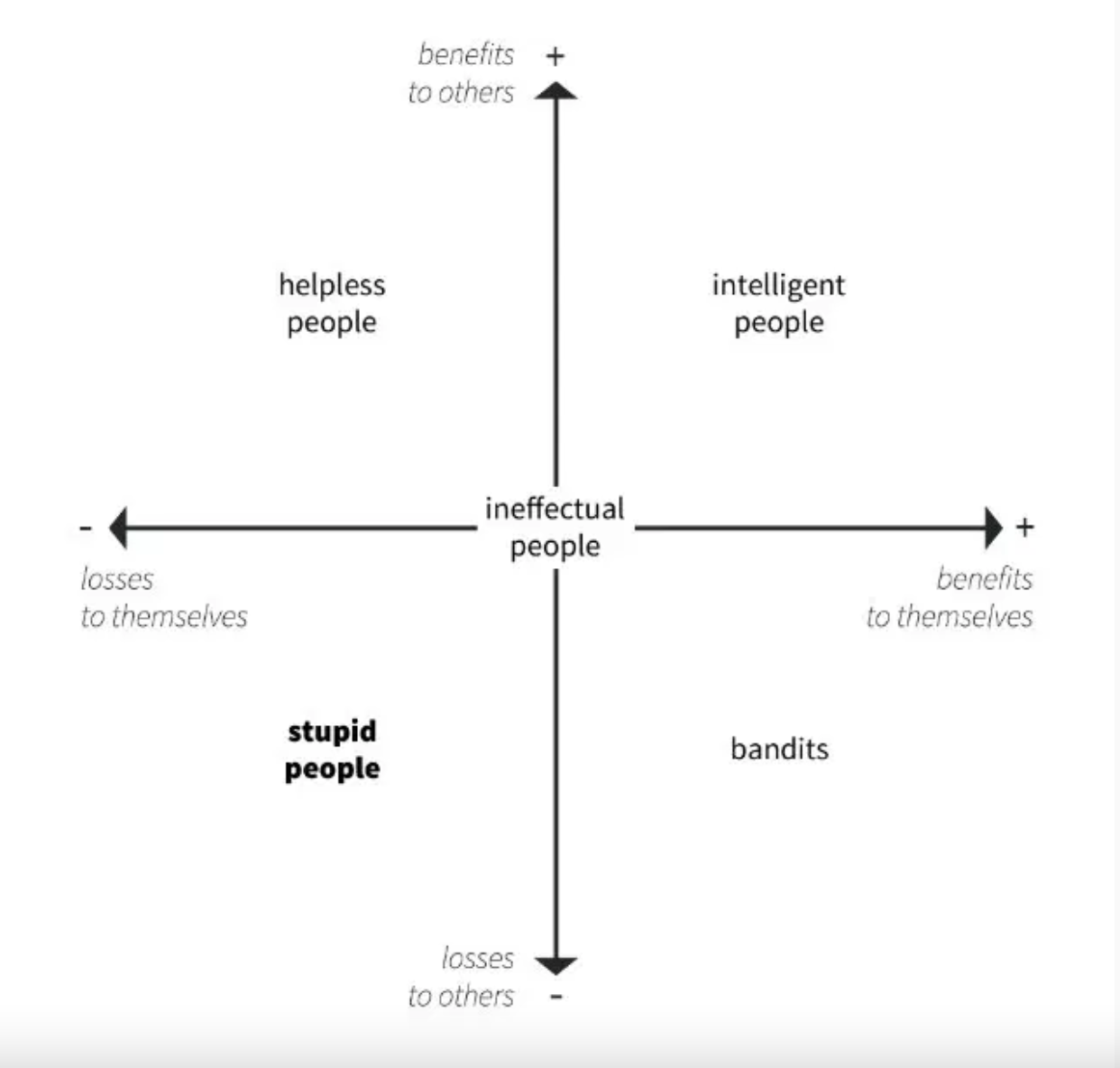
Stupidity, graphed. Photo by Vincedevries on Wikimedia, licensed under CC-BY-SA 4.0
The non-stupid are a flawed and inconsistent bunch. Sometimes we act intelligently, sometimes we are selfish bandits, sometimes we act helplessly and are taken advantage of by others, and sometimes we’re a bit of both. The stupid, in comparison, are paragons of consistency, acting at all times with unyielding idiocy.
However, consistent stupidity is the only consistent thing about the stupid. This is what makes stupid people so dangerous. Cipolla explains:
Essentially stupid people are dangerous and damaging because reasonable people find it difficult to imagine and understand unreasonable behavior. An intelligent person may understand the logic of a bandit. The bandit’s actions follow a pattern of rationality: nasty rationality, if you like, but still rationality. The bandit wants a plus on his account. Since he is not intelligent enough to devise ways of obtaining the plus as well as providing you with a plus, he will produce his plus by causing a minus to appear on your account. All this is bad, but it is rational and if you are rational you can predict it. You can foresee a bandit’s actions, his nasty maneuvres and ugly aspirations and often can build up your defenses.
With a stupid person all this is absolutely impossible as explained by the Third Basic Law. A stupid creature will harass you for no reason, for no advantage, without any plan or scheme and at the most improbable times and places. You have no rational way of telling if and when and how and why the stupid creature attacks. When confronted with a stupid individual you are completely at his mercy.
All of which leads us to:
Law 4: Non-stupid people always underestimate the damaging power of stupid individuals. In particular non-stupid people constantly forget that at all times and places and under any circumstances to deal and/or associate with stupid people always turns out to be a costly mistake.
We underestimate the stupid, and we do so at our own peril. This brings us to the fifth and final law:
Law 5: A stupid person is the most dangerous type of person.
And its corollary:
A stupid person is more dangerous than a bandit.
We can do nothing about the stupid. The difference between societies that collapse under the weight of their stupid citizens and those who transcend them are the makeup of the non-stupid. Those progressing in spite of their stupid possess a high proportion of people acting intelligently, those who counterbalance the stupid’s losses by bringing about gains for themselves and their fellows.
Declining societies have the same percentage of stupid people as successful ones. But they also have high percentages of helpless people and, Cipolla writes, “an alarming proliferation of the bandits with overtones of stupidity.”
“Such change in the composition of the non-stupid population inevitably strengthens the destructive power of the [stupid] fraction and makes decline a certainty,” Cipolla concludes. “And the country goes to Hell.”
Corinne Purtill writes about culture, behavioral science, and management. Based at various times in Washington, D.C., Phnom Penh, New York, and London, she has written about everything from terrorism to the search for the Loch Ness Monster. She has a BA in English from Stanford University and reports now from southern California.
Warning April 4th 2021
The following article should be read with caution. The key and most worrying phrase, apart from all the sophistry, is this following part of the writer’ conclusion : We are organisms, not computers. Get over it. Let’s get on with the business of trying to understand ourselves, but without being encumbered by unnecessary intellectual baggage. The IP metaphor has had a half-century run, producing few, if any, insights along the way. The time has come to hit the DELETE key.
IP , for those who don’t know means information processor. Epstein is effectively and inidiously saying that we humans are incapable of storing information, sorting and retrieving information as the need arises. In short we are not equiped to think for ourselves. This begs the question how on earth humans created and developed computers in the first place.
All we need know is the rich powerful folk controlling their use, including the police, should be trusted to do our thinking for us – keeping us safe ( ly away from them). This includes accepting government’s ‘science’ based computer modelling telling us we must get used to the perpetual lockdowns to control the virus spread.
Whatever your brains tell you, you are not IP Equiped. He uses a young female student of his to make the point that we can’t even store the image of what a bank note looks like. His experiment assumes we are all the same.
Well few of us study bank notes but we certainly process the image and scan for errors. As for not being able to draw from memory, I counter Epstein’s nonsensical and patronising garbage Steven Wiltshire with a post following on from Epstein. Epstein talks about us being ourselves, while inferring we are equally limited , and there is a little undercurrent about spirituality presumably to appease and please Muslims.
This is the WOKE cancel culture and people like Epstein need tenure, Woke sits uncomfotarbly between the Islamic rigid pattern and the LGBTQI box algorithim – an interesting challenge for the old set theory that I used to teach along with binary numbers.
I played classical guitar for years but due to over 13 years of serious police harrassment, I haven’t practiced for years. Just now I tested my self, disovering that I can still play complex music simply by thinking of what I want to play.
It is one thing to say that the brain is so complex we can’t really understand how it works. It is quite another thing to say we cannot store or process information. It raises questions of timing and motive as psychology and psychiatry dictates conditions and medication according to the DSM ( Diagnosis, Statistics & Medication ) in a world of flourishing mental illness. Robert Cook

For me, without a musical education and understanding of theory, I would never have been able to play or write anything. She could play anything she heard. When I wrote the melody to our songs, she just put in the chords by ear.
Just because we don’t understand the brain doesn’t men it is not a computer. To say that it is an organism is to state the obvious, but doesn’t mean it has no IP potential. It thrives on exercise and decays early if misfed or otherwise put at risk. Epstein’s article should be read with caution and attention to motive. Robert Cook
The Empty Brain
Your brain does not process information, retrieve knowledge, or store memories. In short: Your brain is not a computer. Posted April 4th 2021
- Robert Epstein
 What’s in a brain? Photo by Unsplash
What’s in a brain? Photo by Unsplash
No matter how hard they try, brain scientists and cognitive psychologists will never find a copy of Beethoven’s 5th Symphony in the brain – or copies of words, pictures, grammatical rules or any other kinds of environmental stimuli. The human brain isn’t really empty, of course. But it does not contain most of the things people think it does – not even simple things such as ‘memories’.
Our shoddy thinking about the brain has deep historical roots, but the invention of computers in the 1940s got us especially confused. For more than half a century now, psychologists, linguists, neuroscientists and other experts on human behaviour have been asserting that the human brain works like a computer.
To see how vacuous this idea is, consider the brains of babies. Thanks to evolution, human neonates, like the newborns of all other mammalian species, enter the world prepared to interact with it effectively. A baby’s vision is blurry, but it pays special attention to faces, and is quickly able to identify its mother’s. It prefers the sound of voices to non-speech sounds, and can distinguish one basic speech sound from another. We are, without doubt, built to make social connections.
A healthy newborn is also equipped with more than a dozen reflexes – ready-made reactions to certain stimuli that are important for its survival. It turns its head in the direction of something that brushes its cheek and then sucks whatever enters its mouth. It holds its breath when submerged in water. It grasps things placed in its hands so strongly it can nearly support its own weight. Perhaps most important, newborns come equipped with powerful learning mechanisms that allow them to change rapidly so they can interact increasingly effectively with their world, even if that world is unlike the one their distant ancestors faced.
Senses, reflexes and learning mechanisms – this is what we start with, and it is quite a lot, when you think about it. If we lacked any of these capabilities at birth, we would probably have trouble surviving.
But here is what we are not born with: information, data, rules, software, knowledge, lexicons, representations, algorithms, programs, models, memories, images, processors, subroutines, encoders, decoders, symbols, or buffers – design elements that allow digital computers to behave somewhat intelligently. Not only are we not born with such things, we also don’t develop them – ever.
We don’t store words or the rules that tell us how to manipulate them. We don’t create representations of visual stimuli, store them in a short-term memory buffer, and then transfer the representation into a long-term memory device. We don’t retrieve information or images or words from memory registers. Computers do all of these things, but organisms do not.
Computers, quite literally, process information – numbers, letters, words, formulas, images. The information first has to be encoded into a format computers can use, which means patterns of ones and zeroes (‘bits’) organised into small chunks (‘bytes’). On my computer, each byte contains 8 bits, and a certain pattern of those bits stands for the letter d, another for the letter o, and another for the letter g. Side by side, those three bytes form the word dog. One single image – say, the photograph of my cat Henry on my desktop – is represented by a very specific pattern of a million of these bytes (‘one megabyte’), surrounded by some special characters that tell the computer to expect an image, not a word.
Computers, quite literally, move these patterns from place to place in different physical storage areas etched into electronic components. Sometimes they also copy the patterns, and sometimes they transform them in various ways – say, when we are correcting errors in a manuscript or when we are touching up a photograph. The rules computers follow for moving, copying and operating on these arrays of data are also stored inside the computer. Together, a set of rules is called a ‘program’ or an ‘algorithm’. A group of algorithms that work together to help us do something (like buy stocks or find a date online) is called an ‘application’ – what most people now call an ‘app’.
Forgive me for this introduction to computing, but I need to be clear: computers really do operate on symbolic representations of the world. They really store and retrieve. They really process. They really have physical memories. They really are guided in everything they do, without exception, by algorithms.
Humans, on the other hand, do not – never did, never will. Given this reality, why do so many scientists talk about our mental life as if we were computers?
In his book In Our Own Image (2015), the artificial intelligence expert George Zarkadakis describes six different metaphors people have employed over the past 2,000 years to try to explain human intelligence.
In the earliest one, eventually preserved in the Bible, humans were formed from clay or dirt, which an intelligent god then infused with its spirit. That spirit ‘explained’ our intelligence – grammatically, at least.
The invention of hydraulic engineering in the 3rd century BCE led to the popularity of a hydraulic model of human intelligence, the idea that the flow of different fluids in the body – the ‘humours’ – accounted for both our physical and mental functioning. The hydraulic metaphor persisted for more than 1,600 years, handicapping medical practice all the while.
By the 1500s, automata powered by springs and gears had been devised, eventually inspiring leading thinkers such as René Descartes to assert that humans are complex machines. In the 1600s, the British philosopher Thomas Hobbes suggested that thinking arose from small mechanical motions in the brain. By the 1700s, discoveries about electricity and chemistry led to new theories of human intelligence – again, largely metaphorical in nature. In the mid-1800s, inspired by recent advances in communications, the German physicist Hermann von Helmholtz compared the brain to a telegraph.
Each metaphor reflected the most advanced thinking of the era that spawned it. Predictably, just a few years after the dawn of computer technology in the 1940s, the brain was said to operate like a computer, with the role of physical hardware played by the brain itself and our thoughts serving as software. The landmark event that launched what is now broadly called ‘cognitive science’ was the publication of Language and Communication (1951) by the psychologist George Miller. Miller proposed that the mental world could be studied rigorously using concepts from information theory, computation and linguistics.
This kind of thinking was taken to its ultimate expression in the short book The Computer and the Brain (1958), in which the mathematician John von Neumann stated flatly that the function of the human nervous system is ‘prima facie digital’. Although he acknowledged that little was actually known about the role the brain played in human reasoning and memory, he drew parallel after parallel between the components of the computing machines of the day and the components of the human brain.
Propelled by subsequent advances in both computer technology and brain research, an ambitious multidisciplinary effort to understand human intelligence gradually developed, firmly rooted in the idea that humans are, like computers, information processors. This effort now involves thousands of researchers, consumes billions of dollars in funding, and has generated a vast literature consisting of both technical and mainstream articles and books. Ray Kurzweil’s book How to Create a Mind: The Secret of Human Thought Revealed (2013), exemplifies this perspective, speculating about the ‘algorithms’ of the brain, how the brain ‘processes data’, and even how it superficially resembles integrated circuits in its structure.
The information processing (IP) metaphor of human intelligence now dominates human thinking, both on the street and in the sciences. There is virtually no form of discourse about intelligent human behaviour that proceeds without employing this metaphor, just as no form of discourse about intelligent human behaviour could proceed in certain eras and cultures without reference to a spirit or deity. The validity of the IP metaphor in today’s world is generally assumed without question.
But the IP metaphor is, after all, just another metaphor – a story we tell to make sense of something we don’t actually understand. And like all the metaphors that preceded it, it will certainly be cast aside at some point – either replaced by another metaphor or, in the end, replaced by actual knowledge.
Just over a year ago, on a visit to one of the world’s most prestigious research institutes, I challenged researchers there to account for intelligent human behaviour without reference to any aspect of the IP metaphor. They couldn’t do it, and when I politely raised the issue in subsequent email communications, they still had nothing to offer months later. They saw the problem. They didn’t dismiss the challenge as trivial. But they couldn’t offer an alternative. In other words, the IP metaphor is ‘sticky’. It encumbers our thinking with language and ideas that are so powerful we have trouble thinking around them.
The faulty logic of the IP metaphor is easy enough to state. It is based on a faulty syllogism – one with two reasonable premises and a faulty conclusion. Reasonable premise #1: all computers are capable of behaving intelligently. Reasonable premise #2: all computers are information processors. Faulty conclusion: all entities that are capable of behaving intelligently are information processors.
Setting aside the formal language, the idea that humans must be information processors just because computers are information processors is just plain silly, and when, some day, the IP metaphor is finally abandoned, it will almost certainly be seen that way by historians, just as we now view the hydraulic and mechanical metaphors to be silly.
If the IP metaphor is so silly, why is it so sticky? What is stopping us from brushing it aside, just as we might brush aside a branch that was blocking our path? Is there a way to understand human intelligence without leaning on a flimsy intellectual crutch? And what price have we paid for leaning so heavily on this particular crutch for so long? The IP metaphor, after all, has been guiding the writing and thinking of a large number of researchers in multiple fields for decades. At what cost?
In a classroom exercise I have conducted many times over the years, I begin by recruiting a student to draw a detailed picture of a dollar bill – ‘as detailed as possible’, I say – on the blackboard in front of the room. When the student has finished, I cover the drawing with a sheet of paper, remove a dollar bill from my wallet, tape it to the board, and ask the student to repeat the task. When he or she is done, I remove the cover from the first drawing, and the class comments on the differences.
Because you might never have seen a demonstration like this, or because you might have trouble imagining the outcome, I have asked Jinny Hyun, one of the student interns at the institute where I conduct my research, to make the two drawings. Here is her drawing ‘from memory’ (notice the metaphor):

And here is the drawing she subsequently made with a dollar bill present:

Jinny was as surprised by the outcome as you probably are, but it is typical. As you can see, the drawing made in the absence of the dollar bill is horrible compared with the drawing made from an exemplar, even though Jinny has seen a dollar bill thousands of times.
What is the problem? Don’t we have a ‘representation’ of the dollar bill ‘stored’ in a ‘memory register’ in our brains? Can’t we just ‘retrieve’ it and use it to make our drawing?
Obviously not, and a thousand years of neuroscience will never locate a representation of a dollar bill stored inside the human brain for the simple reason that it is not there to be found.
A wealth of brain studies tells us, in fact, that multiple and sometimes large areas of the brain are often involved in even the most mundane memory tasks. When strong emotions are involved, millions of neurons can become more active. In a 2016 study of survivors of a plane crash by the University of Toronto neuropsychologist Brian Levine and others, recalling the crash increased neural activity in ‘the amygdala, medial temporal lobe, anterior and posterior midline, and visual cortex’ of the passengers.
The idea, advanced by several scientists, that specific memories are somehow stored in individual neurons is preposterous; if anything, that assertion just pushes the problem of memory to an even more challenging level: how and where, after all, is the memory stored in the cell?
So what is occurring when Jinny draws the dollar bill in its absence? If Jinny had never seen a dollar bill before, her first drawing would probably have not resembled the second drawing at all. Having seen dollar bills before, she was changed in some way. Specifically, her brain was changed in a way that allowed her to visualise a dollar bill – that is, to re-experience seeing a dollar bill, at least to some extent.
The difference between the two diagrams reminds us that visualising something (that is, seeing something in its absence) is far less accurate than seeing something in its presence. This is why we’re much better at recognising than recalling. When we re-member something (from the Latin re, ‘again’, and memorari, ‘be mindful of’), we have to try to relive an experience; but when we recognise something, we must merely be conscious of the fact that we have had this perceptual experience before.
Perhaps you will object to this demonstration. Jinny had seen dollar bills before, but she hadn’t made a deliberate effort to ‘memorise’ the details. Had she done so, you might argue, she could presumably have drawn the second image without the bill being present. Even in this case, though, no image of the dollar bill has in any sense been ‘stored’ in Jinny’s brain. She has simply become better prepared to draw it accurately, just as, through practice, a pianist becomes more skilled in playing a concerto without somehow inhaling a copy of the sheet music.
From this simple exercise, we can begin to build the framework of a metaphor-free theory of intelligent human behaviour – one in which the brain isn’t completely empty, but is at least empty of the baggage of the IP metaphor.
As we navigate through the world, we are changed by a variety of experiences. Of special note are experiences of three types: (1) we observe what is happening around us (other people behaving, sounds of music, instructions directed at us, words on pages, images on screens); (2) we are exposed to the pairing of unimportant stimuli (such as sirens) with important stimuli (such as the appearance of police cars); (3) we are punished or rewarded for behaving in certain ways.
We become more effective in our lives if we change in ways that are consistent with these experiences – if we can now recite a poem or sing a song, if we are able to follow the instructions we are given, if we respond to the unimportant stimuli more like we do to the important stimuli, if we refrain from behaving in ways that were punished, if we behave more frequently in ways that were rewarded.
Misleading headlines notwithstanding, no one really has the slightest idea how the brain changes after we have learned to sing a song or recite a poem. But neither the song nor the poem has been ‘stored’ in it. The brain has simply changed in an orderly way that now allows us to sing the song or recite the poem under certain conditions. When called on to perform, neither the song nor the poem is in any sense ‘retrieved’ from anywhere in the brain, any more than my finger movements are ‘retrieved’ when I tap my finger on my desk. We simply sing or recite – no retrieval necessary.
A few years ago, I asked the neuroscientist Eric Kandel of Columbia University – winner of a Nobel Prize for identifying some of the chemical changes that take place in the neuronal synapses of the Aplysia (a marine snail) after it learns something – how long he thought it would take us to understand how human memory works. He quickly replied: ‘A hundred years.’ I didn’t think to ask him whether he thought the IP metaphor was slowing down neuroscience, but some neuroscientists are indeed beginning to think the unthinkable – that the metaphor is not indispensable.
A few cognitive scientists – notably Anthony Chemero of the University of Cincinnati, the author of Radical Embodied Cognitive Science (2009) – now completely reject the view that the human brain works like a computer. The mainstream view is that we, like computers, make sense of the world by performing computations on mental representations of it, but Chemero and others describe another way of understanding intelligent behaviour – as a direct interaction between organisms and their world.
My favourite example of the dramatic difference between the IP perspective and what some now call the ‘anti-representational’ view of human functioning involves two different ways of explaining how a baseball player manages to catch a fly ball – beautifully explicated by Michael McBeath, now at Arizona State University, and his colleagues in a 1995 paper in Science. The IP perspective requires the player to formulate an estimate of various initial conditions of the ball’s flight – the force of the impact, the angle of the trajectory, that kind of thing – then to create and analyse an internal model of the path along which the ball will likely move, then to use that model to guide and adjust motor movements continuously in time in order to intercept the ball.
That is all well and good if we functioned as computers do, but McBeath and his colleagues gave a simpler account: to catch the ball, the player simply needs to keep moving in a way that keeps the ball in a constant visual relationship with respect to home plate and the surrounding scenery (technically, in a ‘linear optical trajectory’). This might sound complicated, but it is actually incredibly simple, and completely free of computations, representations and algorithms.
Two determined psychology professors at Leeds Beckett University in the UK – Andrew Wilson and Sabrina Golonka – include the baseball example among many others that can be looked at simply and sensibly outside the IP framework. They have been blogging for years about what they call a ‘more coherent, naturalised approach to the scientific study of human behaviour… at odds with the dominant cognitive neuroscience approach’. This is far from a movement, however; the mainstream cognitive sciences continue to wallow uncritically in the IP metaphor, and some of the world’s most influential thinkers have made grand predictions about humanity’s future that depend on the validity of the metaphor.
One prediction – made by the futurist Kurzweil, the physicist Stephen Hawking and the neuroscientist Randal Koene, among others – is that, because human consciousness is supposedly like computer software, it will soon be possible to download human minds to a computer, in the circuits of which we will become immensely powerful intellectually and, quite possibly, immortal. This concept drove the plot of the dystopian movie Transcendence (2014) starring Johnny Depp as the Kurzweil-like scientist whose mind was downloaded to the internet – with disastrous results for humanity.
Fortunately, because the IP metaphor is not even slightly valid, we will never have to worry about a human mind going amok in cyberspace; alas, we will also never achieve immortality through downloading. This is not only because of the absence of consciousness software in the brain; there is a deeper problem here – let’s call it the uniqueness problem – which is both inspirational and depressing.
Because neither ‘memory banks’ nor ‘representations’ of stimuli exist in the brain, and because all that is required for us to function in the world is for the brain to change in an orderly way as a result of our experiences, there is no reason to believe that any two of us are changed the same way by the same experience. If you and I attend the same concert, the changes that occur in my brain when I listen to Beethoven’s 5th will almost certainly be completely different from the changes that occur in your brain. Those changes, whatever they are, are built on the unique neural structure that already exists, each structure having developed over a lifetime of unique experiences.
This is why, as Sir Frederic Bartlett demonstrated in his book Remembering (1932), no two people will repeat a story they have heard the same way and why, over time, their recitations of the story will diverge more and more. No ‘copy’ of the story is ever made; rather, each individual, upon hearing the story, changes to some extent – enough so that when asked about the story later (in some cases, days, months or even years after Bartlett first read them the story) – they can re-experience hearing the story to some extent, although not very well (see the first drawing of the dollar bill, above).
This is inspirational, I suppose, because it means that each of us is truly unique, not just in our genetic makeup, but even in the way our brains change over time. It is also depressing, because it makes the task of the neuroscientist daunting almost beyond imagination. For any given experience, orderly change could involve a thousand neurons, a million neurons or even the entire brain, with the pattern of change different in every brain.
Worse still, even if we had the ability to take a snapshot of all of the brain’s 86 billion neurons and then to simulate the state of those neurons in a computer, that vast pattern would mean nothing outside the body of the brain that produced it. This is perhaps the most egregious way in which the IP metaphor has distorted our thinking about human functioning. Whereas computers do store exact copies of data – copies that can persist unchanged for long periods of time, even if the power has been turned off – the brain maintains our intellect only as long as it remains alive. There is no on-off switch. Either the brain keeps functioning, or we disappear. What’s more, as the neurobiologist Steven Rose pointed out in The Future of the Brain (2005), a snapshot of the brain’s current state might also be meaningless unless we knew the entire life history of that brain’s owner – perhaps even about the social context in which he or she was raised.
Think how difficult this problem is. To understand even the basics of how the brain maintains the human intellect, we might need to know not just the current state of all 86 billion neurons and their 100 trillion interconnections, not just the varying strengths with which they are connected, and not just the states of more than 1,000 proteins that exist at each connection point, but how the moment-to-moment activity of the brain contributes to the integrity of the system. Add to this the uniqueness of each brain, brought about in part because of the uniqueness of each person’s life history, and Kandel’s prediction starts to sound overly optimistic. (In a recent op-ed in The New York Times, the neuroscientist Kenneth Miller suggested it will take ‘centuries’ just to figure out basic neuronal connectivity.)
Meanwhile, vast sums of money are being raised for brain research, based in some cases on faulty ideas and promises that cannot be kept. The most blatant instance of neuroscience gone awry, documented recently in a report in Scientific American, concerns the $1.3 billion Human Brain Project launched by the European Union in 2013. Convinced by the charismatic Henry Markram that he could create a simulation of the entire human brain on a supercomputer by the year 2023, and that such a model would revolutionise the treatment of Alzheimer’s disease and other disorders, EU officials funded his project with virtually no restrictions. Less than two years into it, the project turned into a ‘brain wreck’, and Markram was asked to step down.
We are organisms, not computers. Get over it. Let’s get on with the business of trying to understand ourselves, but without being encumbered by unnecessary intellectual baggage. The IP metaphor has had a half-century run, producing few, if any, insights along the way. The time has come to hit the DELETE key.
Robert Epstein is a senior research psychologist at the American Institute for Behavioral Research and Technology in California. He is the author of 15 books, and the former editor-in-chief of Psychology Today.

- Genius
See This Incredible Artist Draw a Whole City From Memory Posted April 4th 2021
Diagnosed with autism at age three, Stephen Wiltshire is now famous for producing highly detailed scenes after just a brief glance.ByNina StrochlicPublished April 18, 2018• 5 min read
Today, Stephen Wiltshire is one of Britain’s best-known artists. His commissions have a four- to eight-month waiting list, and videos of him sketching panoramic cityscapes in perfect scale have a tendency to go viral.
But when Stephen was in school, his teachers didn’t know what to do with him. Diagnosed with autism at age three, he didn’t say his first word (“paper”) until age five. Still, as a child, Stephen could sketch stunningly accurate images of wildlife and caricatures of his teachers.
Later he began drawing the buildings he was seeing around London with impressive detail. His older sister Annette would take him to the home of a school friend who lived on the 14th floor of an apartment building, so he could see a sprawling view of the city. He marveled at its layout and landmarks. From that point on, she says, “his passion became obsessive.”
At age eight, he got his first commission—from the British prime minister. Language didn’t come easily until the next year, but by age 13, he had published his first book of drawings. The public and the media became fascinated by the young teen’s incredible memory. Stephen was featured on television shows and in documentaries about so-called savants.


Drawing a CrowdWiltshire completed his sketch of Mexico City in front of onlookers inside the city’s Bancomer bank.Photograph by Paolo Woods, National Geographic
On a trip to New York for an interview, he met Oliver Sacks and drew a perfect replica of the neurologist’s house after taking a quick glance at it. “The combination of great abilities with great disabilities presents an extraordinary paradox: how can such opposites live side by side?” Sacks later wrote in the foreword to Wiltshire’s second book.
Two years later, in 1989, he visited Venice and drew his first panorama. From then on, Stephen became known for his incredibly detailed cityscapes, each done from memory with hundreds of streets, landmarks, and other minutia in perfect scale. He drew cities around the world, from Jerusalem to Sydney. His latest project brought Mexico City to life on a 13-foot canvas.

In New York, he took a 20-minute helicopter ride and then sketched everything he saw onto a 19-foot-long piece of paper as viewers watched live via webcam.
“Despite Stephen’s astounding memory, whilst in Manhattan he still managed to get lost and walk 45 minutes in the wrong direction before finding Cheyenne’s Diner,” says a playful anecdote on his official website.
In 2006, Prince Charles presented Stephen as a Member of the Order of the British Empire for his contributions to the art world. That year, he opened his own gallery in central London. Today, his photograph welcomes visitors to London’s Heathrow airport.





1 / 5Wiltshire drew this picture of the Manhatten skyline after taking a 20-minute helicopter ride.
New York, New YorkWiltshire drew this picture of the Manhatten skyline after taking a 20-minute helicopter ride.Illustration by Stephen Wiltshire
“Stephen is extremely humble and not fazed at all,” says Annette, who manages the gallery.
Fame “hasn’t altered his concentration or even made him nervous … I think it pushes his abilities even further.”
And thanks to his prolific and celebrated career, the once-silent artist now communicates easily with millions of people. “Stephen’s art speaks a language that we can all understand,” she says.
Someone I Would Like To Kill by Robert Cook April 2nd 2021
Television was a magic box to me in the 1950s. The first ones were large pieces of furniture with large polished wood cabinets and flickering blackish and whitish images on tiny screens. To have an H Shaped aerial attached to your chimney was a status symbol like owning a car. We never had a car. Dad rode a bike 10 miles to his long day’s work as a lorry driver. Just before his accident, he stepped up in the world purchasing an NSU moped called a ‘Quickly.’ He was fluent in German and had fought the Germans during the war , but we had German relatives and he admired their engineering.
The war had a big impact on my parents. They were both Londoners where the blitz cooked and killed people. Mother lost a brother and boyfriend. Our television arrived in 1957 and I was allowed to watch it without censorship until 9 p.m. War films , where death was always heroic, interested me, but it was not until 1962 when my father ended up on a terminal ward in Aylesbury that I heard the sound of death while we visited on a regular basis. The sound of the death rattle was horrible. Eventually it was my father’s turn. He was 41. Brought up as an agnostic, I had no doubt he had gone for good. Very poor already, due to his long illness, our situation got worse. Life seemed horrible, so I wanted to go too.
It was my role to look after my mother, doing jobs before and after school , including long hours on the farm where life and death of animals was quite normal.
My first memory of desperately wanting to die comes from just before I went up to university. I had become very anxious that something might happen to my mother and the lonely prospect of being in a world without her.
The difficulty with the suicidal impulse is that , in my experience, it is like one of those old wartime blackout curtains that we still had on our front windows in 1960. It closes out all light and therefore any sense of hope.
So while working for the Inland Revenue in Havant, near my beloved Portsmouth, I got lodgings with wonderful Bill and Jean Neal in Lymbourne Road. I had recently been dumped by my girlfriend because she found me too depressing. I was writing a lot of poetry , including lines about this person that I wanted to kill.
The person was , of course, myself. The blackout curtain came down so I saw nothing else. I went to my doctor and he prescribed amitrytyline, better known as tryptizol. It would take a lot of explanation as to how I reached this stage, but my ex girlfriend observed when we met in Norwich that, in her words ‘You are very insecure.’ She did her best to help me but psychology is a blunt instrument where a scalpel is required. No such tool exists in that field of medicine, beyond lobotomy.
The year was 1975. Back in 1974, the English folk singer Nick Drake had died from an overdose of tryptizol. As an aspiring folk singer myself, I knew that. The drug is a tricyclic antidepressant with sedative properties. The maximum effective dose is 150 mg per day. It was a Friday. I collected my prescription from Boots in West Street , on my way home from the tax office just around the corner. The tiny pills were crammed into a little brown glass bottle.
My lodgings were a short walk away. I was home in time for dinner with Bill and Jean. They always went to the British Legion Club in South Street. I went up to my little back bedroom and swallowed all the pills. In my hazy half sleep, I heard them come home that night, then nothing until Monday morning.
Unhappy to have woken up, I rang in sick and took time to recover. A few weeks later, I returned to my doctor asking for extra pills because I was going away on holiday. Something people miss about those of us who become suicidal is that once we have decided what we are going to do, we put on an image. So I got the pills and drove home up country to the house I then owned in Winslow, where I took lots of the pills, spending another two days in a coma.

Coming out of it was like swimming up from the depths. I persuaded myself that I was going to become more than a tax man. I was going to be a great writer and folk singer. Over the years , all that hope was gradually taken from me. I went on to attempt suicide by hanging in March 2007 and another overdose in 2016 , following 7 traumatic court hearings before my hollow Crown Court victory.
Still I was unable to get at the truth, which I cannot talk about now for legal reasons. So I took an overdose of tamazapam whilst on leave from work in December 2016. There were efforts to persuade me that I am transgendered stemming from me having a book published on the subject. The final report on the matter noted that I have a ‘strong female identity.’
This led to a psychiatrist following up with the deluded paranoid diagnosis and prescription for anti psychotic drugs. I came to the conclusion that these people cannot be trusted and that the only identity I have is the one the police gave me on October 9th 2008 when they created intriguing and life destroying records and a PNC Criminal Marker, meant to be secret, that I was a violent stalker. One cannot get much more hopeless than carrying an identity like that one. It is near impossible to earn a living that way and was expanded to incriminate my eldest son.
Life without hope is a terrible experience. If it had not been for the support of my eldest son who also depends on me for reasons I am also not allowed to mention, I would be dead. When the blackout curtain is drawn, one sees nothing but darkness, which is why I nearly succeeded in strangling myself with my tee shirt whilst in police custody back last August 25th. Death, where is thy sting ? I would do it again. I am not allowed to say why, and no one believes me anyway, which is why I have been labelled a paranoid personality, schizophrenic and deluded. Who am I to argue ? It would be kind of them to give me euthanasia instead of leaving me plotting to kill that someone who is me. R.J Cook


Why are suicides so high amongst men? Posted March 16th 2021
77% of suicides are by men. Are the myths around depression responsible for their deaths?
Each year across the UK, approximately 6,000 people take their own lives. Around 90% of suicide victims suffer from a mental health condition and those at the highest risk include middle aged men living with depression. Some of these men might end up becoming dependent on alcohol, which possibly starts as a coping strategy but eventually ends up worsening their mood and leading to other problems affecting their health, employment and relationships. Despite the overall number of suicides falling in 2012, the total number for men increased. Figures from the Office for National Statistics show that highest number of suicides was recorded among men aged 40 to 44. For this age group, men were more than four times as likely as women to commit suicide. In total, men make up 77% of all suicides in the UK.
Why more men than women?
There are many possible reasons why middle aged men are more at risk of depressive disorder than other groups in the population, and also why they might be less likely to seek help even after they become depressed. These include the changing role of women in our society who have become less dependent on their male partners, the decline of traditional male dominated jobs leading to a loss of identity as well as income, and relationship breakdown which can be more devastating for men than women. Women generally tend to be more ’emotionally literate’ and are able to discuss their feelings with others rather than resorting to internalising their emotions or using alcohol or recreational substances as ways of coping with distress. This latter attribute, together with the fear and stigma of revealing low mood might further hinder the readiness of men to seek help for their symptoms.
A Mad World
Posted March 3rd 2021
A diagnosis of mental illness is more common than ever – did psychiatrists create the problem, or just recognise it?
- Joseph Pierre
Read when you’ve got time to spare.
Photo from Chinnapong / Getty Images.
When a psychiatrist meets people at a party and reveals what he or she does for a living, two responses are typical. People either say, ‘I’d better be careful what I say around you,’ and then clam up, or they say, ‘I could talk to you for hours,’ and then launch into a litany of complaints and diagnostic questions, usually about one or another family member, in-law, co-worker, or other acquaintance. It seems that people are quick to acknowledge the ubiquity of those who might benefit from a psychiatrist’s attention, while expressing a deep reluctance ever to seek it out themselves.
That reluctance is understandable. Although most of us crave support, understanding, and human connection, we also worry that if we reveal our true selves, we’ll be judged, criticised, or rejected in some way. And even worse – perhaps calling upon antiquated myths – some worry that, if we were to reveal our inner selves to a psychiatrist, we might be labelled crazy, locked up in an asylum, medicated into oblivion, or put into a straitjacket. Of course, such fears are the accompaniment of the very idiosyncrasies, foibles, and life struggles that keep us from unattainably perfect mental health.
As a psychiatrist, I see this as the biggest challenge facing psychiatry today. A large part of the population – perhaps even the majority – might benefit from some form of mental health care, but too many fear that modern psychiatry is on a mission to pathologise normal individuals with some dystopian plan fuelled by the greed of the pharmaceutical industry, all in order to put the populace on mind-numbing medications. Debates about psychiatric overdiagnosis have amplified in the wake of the 2013 release of the newest edition of the Diagnostic and Statistical Manual of Mental Disorders (DSM-5), the so-called ‘bible of psychiatry’, with some particularly vocal critics coming from within the profession.
It’s true that the scope of psychiatry has greatly expanded over the past century. A hundred years ago, the profession had a near-exclusive focus on the custodial care of severely ill asylum patients. Now, psychiatric practice includes the office-based management of the ‘worried well’. The advent of psychotherapy, starting with the arrival of Sigmund Freud’s psychoanalysis at the turn of the 20th century, drove the shift. The ability to treat less severe forms of psychopathology – such as anxiety and so-called adjustment disorders related to life stressors – with the talking cure has had profound effects on mental health care in the United States.
Early forms of psychotherapy paved the way for the Mental Hygiene Movement that lasted from about 1910 through the 1950s. This public health model rejected hard boundaries of mental illness in favour of a view that acknowledged the potential for some degree of mental disorder to exist in nearly everyone. Interventions were recommended not just within a psychiatrist’s office, but broadly within society at large; schools and other community settings were all involved in providing support and help.
A new abundance of ‘neurotic’ symptoms stemming from the trauma experienced by veterans of the First and Second World Wars reinforced a view that mental health and illness existed on a continuous spectrum. And by the time DSM was first published in 1952, psychiatrists were treating a much wider swath of the population than ever before. From the first DSM through to the 2013 revision, inclusiveness and clinical usefulness have been guiding principles, with the profession erring on the side of capturing all of the conditions that bring people to psychiatric care in order to facilitate evaluation and treatment.
In the modern era, psychotherapy has steered away from traditional psychoanalysis in favour of more practical, shorter-term therapies: for instance, psychodynamic therapy explores unconscious conflicts and underlying distress on a weekly basis for as little as a few months’ duration, and goal-directed cognitive therapy uses behavioural techniques to correct disruptive distortions in thinking. These streamlined psychotherapeutic techniques have widened the potential consumer base for psychiatric intervention; they have also expanded the range of clinicians who can perform therapy to include not only psychiatrists, but primary care doctors, psychologists, social workers, and marriage and family therapists.
In a similar fashion, newer medications with fewer side effects are more likely to be offered to people with less clear-cut psychiatric illnesses. Such medications can be prescribed by a family physician or, in some states, a psychologist or nurse practitioner.
Viewed through the lens of the DSM, it is easy to see how extending psychiatry’s helping hand deeper into the population is often interpreted as evidence that psychiatrists think more and more people are mentally ill. Epidemiological studies based upon DSM criteria have suggested that half or more of the US population will meet the threshold for mental disorder at some point in their lives. To many, the idea that it might be normal to have a mental illness sounds oxymoronic at best and conspiratorially threatening at worst. Yet the widening scope of psychiatry has been driven by a belief – on the parts of both mental health consumers and clinicians alike – that psychiatry can help with an increasingly large range of issues.
The diagnostic creep of psychiatry becomes more understandable by conceptualising mental illness, like most things in nature, on a continuum. Many forms of psychiatric disorder, such as schizophrenia or severe dementia, are so severe – that is to say, divergent from normality – that whether they represent illness is rarely debated. Other syndromes, such as generalised anxiety disorder, might more closely resemble what seems, to some, like normal worry. And patients might even complain of isolated symptoms such as insomnia or lack of energy that arise in the absence of any fully formed disorder. In this way, a continuous view of mental illness extends into areas that might actually be normal, but still detract from optimal, day-to-day function.
While a continuous view of mental illness probably reflects underlying reality, it inevitably results in grey areas where ‘caseness’ (whether someone does or does not have a mental disorder) must be decided based on judgment calls made by experienced clinicians. In psychiatry, those calls usually depend on whether a patient’s complaints are associated with significant distress or impaired functioning. Unlike medical disorders where morbidity is often determined by physical limitations or the threat of impending death, the distress and disruption of social functioning associated with mental illness can be fairly subjective. Even those on the softer, less severe end of the mental illness spectrum can experience considerable suffering and impairment. For example, someone with mild depression might not be on the verge of suicide, but could really be struggling with work due to anxiety and poor concentration. Many people might experience sub-clinical conditions that fall short of the threshold for a mental disorder, but still might benefit from intervention.
The truth is that while psychiatric diagnosis is helpful in understanding what ails a patient and formulating a treatment plan, psychiatrists don’t waste a lot of time fretting over whether a patient can be neatly categorised in DSM, or even whether or not that patient truly has a mental disorder at all. A patient comes in with a complaint of suffering, and the clinician tries to relieve that suffering independent of such exacting distinctions. If anything, such details become most important for insurance billing, where clinicians might err on the side of making a diagnosis to obtain reimbursement for a patient who might not otherwise be able to receive care.
***
Though many object to psychiatry’s perceived encroachment into normality, we rarely hear such complaints about the rest of medicine. Few lament that nearly all of us, at some point in our lives, seek care from a physician and take all manner of medications, most without need of a prescription, for one physical ailment or another. If we can accept that it is completely normal to be medically sick, not only with transient conditions such as coughs and colds, but also chronic disorders such as farsightedness, lower back pain, high blood pressure or diabetes, why can’t we accept that it might also be normal to be psychiatrically ill at various points in our lives?
The answer seems to be that psychiatric disorders carry a much greater degree of stigma compared with medical conditions. People worry that psychiatrists think everyone is crazy because they make the mistake of equating any form of psychiatric illness with being crazy. But that’s like equating a cough with tuberculosis or lung cancer. To be less stigmatising, psychiatry must support a continuous model of mental health instead of maintaining an exclusive focus on the mental disorders that make up the DSM. If general medicine can work within a continuous view of physical health and illness, there is no reason why psychiatry can’t as well.
Criticism of this view comes from concern over the type of intervention offered at the healthier end of the continuum. If the scope of psychiatry widens, will psychiatric medications be vastly overprescribed, as is already claimed with stimulants such as methylphenidate (Ritalin) for attention deficit hyperactivity disorder (ADHD)? This concern is well worth fretting over, given the uncertain effectiveness of medications for patients who don’t quite meet DSM criteria. For example, a 2008 study by the Harvard psychologist Irving Kirsch published in PLOS Medicine found that, for milder forms of depression, antidepressants are often no better than placebos. Likewise, research suggests that children at risk of developing psychosis – but not diagnosable just yet – might benefit more from fish oil or psychotherapy than antipsychotic drugs.
In the end, implementing pharmacotherapy for a given condition requires solid evidence from peer-reviewed research studies. Although by definition the benefit of medications decreases at the healthier end of a mental health continuum (if one isn’t as sick, the degree of improvement will be less), we need not reject all pharmacotherapy at the healthier end of the spectrum, provided medications are safe and effective. Of course, medications aren’t candy – most have a long list of potential side effects ranging from trivial to life-threatening. There’s a reason such medications require a prescription from a physician and why many psychiatrists are sceptical of proposals to grant prescribing privileges to health practitioners with far less medical training.
People worry that psychiatrists think everyone is crazy because they make the mistake of equating any form of psychiatric illness with being crazy. But that’s like equating a cough with tuberculosis or lung cancer
Pharmacotherapy for healthier individuals is likely to increase in the future as safer medications are developed, just as happened after selective serotonin re-uptake inhibitors (SSRIs) supplanted tricyclic antidepressants (TCAs) during the 1990s. In turn, the shift to medicating the healthier end of the continuum paves a path towards not only maximising wellness but enhancing normal functioning through ‘cosmetic’ intervention. Ultimately, availability of medications that enhance brain function or make us feel better than normal will be driven by consumer demand, not the Machiavellian plans of psychiatrists. The legal use of drugs to alter our moods is already nearly ubiquitous. We take Ritalin, modafinil (Provigil), or just our daily cup of caffeine to help us focus, stay awake, and make that deadline at work; then we reach for our diazepam (Valium), alcohol, or marijuana to unwind at the end of the day. If a kind of anabolic steroid for the brain were created, say a pill that could increase IQ by an average of 10 points with a minimum of side effects, is there any question that the public would clamour for it? Cosmetic psychiatry is a very real prospect for the future, with myriad moral and ethical implications involved.
In the final analysis, psychiatrists don’t think that everyone is crazy, nor are we necessarily guilty of pathologising normal existence and foisting medications upon the populace as pawns of the drug companies. Instead, we are just doing what we can to relieve the suffering of those coming for help, rather than turning those people away.
The good news for mental health consumers is that clinicians worth their mettle (and you might have to shop around to find one) don’t rely on the DSM as a bible in the way that many imagine, checking off symptoms like a computer might and trying to ‘shrink’ people into the confines of a diagnostic label. A good psychiatrist draws upon clinical experience to gain empathic understanding of each patient’s story, and then offers a tailored range of interventions to ease the suffering, whether it represents a disorder or is part of normal life.
Joseph Pierre is a professor of psychiatry at the University of California, Los Angeles and chief of the Hospital Psychiatry Division at the VA Greater Los Angeles Healthcare System. He writes the Psych Unseen blog for Psychology Today. 
More from Aeon
- Lifestyle changes, not a magic pill, can reverse Alzheimer’s1,351 saves
- Reasons not to scoff at ghosts, visions and near-death experiences769 saves
- Spiritual emergency776 saves
- Lifestyle changes, not a magic pill, can reverse Alzheimer’s1,351 saves
- Reasons not to scoff at ghosts, visions and near-death experiences769 saves
- Spiritual emergency
How to Think Like a Genius, According to Nobel Laureate Richard Feynman Posted February 28th 2021
You don’t have to understand quantum mechanics to use this advice to start solving your toughest problems.
By Jessica Stillman@EntryLevelRebel

IQ may be largely fixed, but that doesn’t mean intelligence is. While we’re stuck with a certain amount of intellectual horsepower, how you employ that talent makes a big difference. Learning different ways to approach problems and dodge cognitive pitfalls effectively makes you smarter. Even changing the time of day you tackle a problem can make you smarter.
So how do you set yourself up to maximize your intelligence? There are few better qualified to answer this question than a certified genius.
How to be a genius, according to a genius.
Physicist Richard Feynman received the Nobel Prize for his work unraveling one of the most mind-bending subjects known to humankind: quantum physics. He was also famous for his clear and engaging communication style. The man wasn’t just brilliant, he was also great at explaining the process he used to think brilliantly.
I’ve covered a few of these tips here before, but recently came across another great one on the blog Farnam Street. The post highlights a classic lecture by mathematician and MIT professor Gian-Carlo Rota on how to get students to pay attention in class.
Much of these ideas are useful to anyone trying to seize and hold attention, but one tip is useful for just about anyone who has ever faced a problem in their life (so all of us then). It comes from Feynman originally, according to Rota:
Richard Feynman was fond of giving the following advice on how to be a genius. You have to keep a dozen of your favorite problems constantly present in your mind, although by and large they will lay in a dormant state. Every time you hear or read a new trick or a new result, test it against each of your 12 problems to see whether it helps. Every once in a while there will be a hit, and people will say: “How did he do it? He must be a genius!”
The joy of this advice is that it is simple as it is powerful, and you don’t need a super brain to implement it. It’s all about your system, not your talent.
Rather than a sky-high IQ, Feynman’s approach requires the foresight to make a catalog of your most pressing problems. Add to that the attentiveness to watch out for new mental models, hacks, and relevant concepts (particularly from fields not usually thought of as relevant) and you have a simple recipe for a steady stream of fresh, useful ideas.
And finding ideas like that is what intelligence is in practice. Cracking brain teasers or spotting patterns on some abstract test might give you bragging rights (or a leg up in college admissions). But the ability to solve problems and improve the world is real-life genius. Follow Feynman’s simple framework and you’ll be well on your way to making more of such smart moves. Inc. helps entrepreneurs change the world. Get the advice you need to start, grow, and lead your business today. Subscribe here for unlimited access.Feb 18, 2021The opinions expressed here by Inc.com columnists are their own, not those of Inc.com.
Neuroscience Readies for a Showdown Over Consciousness Ideas
To make headway on the mystery of consciousness, some researchers are trying a rigorous new way to test competing theories. Posted February 8th 2021
- Philip Ball
Read when you’ve got time to spare.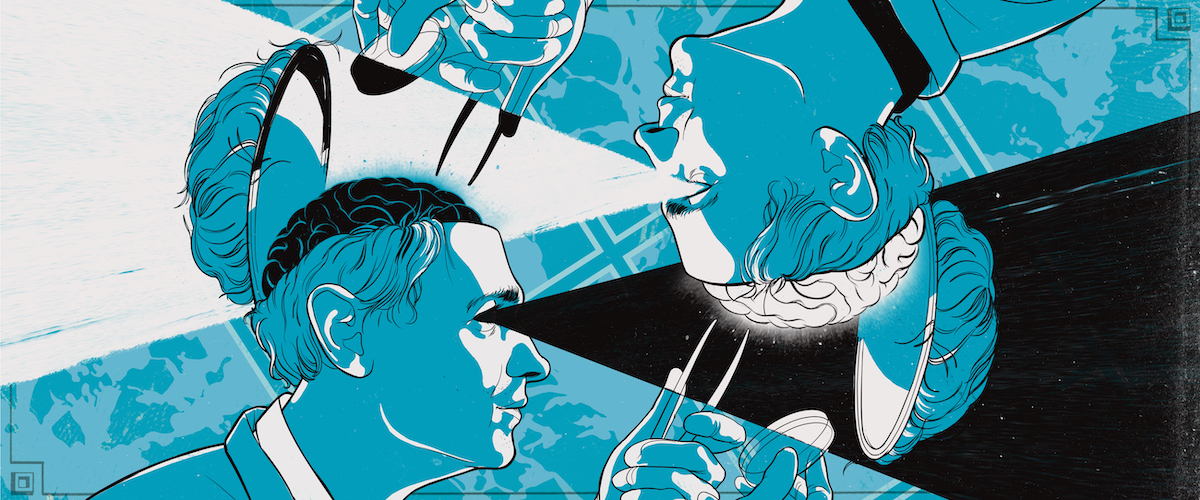
Neuroscientists are preparing to test their ideas about the origins of consciousness — the cognitive state of experiencing your own existence. Credit: Ryan Garcia for Quanta Magazine.
Some problems in science are so hard, we don’t really know what meaningful questions to ask about them — or whether they are even truly solvable by science. Consciousness is one of those: Some researchers think it is an illusion; others say it pervades everything. Some hope to see it reduced to the underlying biology of neurons firing; others say that it is an irreducibly holistic phenomenon.
The question of what kinds of physical systems are conscious “is one of the deepest, most fascinating problems in all of science,” wrote the computer scientist Scott Aaronson of the University of Texas at Austin. “I don’t know of any philosophical reason why [it] should be inherently unsolvable” — but “humans seem nowhere close to solving it.”
Now a new project currently under review hopes to close in on some answers. It proposes to draw up a suite of experiments that will expose theories of consciousness to a merciless spotlight, in the hope of ruling out at least some of them.
If all is approved and goes according to plan, the experiments could start this autumn. The initial aim is for the advocates of two leading theories to agree on a protocol that would put predictions of their ideas to the test. Similar scrutiny of other theories will then follow.
Whether or not this project, funded by the Templeton World Charity Foundation, narrows the options for how consciousness arises, it hopes to establish a new way to do science for difficult, contentious problems. Instead of each camp championing its own view and demolishing others, researchers will collaborate and agree to publish in advance how discriminating experiments might be conducted — and then respect the outcomes.
Dawid Potgieter, a senior program officer at the Templeton World Charity Foundation who is coordinating the endeavor, says that this is just the beginning of a sustained effort to winnow down theories of consciousness. He plans to set up several more of these “structured adversarial collaborations” over the next five years.
He is realistic about the prospects. “I don’t think we are going to come to a single theory that tells us everything about consciousness,” he said. “But if it were to take a hundred years to solve the mystery of consciousness, I hope we can cut it down to fifty.”
A Workspace for Awareness
Philosophers have debated the nature of consciousness and whether it can inhere in things other than humans for thousands of years, but in the modern era, pressing practical and moral implications make the need for answers more urgent. As artificial intelligence (AI) grows increasingly sophisticated, it might become impossible to tell whether one is dealing with a machine or a human merely by interacting with it — the classic Turing test. But would that mean AI deserves moral consideration?
Understanding consciousness also impinges on animal rights and welfare, and on a wide range of medical and legal questions about mental impairments. A group of more than 50 leading neuroscientists, psychologists, cognitive scientists and others recently called for greater recognition of the importance of research on this difficult subject. “Theories of consciousness need to be tested rigorously and revised repeatedly amid the long process of accumulation of empirical evidence,” the authors said, adding that “myths and speculative conjectures also need to be identified as such.”
You can hardly do experiments on consciousness without having first defined it. But that’s already difficult because we use the word in several ways. Humans are conscious beings, but we can lose consciousness, for example under anesthesia. We can say we are conscious of something — a strange noise coming out of our laptop, say. But in general, the quality of consciousness refers to a capacity to experience one’s existence rather than just recording it or responding to stimuli like an automaton. Philosophers of mind often refer to this as the principle that one can meaningfully speak about what it is to be “like” a conscious being — even if we can never actually have that experience beyond ourselves.
Plenty of cognition takes place outside the grasp of conscious awareness — in that sense, we respond to some cues and stimuli “unconsciously.” A distinguishing feature of our minds, however, is that we can hold on to a piece of information, an idea or an intention as a motivation for subsequent decisions and behaviors. If we’re hungry, we salivate as a reflex, but we might also choose to eat, go to the kitchen and get what we want from the cupboard.
Some researchers, such as the cognitive scientist Stanislas Dehaene of the Collège de France in Paris, suggest that this conscious behavior arises when we hold a piece of information in a “global workspace” within the brain, where it can be broadcast to brain modules associated with specific tasks. This workspace, he says, imposes a kind of information bottleneck: Only when the first conscious notion slips away can another take its place. According to Dehaene, brain-imaging studies suggest this “conscious bottleneck” is a distributed network of neurons in the brain’s prefrontal cortex.
This picture of consciousness is called global workspace theory (GWT). In this view, consciousness is created by the workspace itself — and so it should be a feature of any information-processing system capable of broadcasting information to other processing centers. It makes consciousness a kind of computation for motivating and guiding actions. “Once you have information and the information is made broadly available, in that act consciousness occurs,” said Christof Koch, chief scientist and president of the Allen Institute for Brain Science in Seattle. 
Credit: Lucy Reading-Ikkanda / Quanta Magazine.
But to Koch, the argument that all of cognition, including consciousness, is merely a form of computation “embodies the dominant myth of our age: that it’s just an algorithm, and so is just a clever hack away.” According to this view, he said, “very soon we’ll have clever machines that model most of the features that the human brain has and thereby will be conscious.”
He has been developing a competing theory in collaboration with its originator, the neuroscientist Giulio Tononi of the University of Wisconsin-Madison. They say that consciousness is not something that arises while turning inputs into outputs but rather an intrinsic property of the right kind of cognitive network, one that has specific features in its architecture. Tononi christened this view integrated information theory (IIT).
In contrast to GWT, which starts by asking what the brain does to create the conscious experience, IIT begins instead with the experience. “To be conscious is to have an experience,” Tononi said. It doesn’t have to be an experience about anything, although it can be; dreams, or some “blank mind” states attained by meditation also count as conscious experiences. Tononi has sought to identify the essential features of these experiences: namely, that they are subjective (they exist only for the conscious entity), structured (their contents relate to one another: “the blue book is on the table”), specific (the book is blue, not red), unified (there is only one experience at a time) and definitive (there are bounds to what the experience contains). From these axioms, Tononi and Koch claim to have deduced the properties that a physical system must possess if it is to have some degree of consciousness. 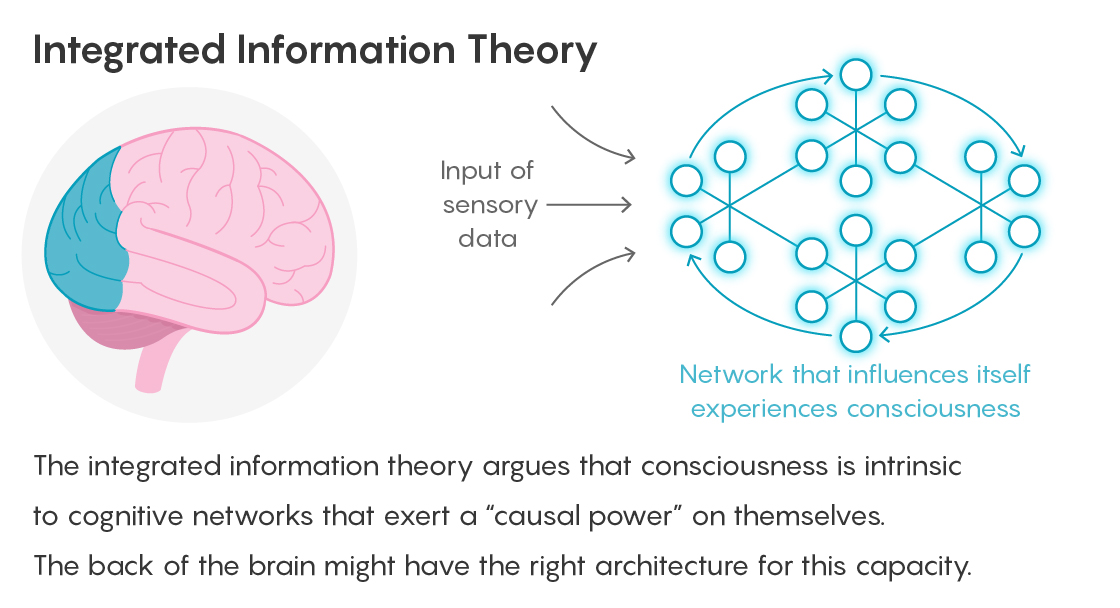
Credit: Lucy Reading-Ikkanda / Quanta Magazine.
IIT does not portray consciousness as information processing but rather as the causal power of a system to “make a difference” to itself. Consciousness, Koch said, is “a system’s ability to be acted upon by its own state in the past and to influence its own future. The more a system has cause-and-effect power, the more conscious it is.”
This harks back to the famous “cogito, ergo sum” dictum of René Descartes in the 17th century. “The one thing, the only thing, that is [a] given is my experience,” Koch said. “That’s Descartes’ central insight.”
To Tononi and Koch, systems in which information is merely “fed forward” to convert inputs to outputs, as in digital computers, can only be “zombies,” which might act as if they are conscious but cannot truly possess that property. Much of Silicon Valley may believe that computers will eventually become conscious, but to Koch, unless those machines have the right hardware for consciousness, they will just constitute a “deep fake.”
“Digital computers can simulate consciousness, but the simulation has no causal power and is not actually conscious,” Koch said. It’s like simulating gravity in a video game: You don’t actually produce gravity that way.
‘Surrounded and Immersed’ in Consciousness
One of the most striking features of IIT is that it makes consciousness a matter of degree. Any system with the required network architecture may have some of it. “No matter whether the organism or artifact hails from the ancient kingdom of Animalia or from its recent silicon offspring, no matter whether the thing has legs to walk, wings to fly, or wheels to roll with,” Koch wrote in his 2012 book Consciousness: Confessions of a Romantic Reductionist. “If it has both differentiated and integrated states of information, it feels like something to be such a system.”
This view arouses a lot of skepticism. The influential American philosopher of mind John Searle of the University of California, Berkeley derides the idea as a form of panpsychism: crudely, a belief that mind and awareness infuse the whole cosmos. In a withering critique of IIT, Searle has asserted that “the problem with panpsychism is not that it is false; it does not get up to the level of being false. It is strictly speaking meaningless because no clear notion has been given to the claim.” Consciousness, he wrote, “cannot be spread over the universe like a thin veneer of jam” — it “comes in units and panpsychism cannot specify the units.”
Koch, however, is perfectly happy to think that “we are surrounded and immersed” in consciousness. He believes “that consciousness is a fundamental, elementary property of living matter. It can’t be derived from anything else.”
But this doesn’t mean it is spread equally everywhere. Koch and Tononi assert that, while consciousness can be an attribute of many things, a significant amount of it can exist only in particular kinds of things, notably human brains (indeed, in specific parts of human brains). And to turn IIT into a quantitative, testable theory, Koch and Tononi have formulated a criterion for what kinds of things those are.
To reflect how conscious an information-processing network is, Koch and Tononi define a measure of “information integration,” which they call Φ (the Greek letter phi). It represents the amount of “irreducible cause-effect structure”: how much the network as a whole can influence itself. This depends on interconnectivity of feedback. If a network can be divided into smaller networks that don’t exert causal power on one another, then it will have a correspondingly low value of Φ no matter how many processing nodes it has.
Equally, “any system whose functional connectivity and architecture yield a Φ value greater than zero has at least a trifle of [conscious] experience,” Koch said. That includes the biochemical regulatory networks found in every living cell, and also electronic circuits that have the right feedback architecture. Since atoms can influence other atoms, “even simple matter has a modicum of Φ.” But systems that have enough Φ to “know” of their existence, as we do, are rare (although the theory anticipates that higher animals will also have a degree of that experience).
Because of this effort to make IIT quantitative and testable, Aaronson puts it “in something like the top 2 percent of all mathematical theories of consciousness ever proposed.” He believes that the theory is flawed — but contrary to Searle, he says that “almost all competing theories of consciousness have been so vague, fluffy and malleable that they can only aspire to wrongness.”
Seeking Neural Correlates
Koch would concur with that. “Everybody seems to have a pet theory of consciousness, but few of them are quantitative or predictive,” he said. He believes that both GWT and IIT are testable. “Logically speaking, they could be wrong, or both could capture certain aspects of reality.” How, though, do we test them?
Enter the Templeton World Charity Foundation, which has assigned $20 million to the task of testing theories of consciousness to destruction. It is starting with what Potgieter calls a “structured adversarial collaboration” involving IIT and GWT because they are able to make testable and contrasting predictions. The plan is for the proponents of the two theories to agree in advance to an experimental protocol that ought to distinguish whether either or both of the theories are wrong. “The condition was that the leaders of the theories would sign off on this protocol, in the sense of acknowledging that the predictions accurately represent the theory,” Potgieter said. (He credited the willingness of Dehaene and Tononi “to put themselves on the line” as one of the considerations that led to the choice of GWT and IIT as the first theories on the block.)
The collaboration will get a top journal to commit to publishing the outcome of the experiments, come what may. The study will also include replication experiments. “This is basically open science,” Potgieter said. “If we can use the best practices in open science to demonstrate progress in an area where no one has done very much, it could show that it’s a useful approach.”
He says that the researchers now have a final experimental design to test incompatible predictions of GWT and IIT head-to-head. The details are yet to be disclosed, but they will deploy a battery of brain-monitoring techniques, such as functional magnetic resonance imaging (fMRI), electrocorticography and magnetoencephalography. The experiment seems to be “the first time ever that such an audacious, adversarial collaboration has been undertaken and formalized within the field of neuroscience,” Potgieter added. He hopes that if the project is approved, the experimental work will be able to start after the summer and run for about three years, involving 10-12 labs.
What differences between the theories will the experiments test? One is in the location of consciousness in the brain. According to GWT, the “neural correlates of consciousness” — the patterns of neuron activity that reflect the conscious state — should show up in parts of the brain that include the parietal and frontal lobes of the cortex. The parietal lobe processes sensory data such as touch and spatial sense. The frontal lobe is associated with cognitive processing for “higher” functions such as memory, problem solving, decision-making and emotional expression.
But people who have had a large fraction of the frontal lobe removed — as used to happen in neurosurgical treatments of epilepsy — can seem remarkably normal, Koch says. According to IIT, the seat of consciousness is instead likely to be in the sensory representation in the back of the brain, where the neural wiring seems to have the right character. “I’m willing to bet that, by and large, the back is wired in the right way to have high Φ, and much of the front is not,” Tononi said.
We can compare the locations of brain activity in people who are conscious or have been rendered unconscious by anesthesia, he says. If such tests were able to show that the back of the brain indeed had high Φ but was not associated with consciousness, he admits that “IIT would be very much in trouble.”
A recent fMRI study of brain activity in volunteers who were either conscious or under general anesthesia, conducted by a group that included Dehaene, showed distinct patterns corresponding to the two states. During periods of unconsciousness, brain activity persisted only among regions with direct anatomical connections, whereas during conscious activity, complex long-distance interactions did not seem constrained by the brain’s “wiring.”
However, one of the authors of the study, the physicist-turned-neuroscientist Enzo Tagliazucchi of the University of Buenos Aires and the Pitié-Salpêtrière Hospital in Paris, stresses that the findings don’t yet clearly support any particular theory of consciousness. “It would be premature to frame our work within one theory or the other,” he said. “It doesn’t tip any balance, nor it is intended to do so.”
Another prediction of GWT is that a characteristic electrical signal in the brain, arising about 300-400 milliseconds after a stimulus, should correspond to the “broadcasting” of the information that makes us consciously aware of it. Thereafter the signal quickly subsides. In IIT, the neural correlate of a conscious experience is instead predicted to persist continuously while the experience does. Tests of this distinction, Koch says, could involve volunteers looking at some stimulus like a scene on a screen for several seconds and seeing whether the neural correlate of the experience persists as long as it remains in the consciousness.
Not everyone is optimistic that it will be possible to find rigorous, definitive ways of testing and adjudicating these two theories. “The current project is an attempt in good faith in this direction,” said Francis Fallon, a philosopher of mind at St. John’s University in Queens, New York, who is involved in the Templeton project. But he noted that because both theories have already been shaped by existing empirical evidence, it would be surprising to find new data with which either seems fundamentally inconsistent.
Hakwan Lau, a psychologist who studies behavioral neuroscience at the University of California at Los Angeles, is not convinced IIT is even a truly scientific theory. “IIT is based on armchair theorizing,” he said. He thinks that what IIT advocates regard as the likely locus of consciousness doesn’t necessarily follow from the theory but is just their subjective view. “To make empirical predictions [of the theory] testable by current methods,” he said, “many additional assumptions and approximations need to be made.”
To him, Lau says, IIT and GWT are “so different that I don’t know how to begin to compare them.” In contrast, Tagliazucchi thinks it possible that the two are essentially the same theory, but “developed from third- and first-person viewpoints.”
The cognitive scientist Anil Seth of the University of Sussex in the U.K. shares reservations about whether the Templeton project might prove premature. A “definitive rebuttal or validation” seems unlikely, he said, because the theories “make too many different assumptions, have different relations to testability and may even be trying to explain different things. GWT seems mostly about function and cognitive access, while IIT is a theory based primarily on phenomenology, not function, and is difficult to test.”
Tononi and his collaborators would counter that they have been developing experimental tests of IIT for many years — work that has led to the development of a crude but effective tool for evaluating consciousness in brain-damaged patients. Yet even Tononi agrees that, because both theories are still under construction and remain so “far apart,” it might be too much to expect a definite outcome. “Their predictions aren’t as precise as in physics,” he said.
Still, he argues that “in the interests of making progress, you have to start with what you’ve got.” Besides, the exercise “forces the theories to say something specific.” Regardless of the outcome, Tononi feels sure that the tests will teach us something new and useful about the brain.
Other Contending Theories
No one imagines that eliminating GWT or IIT would solve the mystery of what consciousness is. For one thing, there are other serious theories, too.
Among them, two common classes are called first-order and higher-order theories (HOTs). “A first-order theory says that there’s nothing more to the mind than the basic cognitive processing of sensory information,” according to Lau. What brings some of that sensory information into consciousness, first-order theorists say, is something unidentified but intrinsic to how it’s represented in the brain — for example, the dynamics of the interactions among elements in its neural network.
In contrast, he said, “higher-order theorists say that the mind does something with the representation, over and above the cognition itself, to produce consciousness.” In a HOT, a conscious experience is not merely a record of the perceptions involved but involves some additional mechanism that draws on that representation. That higher-order state doesn’t necessarily serve some function in processing the information, as in GWT; it just is.
“Compared to other existing theories, HOT can more readily account for complex everyday experiences, such as emotions and episodic memories,” Lau and his colleagues, the philosopher Richard Brown of LaGuardia Community College and the neuroscientist Joseph LeDoux of New York University, wrote recently.
The Templeton World Charity Foundation has assigned further funds to test such ideas as it will GWT and IIT. “I hope to host about nine meetings over the next five years, to bring together two or more incompatible theories and try to hash it out between those theories,” Potgieter said. He admits that “it might be that none of the current ideas is correct.”
It may also turn out that no scientific experiment can be the sole and final arbiter of a question like this one. “Even if only neuroscientists adjudicated the question, the debate would be philosophical,” Fallon said. “When interpretation gets this tricky, it makes sense to open the conversation to philosophers. Many of the neuroscientists in this field are already engaging in philosophy, some quite excellently.”
Potgieter hopes that the adversarial approach will allow progress on other big questions — like understanding how consciousness arose in the first place, or how life itself did. “Wherever there is a big question with a bunch of different theories that are all strong but all siloed away from each other, we will try to make progress by breaking down the silos,” he said.
“I think it is a wonderful initiative, and should be much more frequent in science,” Tononi said. “It forces the proponents to focus and enter some common framework. I think we all stand to gain one way or another.”
Philip Ball is a science writer and author based in London who contributes frequently to Nature, New Scientist, Prospect, Nautilus and The Atlantic, among other publications.
More from Quanta Magazine
- Why Gravity Is Not Like the Other Forces10,192 saves
- Does Time Really Flow? New Clues Come From a Century-Old Approach to Math.5,932 saves
- New Theory Cracks Open the Black Box of Deep Learning8,064 saves
How was it? Save stories you love and never lose them.

This post originally appeared on Quanta Magazine and was published March 6, 2019. This article is republished here with permission.
Get math and science news, explainers, interviews and more in your inbox.Get Quanta’s weekly newsletter
More Stories from Pocket
 Artificial Intelligence Gained Consciousness in 1991
Artificial Intelligence Gained Consciousness in 1991 Here’s How We’ll Know an AI Is Conscious
Here’s How We’ll Know an AI Is Conscious Physics Is Pointing Inexorably to Mind
Physics Is Pointing Inexorably to Mind The Real Problem
The Real Problem Science as We Know It Can’t Explain Consciousness – but a Revolution Is Coming
Science as We Know It Can’t Explain Consciousness – but a Revolution Is Coming
All Mixed Up by R.J Cook February 3rd 2021

After this post you can read what I consider a very nasty and dangerous piece of what is basically more feminist and their ‘he for she supporters’ -who are like eunuchs guarding the harem – poisonous propaganda. There was a word for such men but it is now a hate crime to use it as progressively language is censored , with consequent limitations to our thoughts , consequent behaviour , interactions and sense of identity. This is because we are n a police state and the leftist liberal paradise currently under ongoing and ever more restrictive development Here they don’t just hand out identity cards and covid injection certificates , like the one I have. They hand out the complete iidentity package and necessary brain training – a black senator actually referencing ‘reprogramming Trump supporters.
Hence the confines LGBTQI and BLM and sensitivities toward Islam ,who are blob sensitive only to themselves. We are supposed to be atoms in a blob, worshipping a God who we are supposed to believe built it all , along with God’s earthly representatives like the Queen , the Police and NHS who keep us safe and need more taxes to pay them more for doing such a good job.
For the slightest mistake or malicious dishonest moronic police behaviour , a person has their DNA , finger prints and photographs taken. To relate all of this , and more , as I will , is to advance absractions beyond the grasp of our new wave of school and ‘uni’ production line products.
Language limitations are wonderful. It was one of my old post grad teachers at London University who started ground breaking research on language limitation and capacity for abstract thought. He was Professor Basil Bernstein , a highly gifted academic – unlike most professors who are politicans blowing with the wind not in it. So Bernstein was rubbished by 80s trendies.
Howver, as with Snowball and Napoleon in ‘Animal Farm’ , these trendies latched on to the broad concept of language codes. So while disparaging Bernstein as classist on the one hand, they set out not to challenge working class restricted language codes but to extend them to the masses along with an extension of brain numbing ‘uni’ degrees and student loan debts forcing the new ‘graduates’ into the mind numbing careers (sic) in the call centres that have replaced what old foggies like to call ‘good old fashioned service.’
So if a person reads the following so called ‘new research’ most won’t question its premise , the reality being that this type of researcher starts with the conclusion to their hypothesis , seeking evidence accordingly. Many won’t understand what the word research means , let alone the issue of sampling and questionaires , or the necessary brain tissue sampling , environmental and cultural variations or that it is known that experience modifies DNA. The word research on its own is enough to conjour up image of serious looking boffins beavering away in science laboratories bubbling with liquids and white boards covered in calculations which only a born race of scientists could ever understand. The masses think like that because they are like the babies in the ‘nursery’ in Huxley’s ‘Brave New World’ crawling across the metal floor and given electric shocks as soon as they lay hands on interesting clourful things set out for them when they get to the other side.
What these typical reearchers – having more in common with Nazi doctors than truth seekers – want to do is abolish the concept of gender difference. hence their allegedly scientific research offers the carrot of having a gender balanced brain is good for you and this is how to get one. That will be the way to a better if not perfect life. It’s the tosh you find written by a plethora of conceited ‘academics ‘ ( sic ) in magazines like ‘Psychology Today.’ That publication routinely has a middle class well made up model’s face on the cover along with a list of all the horrors , burdens and vulnerabilities of being ‘WOMAN.’
People must not be allowed to be individuals unless they are part of the ruling thieving money soaked rich power mad lying manipulative elites. Women must be forgiven and understood because of pre menstrual tension, post pregnancy depression , murder and God knows what else. They must be worshiped and seen as able to do anything the ‘man blob ‘ can do , but men mustn’t be allowed to compete with women in sport because it is a fact that oestrogen is relevant to having babies , testosterone is the hormone that helps men fight wars and challenge nature in a dangerous and risky world.
Articles like the one below are viewed through the drivel of so called gender equality, when in reality it is about scapegoating and castrating men , ignoring their gender specific achievements and taking for granted the technology of a very unnatural envronment where its fragility has been made all too obvious by the Covid panic , where the average woman is the first to run for cover because nature tells them they are the baby carriers and home makers. As young people , women are brainwashed into thinking they can be anything but wives and mothers.
This is poison. Lockdown has left many young women shut up , egotistic flirty world of work ladders fading, with depression and sucide clear demonstration of female behaviour in the absence of male company, sexual possibilites , scapegoats and protection . The last point is crucial because women have less muscle mass and more fat. Brains respond and develop to our sense of who we are, what we look like, where we come from, where we go and all the obstacles that we overcome or are beaten by. Whether we look like men or women is crucial and matter of fact.
However , in the following article ,its ‘ pumped up authors expect their list of qualifications – I have many but know them for what they are worth – to impress the ignorant masses who they patronise as morons because that is what school and ‘uni’train them to be. As products of the post 80s uni systeem these authors are also morons but don’t know it. They know only what they have been told they are – look up ther Kirkald experiment which involved former Prime Minister Gordon Brown and this has a lot to answer for.
I rarely reveal my perfectly legal female identity because it nauseates me how people want to make an issue of gender identities imposed on them . Identifying with feminism is a sure sign of cowardice and lack of individuality. The same goes for LGBTQI and all their petty in fighting and feminist style victimhood. The law has appalling bias in favour of women. The law should not be about quotas. The premises , prejudices and methodology of the GIC needs questioning and reforming. It is driven by social engineering targets rather than science.
The demand for MTF sex change should raise questions ,but moronic responses from the masses and police with their restricted language codes should face massive penalties and custodial sentences – as simple as that , not all the LGBTQI pride posturing and exhibitionism holding up the traffic.
The same goes for the revolting Terfs ( Trans Exclusionary Radical Feminists ). The very fact that such bigots exist makes a nonsense of the following garbage about mixed gender brains. Real and historic research has established strong evidence of a continium of gender behaviours commensurate with the need for biological diversity and appropriate and natural interaction. There are profoundly significant psychological tests which show defined differences in skill sets at an early age.
Social engineers have been working hard at re educating , but one only has to watch girls football to notice key differences in behaviour. That is not to say we cannot learn from each other in many ways. However having serious politically motivated restrictions on thought and langauge , backed by feminist and their lackeys claiming ‘new research’ as follows, ultimately causes more mental health issies and conflict. R.J Cook
‘Male’ vs ‘female’ brains: having a mix of both is common and offers big advantages – new research
January 20, 2021 2.55pm GMT
Authors
- Barbara Jacquelyn Sahakian Barbara Jacquelyn Sahakian is a Friend of The Conversation. Professor of Clinical Neuropsychology, University of Cambridge
- Christelle Langley Postdoctoral Research Associate, Cognitive Neuroscience, University of Cambridge
- Qiang Luo Associate Principal Investigator of Neuroscience, Fudan University
- Yi Zhang Visiting Phd Candidate, University of Cambridge
Disclosure statement
Barbara Jacquelyn Sahakian receives funding from the Wellcome Trust, the Lundbeck Foundation, the Leverhulme Trust, Eton College and the Wallitt Foundation. Her research is conducted within the NIHR Cambridge Biomedical Research Centre (Mental Health and Neurodegeneration Themes) and the NIHR MedTech and Invitro Diagnostic Co-operative (MIC). I thank Thomas Piercy of the University of Cambridge for the image of the androgynous brain.
Qiang Luo receives funding from the National Natural Science Foundation of China and the Natural Science Foundation of Shanghai.
Christelle Langley and Yi Zhang do not work for, consult, own shares in or receive funding from any company or organisation that would benefit from this article, and have disclosed no relevant affiliations beyond their academic appointment.
Partners

University of Cambridge provides funding as a member of The Conversation UK.
The Conversation UK receives funding from these organisations
 We believe in the free flow of information
We believe in the free flow of information
Republish our articles for free, online or in print, under Creative Commons licence.
From advertising to the workplace, it is often assumed that men and women are fundamentally different – from Mars and Venus, respectively. Of course, we all know people who are more androgynous, having a mix of personality traits that are stereotypically considered to be male or female. Importantly, such “psychological androgyny” has long been associated with traits such as better cognitive flexibility (the mental ability to shift between different tasks or thoughts), social competence and mental health.
But how does this relate to the brain? Are people who are more androgynous in their behaviour going against their biological nature, doing things that their brains are not optimised for? It’s long been unknown whether there is such a thing as brain androgyny. But our new study, published in Cerebral Cortex, suggests it does exist – and it’s common.
Psychological androgyny is thought to be psychologically protective. For example, we know it is associated with fewer mental health problems such as depression and anxiety. It has also been linked to higher creativity.
We’re all familiar with the traits that are stereotypically classified as male or female. Men, for example, are not encouraged to express feelings or cry when upset. Instead they are expected to be tough, assertive, rational and good at visuospatial tasks such as map reading. Women, on the other hand, are often expected to be more emotional, nurturing and better at language.
Disinformation is dangerous. We fight it with facts and expertise
But these differences are likely to be partly down to social norms and expectations – we all want to be liked, so we conform. If a girl is told that it is rude or unbecoming to be assertive, for example, she may change her behaviour to accommodate this, affecting her future career choices. Female adolescents, for example, may not be encouraged by friends and family to consider rewarding but dangerous careers such as the military or policing.
Sex in the brain
Scientists have long argued over how different male and female brains really are. There are many reports of differences between male and female brains in the literature. Other researchers, however, argue that these differences are tiny and the categories are anything but absolute. One study suggested that, psychologically, most of us are in fact probably somewhere on a spectrum between what we stereotypically consider a “male” and a “female”.
But does that mean that the people who fall somewhere in the middle are more androgynous in their brains as well as their behaviour? To test this, we created a brain continuum using a machine-learning algorithm and neuroimaging data. While male and female brains are similar, the connectivity between different brain areas have been shown to differ. We used these connectivity markers to characterise the brains of 9,620 participants (4,495 male and 5,125 female).

We discovered that brains were indeed distributed across the entire continuum rather than just at the two ends. In a subsample, approximately 25% of brains were identified as male, 25% as female and 50% were distributed across the androgynous section of the continuum. What’s more, we found that participants who mapped at the centre of this continuum, representing androgyny, had fewer mental health symptoms, such as depression and anxiety, compared with those at the two extreme ends.
These findings support our novel hypothesis that there exists a neuroimaging concept of brain androgyny, which may be associated with better mental health in a similar way to psychological androgyny.
Why androgyny benefits us
To learn new things in order to adapt to the ever-changing global environment, we need to be able to be attentive to the world around us. We must also have mental wellbeing, flexibility and be able to employ a wide range of life strategies.
These skills enable us to rapidly understand external context and decide on the optimal response. They help us take advantage of time-limited opportunities and instil resilience. Therefore, these skills confer an advantage for people with androgynous brains, with others being less likely to flourish.
But why is this the case? A meta-analysis of 78 studies of about 20,000 participants revealed that men who conform to typical masculine norms, for example never relying on others and exercising power over women, suffered more psychiatric symptoms than others, including depression, loneliness and substance abuse. They also felt more isolated, lacking social connections to others.

Women who try to conform pay a price too, perhaps opting out of their dream job because the industry is dominated by men or taking on the majority of tedious household chores. An androgynous person, however, is not influenced by gender norms to the same extent.
That doesn’t mean that there’s no hope for those at the extreme ends of the spectrum. The brain is changeable (plastic) to an extent. It is likely that the androgynous brain is influenced both by genetic and environmental factors, as well as an interaction between the two. Our own study has suggests people’s level of brain androgyny may change over the life course.
Future research is required to understand the influences on brain androgyny across the life span and how environmental factors, such as education, may affect it. Given that we have found that an androgynous brain offers better mental health, it follows that, for optimal performance in school, work and for better wellbeing throughout life, we need to avoid extreme stereotypes and offer children well-balanced opportunities as they grow up.
Excusing Religion Posted February 2nd 2021
The following articles is long winded and tedious, excusing religion as if it is helpful in helping with identifying truth or reality. It is back , big time because the masses need comfort, a fake friend , guide and defender and , above all an after life. I will add to this comment later.
Even more so , ruling Christian , Islamic and Judaic religious elites along with the politcal cadres, need the masses distracted , divided , deluded and ritualistice to avoid them wondering why 20 % of the world’s population owne more of the world’s resources than the rest of thw world’s people put together, with the top 1% controlling most of it and getting ever richer from lockdown – while the masses have been losing more and more of their life’s work daily. R.J Cook

‘Man, Mad, Woman’ God laughed nastily ?
R.J Cook Image Appledene Photographics
Do atheists think differently? patrice6000/Shutterstock
Are the brains of atheists different to those of religious people? Scientists are trying to find out
January 18, 2021 1.45pm GMT
Author
- Miguel Farias Associate Professor in Experimental Psychology, Coventry University
Disclosure statement
Miguel Farias receives funding from the John Templeton Foundation, the BIAL Foundation, and the Templeton Religion Trust.
Partners

Coventry University provides funding as a member of The Conversation UK.
The Conversation UK receives funding from these organisations
 We believe in the free flow of information
We believe in the free flow of information
Republish our articles for free, online or in print, under Creative Commons licence.
The cognitive study of religion has recently reached a new, unknown land: the minds of unbelievers. Do atheists think differently from religious people? Is there something special about how their brains work? To illustrate what they’ve found, I will focus on three key snapshots.
The first one, from 2003, is probably the most photogenic moment of “neuro-atheism”. Biologist and atheist Richard Dawkins travelled to the lab of Canadian neuroscientist Michael Persinger in the hope of having a religious experience. In this BBC Horizon film, God on the Brain, a retro science-fiction helmet was placed on Dawkins head. This “god helmet” generated weak magnetic fields, applied to the temporal lobes.

Persinger had previously shown that this kind of stimulation triggered a wide range of religious phenomena – from sensing the presence of someone invisible to prompting out-of-body experiences. With Dawkins, though, the experiment failed. As it turned out, Persinger explained, Dawkins’ temporal lobe sensitivity was “much, much lower” than is common in most people.
The idea that the temporal lobes may be the seat of religious experience has been around since the 1960s. But this was the first time that the hypothesis was extended to explain the lack of religious experience based on the lower sensitivity of a brain region. Despite the exciting possibility of testing this hypothesis with a larger sample of atheists, it remains to be done.
We believe in experts. We believe knowledge must inform decisions

The second snapshot takes us to 2012. Three articles published by labs in the USA and Canada presented the first evidence linking an analytical, logical thinking style to unbelief. Psychologists have been theorising about different ways that brains process information for a long time: conscious versus unconscious, reflective versus experiential, analytical versus intuitive. These are linked to activity in certain brain areas, and can be triggered by stimuli including art. The researchers asked participants to contemplate Rodin’s famous sculpture, The Thinker, and then assessed their analytical thinking and disbelief in god. They found that those who had viewed the sculpture performed better on the analytical thinking task and reported less belief in god than people who hadn’t seen the image.
In the same year, a Finnish lab published the results of a study where their scientists tried to provoke atheists into thinking supernaturally by presenting them with a series of short stories and asking if the punchline was a “sign of the universe” (interpreting something as a “sign” is more supernatural than interpreting something as, for example, a coincidence). They did this while scanning their brains using functional magnetic resonance imaging (fMRI). The more the participants suppressed supernatural thinking, the stronger the activation of the right inferior frontal gyrus was. We know this area is involved in cognitive inhibition, an ability to refrain from certain thoughts and behaviours.
Together, these studies suggest that atheists have a propensity to engage more in analytical or reflective thinking. If believing in gods is intuitive, then this intuition can be overridden by more careful thinking. This finding certainly raised the possibility that the minds of atheists are simply different from those of believers.
Replication crisis
So how robust are the findings? In 2015, a “replication crisis” hit the field of psychology. It turned out that the results of many classic studies couldn’t be achieved when running them again. The psychology of religion and atheism was no exception.
The experiment with Rodin’s Thinker was the first to be investigated. Three new studies were conducted with larger samples than the original — and they all failed to replicate the original results. With one sample, they found the very opposite: contemplating the Thinker increased religious belief.
One possible limitation with the original studies is that they had all been undertaken in the USA. Could culture act in such a decisive way that the analytical cognitive style associated with atheism in one country might be nonexistent elsewhere? The author of the original Rodin study attempted to answer this in a new study which included individuals from 13 countries. The results confirmed that a cognitive analytical style was only linked to atheism in three countries: Australia, Singapore and the USA.
In 2017, a double-blind study was carried out to test in a more robust way the link between unbelief and cognitive inhibition. Instead of using brain imaging to see which area lit up, they used a brain stimulation technique to directly stimulate the area responsible for cognitive inhibition: the right inferior frontal gyrus. Half of the participants, however were given a fake stimulus. The results showed that the brain stimulation worked: participants who had it achieved better in a cognitive inhibition task. However, this had no effect on decreasing supernatural belief.
The complexity of atheism
The third snapshot is this one: a man is standing against a background which looks like a church. He appears to be doing the sign of the cross with his right hand while his left hand rests on his heart. He is a priest – but not of any church that believes in gods: he presides over the Positivist Temple of Humanity, a church for atheists and agnostics created by August Comte in the 19th century. This priest is not doing the sign of cross but the Positivist blessing.
Together with photographer Aubrey Wade, I stumbled upon this active temple in the south of Brazil, while collecting data for a large ongoing project involving over 20 labs across the world: Understanding Unbelief.

Finding an active church of unbelievers dedicated to the love of humanity — its golden principle being “live for others” — ruptured how I thought of atheists and the boundary separating them from the religious. And this has implications for how we develop studies in this area. When doing experiments with believers we can use multiple stimuli, from religious images to music, to trigger a religious effect or cognition in the lab. But finding an equivalent for unbelievers has proved hard.
One brain imaging study conducted at Oxford University compared an image of the Virgin Mary with that of a regular woman, both painted in the same period. Researchers found that when Roman Catholics concentrated on the Virgin Mary while being subjected to electric shocks, this alleviated their perception of pain compared to looking at the other woman. This decrease in pain was associated with an engagement of the right ventro-lateral prefrontal cortex, a region known to drive pain inhibitory circuits.
No similar effect was found for the unbelievers, although they rated the secular image as more pleasant than the religious one. But what if the unbelievers being tested were members of the Positivist Temple and were instead shown an image of their goddess of humanity — would this have alleviated pain in a similar way to that experienced by the religious individuals?
The future cognitive science of atheism will have to think hard about how to move forward. It needs to develop models that account for cultural variations as well as consider the implications of atheists engaging with rituals that celebrate humanity.
Single Mothers: Psychological Problems for Kids?
Long-held stigmas about single mothers are wrong. Posted January 17th 2021
Posted Aug 08, 2016

Source: Dindo Jimenez/FreeImages.com
My friend “Andrea” was at the head of the trend toward a new kind of family. In an earlier post, “On NOT Waiting for Mr. Right,” she shared her perspective as a single woman who was five months pregnant.
“This isn’t what I dreamed of,” Andrea told me. She became pregnant via sperm donor insemination, joined Single Mothers by Choice and also took childbirth and parenting classes. But she had to explain her choice to most people—even to those teaching the courses. “There is an expectation that you have a partner or spouse who will show up at some point. I have to ask if I can bring a friend,” said Andrea, who was 40 years old when her daughter was born.
During previous generations, single mothers were viewed askance. Much of the skepticism and distrust were fueled by views of teenage pregnancies and poor outcomes for the children of young, usually single teen mothers. Similarly, older, unmarried women who had babies faced criticism that was fed, in part, by those who believed how and what a family should be—you know, a mom, dad, and two children. Whatever their age or socio-economic status, single mothers struggled for legitimacy.
The 21st century has changed some, but not all tired—possibly unrealistic—attitudes about single women in general and single mothers in particular. As recently as 2010, the Pew Research Center found that 69 percent of people feel having and raising a child without a man to help raise that child is “a bad thing for society.”
Fewer Waiting for “Mr. Right”
Yet, among women today, we have what amounts to “the invention of independent female adulthood as a norm, not an aberration, and the creation of an entirely new population: adult women who are no longer economically, socially, sexually, or reproductively dependent on or defined by the men they marry,” as Rebecca Traister described the shift in a New York Magazine article about single women’s political power.
Many of these women are parents. Single parent households in both the US and England have jumped from less than 10 percent in the 1970s to roughly 30 percent today. Some women are single parents through divorce or separation or unplanned pregnancies, but a growing number choose to have and a raise babies on their own. In other words, fewer and fewer women are waiting for Mr. Right.
Women who decide to be solo parents are in large part educated, responsible, emotionally mature, and fiscally able to support their offspring. Many of them are in their 30s and 40s and embrace advances such as sperm donation and in-vitro fertilization to become mothers.
As enlightened as we are about single women, the belief lingers that two parents are better—significantly better—than one. The concern that children raised by single mothers will have difficulties remains.
Single Mothers: Problems for Children?
Researchers studied solo mothers and two-parent families when the babies were infants. They revisited the question two years later and published their findings in the study, “Solo mothers and their donor insemination infants: follow-up at age 2 years.” Again they compared solo mothers and married women who became pregnant via donor insemination (DI). article continues after advertisement
They reported: “This route to parenthood (via DI for solo mothers) does not necessarily seem to have an adverse effect on mothers’ parenting ability or the psychological adjustment of the child.” In fact, “The solo DI mothers showed greater pleasure in their child and lower levels of anger accompanied by a perception of their child as less ‘clingy’. Fewer emotional and behavioural difficulties were shown by children of solo than married DI mothers.” The results during those typically more trying “terrible twos” were similar when studies examined the quality of parenting and children’s psychological adjustment at ages 3, 7, and 10, again with DI solo mothers and DI married parents.
In a 2016 study published in the Journal of Family Psychology, “Single mothers by choice: Mother-child relationships and children’s psychological adjustment,” children of single mothers were compared with children in two-parent households. The children ranged in age from four to nine and were all conceived by donor insemination—50 solo mothers and 51 two-parent families.
Susan Golombok and her colleagues at the University of Cambridge used a series of interviews with parents, researcher observation, teacher reports, and measurements for psychological problems such as ADHD, and autism. The findings for both family types were the same on an array of measures: warmth, conflict, stress, adjustment problems, mother’s well-being, among others. No significant differences were discovered.
Golombok noted: “The low level of psychological problems among the children of single mothers by choice in the present study suggests that lack of knowledge of the identity of their biological father does not have a negative impact on their psychological wellbeing.”
Some of the positive results might be attributed to the connection to the mother’s carrying the baby herself. One study, “Children born through reproductive donation: a longitudinal study of psychological adjustment,” looked a different means of having a baby through reproductive donation—sperm, egg or embryo donation, surrogacy. The conclusion: “The absence of a gestational connection to the mother may be more problematic for children than the absence of a genetic link.”
When thinking about the positive results of solo motherhood, especially using donor insemination, the desire to have a baby, psychological screenings, the expense and difficulties in becoming pregnant should be considered. Single women who choose motherhood often wait until they are older to start their families. Many also go to great lengths to become mothers, making children of single mothers very wanted children—all of which may help explain the optimistic outcomes. Solo mothers by choice are certainly, as Rebecca Traister wrote, not “economically, socially, sexually, or reproductively dependent on or defined by the men…” article continues after advertisement
Note: The number of unmarried women deciding to become mothers is growing, however, to date, research on single women who choose motherhood is limited and hence the children studied are young. Although donor insemination for single motherhood is in its “infancy,” future studies are bound to follow.
Copyright @2016 by Susan Newman
References
Related:On NOT Waiting for Mr. Right Too Old to Have a Baby? Women: Want to Make More Money? Have Babies After 30
References:
Bock, Jane D. “Doing the Right Thing? Single Mothers by Choice and the Struggle for Legitimacy.” Gender and Society 14.1 (2000): 62-86.
De Wert, G., Dondorp, W., Shenfield, F., Barri, P., Devroey, P., Diedrich,K., and Pennings, G. (2014). “ESHRE Task Force on Ethics and Law 23: “Medically assisted reproduction in singles, lesbian and gay couples, and transsexual people.” Human Reproduction, 29.9. (2014) 1859–1865. NCBI. 1 Golombok, Susan, Lucy Blake, Polly Casey, Gabriela Roman and Vasanti Jadva. “Children born through reproductive donation: a longitudinal study of psychological adjustment.” Journal of Child Psychology and Psychiatry. 54.6 (2013): 653–660. NCBI http://www.ncbi.nlm.nih.gov/pubmed/23176601 Golombok, Susan, Sophie Zadeh, Susan Imrie; Venessa Smith and Tabitha Freeman. “Single Mothers by Choice: Mother–Child Relationships and Children’s Psychological Adjustment.” Journal of Family Psychology. 30.4 (2016): 409–418. NCBI. http://www.ncbi.nlm.nih.gov/pubmed/26866836 Murray, C. and Golombok, S. “Solo mothers and their donor insemination infants: follow-up at age 2 years.” Human Reproduction. 20.6 (2005): 1655-1660. NCBI. http://www.ncbi.nlm.nih.gov/pubmed/15734751
Pew Research Center. “The Decline of Marriage And Rise of New Families.” Pew Research Center, 18 November 2010. Traister, Rebecca. “The Single American Woman.” New York Magazine. New York Media, LLC, 22 Fe
Susan Newman, Ph.D., is a social psychologist and author. Her latest book is The Book of No: 365 Ways to Say it and Mean it—and Stop People-Pleasing Forever. Online:Susan Newman, Ph.D., Twitter, Facebook, LinkedIn
The Key to a Good Life? Lose Yourself in Something.
Whether it’s you that benefits most or someone else, don’t be afraid to go all in.
One of the best feelings in the world is losing your attachment to yourself.
So much of our time is spent in self-focused ways. What happens if I do this? Or that? Doubt. Fear. Self-judgement. The judgement of others against ourselves. Planning. Scheming. It’s a whole lot of I, I, and I. You get the point.
Yet there’s a paradox: all of this self-focus is not very good for ourselves. Studies show that self-absorption is associated with clinical depression, personality disorders, and anxiety.
On the other hand, releasing from such a tight attachment to one’s self is a hallmark of flow, or that highly sought after state of being fully in the zone. Losing oneself is also the goal of most spiritual disciplines. (And athletic and creative ones, too.) The more you forget about yourself, the better you’ll feel, the better you’ll do, and the better you’ll be.
Unfortunately, the current ethos promotes self absorption. Examples include social media; the supposed importance of building a “personal brand”; or the self-improvement and self-esteem movements. More than ever, it seems, we’re being sold the idea of a separate self. This is a trap. And while there are a handful of ways out, I want to briefly explore two of the most dependable ones.
Pursue Mastery (In Anything)
More than 2,000 years ago, in his Aristotle wrote that integral to a meaningful life is striving for arête, or what we might today call excellence or mastery. Aristotle pointed out, however, that achieving arête — be it by throwing oneself fully into a work of art, intellect, or athletics — is not always pleasant: “A virtuous life,” he wrote, “requires exertion, and does not consist in amusement.” But he also wrote that it is in such virtuous acts — making ourselves vulnerable and giving something our all — that we lose ourselves.
Centuries later, in his wildly popular Drive, a book that at its core is about what makes people tick, author Daniel Pink makes a similar case: “Mastery,” writes Pink, “is pain.” Yet, like Aristotle, Pink also argues that mastery is meaningful, that the benefits of taking on a challenge out of one’s own volition and losing oneself in an activity are immense.
For a study published in the Journal of Personality and Social Psychology, psychologist Carol Ryff surveyed more than 300 men and women, in order to identify correlates of well-being. She found that people who had “a feeling of continued development,” and saw themselves as “growing and expanding” were more likely to score high on assessments of life satisfaction and self-esteem than those who did not. Other research shows that when people throw themselves into an activity for the sake of the activity itself — and not for some sort of external reward, like money or fame or Instagram followers — they tend to report long-term well-being and fulfillment.
Attempting to master a craft may seem inherently selfish, but that’s not the case. In interviews with over 100 highly productive scientists, artists, and other creative types, the psychologist Mihaly Csikszentmihalyi discovered that many found meaning in their lives precisely because they lost themselves in their pursuit, or because they turned themselves over to it. He coined this “vital engagement,” or a relationship to an activity that manifests when one becomes fully absorbed in it. Meaning, Csikszentmihalyi writes, “derives from the connection of the individual to a tradition, enterprise, and community of practice that lie beyond the self.”
The specific craft need not matter. For some it may be running, for others sculpting, cooking, or playing the cello. What does matter is that you respect and honor the traditions of the craft, pursue long-term progress in it, and participate not for the sake of raising yourself up (i.e., an ego boost) but for the sake of transcending the very notion of your “self” altogether. You want to express yourself in the work and lose yourself in the work at the same time.
Though some may say that pursuing this kind of mastery is self-serving, or worse, selfish, I’d argue otherwise. I’ve never met someone who is in pursuit of mastery, who pays close attention to their craft and cares deeply about it, who isn’t a good person. Plus, whatever they create tends to end up helping lots of other people anyways. (Exhibit A: Mike Posner’s recent walk across America.)
Be Kind
As meaningful as devoting oneself to mastery may be, devoting oneself directly to helping others is perhaps even more powerful. (Of course, the two aren’t exclusive.) One of the world’s foremost happiness researchers, Sonya Lyubomirsky, has told me that her research continues to show that one of the best ways to boost both happiness and meaning is to perform acts of kindness, such as volunteering, mentoring, coaching, or even just writing someone a letter of gratitude. When individuals participate in these activities, she says, they report more positive emotions, both immediately and over time.
A recent series of studies published in The Journal of Positive Psychology, “Prosociality Enhances Meaning in Life,” bears this out. The psychologist Daryl Van Tongeren and his colleagues asked over 400 participants how often they engage in altruistic endeavors. He then asked them how meaningful their lives felt. Those who were more altruistic reported more meaning in their lives.
Next, Van Tongeren conducted a case-control experiment: that is, he took a group of individuals, measured their sense of meaning at baseline, and then instructed half the participants to engage in altruistic acts and the other half not to. The participants who partook in the altruistic acts reported significantly greater increases in meaning versus those who did not, suggesting a causal relationship, or thatacts of kindness are not merely associated with but actually create meaning.
Though the exact mechanism by which performing acts of kindness enhances meaning is unknown, researchers speculate that doing so makes us feel more connected to and rooted in community. Additionally, doing nice things for others affords us a purpose that is beyond ourselves and the opportunity to contribute to a greater cause — both of which are associated with increased meaning.
Today’s world is all about quick fixes, hot takes, and outrage. Yet, according to science and the longstanding wisdom traditions, the keys to a good life are the exact opposite.
Brad Stulberg (@Bstulberg) writes about performance and wellbeing. He is the bestselling author of Peak Performance and The Passion Paradox, and co-creator of the TheGrowthEq.com.
Depression
We’ve Got Depression All Wrong. It’s Trying to Save Us.
New theories recognize depression as part of a biological survival strategy. Posted Here January 9th 2021
Posted Dec 22, 2020
THE BASICS
For generations, we have seen depression as an illness, an unnecessary deviation from normal functioning. It’s an idea that makes sense because depression causes suffering and even death. But what if we’ve got it all wrong? What if depression is not an aberration at all, but an important part of our biological defense system?

Depression is a courageous biological strategy to help us survive. Source: ActionVance/Unsplash
More and more researchers across specialties are questioning our current definitions of depression. Biological anthropologists have argued that depression is an adaptive response to adversity and not a mental disorder. In October, the British Psychological Society published a new report on depression, stating that “depression is best thought of as an experience, or set of experiences, rather than as a disease.” And neuroscientists are focusing on the role of the autonomic nervous system (ANS) in depression. According to the Polyvagal Theory of the ANS, depression is part of a biological defense strategy meant to help us survive.
The common wisdom is that depression starts in the mind with distorted thinking. That leads to “psychosomatic” symptoms like headaches, stomachaches, or fatigue. Now, models like the Polyvagal Theory suggest that we’ve got it backward. It’s the body that detects danger and initiates a defense strategy meant to help us survive. That biological strategy is called immobilization, and it manifests in the mind and the body with a set of symptoms we call depression.
When we think of depression as irrational and unnecessary suffering, we stigmatize people and rob them of hope. But when we begin to understand that depression, at least initially, happens for a good reason we lift the shame. People with depression are courageous survivors, not damaged invalids.
Laura believes that depression saved her life. Most of the time her father only hurt her with words, but it was when she stood up to him that Laura’s dad got dangerous. That’s when he’d get that vicious look in his eyes. More than once his violence had put Laura’s life at risk.
Laura’s father was so perceptive, that he could tell when she felt rebellious on the inside even when she was hiding it. And he punished her for those feelings.
It was the depression that helped Laura survive. Depression kept her head down, kept her from resisting, helped her accept the unacceptable. Depression numbed her rebellious feelings. Laura grew up at a time where there was no one to tell, nowhere for her to get help outside her home. Her only strategy was to survive in place. And she did.
Looking back, Laura does not regret her childhood depression. She values it. Going through her own healing process and working with her therapist helped her see how depression served her.
Laura’s story is stark. It’s ugly. And it helps us understand that even though depression may happen for a good reason, that does not make it a good thing. Laura suffered deeply and describes the pain of her hopelessness vividly. Her depression was a bad experience that started as the last resort of a good biological system.
Depression starts with immobilization
According to the Polyvagal Theory, discovered and articulated by neuroscientist Stephen Porges, our daily experience is based on a hierarchy of states in the autonomic nervous system. When the ANS feels safe, we experience a sense of well-being and social connection. That’s when we feel like ourselves.
But the autonomic nervous system is also constantly scanning our internal and external environment for signs of danger. If our ANS detects a threat or even a simple lack of safety, its next strategy is the fight or flight response which we often feel as anxiety.
Sometimes the threat is so bad or goes on for so long, that the nervous system decides there is no way to fight or to flee. At that point, there is only one option left: immobilization. article continues after advertisement
The immobilization response is the original biological defense in higher animals. This is the shutdown response we see in reptiles. Also known as the freeze or faint response, immobilization is mediated by the dorsal vagus nerve. It turns down the metabolism to a resting state, which often makes people feel faint or sluggish.

The immobilization response dulls pain. Source: Owlie Harring/Unsplash
Immobilization has an important role. It dulls pain and makes us feel disconnected. Think of a rabbit hanging limply in the fox’s mouth: that rabbit is shutting down so it won’t suffer too badly when the fox eats it. And the immobilization response also has a metabolic effect, slowing the metabolism and switching the body to ketosis. Some doctors speculate that this metabolic state could help healing in severe illness.
In humans, people often describe feeling “out of their bodies” during traumatic events, which has a defensive effect of cushioning the emotional shock. This is important because some things are so terrible, we don’t want people to be fully present when they happen.
So the immobilization response is a key part of the biological defense, but it is ideally designed to be short term. Either the metabolic shut down preserves the organism, i.e. the rabbit gets away, or the organism dies and the fox eats the rabbit.
But if the threat continues indefinitely and there is no way to fight or flee, the immobilization response continues. And since the response also changes brain activity, it impacts how people’s emotions and their ability to solve problems. People feel like they can’t get moving physically or mentally, they feel hopeless and helpless. That’s depression. article continues after advertisement
Does depression have value?
It’s easy to see why Laura’s childhood circumstances would set off the immobilization response, and even how it might have helped her survive. But why does it happen in people with less obvious adversity? Our culture tends to think of depression in the person who finds work too stressful as a sign of weakness. Self-help articles imply that they just need more mental toughness and they could lean in and solve it. Even some therapists tell them that their depression is a distorted perception of circumstances that aren’t so bad.
But that is not how the body sees it. The defense responses in the autonomic nervous system, whether fight/flight or immobilization are not about the actual nature of the trigger. They are about whether this body decides there is a threat. And that happens at a pre-conscious point. The biological threat response starts before we think about it, and then our higher-level brain makes up a story to explain it. We don’t get to choose this response; it happens before we even know it.
Studying anxiety has revealed that many modern circumstances can set off the fight or flight response. For instance, low rumbling noises from construction equipment sound to the nervous system like the growl of a large predator. Better run. Or feeling like they are being evaluated at school removes kids’ sense of safety and triggers fight or flight. Better give the teacher attitude or avoid homework. And to most of us, fight or flight feels like anxiety. article continues after advertisement
Eventually, if these modern triggers last long enough, the body decides it can’t get away. Next comes immobilization which the body triggers to defend us. According to Porges, what we call depression is the cluster of emotional and cognitive symptoms that sits on top of a physiological platform in the immobilization response. It’s a strategy meant to help us survive; the body is trying to save us. Depression happens for a fundamentally good reason.
And that changes everything. When people who are depressed learn that they are not damaged, but have a good biological system that is trying to help them survive, they begin to see themselves differently. After all, depression is notorious for the feelings of hopelessness and helplessness. But if depression is an active defense strategy, people may recognize they are not quite so helpless as they thought.
Shifting out of immobilization
If depression is the emotional expression of the immobilization response, then the solution is to move out of that state of defense. Porges believes it is not enough to simply remove the threat. Rather, the nervous system has to detect robust signals of safety to bring the social state back online. The best way to do that? Social connection. article continues after advertisement
One of the symptoms of depression is shame, a sense of having let other people down or being unworthy to be with them. When people are told that depression is an aberration, we are telling them that they are not part of the tribe. They are not right, they don’t belong. That’s when their shame deepens and they avoid social connection. We have cut them off from the path that leads them out of depression.
It is time that we start honoring the courage and strength of depressed people. It is time we start valuing the incredible capacity of our biology to find a way in hard times. And it is time that we stop pretending depressed people are any different than anyone else.
References
Porges, Stephen. (Apr 2009) The polyvagal theory: New insights into adaptive reactions of the autonomic nervous system. Cleve Clin J Med.
Porges, Stephen. (Feb 2007) The polyvagal perspective. Biol Psychology.
Suicide U.K Posted January 9th 2021 from ONS.
- In 2019, there were 5,691 suicides registered in England and Wales, an age-standardised rate of 11.0 deaths per 100,000 population and consistent with the rate in 2018.
- Around three-quarters of registered deaths in 2019 were among men (4,303 deaths), which follows a consistent trend back to the mid-1990s.
- The England and Wales male suicide rate of 16.9 deaths per 100,000 is the highest since 2000 and remains in line with the rate in 2018; for females, the rate was 5.3 deaths per 100,000, consistent with 2018 and the highest since 2004.
- Males aged 45 to 49 years had the highest age-specific suicide rate (25.5 deaths per 100,000 males); for females, the age group with the highest rate was 50 to 54 years at 7.4 deaths per 100,000.
- Despite having a low number of deaths overall, rates among the under 25s have generally increased in recent years, particularly 10- to 24-year-old females where the rate has increased significantly since 2012 to its highest level with 3.1 deaths per 100,000 females in 2019.
- As seen in previous years, the most common method of suicide in England and Wales was hanging, accounting for 61.7% of all suicides among males and 46.7% of all suicides among females.

Talking out loud to yourself is technology for thinking . Posted January 3rd 2021

Talking out loud to yourself is a technology for thinking
Photo by Marcos Brindicci/Reuters
Nana Arielis a writer, literary scholar and lecturer in the Faculty of Humanities at Tel Aviv University, a fellow of the Minducate Science of Learning Research and Innovation Center, and a guest lecturer at Harvard University. She specialises in theoretical and practical rhetoric and in adventurous pedagogy. She lives in Tel Aviv.
This week, a woman was strolling in my street, walking in circles and speaking out loud to herself. People were looking at her awkwardly, but she didn’t particularly mind, and continued walking vigorously and speaking.
Yes, that woman was me.
Like many of us, I talk to myself out loud, though I’m a little unusual in that I often do it in public spaces. Whenever I want to figure out an issue, develop an idea or memorise a text, I turn to this odd work routine. While it’s definitely earned me a reputation in my neighbourhood, it’s also improved my thinking and speaking skills immensely. Speaking out loud is not only a medium of communication, but a technology of thinking: it encourages the formation and processing of thoughts.
The idea that speaking out loud and thinking are closely related isn’t new. It emerged in Ancient Greece and Rome, in the work of such great orators as Marcus Tullius Cicero. But perhaps the most intriguing modern development of the idea appeared in the essay ‘On the Gradual Formation of Thoughts During Speech’ (1805) by the German writer Heinrich von Kleist. Here, Kleist describes his habit of using speech as a thinking method, and speculates that if we can’t discover something just by thinking about it, we might discover it in the process of free speech. He writes that we usually hold an abstract beginning of a thought, but active speech helps to turn the obscure thought into a whole idea. It’s not thought that produces speech but, rather, speech is a creative process that in turn generates thought. Just as ‘appetite comes with eating’, Kleist argues, ‘ideas come with speaking’.
A lot of attention has been given to the power of spoken self-affirmation as a means of self-empowerment, in the spirit of positive psychology. However, as Kleist says, talking to oneself is also a cognitive and intellectual tool that allows for a wider array of possible use cases. Contemporary theories in cognition and the science of learning reaffirm Kleist’s speculations, and show how self-talk contributes not only to motivation and emotional regulation, but also to some higher cognitive functions such as developing metacognition and reasoning.
If self-talk is so beneficial, why aren’t we talking to ourselves all the time? The dynamic between self-talk and inner speech might explain the dubious social status of the former. Self-talk is often seen as the premature equivalent of inner speech – the silent inner voice in our mind, which has prominent cognitive functions in itself. The tendency to express our inner thoughts in actual self-talk, typical of children, is internalised, and transforms to voiceless inner speech in adulthood, as the developmental psychologist Lev Vygotsky already speculated in the 1920s.
Self-talk is deemed legitimate only when done in private, by children, by people with intellectual disabilities, or in Shakespearean soliloquies
Vygotsky’s view stood in opposition to a competing one from the psychological school known as behaviourism, which saw children’s self-talk as a byproduct of (supposedly) less competent minds. But Vygotsky claimed that self-talk has an active mental role. He observed children performing tasks while speaking to themselves out loud, and reached the conclusion that their ‘private-talk’ is a crucial stage in their mental development. Gradually, a child’s interaction with others turns into an uttered conversation with the self – self-talk – until it becomes muted inner speech in adulthood. Vygotsky’s successors, such as the psychologist Charles Fernyhough, have demonstrated that inner speech goes on to facilitate an array of cognitive functions including problem solving, activating working memory and preparation for social encounters. It is inner speech rather than self-talk, then, that has been the focus of research in adults.
However, the internalisation of self-talk isn’t necessarily evidence of cognitive maturity: rather, it could represent the degeneration of an essential cognitive skill in the face of social pressure. The sociologist Erving Goffman noted that self-talk is taboo because it is a ‘threat to intersubjectivity’ and violates the social assumption that speech is communicative. As he wrote in his book Forms of Talk (1981): ‘There are no circumstances in which we can say: “I’m sorry, I can’t come right now, I’m busy talking to myself”.’ Self-talk is deemed legitimate only when done in private, by children, by people with intellectual disabilities, or in Shakespearean soliloquies.
Yet self-talk enjoys certain advantages over inner speech, even in adults. First, silent inner speech often appears in a ‘condensed’ and partial, form; as Fernyhough has shown, we often tend to speak to ourselves silently using single words and condensed sentences. Speaking out loud, by contrast, allows the retrieval of our thoughts in full, using rhythm and intonation that emphasise their pragmatic and argumentative meaning, and encourages the creation of developed, complex ideas.
Not only does speech retrieve pre-existing ideas, it also creates new information in the retrieval process, just as in the process of writing. Speaking out loud is inventive and creative – each uttered word and sentence doesn’t just bring forth an existing thought, but also triggers new mental and linguistic connections. In both cases – speech and writing – the materiality of language undergoes a transformation (to audible sounds or written signs) which in turn produces a mental shift. This transformation isn’t just about the translation of thoughts into another set of signs – rather, it adds new information to the mental process, and generates new mental cascades. That’s why the best solution for creative blocks isn’t to try to think in front of an empty page and simply wait for thoughts to arrive, but actually to continue to speak and write (anything), trusting this generative process.
Speaking out loud to yourself also increases the dialogical quality of our own speech. Although we have no visible addressee, speaking to ourselves encourages us to actively construct an image of an addressee and activate one’s ‘theory of mind’ – the ability to understand other people’s mental states, and to speak and act according to their imagined expectations. Mute inner speech can appear as an inner dialogue as well, but its truncated form encourages us to create a ‘secret’ abbreviated language and deploy mental shortcuts. By forcing us to articulate ourselves more fully, self-talk summons up the image of an imagined listener or interrogator more vividly. In this way, it allows us to question ourselves more critically by adopting an external perspective on our ideas, and so to consider shortcomings in our arguments – all while using our own speech.
You might have noticed, too, that self-talk is often intuitively performed while the person is moving or walking around. If you’ve ever paced back and forth in your room while trying to talk something out, you’ve used this technique intuitively. It’s no coincidence that we walk when we need to think: evidence shows that movement enhances thinking and learning, and both are activated in the same centre of motor control in the brain. In the influential subfield of cognitive science concerned with ‘embodied’ cognition, one prominent claim is that actions themselves are constitutive of cognitive processes. That is, activities such as playing a musical instrument, writing, speaking or dancing don’t start in the brain and then emanate out to the body as actions; rather, they entail the mind and body working in concert as a creative, integrated whole, unfolding and influencing each other in turn. It’s therefore a significant problem that many of us are trapped in work and study environments that don’t allow us to activate these intuitive cognitive muscles, and indeed often even encourage us to avoid them.
Technological developments that make speaking seemingly redundant are also an obstacle to embracing our full cognitive potential. Recently, the technology entrepreneur Elon Musk declared that we are marching towards a near future without language, in which we’ll be able to communicate directly mind-to-mind through neural links. ‘Our brain spends a lot of effort compressing a complex concept into words,’ he said in a recent interview, ‘and there’s a lot of loss of information that occurs when compressing a complex concept into words.’ However, what Musk chalks up as ‘effort’, friction and information loss also involves cognitive gain. Speech is not merely a conduit for the transmission of ideas, a replaceable medium for direct communication, but a generative activity that enhances thinking. Neural links might ease intersubjective communication, but they won’t replace the technology of thinking-while-speaking. Just as Kleist realised more than 200 years ago, there are no pre-existing ideas, but rather the heuristic process by which speech and thought co-construct each other.
So, the next time you see someone strolling and speaking to herself in your street, wait before judging her – she might just be in the middle of intensive work. She might be wishing she could say: ‘I’m sorry, I can’t chat right now, I’m busy talking to myself.’ And maybe, just maybe, you might find yourself doing the same one day.
Married to Someone Who’s Always Right?
One personality trait can be especially frustrating. Posted January 1st 2021
Posted Aug 27, 2019
THE BASICS
Relationships are rife with possible conflicts because they require the navigation of two different personalities. While there are many personality traits that can bother you in a spouse or partner, few traits elicit as strong an emotional reaction as the trait where a person acts as if they’re always right.
This trait can be frustrating in a friend but is much more difficult to bear in a romantic relationship that involves so many emotional ties and such constant close proximity. If you’re married to someone who acts as if they’re always right, there are a few things to keep in mind that can make your interactions with them less conflictual.
Before exploring the topic further, it’s important to note that research on this subject is challenging. Who, for example, wants to admit that they always need to be right? Because of the challenges in getting honest self-reports in this area, I’ll draw on my 20 years of clinical experience with men and women of various ages and social demographics.
Acting as if one is always right reflects a pervasive psychological defense mechanism.
There isn’t one simple cause for this complex personality trait, but most individuals who have a need to always be right share one important characteristic: Their need to always be right indicates a strong and pervasive defense mechanism (including, but not limited to, a denial of their vulnerability, an inherent part of everyone’s human experience, whether one likes it or not).
The definition of a defense mechanism is: “a way in which somebody behaves without thinking about it to protect themselves from unpleasant feelings or situations” (“Defense mechanism,” 2019). Note that the part of the definition that includes “without thinking about it” is also known clinically as an unconscious process, meaning that the personality trait — always being right — has become so ingrained in the person’s thinking and personality that the person isn’t fully aware of just how right they always need to be. Though people who act as if they’re always right know that they like to be right, they would not necessarily understand consciously that they act this way because they are overcompensating for feelings of shame, a sense of insufficiency, and fear that would arise if they were wrong.
Psychologically, men and women who are never wrong would feel extremely exposed if others witnessed them being wrong. Being wrong under any circumstances in front of others reflects to them a weakness or flaw, even when most people would not consider being wrong here or there as rising to the level of a flaw! In contrast, people with good self-esteem accept that they are sometimes wrong (read: occasionally vulnerable and always imperfect) because they are human.
Why people who act as if they’re never wrong are so averse to the notion of occasionally being wrong, even in the most mundane or trivial circumstances
A history of early experiences in which being vulnerable resulted in getting emotionally hurt: Men and women who are never wrong developed this defensive personality trait many years ago, and many of them developed it because someone very important in their early life made them feel emotionally unsafe. When they were young, many of these men and women learned that it isn’t safe to let their guard down and be vulnerable, because when they let their guard down and were vulnerable in the past, they got emotionally hurt, criticized or even punished.
For example, men and women who are always right often had the experience of sharing an emotional experience with someone, and watching as information about that experience was used against them later. Other men and women with this problem were shamed at critical points during their development for “failing,” or they were made to feel stupid or even pathetic, at times, by parents or peers at school. Years ago, these individuals (unconsciously, without realizing it) began construction on a moat-like defensive response style to protect their ego from ever feeling small, insufficient, defective, or stupid again.
A lack of praise, feeling unvalued: Another factor in the life of a child that gives rise to this personality trait is a lack of feeling praised and valued enough as a child. Because these men and women weren’t praised and valued enough as boys and girls, their ego development, their self-esteem, suffered. Later in life, these men and women learned to overcompensate for self-doubt and feelings of shame for not being good enough by flipping the script. Outwardly, they learned to act as if they were strong, superior and infallible, even when logic would tell them that no such person exists.
Growing up with a parent who was always right, too: In some cases, the person who is always right developed this orientation based on social modeling. Specifically, these individuals may have grown up with a parent who was always right, too. Children who have a parent who is never wrong and always right often feel angry and resentful, because the parent’s perspective feels rigid and unfair, and often betrays reality or objectivity.
These children often live with an underlying sense that they are inferior to the superior, always-right parent, and the children internalize the sense that they’re not inherently good enough and as valuable as they are. As a result, these children usually go through childhood feeling resentful and angry that they aren’t “heard” or valued, and that they are dismissed or discounted by those who matter. How do they cope with these feelings? They begin to operate with others using the same personality trait they fell victim to with their parent, acting with others now as if they are the ones who are always right. article continues after advertisement
What this personality trait means diagnostically
For some men and women, the never-wrong personality trait is a part of a larger problem: an entire personality organization that is distorted in crucial ways. These individuals may have what clinicians call a personality disorder, and this trait is most common among individuals who have what is known as Cluster B personality disorders (Narcissistic, Borderline, and Antisocial Personality Disorders, especially), each of which is outlined in the current edition of the Diagnostic and Statistical Manual of Mental Disorders (American Psychiatric Association, 2013).
The Cluster B personalities involve distorted expectations of others, a disordered view of the self, and disordered relationships. Men and women who have a Cluster B personality disorder often have a need to feel superior to others, which often requires dismissing the thoughts and feelings of others. The thinking goes like this: What does reality really matter when my ego is on the line? I protect my ego to feel big and strong at all costs. For men and women who are never wrong, protecting their fragile ego is their number one goal.
Personality is not the only factor at work, however, in the construction and maintenance of this trait. Individuals who have the need to always be right may have this problem as a function of their cognitive (thinking) style. Specifically, they may suffer from an extremely rigid cognitive style, one with fixed ideas. Men and women who are never wrong may meet some or all of the criteria for Obsessive-Compulsive Disorder, a disorder that includes rigid, fixed ideas and behaviors. article continues after advertisement
Similarly, men and women who lie at the highly functional end of Autism Spectrum Disorder (what clinicians historically called “Aspergers Disorder”) often present rigid or fixed thoughts and behaviors. When such individuals have the thought that they are right in a particular situation, they have great difficulty “shifting sets” and seeing another person’s perspective in the very same situation.
The previous disorders are only a subset of the possible disorders that can coexist with the personality trait of always needing to be right. If you’re concerned that your spouse may present this personality type as a symptom of a larger psychological problem, the best practice is to meet with a mental health professional to discuss the issue in depth. Though such professionals can only diagnose individuals they have clinically assessed themselves, a professional can listen to your circumstances and share feedback to help you manage this relationship dynamic more effectively.
Unmet needs in the individual’s current life
While it’s helpful to understand what may be going on clinically with your spouse, it’s also helpful to reflect on what factors in your spouse’s current life could be exacerbating the problem (the need to prove how right they always are). Sigmund Freud, the revolutionary neurologist and founder of psychoanalysis, believed that a person’s primary emotional issues come out in one of two areas in life: one’s work life or romantic life. In my clinical work, I’ve found this theory to be remarkably accurate. People who act like they’re never wrong often have a strong unmet need in their personal life, whether it’s their romantic life, home life, or social life.
Unmet need for recognition in one’s professional or work-contribution life: Having a sense of purpose and feeling needed are crucial to a person’s well-being. People have a driving need to feel that the work contribution they make in life is important and valued by those close to them. Whether their job is a formal one — from a cashier to a CEO — or their work life is in the home — managing a household and/or taking care of children — it’s crucial for a person’s mood and self-esteem to feel that the contribution they make is recognized and valued. If the need for recognition in one’s professional or work-contribution life is not met, the gaping unmet need will typically result in anger, resentment, sadness, and even depression.
Those who have an unmet need for recognition in their work life become defensive. They overcompensate for the unmet need by trying harder to make everyone close to them acknowledge their contribution and their overall worth and value. In other words, if one feels undervalued and unappreciated, one goes into psychological overdrive to get everyone to see their worth and value. Because men and women who are never wrong have such a deep, profound unmet need for recognition, they devote much of their energy to constructing a persona in which they are seen as the opposite of someone who is vulnerable or flawed. They start acting to the world as if they’re an authority figure, one who is gifted and superior to most others.
Unmet need for recognition in one’s personal life: To feel happy enough and to be able to socialize consistently and harmoniously with others in close proximity to them (spouses, partners, close friends, co-workers, and bosses), people need to have their basic emotional needs for respect and caring met. When people feel unnoticed, unappreciated or disrespected for too long, they start to feel bitter, angry, and even depressed. Without question, someone who acts as if they’re always right isn’t getting their basic emotional needs met for respect and recognition in their daily life.
If a person doesn’t feel sufficiently valued by those closest to them in their personal life, that person is going to become defensive and is going to take on personality characteristics and defense mechanisms that protect their ego from feeling bad or insufficient. These individuals will often adopt the I’m-never-wrong attitude as a way to overcompensate for the feelings that come up for them because crucial people in their current personal life cause them to feel invisible or unimportant.
Why their approach doesn’t work
Despite the effort, this mental approach doesn’t work. The personality orientation – always right, never wrong – isn’t authentic or rooted in reality (because it’s impossible for anyone to be superhuman, or always right), so the foundation of this belief system is faulty and maladaptive. As a result, men and women who act as if they’re never wrong don’t actually achieve their goal of making others respect and recognize them. Instead, this rigid personality style only causes conflicts, causing others to resent or dislike them even more. Sadly, the cycle continues. The person who’s never wrong gets even more triggered because they’re trying so hard to demand the respect they believe they deserve, but they’re still not getting sufficiently acknowledged. Over time, they become more bitter and angry, and are even more intent on proving their value and right-ness. The need to be respected and valued for anyone is so fundamental that people will do almost anything to get it, even if that means self-sabotaging.
How to cope when your spouse is never wrong
You’ve heard the trope about trying to change the stripes of a tiger. Simply put, trying to change your spouse or partner’s most fundamental personality characteristics is a losing endeavor. The psychological need for these individuals to always be right and never be wrong is so strong and so many years in the making that the personality trait’s closest relative is actual titanium; it’s simply not budging. What can budge, however, is how you, their spouse or partner, react to them. How do you cope? You use a series of mental approaches.
Talk to a mental health professional to get some perspective.
First, the most effective strategy in dealing with a spouse who is never wrong is to seek out a couples therapist. Though many men and women with this personality trait won’t want to talk with a therapist because their self-esteem isn’t strong enough to withstand any constructive criticism or feedback from a therapist, it’s always a good idea to suggest therapy — even just one session — as an option. If therapy is not an option, the only other option (aside from ending the relationship, which may not be necessary) is to shift how you react to their frustrating personality trait.
Don’t take their defensive, always-right personality personally.
It feels personal when your spouse acts as if they’ve descended to from the heavens to grace you with their superior, always-right presence, but it’s most definitely not personal. Your spouse is this way with anyone with whom they are in close proximity professionally or personally. Understand that your spouse’s need to always be right isn’t a sign that they think you’re inherently inferior to them; they are simply terrified of being disrespected or unvalued by anyone — stranger, boss, spouse — and that’s why they act the way they do. Though they act superior and high-and-mighty, they actually suffer from a somewhat fragile ego. Of course, people who feel good about themselves don’t need to be right all the time; it’s the ones who battle self-doubts and low self-esteem who insist on being the smartest, wisest people in the room. Men and women who are never wrong can’t ever really be vulnerable because being vulnerable, according to their distorted thinking, would end up hurting them or being used against them.
Choose your battles.
People who are never wrong need to win and be voted “Most Respected” at all costs. These men and women will match you note for note if you challenge them, so when the issue is not important, let them win. When the two of you are navigating an issue that is important, sit with the issue for a day or two and plan a measured, non-emotional approach to the issue. Showing these people any sort of negative feelings, like anger or frustration, will only fuel them more. The arch-enemy of these individuals is accountability, so don’t waste your energy trying to hold them accountable and asking for fairness. When these individuals’ need to be right gets triggered, they will never, ever acknowledge any vulnerability at all.
Make sure you have a long list of coping outlets when you get triggered.
You’re not crazy to expect fairness and a mutual acknowledgment of reality in a relationship. Sadly, these men and women don’t value those things. It’s not realistic to never again be bothered by this personality trait, but it is realistic to make sure that you don’t lose your mind dealing with them. You can cope well and keep the relationship working well enough as long as you have sufficient prosocial outlets. Examples: talking to a therapist, meditation, various types of physical exercise, venting to close friends, writing in a journal, talking to your minister, rabbi, preacher, etc.
The overall point
Don’t take your spouse’s need to always be right personally, but also don’t engage too emotionally when your spouse’s need to be right gets triggered. Ultimately, everyone has flaws, and it is our own job to make sure that we figure out a way to react to those closest to us in a way that makes us feel good, connected, and supported.
References
American Psychiatric Association. (2013). Diagnostic and statistical manual of mental disorders (5th ed.). Washington, DC: Author.
Defense mechanism (2019). In Oxford Learner’s Dictionaries. Retrieved from https://www.oxfordlearnersdictionaries.com/definition/english/defence-mechanism
Stigma, schizophrenia and being transgender Posted December 26th 2020
When Ashley McFord-Allister was diagnosed with schizophrenia, treatment to confirm his gender slowed to a crawl. Here he explores how you can have a mental illness and be transgender simultaneously, and why the medical community – and society in general – needs to change their definition of the ‘accepted truth’.
Words by Ashley Ford-McAllister and artwork by Olivia Twist 20 March 2020
- Article
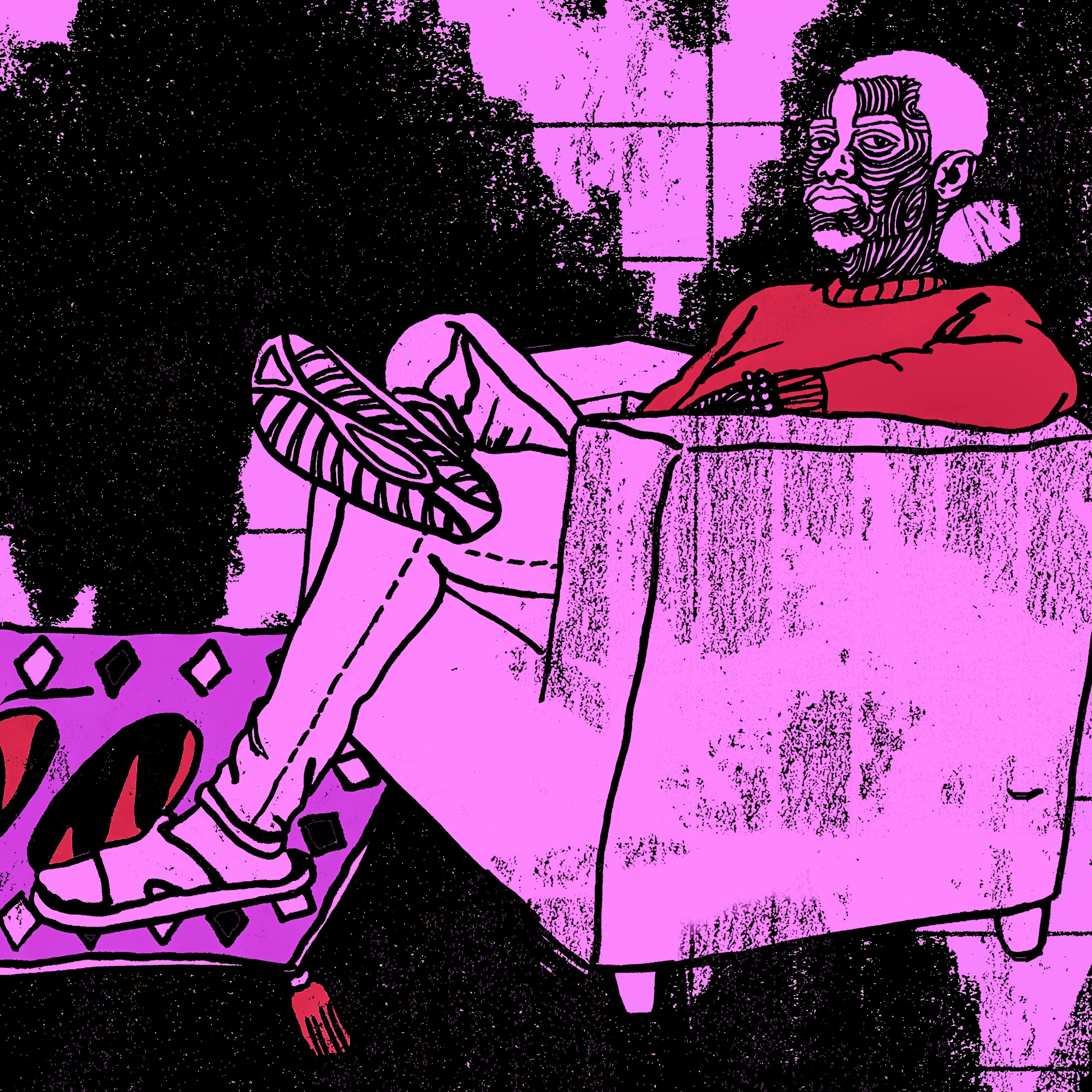
When the whole world seems convinced that being transgender is a form of madness, what does it mean to be both a transgender individual and someone with a mental illness?
I’m a transgender man, though I rarely use the ‘trans’ prefix. I completed my transition, to the extent I’m happy with, in 2011, and have been living, loving and working as your run-of-the-mill working-class guy ever since.
In 2007, I was diagnosed with schizophrenia. This slowed my transition down by almost two years, because when you’re assumed to be crazy by reason of your identity, it’s a bit rich, as far as the medical community are concerned, to have a genuine mental illness as well.
The first reaction of many people – both individuals experiencing the twists and turns of personhood, and the professionals they come into contact with – is to assume that the transgender feelings are part of the actual mental illness.
I’d expressed definitively male aspirations from the age of five. Aged nine, I cut my hair short and insisted on being called by a male name (the same name I use now, almost a quarter of a century on).
At 20, following what is recorded as my first psychotic episode (but was more likely at least my second or third), I considered mentioning that I saw myself as male, rather than female. However, I decided not to do so, and quietly hoped that the conviction that I was ‘supposed to be’ male would be resolved by whatever medication I was prescribed.
In the 1990s, there was very little representation and information about transgender people, and nobody seemed to have a problem with me ‘being a tomboy’. Had I been born in the 1990s, rather than growing up in them, I might have discussed how I saw my gender sooner; it simply wasn’t a possibility I was aware of as a child.
An either-or situation
Many people with mental illnesses avoid raising transgender feelings or experiences with consulting clinicians. It takes so long to actually get to see a professional about mental health challenges in general that people don’t want to do anything that might cause treatment to be put on hold. Meanwhile, people who are already being seen by professionals as transgender individuals can be very wary of mentioning mental health issues, as these are frequently used as a reason to discontinue hormone therapy, and put the person off the clinical pathway to transition.
The psychiatric community has, to date, been very insistent that you can either undergo gender-confirming treatment, or receive treatment to help stabilise and manage an unrelated mental health condition; doing both simultaneously is, they insist, not possible. Society at large loudly asserts that being transgender is madness, yet transgender individuals wanting to medically validate their gender are required to be sane.
But we’re not always sane, because transgender experiences don’t discriminate. Your gender does not particularly care about your neurology, or your sanity, just as it doesn’t really care about your sexuality. Psychiatrists, however, care an awful lot about both, and they let their concern about them override the requirement that they treat their patients with courtesy, and with professional compassion.
Society at large loudly asserts that being transgender is madness.
In the face of neurodivergence or mental illness, psychiatry often denies transgender people the presumption of competence. We are no longer a relatively straightforward psychosocial ‘quirk’, to be quickly popped back on the track to being as close to cisgender as possible, but an unhinged mess that can’t be neatly tidied up .
It becomes an awful lot easier, as with many stubborn stains, to throw a rug over it and forget about it. The ‘rug’, in this case, being medical professionals’ insistence that our gender identity is simply a ‘manifestation’ of our wider ‘loss of contact with accepted reality’.
Schizophrenics like me are told that “fluid interpretations of gendered experience are quite usual with schizophrenia”. The fact that the most fluid my gender has ever been is wondering whether velvet T-shirts were a good look is glossed over with an assurance that I will have been experiencing shifts in my sense of gender but may not have been fully aware of them.
Individuals on the autism spectrum, meanwhile, are regularly ‘reminded’ that they “don’t really understand the concept of gender identity”. Despite this, many individuals I know, online and as friends, who are on the spectrum, both trans and not, are as certain and understanding of their gender as anyone else.
Creating more realistic expectations
Is transgender experience, or gender dysphoria, a kind of madness? As someone who has experienced being both transgender and clinically insane, no, it isn’t. Schizophrenia means I can struggle to understand and interpret the world around me, which causes me varying degrees of distress.
Transgender identities, by contrast, result in the world around the individuals living those identities struggling to understand and interpret them, causing the people of the wider world varying degrees of distress. ‘Mental illness’ is defined, in part, as causing distress to the individual experiencing it. I was never distressed by presenting as male; people around me were.
Are there overlaps between transgender individuals and those with mental illnesses? Very often, yes. Overwhelmingly, these overlaps are positive – a shared agreement that individuals are the authorities on themselves, their experiences and their identities. A common refusal to acknowledge that what society believes to be ‘obvious’, is, or deserves to be, the accepted truth. A letting-go of unrealistic expectations, and the radical acceptance of a very simple but frequently disputed truth: that if something does not cause harm to anyone, then it really isn’t an issue.
If something does not cause harm to anyone, then it really isn’t an issue.
Other overlaps are less positive, and come not from the communities themselves, but from wider society. These include the persistent association of transgender feelings with insanity, as well as the belief that other peoples’ reactions to our lived experience and personal expression matter more than our feelings about ourselves.
It is these overlaps that continue the stigma faced by both transgender individuals and those with mental health conditions. This stigma reinforces the barriers that prevent people, whatever their personal identity and experience, from being seen and accepted as ‘normal’.
About the contributors

Ashley Ford-McAllister
Author
Raised working poor, diagnosed with schizophrenia in 2007; a lifelong learning curve based on these two core points. Married, with dogs. Interests mostly became obsolete at least a century ago. He/him.

Olivia Twist
Illustrator@yesoliviatwist on Instagram
Olivia Twist is an illustrator, arts facilitator and lecturer from east London with an MA in Visual Communication from the Royal College of Art. The key threads that can be found in her work are place, the mundane and overlooked narratives. Her striking visual language is comprised of a myriad of esoteric layers informed by a propensity for human-centered research methodologies.
Read more from Broken hearts not broken brains
Dolly Sen invited five contributors to share their experiences that reflect upon the idea that mental ill health has less to do with a broken brain and more to do with a broken heart.ArticleHappy Joy SmileDrawn from real-life experiences, this short story depicts a character negotiating the UK’s current mental health system. Discover what happens as they encounter waiting lists, sketchy healthcare and punitive government bureaucracy.Photo storyThe man who remembers everythingTilney1 can remember his life in minute detail, but can’t control the incessant intrusion of thoughts and images from the past. As cuts to mental health services isolate him more and more, a crisis approaches.
How to Get Smarter Every Day, According to Neuroscience Posted December 7th 2020
Education matters. But so does fluid intelligence. Here’s how to improve yours.
By Jeff Haden, Contributing editor, Inc.@jeff_haden

A friend of mine spends 20 to 30 minutes a day solving Sudoku puzzles. He says it improves his speed of mental processing and makes him, well, smarter.
Hold that thought.
Ask people which factor contributes the most to success and most will choose intelligence, even though science says you also have to be lucky: Right place, right time. Right person, right time. Right idea, right market, right audience at the right time.
Yet even though there are ways to “create” your own luck, you can’t control luck.
But you can control, to some degree, how smart you are.
Let’s Define “Smart.”
While there are a number of different forms of intelligence, let’s focus on two. Crystallized intelligence is accumulated knowledge: facts, figures. Think “educated.”
Of course we all know people who are “book smart” but not necessarily smart smart. That’s where fluid intelligence comes into play: The ability to learn and retain new information and then use it to solve a problem, to learn a new skill, to recall existing memories and modify them with new knowledge. Think “applied intelligence.”
Becoming more educated is, while not easy, certainly simple.
Improving fluid intelligence is harder, which is one reason why brain games–crossword puzzles, Sudoku, brain training apps, etc.–are fairly popular.
But do they make you smarter? Do they improve fluid intelligence?
Basically, No.
A 2007 study published in Behavioral and Brain Sciences assessed the impact of brain training games on fluid intelligence. After participants played Tetris–yes, Tetris–for several weeks, cortical thickness and cortical activity increased.
Both are signs of an increase in neural connections and learned expertise. In simple terms, their brains bulked up and got smarter.
But after those first few weeks, cortical thickness and activity started to decrease, eventually returning to pre-Tetris mastery pursuit levels–even though their skill levels remained high. Participants didn’t lose brain power.
Instead, their brains became so efficient at playing Tetris those increased neural connections were no longer necessary. Using more mental energy was no longer necessary. As with most things, once they kinda figured it out, it got easy.
Unfortunately, no matter how much work it took to learn new information or gain new skills, “easy” doesn’t help improve fluid intelligence. Once knowledge or skill is in your pocket, you certainly benefit from the increase in crystallized intelligence.
But your fluid intelligence soon returns to a more baseline level.
That’s the problem with brain training games. Solving Sudoku puzzles, and only solving Sudoku puzzles, won’t improve my friend’s fluid intelligence in any other areas.
It only makes him better at solving Sudoku puzzles.
Learning how to use a new inventory management system will improve your fluid intelligence, until you’ve mastered it. Setting up Quickbooks for a new business will improve your fluid intelligence, until you’ve mastered the accounting process basics.
Once you achieve a level of comfort, your brain no longer has to work as hard, and all that new mental muscle gained starts to atrophy.
So what can you do?
Stay Uncomfortable.
Easy: Once you’ve mastered a new game, a new process, a new skill, a new anything–move on to something new.
At work. At home. Anywhere. Just keep challenging yourself.
Not only will you pocket a constant flow of new information and skill, your brain will stay “bulked up” and forging new neural connections, making it easier to keep learning and growing.
And then there’s this: The more you know, the more you can leverage the power of associative learning–the process of relating something new to something you already know.
Not in a Pavlov’s dog kind of way, but by learning the relationship between seemingly unrelated things. In simple terms, whenever you say, “Oh, that makes sense: This is basically like that,” you’re using associative learning.
The more you learn, the more likely you will be able to associate “old” knowledge to new things. Which means you only have to learn differences or nuances. And you’ll be able to apply greater context, which also helps with memory storage and retrieval, to the new information you learn.
All of which makes learning even easier, which research shows will result in your being able to learn even more quickly–and retain a lot more.
So if you like brain training games, master one and then move on to another. And another.
Better yet, keep pushing yourself to learn new things about your business, your customers, your industry, etc.
Not only will that help you become more successful, you’ll also get to improve your crystallized intelligence and fluid intelligence–which will surely help you become even more successful.
Where win-wins are concerned, that’s a tough one to beat.Inc. helps entrepreneurs change the world. Get the advice you need to start, grow, and lead your business today. Subscribe here for unlimited access.

It’s not necessarily deluded to feel in control when you’re not
Daniel Yonis a cognitive neuroscientist and experimental psychologist. He is a lecturer at Goldsmiths, University of London, where he heads a research lab investigating how our brains build models of ourselves and the world around us.
A distorted awareness of our capacities and capabilities is often a sign of serious mental illness. Take ‘Sophie’, a British woman living in Oxfordshire, who – in the grips of a delusional episode – developed the bizarre belief that she was God, and so able to take flight from sheer cliff drops and walk effortlessly on water. Though this episode subsided before she came to any serious harm, she later recounted that, if she had indeed tried leaping from slightly taller heights or treading in deeper pools of water, her already unsettling story could have had a fatal ending.
Sophie’s story is so unnerving because we take for granted that our insight into our actions and their consequences is accurate. This intuition is deeply embedded in many of our formal institutions. When a jury finds a defendant guilty of a crime or a tribunal disciplines a doctor for malpractice, we tacitly assume that the blameworthy party had a good awareness of their actions and the outcomes that ensued. The same thought seems to guide our personal and social relationships. When we praise someone for a thoughtful gift or admonish them for a hurtful comment, we do so because we believe those close to us are well aware of how their actions can affect us – and perhaps that they should have known better.
However, evidence from the cognitive sciences suggests our subjective awareness of what we can and cannot control is not always reliable. This was demonstrated in a seminal set of experiments in 1979 by the psychologists Lauren Alloy and Lyn Abramson using a fiendishly simple piece of equipment – a button wired up to a light bulb. Alloy and Abramson asked student volunteers at the University of Pennsylvania to play around with the button, and to judge how much their presses influenced the flashing bulb. Unbeknown to the students, sometimes the button was disconnected from the bulb, and all the flashes were programmed to occur at random. Surprisingly, perfectly healthy volunteers still reported feeling that they could influence when the flashes would occur, even when those flashes were completely uncontrollable.
Psychologists have termed these kinds of experiences ‘illusions of control’ – where we feel a sense of agency over events in the world that we can’t truly influence. And examples of these illusions crop up in our everyday lives, if you know where to look. For instance, in the 1960s the sociologist James Henslin observed American cab drivers as they gambled away their profits on curbside games of craps. Henslin spotted that when one of the cabbies needed a higher number on the dice, he’d superstitiously throw them harder against the curb – even though this can’t possibly affect the outcome. Those of us who live in cities might often experience illusions of control, since many of the mechanical buttons we interact with – from pedestrian crossings, elevators or office thermostats – have become obsolete, with the underlying systems controlled by centralised computers and automatic timers. Nonetheless, every day, thousands of us push the ‘placebo buttons’ – not realising that they do nothing at all.
Illusions of control have led scientists to claim that human beings have a fundamentally grandiose picture of how much they can influence the world around them. Some perspectives view the problem through an evolutionary lens, and suggest that exaggerated beliefs about our actions – while false – could be a useful product of natural selection. Thinkers in this camp reason that creatures with overly optimistic beliefs about their chances of success will seize more of the opportunities that the environment offers up. On this reading, we descend from those plucky primates who were overconfident about their ability to snatch food from a rival or seduce an attractive mate, and were thus more likely to survive, multiply and pass on this disposition to us.
These evolutionary ideas are complemented by perspectives from social psychology that suggest an exaggerated sense of control is a key ingredient to healthy self-esteem. One striking demonstration of this comes from studies of people with depression – who do not experience illusions of control in the same way. This observation led Alloy and Abramson to suggest that depression gives us a ‘sadder but wiser’ view of our capabilities. On this view, the feelings of powerlessness associated with the illness arise because the scales have fallen from the patient’s eyes, and they see how little they can shape the world around them. To be healthy is to be deluded.
The idea that humans are fundamentally deluded creatures has had a wide-ranging impact on studies of the mind and brain. However, my colleagues and I have been thinking about illusions of control and if the psychological evidence really does mean we are afflicted by delusions of grandeur. We came up with a new hypothesis – maybe when people hallucinate control over some event in the world, they could be noticing something that everyone else is missing.
These hallucinations of control were linked to spurious correlations between action and outcome
This idea was partly inspired by a longstanding puzzle in studies of human perception: why do we often see or hear things that aren’t really there? For more than a century, a branch of experimental psychology called ‘psychophysics’ has investigated the limits of human perception using tightly controlled laboratory tasks. For example, a volunteer in a typical psychophysical experiment might be placed in a dark, soundproof room and asked to find degraded black-and-white patterns embedded in ‘visual noise’ – similar to the television static you see when the signal fails. Such studies reveal that observers often raise a ‘false alarm’ – seeing patterns even when the experimenter hasn’t embedded one in the noisy display.
For a long time, it was thought that these ‘false alarms’ were strategic guesses: observers know that sometimes there’ll be a pattern in the noise and, if they have a lapse of attention, they might guess and hope they’re correct. However, a study led by the cognitive neuroscientist Valentin Wyart in 2012 suggested that observers really do detect patterns in the random noise. In particular, this study revealed that false alarms were more likely to occur when (just by luck) the noise spuriously looked like the pattern they were looking for. These hallucinations were also exaggerated when observers strongly expected the pattern to be there.
With my colleagues Clare Press and Carl Bunce, we thought that the same kind of thing could explain illusions of control: it might not be that we disregard the evidence in front of our eyes and decide irrationally that we can control things that we can’t. Instead, we might just be especially sensitive to ways that changes in the world co-vary with our actions, and be able to pick up on correlations that occur just by chance. If this were true, illusions of control would be a sign that humans are sensitive – not that they are grandiose.
We recently tested this idea using some new experimental techniques. Volunteers came into the lab and completed a task where they waved their hands over an infrared motion tracker to move a virtual dot – a bit like using a mouse to move a cursor on screen. Participants were told that sometimes the movements of the dot would be yoked to the movements they were actually performing, and sometimes the trajectory would be controlled by a computer. They would have to tell us if they thought they controlled the dot or not.
Our volunteers experienced strong illusions of control – feeling that they controlled the dot even when it was objectively programmed by the computer and they had no influence over it whatsoever. However – because we tracked how the participants moved – we could see that these hallucinations of control were linked to spurious correlations between action and outcome: participants were very sensitive to times when the uncontrolled dot randomly corresponded with what they were doing, and felt control when this correspondence was strong.
To further test this idea, we constructed computational models of how these decisions might be unfolding in our volunteers’ heads. This involved simulating different artificial agents and seeing how these machines would make judgments about what they can and can’t control if we placed them in our participant’s shoes. Importantly, an artificial agent programmed only to focus on the evidence at hand, rather than a grandiose agent with built-in delusional beliefs, provided a better explanation for the illusions of control we saw in our real volunteers.
These findings put pressure on the idea that humans have hardwired delusions about their actions, ignoring the evidence in front of their eyes and instead relying on exaggerated beliefs about the kinds of things they can influence. They suggest illusions of control could arise because we are very sensitive to how the world changes when we act, and can sometimes spot spurious relationships between our behaviour and changes in the environment. While the beliefs are false (we don’t actually control things), the inference might still be a rational one in an uncertain and changeable world.
This could also give us cause to think differently about the links between feelings of control and mental health. Under our theory, illusions of control are a counterintuitive sign that we are sensitive to the relationship between actions and outcomes. The same disposition that makes us occasionally hallucinate control equips us to spot weak but genuine correlations between what we do and what we see. If this is true, the absence of illusions of control in illnesses such as depression would mean that these patients don’t necessarily have a ‘sadder but wiser’ view of their capabilities. Indeed, real insight might be knowing that our control over our environments is almost never absolute, and it is important to appreciate the slight influences we have.
In Reinhold Niebuhr’s Serenity Prayer, the supplicant asks for the serenity to accept the things they cannot change, the courage to change the things they can, and the wisdom to know the difference. It has been tempting for scientists to think that illusions of control mean the human mind is rich on courage and lean on wisdom. But this might be premature, and new tools will allow scientists to reveal how our beliefs about our abilities are calibrated to the world around us – and whether the illusion of control is an illusion after all.
Pills Given to selected victims of exempted criminals and abusers are not an answer, they are just more abuse along with all the psycho babble and official bull-hit. R.J Cook Posted December 3rd 2020

Trauma unmakes the world of the self. Can stories repair it?
Anna Gotlibis an associate professor of philosophy at Brooklyn College in New York, specialising in bioethics, moral psychology and philosophy of law. She is the editor of The Moral Psychology of Sadness (2018) and The Moral Psychology of Regret (2020). In January 2020, she was a Fulbright Specialist Scholar at the University of Iceland.
Edited by Sam Dresser
Human beings are storytelling creatures: we spin narratives in order to construct our world. Whether on the cave walls of Lascaux or the golden record stored on the Voyager spacecraft, we want to share our selves and what matters to us through words, actions, even silence. Self-making narratives create the maps of the totality of our physical reality and experiences – or, as philosophers sometimes say, of the lifeworlds that we inhabit. And just as narratives can create worlds, they can also destroy them.
Trauma, in its many guises, has been part of these narratives since time immemorial, often by shattering the topographies of our lifeworlds. Breaking our most fundamental, most taken-for-granted means of self-understanding, it replaces our familiar narratives with something dreadful, something uncanny, sometimes something unspeakable.
What is trauma? Rather than just fear or guilt or unwanted memories, trauma is a totalising force that unmakes our worlds, leading to a kind of world-loss. It draws sharp lines marked ‘before’ and ‘after’: the ‘before’ demarcates the prelapsarian world, the self that we knew; the ‘after’ is the devastation of a broken lifeworld that remains.
Because we are natural storytellers, we turn to narratives in order to try to make sense of trauma. Our stories can vary as widely as human experience itself. Sometimes, while trauma breaks down our sense of who we are, it also shocks us into greater clarity about alternative, perhaps better, versions of ourselves. And so, while the Epic of Gilgamesh (c1800 BCE) offers a glimpse of the pain of trauma, it also explores its transformative effects. Through his grief over losing his beloved friend Enkidu, the arrogant Gilgamesh, touched by personal tragedy, becomes more connected to the mortal and the temporary – indeed, he becomes more human.
Trauma can be something that we choose to do to each other
Alternatively, in the ‘after’, we might find ourselves in the difficult liminal spaces that trauma makes for us. Sigmund Freud argued that we can be traumatised by a contradictory sense of what he called the ‘uncanny’: the almost-recognisable, forgotten or repressed thing that frightens us. We can remember the horror in pieces and parts, in vivid flashes and in opaque memorylessness. For this, too, we need narratives by which to navigate these borderlands of memory. And so Toni Morrison, in her novel Beloved (1987), writes narratives born of what she calls the ‘rememory’ of the survivors of slavery who confront the uncanny by recollecting and reassembling their histories, their families, their communities, their very selves. Trauma fuels the narratives, and the narratives themselves become the loci of trauma, the battlegrounds where suffering and memory meet.
Fictionalised narratives offer a kind of reckoning with our collective traumas. But understanding and responding to trauma also calls for personal stories that take us into singular experiences of lifeworld loss. What we need, then, is a more direct way to glimpse what trauma is like, and how we might go on in its wake.
These personal narratives can emerge against the background of world-historical tragedies. For instance, the Italian writer and Holocaust survivor Primo Levi describes his arrival at Auschwitz:
Driven by thirst, I eyed a fine icicle outside the window, within hand’s reach. I opened the window and broke off the icicle, but at once a large, heavy guard prowling outside brutally snatched it away from me. ‘Warum?’ [Why?] I asked him in my poor German. ‘Hier ist kein warum,’ (there is no why here) he replied, pushing me inside with a shove.
Levi’s words transport us into his world, into his trauma – what it looks like, feels like, sounds like. We see a man dehumanised not only by the brutality of the camp itself, but by the attitudes of his tormentors that make such traumatisation possible. What Levi’s narrative makes clear is that how (or whether) we traumatise each other depends on what Ludwig Wittgenstein calls our ‘attitude towards a soul’: the role that our actions and words play in recognising another as human. Levi’s Nazi captors saw no such humanity in him. It is this dehumanisation that reveals to us how trauma can be something that we choose to do to each other. But it also suggests how it might be resisted: in the harshest of circumstances, such as a war, our attitudes toward another soul matter.
Does trauma have to be understood, expressed, and confronted narratively? For many, not at all. Instead, it might be viewed as an illness, reified by the psychiatric handbook the DSM‐III (1980), leading directly to the psychiatrist’s office for medication, to the psychologist for therapy, or else to the local bookstore for self-help literature. This medicalisation of trauma positions it as a disease, as an alien within that must be treated as one would treat a virus: identify the culprit, find the appropriate tool for combat, and destroy the enemy.
Yet because trauma’s complexities so often elude purely medicalised solutions, this is at best incomplete. Let’s then return to trauma as a felt, existentially threatening experience. A brush with serious illness in the intensive care unit leaves one with paralysing fear at the possibility of returning there during the pandemic. A victim of violence suffers from post-traumatic stress disorder, her world forevermore unsafe. In the traumatic ‘after’, we’re not simply facing negative emotions that can be medicated away. We lack the means of more permanent repair – the kind that doesn’t merely blunt the pain, but re-establishes meaningful lifeworlds. We are emotionally, narratively and psychologically adrift, having ‘outlived’ ourselves, as the philosopher and trauma survivor Susan Brison notes in Aftermath: Violence and the Remaking of a Self (2001), without a way back. What, then, is left to remake?
In the midst of despair, we can still find – indeed, create – meaning by embracing ‘tragic optimism’
When all else fails, we might remake the story itself. Because most of us can’t do much about the conditions in which we find ourselves, we can begin by repairing the stories about who we are.
How we proceed partly depends on what we want these narratives to do for us – after all, not all stories are reliable, or good, or restorative. Some narratives might insist on impenetrable hopelessness in the wake of suffering. Others might counsel forgetting of the trauma in favour of epistemic lacunas. But as the former lovers in the film Eternal Sunshine of the Spotless Mind (2004) discover, no amount of wilful forgetting fully erases our deepest, most unwanted recollections.
What also fails is a kind of magical thinking. Those who embrace the largely American tendencies toward triumphant, happiness-centred narratives offer stories of what the political activist Barbara Ehrenreich calls ‘reckless optimism’ in her book Bright-sided (2009), or Smile or Die as it’s titled in Britain. As Ehrenreich notes:
[W]e cannot levitate ourselves into that blessed condition by wishing it. We need to brace ourselves for a struggle against terrifying obstacles, both of our own making and imposed by the natural world.
None of these options, it seems to me, get us any closer to world-repair.
So what does? Surprisingly, a kind of optimism – but not the reckless variety. Viktor Frankl, the Austrian neurologist, psychiatrist and Holocaust survivor, argued in a postscript to his memoir Man’s Search for Meaning (1946) that in the midst of despair, tragedy and suffering we can still find – indeed, create – meaning by embracing what he called ‘tragic optimism’. This odd kind of optimism allows us to remake ourselves and our worlds, despite what Frankl calls the ‘tragic triad’ of pain, guilt and death.
It is to Frankl’s ‘tragic optimism’ that we might turn in the midst of trauma. Tragic optimism is found in the story of the Brooklyn ICU nurse who chooses to stay by the bedside of a dying COVID-19 patient, bearing witness to his suffering. Fully cognizant of the trauma of death in isolation, she offers a counternarrative by taking an attitude towards his soul that restores his lifeworld, and her own, even if a little. She bears witness in silence and in spoken narratives – ‘You are not alone.’ Her actions remake the trauma into something more meaningful: the isolation of human suffering and death is no longer unintelligible, but shared through a profound experience of compassion. And while her actions might not be life-saving in that most basic sense, they are world-saving for the patient, for whatever time remains.
So tragic optimism calls for letting go of our happiness-seeking tendencies. We face the difficult process of world-repair through the restoration of meaning – through our work, our relationships, and through engaging with suffering itself. And what this requires is not a denial of trauma’s existence, of its destructive powers, but the deliberate decision to act in ways that affirm our shared humanity by sustaining each other’s lifeworlds.
Trauma is not a virus to be medicated away, nor a tale to be forgotten, nor a deep sadness to be replaced with reckless optimism. What it can be is a catalyst for different stories – better stories – about who we are, what we value, and how we might live in the ‘after’. And these stories are not happiness-seeking – they are meaning-making, meaning-remaking. They are the narratives of tragic optimism that don’t fall prey to comfortable amnesias or myths of human invulnerability. They harbour no illusions about the indestructibility of our worlds. Perhaps if we engage with our traumas less reluctantly and open up to the possibilities of narrative world-remaking, we might integrate some of our worst experiences into the ever-evolving stories about who we are. However uneasily, we just might coexist with, and even flourish in, their glare. Because trauma can, and will, unmake our worlds again.
Write to Reward Your Reader
November 18, 2020

Chances are that every time you sit down to write — whether it’s a report or a speech or a white paper or an op-ed — you hear a little voice. It’s your high-school teacher or college professor reciting the rules of writing: Use the active voice. Choose strong verbs and nouns. Show don’t tell.
But are these the right rules? Do they put the focus on what most matters? Is there another — even better — approach?
Research by scientists today shows there is. Thanks to the work of psychologists and neuroscientists using MRIs, EEGs, PETs and other tools, we can observe in never-before-seen detail what entices readers to read and listeners to listen. We now know how readers respond to simple words (versus complex), to specific language (versus abstract), to aesthetic features (versus literal ones), to metaphor (versus plain language), and more.
All of the research points to a single principle: You can actually write in a way that rewards our primal learning needs, prompting the release of pleasing chemicals in the reader’s “reward circuit,” a cluster of midbrain regions that drive desire and behavior. The first chemical out of the gate is dopamine, released when your neurons sense a cue for a likely reward. If the reward pays off, eventually a half dozen pleasure hotspots may glow.
You can craft a winning communication strategy that specifically taps the reward circuit embedded within our hunter-gatherer brains. Here are five tactics:
Keep it simple: People may say they love complexity, but they’re usually praising wine, not prose. So favor simple words, simple sentences, and above all, distilling simple concepts from complex ones.
Princeton University scientist Daniel Oppenheimer researched how readers viewed complexity. He asked 71 Stanford University students to assess two written passages. One was composed of simple words, the other, complex. Both said the same thing. The students, quizzed later, consistently said the authors of the complex passage were less intelligent.
Research has even shown that it literally pays to keep your writing simple: Researchers Byoung-Hyoun Hwang and Hugh Hoikwang Kim used a computer to rank the readability of shareholder reports from closed-end investment companies. Their findings: Companies that issue reports that are hard to read traded at a 2.5% discount to competitors.
So divide your big sentences in two, omit unnecessary adjectives and adverbs, cut useless transitions, and omit caveats that clutter your message. Make your writing accessible.
Keep it specific: Concrete details light up neurons that process smell, sight, sound, and motion. Your brain, as it turns out, yearns for full-bodied stimuli — and then it runs an internal multimedia show.
Scientists have shown that when people in MRI scanners read words like garlic, cinnamon, and jasmine, their olfactory circuits light up. The same thing happens with sight, sound, and motion. So write as if you’re scripting lines for readers’ internal cinema.
Keep it stirring: You may think you persuade people with logic, not emotion, but our brains process emotions much faster than thoughts. Each emotion also comes programmed with reflexive reactions and motivations — fear, for example, prompting dry mouth and the urge to run, which served our hunter-gatherer ancestors who needed to outrun fires and snakes.
The lesson is that how your words make people feel shapes what they understand. Emotion and language deliver meaning together. The leaner you are on emotion, the slower readers are on comprehension.
Jonah Berger and Katherine Milkman tracked the virality of 7,000 New York Times articles. Stories carrying emotions — anger, awe, anxiety, surprise — got 34% more shares, and those with positive emotions did best of all. So at least pair your logic with some zeal. And favor metaphors as a potent way to do so.
Keep it social: Even hints of connection count. Experiments with poems, for example, show that a social signal as slight as a quotation mark — to indicate someone speaking — engages people’s reward circuitry. We are driven to seek out social cues as hungrily as any other.
So flavor your writing with your voice, character, and experience. Self-revelation — measured and apt — connects readers to you and turns on rewards.
An overlooked way to keep it more social is to write in the second person, (i.e. “you”). Research on song lyrics and poems found that people preferred those that spoke directly to the audience. No other pronoun, “he,” “she,” or “they,” has the same power to create a sense of social connection.
Keep it story-driven: Evolutionarily, stories are believed to have served as a primary vehicle for sharing lessons. We’re wired to ask, “What did she do next?” And “what happened?” So play to your readers’ thirst with whodunnit or how-did-it narratives.
Telling stories can literally pay off. For example, researchers who looked at two kinds of business crowdfunding campaigns found that those with richer narratives earned higher marks for entrepreneur credibility, legitimacy, and intentions of people to invest and share. The implication: No stories, no funding!
Tastes vary, of course, but we’re all affected by basic evolutionary drives. Ultimately readers don’t listen to what you say because they like your style. They listen because they love how you reward them in the ancient midbrain. That principle ties all the rules of great communication together.
So, the next time you’re struggling for the right words, turn not just to your teachers’ advice. Turn inward as well to your ancient muse and ask, “What would a hunter-gatherer read?”
Bill Birchard is a business author and book-writing coach. His book Eight Secrets from Science for Aspiring Writers is in progress. His previous books include Merchants of Virtue, Stairway to Earth, Nature’s Keepers, Counting What Counts, and others. For more tips, see his website: https://billbirchard.com/craft.html.
A Johns Hopkins Study Reveals the Scientific Secret to Double How Fast You Learn November 25th 2020
Making one small change to the way you practice can make a huge difference in how quickly you gain new skills.
- Jeff Haden
Read when you’ve got time to spare.
Photo from Getty Images.
When you’re trying to learn something new — like, say, making that new sales demo really sing — you need to practice. When you’re trying to gain expertise, how much you practice is definitely important.
But even more important is the way you practice.
Most people simply repeat the same moves. Like playing scales on the piano, over and over again. Or going through the same list of vocabulary words, over and over again. Or, well, repeating anything over and over again in the hopes you will master that task.
Not only will your skills not improve as quickly as they could, in some cases, they may actually get worse.
According to research from Johns Hopkins, “What we found is if you practice a slightly modified version of a task you want to master, you actually learn more and faster than if you just keep practicing the exact same thing multiple times in a row.”
Why? The most likely cause is reconsolidation, a process where existing memories are recalled and modified with new knowledge.
Here’s a simple example: trying to get better at shooting free throws in basketball. The conditions are fixed. The rim is always 10 feet above the floor. The free throw line is always 15 feet from the basket.
In theory, shooting from the same spot, over and over again, will help you ingrain the right motions into your muscle memory so your accuracy and consistency will improve.
And, of course, that does happen — but a better, faster way to improve is to slightly adjust the conditions in subsequent practice sessions.
Maybe one time you’ll stand a few inches closer. Another time you might stand a few inches to one side. Another time you might use a slightly heavier, or lighter, ball.
In short, each time you practice, you make the conditions a little different. That primes the reconsolidation pump — and helps you learn much more quickly.
But Not Too Different — or Too Soon
But you can’t adjust the conditions more than slightly. Do something too different and you’ll simply create new memories — not reconsolidated ones.
“If you make the altered task too different, people do not get the gain we observed during reconsolidation,” the researchers say. “The modification between sessions needs to be subtle.”
And you’ll also need to space out your practice sessions appropriately.
The researchers gave the participants a six-hour gap between training sessions, because neurological research indicates it takes that long for new memories to reconsolidate.
Practice differently too soon and you haven’t given yourself enough time to “internalize” what you’ve learned. You won’t be able to modify old memories — and therefore improve your skills — because those memories haven’t had the chance to become old memories.
So if you want to dramatically improve how quickly you learn a new skill, try this.
How to Learn a New Skill
The key to improvement is making small, smart changes, evaluating the results, discarding what doesn’t work, and further refining what does work.
When you constantly modify and refine something you already do well, you can do it even better.
Say you want to improve a skill; to make things simple, we’ll pretend you want to master a new presentation.
1. Rehearse the basic skill. Run through your presentation a couple of times under the same conditions you’ll eventually face when you do it live. Naturally, the second time through will be better than the first; that’s how practice works. But then, instead of going through it a third time …
2. Wait. Give yourself at least six hours so your memory can consolidate. (Which probably means waiting until tomorrow before you practice again, which is just fine.)
3. Practice again, but this time …
- Go a little faster. Speak a little — just a little — faster than you normally do. Run through your slides slightly faster. Increasing your speed means you’ll make more mistakes, but that’s OK — in the process, you’ll modify old knowledge with new knowledge — and lay the groundwork for improvement. Or …
- Go a little slower. The same thing will happen. (Plus, you can experiment with new techniques — including the use of silence for effect — that aren’t apparent when you present at your normal speed.) Or …
- Break your presentation into smaller parts. Almost every task includes a series of discrete steps. That’s definitely true for presentations. Pick one section of your presentation. Deconstruct it. Master it. Then put the whole presentation back together. Or …
- Use a different projector. Or a different remote. Or a lavaliere instead of a headset mic. Switch up the conditions slightly; not only will that help you modify an existing memory, it will also make you better prepared for the unexpected.
4. And then, next time, slightly modify another condition.
Keep in mind you can extend this process to almost anything. While it’s clearly effective for improving motor skills, the process can also be applied to nearly any skill.
Don’t do the same thing over and over again in hopes you’ll improve. You will, but not nearly as quickly as when you slightly modify the conditions in subsequent practice sessions — and then give yourself the time to consolidate the new memories you’ve made.
Keep modifying and refining a skill you already do well and you can do it even better.
And a lot more quickly.
That’s the fastest path to expertise. 
More from Inc.
- Train Your Brain to Remember Anything You Learn With This Simple, 20-Minute Habit3,316 saves
- 3 Ways You Can Learn Faster538 saves
- How to Remember Anything You Really Want to Remember, Backed by Science21,259 saves
A Math Theory for Why People Hallucinate Posted November 23rd 2020
Psychedelic drugs can trigger characteristic hallucinations, which have long been thought to hold clues about the brain’s circuitry. After nearly a century of study, a possible explanation is crystallizing.
- Jennifer Ouellette
Read when you’ve got time to spare.
Credit: aeforia and Olena Shmahalo / Quanta Magazine.
In the 1920s, decades before counterculture guru Timothy Leary made waves self-experimenting with LSD and other psychedelic drugs at Harvard University, a young perceptual psychologist named Heinrich Klüver used himself as a guinea pig in an ongoing study into visual hallucinations. One day in his laboratory at the University of Minnesota, he ingested a peyote button, the dried top of the cactus Lophophora williamsii, and carefully documented how his visual field changed under its influence. He noted recurring patterns that bore a striking resemblance to shapes commonly found in ancient cave drawings and in the paintings of Joan Miró, and he speculated that perhaps they were innate to human vision. He classified the patterns into four distinct types that he dubbed “form constants”: lattices (including checkerboards, honeycombs and triangles), tunnels, spirals and cobwebs.
Some 50 years later, Jack Cowan of the University of Chicago set out to reproduce those hallucinatory form constants mathematically, in the belief that they could provide clues to the brain’s circuitry. In a seminal 1979 paper, Cowan and his graduate student Bard Ermentrout reported that the electrical activity of neurons in the first layer of the visual cortex could be directly translated into the geometric shapes people typically see when under the influence of psychedelics. “The math of the way the cortex is wired, it produces only these kinds of patterns,” Cowan explained recently. In that sense, what we see when we hallucinate reflects the architecture of the brain’s neural network.
But no one could figure out precisely how the intrinsic circuitry of the brain’s visual cortex generates the patterns of activity that underlie the hallucinations. 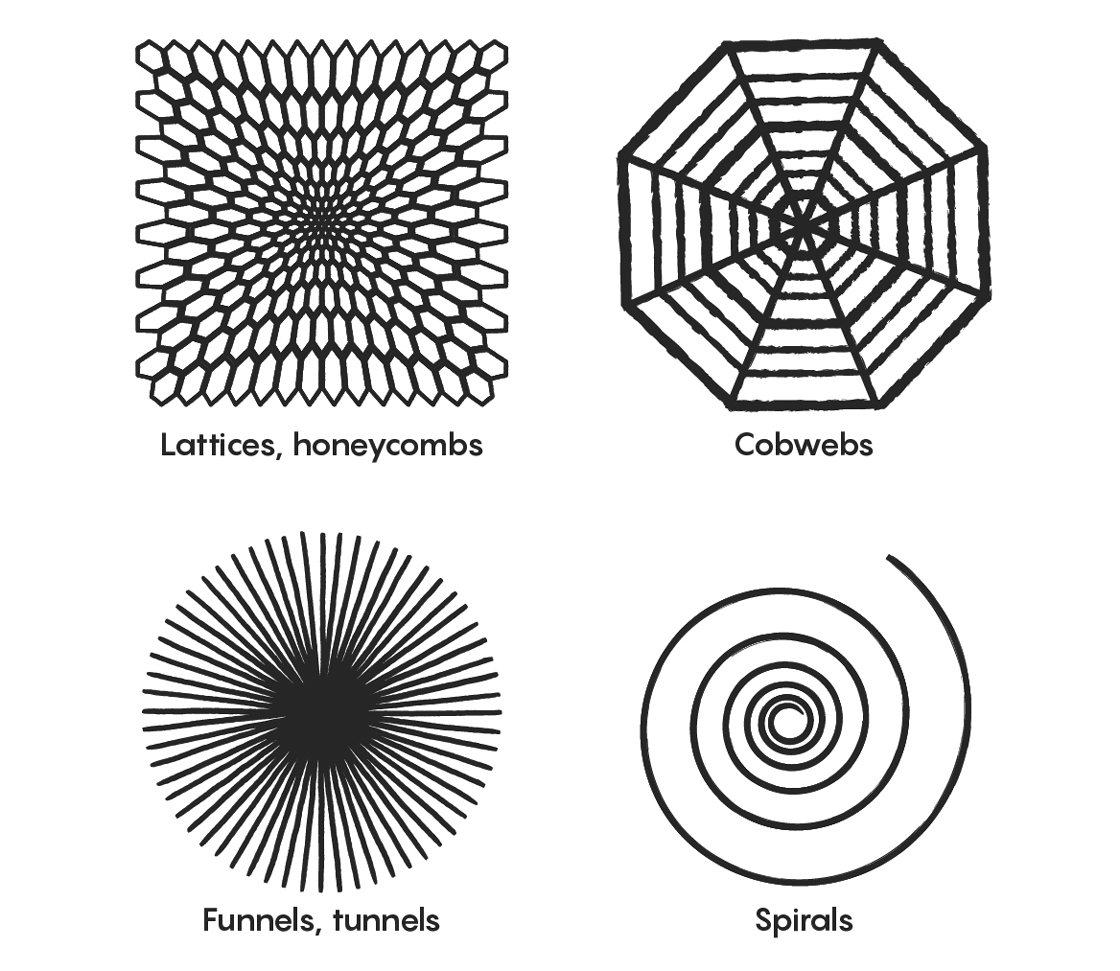
Heinrich Klüver classified the shapes he saw while under the influence of hallucinogenic drugs into four categories, known as “form constants.” Credit: Lucy Reading-Ikkanda / Quanta Magazine.
An emerging hypothesis points to a variation of the mechanism that produces so-called “Turing patterns.” In a 1952 paper, the British mathematician and code-breaker Alan Turing proposed a mathematical mechanism for generating many of the repeating patterns commonly seen in biology — the stripes of tigers or zebra fish, for example, or a leopard’s spots. Scientists have known for some time that the classic Turing mechanism probably can’t occur in a system as noisy and complicated as the brain. But a collaborator of Cowan’s, the physicist Nigel Goldenfeld of the University of Illinois, Urbana-Champaign, has proposed a twist on the original idea that factors in noise. Experimental evidence reported in two recent papers has bolstered the theory that this “stochastic Turing mechanism” is behind the geometric form constants people see when they hallucinate.
Sweaty Grasshoppers
Images we “see” are essentially the patterns of excited neurons in the visual cortex. Light reflecting off the objects in our field of view enters the eye and comes to a focus on the retina, which is lined with photoreceptor cells that convert that light into electrochemical signals. These signals travel to the brain and stimulate neurons in the visual cortex in patterns that, under normal circumstances, mimic the patterns of light reflecting off objects in your field of view. But sometimes patterns can arise spontaneously from the random firing of neurons in the cortex — internal background noise, as opposed to external stimuli — or when a psychoactive drug or other influencing factor disrupts normal brain function and boosts the random firing of neurons. This is believed to be what happens when we hallucinate.
But why do we see the particular shapes that Klüver so meticulously classified? The widely accepted explanation proposed by Cowan, Ermentrout and their collaborators is that these patterns result from how the visual field is represented in the first visual area of the visual cortex. “If you opened up someone’s head and looked at the activity of the nerve cells, you would not see an image of the world as through a lens,” said Peter Thomas, a collaborator of Cowan’s who is now at Case Western Reserve University. Instead, Thomas explained, the image undergoes a transformation of coordinates as it is mapped onto the cortex. If neuronal activity takes the form of alternating stripes of firing and non-firing neurons, you perceive different things depending on the stripes’ orientation. You see concentric rings if the stripes are oriented one way. You see rays or funnel shapes emanating from a central point — the proverbial light at the end of the tunnel common in near-death experiences — if the stripes are perpendicular to that. And you see spiral patterns if the stripes have a diagonal orientation.
But if geometric visual hallucinations like Klüver’s form constants are a direct consequence of neural activity in the visual cortex, the question is why this activity spontaneously occurs — and why, in that case, it doesn’t cause us to hallucinate all the time. The stochastic Turing mechanism potentially addresses both questions.
Alan Turing’s original paper suggested that patterns like spots result from the interactions between two chemicals spreading through a system. Instead of diffusing evenly like a gas in a room until the density is uniform throughout, the two chemicals diffuse at different rates, which causes them to form distinct patches with differing chemical compositions. One of the chemicals serves as an activator that expresses a unique characteristic, such as the pigmentation of a spot or stripe, while the other acts as an inhibitor, disrupting the activator’s expression. Imagine, for example, a field of dry grass dotted with grasshoppers. If you start a fire at several random points, with no moisture present, the entire field will burn. But if the heat from the flames causes the fleeing grasshoppers to sweat, and that sweat dampens the grass around them, you’ll be left with periodic spots of unburned grass throughout the otherwise charred field. This fanciful analogy, invented by the mathematical biologist James Murray, illustrates the classic Turing mechanism.
Turing acknowledged that this was a greatly simplified toy model for how actual patterns arise, and he never applied it to a real biological problem. But it offers a framework to build on. In the case of the brain, Cowan and Ermentrout pointed out in their 1979 paper that neurons can be described as activators or inhibitors. Activator neurons encourage nearby cells to also fire, amplifying electrical signals, while inhibitory neurons shut down their nearest neighbors, dampening signals. The researchers noticed that activator neurons in the visual cortex were mostly connected to nearby activator neurons, while inhibitory neurons tended to connect to inhibitory neurons farther away, forming a wider network. This is reminiscent of the two different chemical diffusion rates required in the classic Turing mechanism, and in theory, it could spontaneously give rise to stripes or spots of active neurons scattered throughout a sea of low neuronal activity. These stripes or spots, depending on their orientation, could be what generates perceptions of lattices, tunnels, spirals and cobwebs.
While Cowan recognized that there could be some kind of Turing mechanism at work in the visual cortex, his model didn’t account for noise — the random, bursty firing of neurons — which seemed likely to interfere with the formation of Turing patterns. Meanwhile, Goldenfeld and other researchers had been applying Turing’s ideas in ecology, as a model for predator-prey dynamics. In that scenario, the prey serve as activators, seeking to reproduce and increase their numbers, while predators serve as inhibitors, keeping the prey population in check with their kills. Thus, together they form Turing-like spatial patterns. Goldenfeld was studying how random fluctuations in predator and prey populations affect these patterns. He knew about Cowan’s work in neuroscience and soon realized his insights could apply there as well.
Houses With Eyes and Jaws
A condensed matter physicist by training, Goldenfeld gravitates toward interdisciplinary research, applying concepts and techniques from physics and math to biology and evolutionary ecology. Roughly 10 years ago, he and his then graduate student Tom Butler were pondering how the spatial distribution of predators and prey changes in response to random local fluctuations in their populations, for instance if a herd of sheep is attacked by wolves. Goldenfeld and Butler found that when a herd’s population is relatively low, random fluctuations can have big effects, even leading to extinction. It became clear that ecological models need to take random fluctuations into account rather than just describe the average behavior of populations. “Once I knew how to do the fluctuation calculation for pattern formation,” Goldenfeld said, “it was an obvious next step to apply this to the hallucination problem.”
In the brain, it’s the number of neurons that are on or off that randomly fluctuates rather than sheep and wolf populations. If an activator neuron randomly switches on, it can cause other nearby neurons to also switch on. Conversely, when an inhibitory neuron randomly switches on, it causes nearby neurons to switch off. Because the connections between inhibitory neurons are long-range, any inhibitory signals that randomly arise spread faster than random excitatory signals — exactly what’s needed for a Turing-like mechanism. Goldenfeld’s models suggested that stripes of active and inactive neurons will form in a Turing-like pattern. He dubbed these stochastic Turing patterns.
However, to function properly, the visual cortex must be primarily driven by external stimuli, not by its own internal noisy fluctuations. What keeps stochastic Turing patterns from constantly forming and causing us to constantly hallucinate? Goldenfeld and colleagues argue that even though the firing of neurons can be random, their connections are not. Whereas short-range connections between excitatory neurons are common, long-range connections between inhibitory neurons are sparse, and Goldenfeld thinks this helps suppress the spread of random signals. He and his cohorts tested this hypothesis by creating two separate neural network models. One was based on the actual wiring of the visual cortex, and the other was a generic network with random connections. In the generic model, normal visual function was substantially degraded because the random firing of neurons served to amplify the Turing effect. “A generically wired visual cortex would be contaminated by hallucinations,” Goldenfeld said. In the realistic model of the cortex, however, internal noise was effectively dampened. 
Nigel Goldenfeld, a physicist at the University of Illinois, Urbana-Champaign, hypothesizes that the stochastic Turing mechanism underlies visual hallucinations. Credit: Seth Lowe for Quanta Magazine.
Goldenfeld suggests that evolution has selected for a particular network structure that inhibits hallucinatory patterns: The sparseness of connections between inhibitory neurons prevents inhibitory signals from traveling long distances, disrupting the stochastic Turing mechanism and the perception of funnels, cobwebs, spirals and so forth. The dominant patterns that spread through the network will be based on external stimuli — a very good thing for survival, since you want to be able to spot a snake and not be distracted by a pretty spiral shape.
“If the cortex had been built with these long-range inhibitory connections all over the place, then the tendency to form these patterns would be stronger than the tendency to process the visual input coming in. It would be a disaster and we would never have survived,” Thomas said. Because long-range inhibitory connections are sparse, “the models don’t produce spontaneous patterns unless you force them to, by simulating the effects of hallucinogenic drugs.”
Experiments have shown that hallucinogens like LSD appear to disrupt the normal filtering mechanisms the brain employs, perhaps boosting long-range inhibitory connections and therefore permitting random signals to amplify in a stochastic Turing effect.
Goldenfeld and collaborators have not yet tested their theory of visual hallucinations experimentally, but hard evidence that stochastic Turing patterns do arise in biological systems has emerged in the last few years. Around 2010, Goldenfeld heard about work done by Ronald Weiss, a synthetic biologist at the Massachusetts Institute of Technology who had been struggling for years to find the appropriate theoretical framework to explain some intriguing experimental results.
Years earlier, Weiss and his team had grown bacterial biofilms that were genetically engineered to express one of two different signaling molecules. In an effort to demonstrate the growth of a classic Turing pattern, they tagged the signaling molecules with fluorescent markers so that the activators glowed red and the inhibitors glowed green. Although the experiment started out with a homogenous biofilm, over time a Turing-like pattern emerged, with red polka dots scattered throughout a swath of green. However, the red dots were much more haphazardly located than, say, leopards’ spots. Additional experiments also failed to yield the desired results.
When Goldenfeld heard about these experiments, he suspected that Weiss’ data could be viewed from a stochastic point of view. “Rather than trying to make the patterns more regular and less noisy,” Weiss said, “we realized through our collaboration with Nigel that these are really stochastic Turing patterns.” Weiss, Goldenfeld and collaborators finally published their paper in the Proceedings of the National Academy of Sciences last month, 17 years after the research began.
The biofilms formed stochastic Turing patterns because gene expression is a noisy process. According to Joel Stavans of the Weizmann Institute of Science in Israel, that noise is responsible for disparities among cells, which can have the same genetic information yet behave differently. In recently published work, Stavans and his colleagues investigated how noise in gene expression can lead to stochastic Turing patterns in cyanobacteria, ancient organisms that produce a large proportion of the oxygen on Earth. The researchers studied Anabaena, a type of cyanobacteria with a simple structure of cells attached to one another in a long train. An Anabaena’s cells can specialize to perform one of two activities: photosynthesis, or converting nitrogen in the atmosphere into proteins. An Anabaena might have, for instance, one nitrogen-fixing cell, then 10 or 15 photosynthesis cells, then another nitrogen-fixing cell, and so on, in what appears to be a stochastic Turing pattern. The activator, in this case, is a protein that creates a positive feedback loop to produce more such proteins. At the same time, the protein may also produce other proteins that diffuse to neighboring cells and inhibit the first protein’s production. This is the primary feature of a Turing mechanism: an activator and an inhibitor fighting against each other. In Anabaena, noise drives the competition.
Researchers say the fact that stochastic Turing processes appear to be at work in these two biological contexts adds plausibility to the theory that the same mechanism occurs in the visual cortex. The findings also demonstrate how noise plays a pivotal role in biological organisms. “There is not a direct correlation between how we program computers” and how biological systems work, Weiss said. “Biology requires different frameworks and design principles. Noise is one of them.”
There is still much more to understand about hallucinations. Jean-Paul Sartre experimented with mescaline in Paris in 1935 and found it distorted his visual perception for weeks. Houses appeared to have “leering faces, all eyes and jaws,” clock faces looked like owls, and he saw crabs following him around all the time. These are much higher-level hallucinations than Klüver’s simple form constants. “The early stages of visual hallucination are very simple — these geometric patterns,” Ermentrout said. But when higher cognitive functions kick in, such as memory, he said, “you start to see more complex hallucinations and you try and make sense of them. I believe that all you’re seeing is the spontaneous emergence of [stored memories] as the higher brain areas become more excited.”
Back in the ’20s, Klüver also worked with subjects who reported tactile hallucinations, such as cobwebs crawling across their skin. Ermentrout thinks this is consistent with a cobweb-like form constant mapped onto the somatosensory cortex. Similar processes might play out in the auditory cortex, which could account not only for auditory hallucinations but for phenomena like tinnitus. Cowan agrees, noting that the brain has similar wiring throughout, so if a theory of hallucinations “works for vision, it’s going to work for all the other senses.”
Jennifer Ouellette is a freelance writer and an author of popular science books, including “Me, Myself, and Why: Searching for the Science of Self.”
How is paranoid personality disorder treated?
People with PPD often do not seek treatment on their own because they do not see themselves as having a problem. The distrust of others felt by people with PPD also poses a challenge for health care professionals because trust is an important factor of psychotherapy (a form of counseling). As a result, many people with PPD do not follow their treatment plan and may even question the motives of the therapist.
When a patient seeks treatment for PPD, psychotherapy is the treatment of choice. Treatment likely will focus on increasing general coping skills, especially trust and empathy, as well as on improving social interaction, communication, and self-esteem.
Medication generally is not used to treat PPD. However, medications—such as anti-anxiety, antidepressant, or anti-psychotic drugs—might be prescribed if the person’s symptoms are extreme, or if he or she also suffers from an associated psychological problem, such as anxiety or depression.
What are the complications of paranoid personality disorder?
The thinking and behaviors associated with PPD can interfere with a person’s ability to form and maintain relationships, as well as their ability to function socially and in work situations. In many cases, people with PPD become involved in legal battles, suing people or companies they believe are “out to get them.”Previous: Diagnosis and TestsNext: Prevention
Comment This is a catch all for anyone criticising the state and its public services. It is incredibly convenient in an age where so many are apparently , for no specific reason, labelled mentally ill. R.J Cook
WHAT YOU NEED TO KNOW:
What is paranoid personality disorder? Posted November 19th 2020
Paranoid personality disorder (PPD) is a long-term, mental health condition. PPD causes you to be suspicious, distrusting, and hostile toward others. This is because you think they want to hurt you or take advantage of you. You may have trouble trusting or getting along with others. These thoughts and behaviors can cause problems with your relationships and daily activities.
What causes PPD?
The cause may not be known. Your risk for PPD is increased if you have a family history of the disorder. You are also at risk if you were abused or neglected as a child.
What are the symptoms of PPD?
- You think other people will harm, trick, or take advantage of you
- You think that your friends might not be loyal. You may think about how they have let you down. You may search for proof that they cannot be trusted.
- You are nervous about talking to other people because you are afraid they will use the information against you.
- You often hold grudges against people who you believe have done something bad to you. You believe that the actions were done to hurt you, and you cannot forgive the people who did them. You may see people as your enemies, and want to get back at them.
- You think that others are trying to insult you. You may hear a person say one thing, but you think that they mean something else.
- You suspect that your partner has been unfaithful.
- You think that certain people are trying to make you look bad to others. You may react by getting angry or attacking them back. You may also believe that your reputation is being threatened.
What other behaviors might I have with PPD?
- Depression
- Obsessive-compulsive disorder
- Agoraphobia
- Alcohol or substance abuse
How is PPD diagnosed?
Your healthcare provider will ask about your history and if you want to hurt yourself or others. He will ask about your behaviors, feelings, and relationships with others.
How is PPD treated?
Medicines can help decrease anxiety or depression and make you feel more stable.
How can I manage my symptoms?
Go to individual or group therapy. You may need any of the following types of therapy:
- Supportive psychotherapy helps you understand your behaviors and actions. This can help you cope with your disorder so you can have positive relationships.
- Family therapy helps you and your family communicate and teaches your family how they can best support you.
When should I contact my healthcare provider?
- You are depressed.
- You feel anxious or worried.
- You do not want to leave your house.
- You begin to drink alcohol, or you drink more than usual.
- You take illegal drugs.
- You take medicines that are not prescribed to you.
- You have questions or concerns about your condition or care.
When should I seek immediate care or call 911?
- You have severe depression.
- You want to hurt yourself or others.
Care Agreement
You have the right to help plan your care. Learn about your health condition and how it may be treated. Discuss treatment options with your healthcare providers to decide what care you want to receive. You always have the right to refuse treatment. The above information is an educational aid only. It is not intended as medical advice for individual conditions or treatments. Talk to your doctor, nurse or pharmacist before following any medical regimen to see if it is safe and effective for you.
© Copyright IBM Corporation 2020 Information is for End User’s use only and may not be sold, redistributed or otherwise used for commercial purposes. All illustrations and images included in CareNotes® are the copyrighted property of A.D.A.M., Inc. or IBM Watson Health
Brain Fog November 14th 2020
Mental fog is often described as a “cloudy-headed” feeling.
Common conditions of brain fog include poor memory, difficulty focusing or concentrating, and struggling with articulation.
Imagine if you could concentrate your brain power into one bright beam and focus it like a laser on whatever you wish to accomplish.
Many people struggle to concentrate. And when you can’t concentrate, everything you do is harder and takes longer than you’d like.
Give Up the Clutter
Mess creates stress.
There’s a strong link between your physical space and your mental space.
Clutter is bad for your mind and health. It can create long-term, low-level anxiety.
When the book, The Life-Changing Magic of Tidying Up: The Japanese Art of Decluttering and Organizing, by Marie Kondo became a best-seller, it wasn’t too surprising.
We are all looking for ways to create more meaningful lives with less to distract us.
Get rid of clutter at your office, on your desk, in your room, and you will send a clear message of calm directly to your brain.
Start decluttering today in small, focused bursts. You’re not going to clean up your entire space in a day, so start small to make it a daily habit that sticks.
Set yourself up for success by making a plan and targeting specific areas you’re going to declutter, clean up, and organize over a prolonged period of time.
Multi-Tasking Doesn’t Work
The ability to multi-task is a false badge of honor.
Task switching has a severe cost.
Your concentration suffers when you multitask.
It compromises how much actual time you spend doing productive work, because you’re continually unloading and reloading the hippocampus/short term memory.
Research shows that task switching actually burns more calories and fatigues your brain – reducing your overall capacity for productive thought and work.
Commit to completing one task at a time.
Remove potential distractions (like silencing your mobile, turning off email alerts) before you start deep work to avoid the temptation to switch between tasks.
Use the 3-to-1 method!
Narrow down your most important tasks to 3, and then give one task your undivided attention for a period of time.
Allow yourself to rotate between the three, giving yourself a good balance of singular focus and variety.
Give Up the Urgent Distraction
Disconnect. Your productivity, creativity and next big idea depends on it.
Urgency wrecks productivity. Urgent but unimportant tasks are major distractions.
Last-minute distractions are not necessarily priorities.
Sometimes important tasks stare you right in the face, but you neglect them and respond to urgent but unimportant things.
You need to reverse that. It’s one the only ways to master your time.
Your ability to distinguish urgent and important tasks has a lot to do with your success.
Important tasks are things that contribute to your long-term mission, values, and goals. Separating these differences is simple enough to do once, but doing so continually can be tough.
Stop Feeding Your Comfort
Comfort provides a state of mental security.
When you’re comfortable and life is good, your brain can release chemicals like dopamine and serotonin, which lead to happy feelings.
But in the long-term, comfort is bad for your brain.
Without mental stimulation dendrites, connections between brain neurons that keep information flowing, shrink or disappear altogether.
An active life increases dendrite networks and also increase the brain’s regenerating capacity, known as plasticity.
“Neglect of intense learning leads plasticity systems to waste away,” says Norman Doidge in his book, The Brain That Changes Itself.
Michael Merzenich, a pioneer of plasticity research, and author of Soft-wired: How the New Science of Brain Plasticity Can Change Your Life says that going beyond the familiar is essential to brain health.
“It’s the willingness to leave the comfort zone that is the key to keeping the brain new,” he says.
Seeking new experiences, learning new skills, and opening the door to new ideas inspire us and educate us in a way improves mental clarity.
Don’t Sit Still
Sitting still all day, every day, is dangerous.
Love it or hate it, physical activity can have potent effects on your brain and mood.
The brain is often described as being “like a muscle”. Its needs to be exercised for better performance.
Research shows that moving your body can improve your cognitive function.
30–45 minutes of brisk walking, three times a week, can help fend off the mental wear and tear.
What you do with your body impinges on your mental faculties.
Find something you enjoy, then get up and do it. And most importantly, make it a habit.
Stop Consuming Media and Start Creating Instead
It’s extremely easy to consume content.
You are passive. Even relaxed.
But for each piece of unlimited content you consume, it stops a piece of content you could have created.
Limit your mass media consumption.
Embrace the creation habit.
Start paying attention to the noise that you let seep into your eyes and ears.
Ask, Is this benefitting my life in any way?
Does all this information make me more prone to act?
Does it really make me more efficient? Does it move me forward in any significant way?
Let creation determine consumption.
Allow curiosity to lead you to discover and pursue something you deepy care about. Make time to create something unique.
The point is to get lost in awe and wonder like you did when you were a child. When you achieve that feeling from a certain activity, keep doing it!
Share your authentic self with the rest of us.
Thomas Oppong is the founder of AllTopStartups and writes on science-based answers to problems in life about creativity, productivity, and self-improvement.
The Amazing Psychology of Japanese Train Stations
The nation’s famed mastery of rail travel has been aided by some subtle behavioral tricks. Posted November 10th 2020
- Allan Richarz
Read when you’ve got time to spare.
Passengers line up for a bullet train at a platform in Tokyo Station. Photo by Yuya Shino/Reuters
It is a scene that plays out each weekday morning across Tokyo. Suit-clad office workers, gaggles of schoolchildren, and other travelers gamely wend their way through the city’s sprawling rail stations.
To the casual observer, it is chaos; commuters packed shoulder-to-shoulder amid the constant clatter of arriving and departing trains. But a closer look reveals something more beneath the surface: A station may be packed, yet commuters move smoothly along concourses and platforms. Platforms are a whirl of noisy activity, yet trains maintain remarkable on-time performance. Indeed, the staggering punctuality of the Japanese rail system occasionally becomes the focus of international headlines—as on May 11, when West Japan Railways issued a florid apology after one of its commuter trains left the station 25 seconds early.
Tokyo is home to the world’s busiest train stations, with the capital’s rail operators handling a combined 13 billion passenger trips annually. Ridership of that volume requires a deft blend of engineering, planning, and psychology. Beneath the bustle, unobtrusive features are designed to unconsciously manipulate passenger behavior, via light, sound, and other means. Japan’s boundless creativity in this realm reflects the deep consideration given to public transportation in the country.
Passengers wait for a train at a platform of a station in Kawasaki. Photo by Kim Kyung-Hoon/Reuters
Rail stations, whether in Japan or elsewhere, are also great places to see “nudge theory” at work. Pioneered by behavioral economist Richard Thaler, who was awarded the 2017 Nobel Memorial Prize for his work, and Harvard Law School professor Cass Sunstein, the theory posits that gentle nudges can subtly influence people towards decisions in their own (or society’s) best interests, such as signing up for private pension schemes or organ donation. In the U.K., there’s a government office devoted to the idea, the Behavioural Insights Team (or “nudge unit”), and their work often shows up in the transit realm.
In 2016, for instance, London Underground operator Transport for London partnered with the behavioral science department at the London School of Economics to develop ways of encouraging riders to queue on both sides of station escalators as a means of increasing their capacity in the capital’s Holborn Station. Among other measures, simple hand and footprints were also painted on each side of the “up” escalators. In Australia, researchers conducted an experiment with lighted directional arrows on signposts to improve flows of departing passengers. Using a camera system designed to recognize and distinguish brisk-walking businesspeople from dawdling tourists, for example—green arrows would flash to direct commuters in an efficient route towards the exit.
When it come to passenger manipulation, what sets the stations of Japan apart from their counterparts is both the ingenuity behind their nudges and the imperceptible manner in which they are implemented. Japan’s nudges reflect a higher order of thinking. The orderliness of society is taken as a given—Japanese commuters know how to queue on an escalator and can easily navigate the confusing, but wide-open, spaces of Tokyo’s rail stations without assistance. This allows rail operators to instead focus on deeper psychological manipulation.
The Ultimate in Mood Lighting
Japan has one of the highest suicide rates among OECD nations, and often, those taking their own lives do so by leaping from station platforms into the path of oncoming trains, with Japan averaging one such instance each day. It is a brutal, disruptive end that can also wreak havoc across the transit system.
To address the issue, stations across Tokyo and the rest of Japan installed chest-high barriers as a means of preventing suicide attempts. But platform barriers are expensive, and about 70 percent of Japan’s largest and most-travelled stations do not have the platform space or structural strength to accommodate them. While there are hopes to have platform barriers installed in all 243 of Tokyo’s train stations by 2032 (at a cost of $4.7 billion), rail operators in the interim have come up alternative approaches.
Standing at either end of a platform in Tokyo’s labyrinthine Shinjuku Station, one might detect a small square LED panel emitting a pleasant, deep-blue glow. Nestled among vending machines and safety posters, the panel might be dismissed as a bug zapper. But these simple blue panels are designed to save lives. 
A blue-light panel in a Japanese train station, designed to calm agitated passengers. Photo by Allan Richaz/CityLab
Operating on the theory that exposure to blue light has a calming effect on one’s mood, rail stations in Japan began installing these LED panels as a suicide-prevention measure in 2009. They are strategically located at the ends of each platform—typically the most-isolated and least-trafficked area, and accordingly, the point from which most platform jumps occur. Some stations, such as Shin-Koiwa Station in Tokyo, bolster their LED regime with colored roof panels, allowing blue-tinted sunlight to filter down on to platforms.
It is an approach that has proven to be surprisingly effective. According to a study by researchers at the University of Tokyo published in the Journal of Affective Disorders in 2013, data analyzed over a 10-year period shows an 84 percent decline in the number of suicide attempts at stations where blue lights are installed. A subsequent study revealed no corresponding increase in suicide attempts at neighboring stations lacking such lights.
The idea has been picked up in the U.K.: Several stations in England now emulate the Japanese approach, with blue LED light panels on station platforms.
A Song for a More Peaceful Departure
Commuting during rush hour in Japan is not for the faint of heart. The trains are jam-packed at as much as 200 percent capacity during the height of rush hour, and razor-thin connection times to transfer from one train to another leave little margin for error. Compounding the stressful nature of the commute in years past was the nerve-grating tone—a harsh buzzer used to signal a train’s imminent departure. The departing train buzzer was punctuated by sharp blasts of station attendants’ whistles, as harried salarymen raced down stairs and across platforms to beat the train’s closing doors.
To calm this stressful audio environment, in 1989 the major rail operator JR East commissioned Yamaha and composer Hiroaki Ide to create hassha melodies—short, ear-pleasing jingles to replace the traditional departure buzzer.
Also known as departure or train melodies, hassha tunes are brief, calming and distinct; their aim is to notify commuters of a train’s imminent departure without inducing anxiety. To that end, most melodies are composed to an optimal length of 7 seconds, owing to research showing that shorter-duration melodies work best at reducing passenger stress and rushing incidents, as well as taking into account the time needed for a train to arrive and depart.
The tunes feature whimsical titles like “Seaside Boulevard” and range from the wistful to the jaunty. Most stations have their own melodies, forming de facto theme songs that become part of a station’s identity. Tokyo’s Ebisu Station, for example, is known for its departure melody—a short, stylized version of the theme from The Third Man.
As more stations have added melodies over the years, the original thesis has proven correct. A study conducted in October 2008 at Tokyo Station, for instance, found a 25 percent reduction in the number of passenger injuries attributable to rushing after the introduction of hassha melodies on certain platforms.
The use of these jingles is not without controversy, however. Shortly after their introduction, residents living near open-air rail stations, weary of hearing endless repetitions of the same jingles all day, complained of noise pollution.
Teenager-Be-Gone
Despite, or perhaps because of, its reputation as a remarkably safe country, Japan is nonetheless vigilant in combatting youth delinquency. Train stations are particularly sensitive in that regard, since large congregations of young people pass through stations at all hours of the day.
To address the Japanese fear of loitering and vandalism by young riders, some train stations deploy ultrasonic deterrents—small, unobtrusive devices that emit a high-frequency tone. The particular frequency used—17 kilohertz*—can generally only be heard by those under the age of 25. (Older people can’t detect such frequencies, thanks to the age-related hearing loss known as presbycusis.) These devices—the brainchild of a Welsh inventor and also used to fend off loitering teens in the U.S. and Europe—have been enthusiastically adopted in Japan.
Standing outside one of Tokyo Station’s numerous exits on a recent summer day, it was easy to see the effectiveness of this deterrent in action. Weary salarymen and aged obaachan passed under the sonic deterrent without changing pace. Among uniform-clad students, however, the reactions were evident—a suddenly quickened pace, a look of confusion or discomfort, and often a cry of urusai! (Loud!) None appeared to connect the noise to the deterrents placed almost flush in the ceiling panels above.
Pointing the Best Way Forward
Rail employees are not exempt from the behavioral hacks of their employers. Perhaps most famously, Japanese train conductors, drivers, and platform attendants are mandated to use the “point and call” method—called shisa kanko—in executing tasks. By physically pointing at an object, and then verbalizing one’s intended action, a greater portion of the brain is engaged, providing improved situational awareness and accuracy. Studies have repeatedly shown that this technique reduces human error by as much as 85 percent. Pointing-and-calling is now a major workplace safety feature in industries throughout Japan.
So, why don’t train workers everywhere do this? Like so many aspects of Japanese transit culture, shisa kanko has proved resistant to export (though pointing-and-calling has been adopted in modified form by New York City’s transit authority). In this, as in so many things, Japan’s rail system stands largely alone.
Allan Richarz is a privacy lawyer and writer based in Tokyo, Japan.
More from CityLab
- The Future of Air Travel ‘Will Be as Enjoyable as Open-Heart Surgery’240 saves
- BMW & Co Are Losing Their Allure and That’s Got Germany Worried55 saves
- Boeing Copies Flying Geese to Save Fuel268 saves
‘It Feels Like a Derangement’: Menopause, Depression, & Me
Estrogen is more powerful and more wide-ranging than is assumed, and its removal or diminishment brings effects ludicrously understated by “the change.” Posted November 9th 2020
- Rose George
Read when you’ve got time to spare.
Vilhelm Hammershøi: Rest, 1905. Credit: René-Gabriel Ojéda / Google Arts & Culture.
Menopause: the ceasing of menstruation or the period in a woman’s life (typically between forty-five and fifty-five).
I stare stupidly at it. It’s nothing much to look at. It’s only a small pile of clothing: the shorts and tank top that I wear in bed, which I have thrown onto the floor before getting into the shower. I stare stupidly at the clump because I can’t pick it up. It’s astonishing I managed to shower, because I know already that this is a bad day, one when I feel assaulted by my hormones, which I picture as small pilots in those huge Star Wars armored beasts that turn me this way and that, implacable. On this morning, I wake up with fear in my stomach—fear of nothing—and I know it will be a bad day.
For a while, I thought I could predict these days. I have had practice. This is my second menopause: the first was chemically induced seven years ago to treat my endometriosis, a condition that has riddled my insides with adhesions of endometrial tissue, and stuck my organs together. The adhesions are exacerbated by estrogen; the drug switched it off. (The same drug can block other hormones and is also used to treat pedophilia and prostate cancer.) I hated that menopause; it was a crash off a cliff into sudden insomnia and depression and a complete eradication of sexual desire. “The symptoms will last six months,” said the male ob-gyn, with a voice he thought was kind but that sounded only casual. They lasted far longer. The nurse giving me the first injection said, “He keeps prescribing this stuff, but women hate it.”
This menopause is the natural one. I’m two years in. It doesn’t feel natural. It feels like a derangement. With each menopause, I have chosen to take hormone replacement therapy (HRT). The first time because I wanted my sleep back. This time because I spent a year researching menopause for a magazine article, and because I have weighed the risks and judged them acceptable, and because I know what happened last time, when I was broken. The two occasions when I asked for HRT are the only two on which I have cried in a doctor’s office.
Every Wednesday and Saturday, I take two 100mg transdermal patches of estradiol (a form of estrogen). I fix them to my abdomen, swapping sides each time. They never fall off, though I go running for hours at a time and sweat. This is the maximum dose of estrogen, and it took about a year for me to understand I needed this amount, a year of peeling skin, sore tendons, poor sleep, awful sadness, inexplicable weeping, and various other “symptoms” of menopause that you can find listed if you look beyond the hot flashes and insomnia. (I don’t know why Americans say “flash” instead of “flush”; I prefer the British-English word, less fleeting than a flash, a better fit for that rise in temperature, violently sudden and overwhelming, that makes you feel as if you had never been cool or would be again.) Estrogen is more powerful and more wide-ranging than is assumed, and its removal or diminishment brings effects ludicrously understated by “the change.”
A friend gave me access to her university library and I start to swim among papers, sometimes floundering. I learn that estrogen is a gonadal steroid produced by the ovaries and essential to female reproduction. It is a sex hormone but—it is now known—far more besides. There are receptors for estrogen all over the body. In the brain, the densest amounts are in the amygdala, the hippocampus, and the hypothalamus. Estrogen influences serotonin, dopamine, glutamate, and noradrenaline. It is involved in cognitive function. Its diminishment can impair verbal dexterity, memory, and clarity of thought. Recently, scientists discovered that estrogen is also produced in the adrenal glands, breasts, adipose tissue, and brain. This is astonishing. But so is the extent of the unknown.
Peri-menopausal women (whose periods may be irregular, who have symptoms, but who are not yet post-menopausal) are twice as likely to have depressive symptoms or depression than pre-menopausal women. Peri-menopausal women who were vulnerable to depression during the menstrual cycle are more susceptible to depression when they enter menopause or its hinterlands. This is accepted, but there is disagreement about how to fix it. Antidepressants often don’t work. Studies show both success and failure when women are given estrogen to counter depression. Controversy exists over whether the menopausal transition is a risk factor for the development of depression, I read. And, I think, the person who wrote that has probably never been on a menopause forum, where women’s stories and pain would make me weep, if I didn’t feel like weeping already, from menopause.
Because I have a womb—though it is likely of no use for fertility, thanks to the endometriosis—I also take progesterone for ten days a month. This induces the womb to shed its endometrium, which may otherwise thicken to cancer-risky proportions. So I still bleed, and choose to. I knew from my research that the gentlest version of progesterone is micronized, something that my doctor had to look up. I didn’t know that taking it orally, as I had for many months, would bring me profound sadness, fatigue, weight gain, awfulness. That wasn’t something I discovered in my research, and no one told me.
I can’t pick up the clothes. I can’t explain the granite of that “can’t” to anyone else, the way it feels impossible to beat. Look at me looking at the pile and you will think, Just pick it up. For fuck’s sake. But I don’t. I look at it, and the thought of accomplishing anything makes my fear and despair grow. Every thought brings on another and that prospect is frightening. All those thoughts. I write that down and I feel stupid and maudlin and dramatic. A privileged freelance writer who does not have a full-time job that requires her presence in an office and can be indulgent of what the medical profession calls “low moods.” In fact, plenty of menopausal women leave their jobs, endure wrecked relationships, suffer, and cope. Or don’t. But I don’t feel maudlin and dramatic in the bathroom, or on any other of a hundred occasions over the past two years. I feel terrified. I have no reason to feel fear. But my body acts as though I do: the blood rushing from my gut to my limbs in case I need to flee, leaving the fluttering emptiness that is called “butterflies,” though that is too pretty a description.
Still, I set off on my bicycle to my writing studio. I hope I can overcome the day. I always hope, and I am always wrong. A few hours later, I find myself cowering in my workspace, a studio I rent in a complex of artists’ studios, scared to go downstairs to the kitchen because I can’t bear to talk to anyone I might find there. I have done nothing of use all day. Every now and then, I stop doing nothing and put my head in my hands because it feels safe and comfortable, like a refuge. I look underneath my desk and think I might sit there. There is no logic to this except that it is out of sight of the door and no one will find me.
Even so, when the phone rings I answer it. I shouldn’t, but I am hopeful that I can manage it and mask it, and I haven’t spoken to my mother for a few days and would like to. It goes well for a few minutes, because I’m not doing the talking. Then she asks me whether I want to accompany her to a posh dinner, several weeks hence. She doesn’t understand when I ask to be given some time to think about it. “Why can’t you decide now?” I say it’s one of the bad days, but I know this is a mixed message: If it’s that bad, how am I talking on the phone and sounding all right? Because I am a duck: talking serenely above, churning below, the weight on my chest, the catch in my throat, the inexplicable distress. I try to explain but I’m also trying hard not to weep, and so I explain it badly.
She doesn’t understand. This is not her fault. She is a compassionate woman, but she had an easy menopause, so easy that she can say, “Oh, I barely remember it.” One of those women: the lucky ones. She doesn’t understand depression, though both her children experience it, because she has never had it. “But you sounded well,” she says, “I thought you were all right.” Now she says, “I don’t understand how your not being well is stopping you deciding whether you want to go to dinner.” Because it is a decision, and a decision is too hard, requiring many things to happen in my brain and my brain is too busy being filled with fear and panic and tears and black numbness. There is no room to spare.
I hang up because I can’t explain this. I stay there for a while, sitting on my couch, wondering how to face cycling home or leaving my studio or opening the door. All these actions seem equally impossible.
It takes a while but finally I set off. I know where I’m going. I have learned. On days like this, there are only two places to be. One is in my darkened bedroom with my cat lying next to me. On days like this, she takes care to lie closer to me than usual because she knows and because she loves me. Maybe my darkness has a smell.
The other place to be is in unconsciousness.
These are the safe places because everything is quiet. On days like this, I wonder if this is what autism feels like, when sensation is overwhelming. Not just noise, but thoughts, sights, all input. It is on the bad days that I realize what a cacophony of impressions we walk through every day, and how good we are at receiving and deflecting, as required. Every day, we filter and sieve; on the bad days, my filters fail.
I sometimes call these bridge days, after a footbridge near my studio that goes at a great height over the busy A64 road. On days like this, that bridge is a danger for me. I am not suicidal, but I have always had the urge to jump. This is a thing with a name. HPP: high places phenomenon. The French call it “l’appel du vide.” So very Sartre of them: the call of emptiness. The A64 is the opposite of emptiness, but still, it is a danger. Today I don’t have the filter that we must all have to function: the one that stops us stepping into traffic or fearing the cars or buses that can kill us at any time. The one that mutes the call of the HPP.
I avoid the bridge. I cycle home, trying not to rage at drivers who cut me off and ignore me. I have no room for rage along with everything else. Thoughts that would normally flow now snag. Every observation immediately triggers a negative thread, a spiral, and a worsening. On a good day, I can pass a child and a mother and think, How nice. Nothing more. Fleeting. Unimportant. On a bad day, I see the same and think of my own infertility, how I have surely disappointed my mother by not giving her grandchildren; how it is all too late, and what have I done with my life, and my book will be a failure and today is lost and I can’t afford to lose the time. It goes on and on. Snagging thoughts that drag me down, that are relentless.
When I get inside my house, I cry. I try to watch something or read, but nothing interests me. This is called anhedonia and is a symptom of depression: the forgetting how to take pleasure. The best thing to do is sleep away the day, as much as I can.
Toward evening, I begin to feel a faint foolishness. This is my sign. Embarrassment. Shame at the day and at my management of it. When I am able to feel that and see that, I am getting better. Now I manage to watch TV, though only foreign-language dramas. Without the filmmaking industries of northern Europe, my menopause would be even bleaker. Foreign words go somewhere shallower in the brain; they are less heavy. But soon I switch it off. I don’t care about the plot. I don’t care about anything. I take a sleeping pill to get the day over with, so the better next day can begin.
Twenty-four hours earlier, I had been wearing a Santa hat, running for five miles through icy bogs on a Yorkshire moor, happy to be doing that for fun, happy to be alive.
April 4. Sleep mostly OK; a few days of melatonin after stopping progesterone. Last night I was exhausted but slept badly. Mood difficult but not dreadful. Angry and irritated. No bleed after progesterone. Peeling skin. Weepy and panic now. Can I face people?
Depression, wrote William Styron, is a noun “with a bland tonality and lacking any magisterial presence, used indifferently to describe an economic decline or a rut in the ground, a true wimp of a word for such a major illness.” It was pioneered by a Swiss psychiatrist who, Styron thought, perhaps had a “tin ear” and “therefore was unaware of the semantic damage he had inflicted by offering ‘depression’ as a descriptive noun for such a dreadful and raging disease.”
Black dog. Walking through treacle. Low moods. Nothing I have read of depression has conveyed the crippling weight of it, that is a weight made out of nothing.
I do not have depression according to most authoritative clinical definitions of the condition. Depression is a long-term chronic illness. Mine is unpredictable, and before I got my HRT dose right, it lasted weeks at a time; but usually, these days, it lasts no more than twenty-four hours. My now-and-thens do not qualify as a disease. I do not count as depressed. Instead, I am one of the women of menopause, who struggle to understand why we feel such despair, why now we cry when before we didn’t, why understanding what is left and what is right takes a fraction longer than it used to: all this is “low mood” or “brain fog.” These diminishing phrases, which convey nothing of the force of the anguish or grief that assaults us, are reserved for women and usually relate to menstrual cycles or hormones.
I have never been sunny. People who can rise from their beds and see joy without working at it, they have always been a mystery. I still feel guilty for once asking a cheery person, cheery very early in the morning, why he was so happy—I made it sound like an accusation not praise—and I watched as his face fell and his warmth iced over. I’m still sorry. Cheeriness always seems like an enviable gift. I have always been susceptible to premenstrual upheaval: two days a month when things feel awful as though they have never been anything else. I endured them. Now and then, there have been therapists sometimes and antidepressants now and then, and, for the last few years, running, in whatever wilds I can find. The best therapy. I have managed.
Then I became what I am. A menopausal woman. In the eyes of evolution, that makes me a pointless person. I can no longer reproduce, if I ever could. The grandmother theory of menopause—that women live beyond their reproductive utility in order to care for grandchildren—doesn’t persuade me. Also, I have no grandchildren. I cannot account for how awful menopause can be, unless I think that we were not meant to survive it. A useless evolutionary blip.
Thursday 14. Removed old patch, added half a new one. Mood immediately plunged. Awful: anhedonia, anxiety, panic, weepiness. I still ran but stopped to cry in the middle. So sick of this, and I can’t work.
For months, I resisted HRT. I endured as my periods got erratic, as I lost my ability to sleep through the night, as my temperature rose furiously and intolerably at unpredictable moments, all the time. I had forgotten from the first time what it was like to stink, to carry around a fan, to wear so much black so the sweat didn’t show. I had forgotten what a hot flash—such an innocent phrase—felt like; what the night sweats—such an innocent phrase—felt like. I woke up in the night boiling hot and pouring sweat. I use “pouring” deliberately because I was drenched. Sometimes, I woke up freezing because I was covered in cold sweat. Every athlete knows to change clothes as soon as possible because sweat chills so fast. Every night, it was as though I was running several races. I woke up fatigued, stinking, and angry that something so common, something that affects millions of women, is still such a medical mystery. Why do we get hot flashes? We don’t know. Why is sleep broken? We don’t know. Why are we the only creatures to get menopause apart from two types of whales? We don’t know.
I saw my doctor, who prescribed a low dose of HRT and a visit to a specialized menopause clinic, of which there are far too few. The symptoms continued, and were far more numerous than the hot flashes and insomnia to which menopause is usually reduced in common perception. I made a list: at various points, my skin peeled, my ears rang with tinnitus, my posterior tibial tendon swelled, my lubrication disappeared, my eyes dried so it felt as if I had grit in them, my jaw locked. My menopause doctor prescribed a higher dose of HRT, but the troubles continued; I got a higher one still and still they came. Finally, I sat in her office and said I couldn’t think straight. I felt like I was going mad. I became clumsier, dropping things. I forgot everything: names, events, appointments. My partner began to say, carefully, too often, “Yes, you’ve mentioned that,” in the same way I used to say it to my dad when he had dementia. The menopause doctor said, “This is just your age.” I never went back. The year before, aged forty-six, I had had no brain confusion. Forty-seven, and menopausal, I did. And she was a specialist.
I paid to see a private menopause specialist who immediately said I could be on the maximum dose of estrogen, that she couldn’t understand why no one had told me that taking progesterone orally causes many women troubles such as profound fatigue and depression, or that I could take it vaginally in half the dose for less of the time, which would be better (it is). She also prescribed testosterone, a clinical decision that is controversial in the small circle of medical professionals who take an interest in menopause. It is unnecessary, say skeptics, because the ovaries produce enough testosterone, and mine are still there, though sputtering into dysfunction. But it can help, say others, because, in the same way that estrogen is far more than a sex hormone, testosterone can lift energy, mood, life. Perhaps I would get a libido back. Perhaps I would remember what desire feels like, rather than looking at my partner and thinking how lovely he is, but distantly, through a glass pane, as if someone else were thinking it, as if that thought had nothing to do with me.
I took my new boxes of patches, a pump gel of estrogen to top up with on the bad days, my precious testosterone, and went home with hope. It took months, but things stabilized. Now, there is never more than one bad day at a time of these “low moods.” The phrase is belittling. My depression is not simply feeling miserable or glum. I know what that feels like. I know that that can be fixed by fresh air or effort. This depression is dysfunction, derangement. I hate myself so hard. And I miss myself, the woman who didn’t feel like this. The woman who felt uncomplicated sexual desire, whose skin healed quickly and didn’t scar so easily, whose hands did not dry and flake, whose ears didn’t ring; whose bladder didn’t leak. On the good days, I am at peace with my age, with what I have done, with who I am, menopausal or not. I delight in what I can do, and when I run, I hurtle headlong down a steep descent with the joy of a child, aged nearly fifty. But on other days, that woman seems like someone else.
Monday 25. First morning I haven’t felt dread and weepiness. Not giddy like before, but like things are possible. But also scared of mood flipping—and it did. Horribly. Weepy, panicking, total anhedonia. I haven’t left the house. At 3:30 I went to bed and woke up at 6. I feel profoundly sad, black, AWFUL. Did it all change after I drank coffee?
Tuesday 26. No coffee. Panic, dread, weepy. Can’t focus, can’t wash up.
I grasp for reason. I look for patterns. I keep a diary for eighteen months. If I can understand the patterns, I can predict the bad days and allow for them. I can plan for them. Tom Cruise in Minority Reporthad “pre-crime” to prevent and disrupt future criminal threats. Perhaps I can have pre-depression. For many months, I think that the bad days come when my estrogen dips on the last day before I get new patches. I stop scheduling things on Mondays and Fridays. But then the pattern changes so that I know it never was a pattern. Sometimes, it’s a Tuesday. Sometimes, a Sunday. I can’t tell. I give up the diary.
I try to take control by being less embarrassed. Once, when I still had flashes and was out at dinner, I got out my fan and a relative said, “Must you?” I don’t understand this reaction. People are not mortified by cancer patients on chemo who sweat and use fans. Is it because menopause is to do with periods? Is it because women’s health must be hidden and quiet? Is it because women do hide it? I can’t think why the irregularities of the hypothalamus should be socially unacceptable. I kept using my fan for as long as I needed to, though I felt faintly uneasy.
The only acceptable place for menopause is in menopause jokes. The humor that masks distress and shame. The woman in a meeting who laughs off her sweating, who talks of “power surges.” The comedians and their mothers-in-law and their flushes or flashes. What if it came out of jokes and into accepted conversation?
For many months, I told people I was “unwell.” Not crippled, not weeping, not disabled. “Unwell.” The implication: that there is something physically wrong. A proper illness, not depression. A definition of depression is heartache, but it is my head that aches. What if I told everyone I had a severe headache? A broken ankle not brain? They would understand better. Then, one day, as I sit at my computer and think of the writing deadline that is today and feel despair, and I try to read serious medical literature and instead put my head in my hands again, I decide to write to the commissioning editor, even though she is new and this may form her opinion of me, and say: I can’t function today. I can’t write. And it is because of depression. Please give me leeway. It shames me to write it, but I do. And I do it again, when needed. So far, every response has been profoundly kind. I should have done it sooner.
Mental illness. Such an odd concept. How strange to put a division between mental and physical illness, as if the brain is not in the body. As if emotions are not regulated by the brain. As if feelings are not linked to hormones. As if all maladies are not of the body. And still mental illness is put in its place, which is in a different category. Not “real” illness. Not physical. Easier to fix, to underfund, to sweep into the dark corner of the unspoken. Imagine the contrary. Have you broken your ankle? Cheer up. Do you have third-degree burns? Chin up. Think yourself better, you with your chronic lymphocytic leukemia. Smile.
May 4. Finally felt better yesterday. Tweeted fury about BBC menopause doc and all its “low moods.” Messaged with a doctor who thinks 50mg of estradiol is too low and particularly for someone who was prone to PMT. She also thought I should try testosterone. I immediately went downstairs and put another patch on. Retroactively furious with Dr. X for sticking so firmly to dose, but maybe I played down the depression. Today I slept well. Mood good. A feeling in my stomach that is positivity, like I can do things.
In London, at an event: clever people all around me, and I am on a panel discussing clever things. But I do not feel clever. I feel like a dolt, that when my mouth opens stupidity and cotton wool come out. I meet people I know and like from social media, and am happy to learn that I like them in real life, too. We go for a drink, but I want to leave. There is no reason for me to feel this way: the people are nice, the place is great, the cocktails look tasty. I mostly drink water and leave early and walk through the quietening streets of London and feel so numb I can’t even be bothered to loathe myself. The next morning, I wake gloomy, my head foggy apparently from just one glass of prosecco. The room is hot, the city noises are infuriating. I put new estrogen patches on my abdomen. I smear testosterone gel, two pea-sized globs, on my inner thighs. I go through the motions of other activities and wait. Half an hour later, as I am walking to the station, I feel a quiet flood of good mood. It feels as though the estrogen is lifting me slightly. I picture a tide floating buoys higher and higher in a harbor. Estrogen is hefting and hauling me out of depression, for today.
This is my theory. It is unproven, according to the literature. I wish the urge to better understand the extent of estrogen’s reach, and the devastation its fluctuation can bring, had happened decades ago. There has been more research in recent years, but I doubt that the driver for this knowledge is how poorly menopause is treated or understood; it’s probably that estrogen is implicated in higher rates of Alzheimer’s disease in postmenopausal women. There is money in Alzheimer’s, but not in making women’s lives better.
Friday 22. Woke up at 10. Awful, awful, awful. Got up at 12 and ran 10 miles, got back and burst into tears. Profound sadness, depression, weepiness. One of the worst yet. Panic at night.
My mother says, the day after another bad day, “I feel so awful for you. Why can’t they fix it?” They are doing all they can, I say. I don’t really believe this. If women’s health were taken as seriously as men’s, this probably would have been solved a while ago.
The trouble with women is we cope. We always do.
I keep fit. I gave up alcohol for months, reasoning that it plunges me into depression the next day—and I can produce those days all on my own without paying money to make them happen. Over the years, I have taken citalopram, sertraline, black cohosh, red clover, omega 3, magnesium, iron, vitamin D. For a while, I saw a serene herbalist, who mixed dark potions and told me I should eat chickpeas and tofu to get their phyto-estrogens to bind to the receptors all over my body, that these are good estrogens and binding them is something I want to do. But I don’t understand her explanation and imagine only battalions of chickpeas marching around my body seeking docking stations. Many peri-menopausal women with depression are prescribed antidepressants. I hope theirs work, as mine did nothing. I know the iron helps, and I think the magnesium does, too, because when I forget to take it, I start to feel stupider.
In scientific papers, researchers argue about whether women feeling depressed in menopause (pre-, peri-, post-) are actually just experiencing the ups and downs of life. We are brought low, they reason, by the hot flashes and sleeplessness, not by hormonal fluctuations. Or we are diminished by life. At that age, I read, women may have aging parents to care for; grown children and an empty house; empty marriages. Their depressive symptoms are a mourning for who they were and what is to come. They have what is called “the redundancy syndrome.” It’s just coincidence that they are also menopausal. “Research has found,” I read, “that depressed mood and depressive disorder in middle-aged women are related less to menopause than to the vicissitudes of life.”
I bristle at this. Although I wonder. I remember a month away in France when I had not a single bad day. I notice that my mood lifts once my book is written and its huge pressure is also lifted. I wonder: Is my problem not menopause-specific depression, but that the removal of estrogen leaves me less protected against my natural lows? This theory lasts until the next bad day when I remember how elemental it feels. There is no choice involved. I would not choose to feel the way I do. Who the hell would?
May 2. I slept fine and took no pills but today was the same. Sad, weepy, furious. I can interact with people but in-between is awful. I went home at 3 and went to bed until 6. I hate this.
Today. Today is a decent day. It has taken me months to write this essay because when I am bad, I can’t write, and when I am not, I don’t want to remember. Tomorrow? My menopausal status is being masked by HRT, so I won’t know when I become post-menopausal until I dare to stop my artificial bolster of hormones. My post-menopausal friends tell me everything is better on the other side. I want to believe them and ask my doctor, a young woman half my age, when I can stop taking HRT and what will happen if I do. She says, “Four years? That’s about right.” Stay on HRT for four years, wean yourself off it, and then see. She doesn’t say that this means I have to plan for a period of life when I can risk being brutalized by depression and insomnia for weeks at a time, not days. When I can crash to the bottom again. Even on a good day, I think that time will be never.
Rose George is a British-based journalist and writer who has contributed to The Guardian, the Financial Times, Details, and Condé Nast Traveler, among other publications. She is also the author of “A Life Removed,” “The Big Necessity: the Unmentionable World of Human Waste and Why it Matters,” “Ninety Percent of Everything,” and, most recently, “Nine Pints.” Follow her on Twitter: @rosegeorge3.
More from The New York Review of Books
- Philosophy of a Blowjob: An Interview with Jacqueline Novak234 saves
- What Are We Doing Here?1,848 saves
- Listening to Women’s Bodies141 saves
How was it? Save stories you love and never lose them.
Why Do We See Dead People?
Humans have always sensed the ghosts of loved ones. It’s only in the last century that we convinced ourselves this was a problem by Patricia Pearson
Illustration by Megan Kyak-Monteith Updated 19:38, Nov. 6, 2020 | Published 15:54, Oct. 27, 2020
In the late spring of 2015, my brother-in-law paid a visit to my sister’s grave, in a lush meadow cemetery amid the Gatineau Hills of southern Quebec. My sister had been dead, at this point, for seven years, and the couple had been separated for twelve. Doug sat in the grass among planted geraniums for half an hour or so, musing about the rise and fall of their marriage. He told Katharine, or her grave, that he was sorry for the part he had played in the dissolution. Then, plucking up and tossing a handful of grass, desultory, he began his two-and-a-half-hour motorcycle journey back to Montreal.
Never miss stories like this one. Sign up for our Sunday night newsletter: By checking this box I consent to the use of my information for emails from The Walrus.*
“The landscape is open there, with a big wide sky, but it was overcast and had started to rain—just barely, but it made me a bit nervous,” Doug later told me. Even fit riders in their fifties experience the occasional lapse in confidence. “It wasn’t until I was maybe halfway home that I felt her presence.”
“The sense wasn’t physical at first,” he went on, “just this really nice, strong awareness of her. And then I had the distinct sensation of her arms around me and her leaning in close against my back. It was tactile and fantastic. I felt warm. I was completely calm and happy, smiling from ear to ear. That hardly ever happens to me.” His nervousness about the rain ebbed, and it occurred to him that Katharine was there to keep him safe on behalf of their two sons. She—her presence, her spirit—rode behind him for twenty minutes or so. “What I know is that it did not feel at all like a product of my imagination,” he said. “It felt external to me. It felt real.”
He wasn’t prepared to name what the experience pointed to: that he had been visited by my sister’s ghost. Like other secular North Americans, he is aware that we must uphold a certain paradigm and say “this cannot be.” After all, Doug considers himself a rationalist: the son of an engineer, himself an amateur astronomer. Nevertheless, the sensed presence mattered deeply to him. “It was,” he said, “a remarkable, indelible experience.”
Sigmund Freud was the first to articulate the concept of “wishful psychosis” in grief, a notion of temporary madness featuring wilfully conjured visions of the dead. A person who’s lost someone might see the face of their beloved, hear their voice, notice the smell of their pipe or perfume, or simply be struck by a feeling of their presence. Such ghostly apparitions were diagnosed as fanciful yearnings by Freud—warning signs of some lingering dependency. In his 1917 essay “Mourning and Melancholia,” he urged his patients toward recovery by severing bonds with the dead: move on and let go, lest sorrow bedevil and sink you. For decades, this was one of the counselling profession’s central models for grief recovery: a sort of tacit agreement played out between therapist and patient that what the latter sensed, no matter how comforting it may be or how real it may seem, dwelled in their head and would best be forgotten. When the physician W. Dewi Rees uncovered the prevalence rate of these hallucinations in a 1972 study of Welsh widows and widowers—about 50 percent—he also found that three-quarters of them had never spoken of the experience before being asked in his survey. Unsurprisingly, these people didn’t wish to be pathologized. They also didn’t want to move on.
In 1970, English author Sylvia Townsend Warner, a frequent contributor of short stories to The New Yorker, had an unexpected visit from her dead lover, Valentine Ackland, lost the previous year to breast cancer. Roused one night at three, Warner found, as she later wrote in her diary, that Ackland had followed her to bed. “Not remembered,” she clarified, “not evoked, not a sense of presence. Actual.” In the dark quiet of their British cottage, this “actual” Ackland, solid yet ephemeral, engaged in a reuniting embrace. Then she was gone. “I held her again,” Warner noted with deep satisfaction. “It was. It is.”
Ought anyone to have argued with her? Death and its accompanying grief are often shrouded by awkward silences, but the unwavering prevalence of these apparitions, whether viewed as grief hallucinations or as ghosts, lays bare a metaphysical crisis at the heart of our common model of mourning: for there to be efficacy in recovery, these experiences must be respected as real. As counselling psychologist Edith Maria Steffen notes in her book, Continuing Bonds in Bereavement, there is a “controversial reality status” at play that can erode the trusting relationship between therapist and bereaved person if not handled with care and nuance. The same can be said for family and friends. The question is not whether these apparitions are real, it’s why the first impulse of many is to stifle these stories and dismiss the experiences as impossible.
Pulling power
Women find a man more attractive once they learn he has a wife or girlfriend, study suggests Posted November 8th 2020
They think he is more likely to be kind and faithful and, therefore, a good dad
- 30 Jan 2018, 0:53
- Updated: 30 Jan 2018, 3:54
WOMEN find a man more attractive once they learn he has a wife or girlfriend, a study suggests.
They think he is more likely to be kind and faithful and, therefore, a good dad, psychologists believe.

Having a partner gives men an “attractiveness boost”, they say.
But women may just be swayed by the opinions of others — and are as likely to up their rating of artworks which others like.
The findings come from an experiment testing the notion of “mate-choice copying”, which is seen in female birds and fish.
It can offer an evolutionary advantage by boosting their chances of finding a good sexual partner.
Researchers asked 49 female volunteers to rate men’s faces, men’s hands and a piece of art.
But when they were shown others’ ratings and asked again, they moved 13 per cent closer to the average facial score and 14 per cent closer to the average art rating.
Research leader Dr Kate Cross, from the University of St Andrews, said: “Women appear to copy the mate preferences of other women but this might simply be because humans have a general tendency to be influenced by the opinions of others.”
Extremely bizarre compilation of Russian online dating profile pics
Antipsychotic Medicines Posted October 27th 2020
Authored by Dr Laurence Knott, Reviewed by Dr Hannah Gronow | Last edited 29 Jun 2018 | Meets Patient’s editorial guidelines
In this series: Schizophrenia Psychosis
Antipsychotics are medicines that are mainly used to treat schizophrenia or mania caused by bipolar disorder. There are two main types of antipsychotics: atypical antipsychotics and older antipsychotics. Both types are thought to work as well as each other. Side-effects are common with antipsychotics. You will need regular tests to monitor for side-effects while you take these medicines.
In this article
- What are antipsychotics?
- How do antipsychotics work?
- When are antipsychotics usually prescribed?
- Which antipsychotic is usually prescribed?
- How well do antipsychotics work?
- What is the usual length of treatment?
- Stopping antipsychotics
- What about side-effects from antipsychotics?
- Will I need any tests while taking an antipsychotic?
- Who cannot take antipsychotics?
- Can I buy antipsychotics?
What are antipsychotics?
Antipsychotics are a group of medicines that are mainly used to treat mental health illnesses such as schizophrenia, or mania (where you feel high or elated) caused by bipolar disorder. They can also be used to treat severe depression and severe anxiety. Antipsychotics are sometimes also called major tranquillisers.
Trending Articles
There are two main types of antipsychotics:
- Newer or atypical antipsychotics. These are sometimes called second-generation antipsychotics and include: amisulpride, aripiprazole, clozapine, olanzapine, quetiapine and risperidone.
- Older typical well-established antipsychotics. These are sometimes called first-generation antipsychotics and include: chlorpromazine, flupentixol, haloperidol, levomepromazine, pericyazine, perphenazine, sulpiride and zuclopenthixol.
Antipsychotics are available as tablets, capsules, liquids and depot injections (long-acting). They come in various different brand names.
Older antipsychotics have been used since the 1950s and are still prescribed today. Newer antipsychotics were developed in the 1970s onwards. It was originally thought that these medicines would have fewer side-effects than the older type of antipsychotics. However, we now know that they can also cause quite a few side-effects.
How do antipsychotics work?
Antipsychotics are thought to work by altering the effect of certain chemicals in the brain, called dopamine, serotonin, noradrenaline and acetylcholine. These chemicals have the effect of changing your behaviour, mood and emotions. Dopamine is the main chemical that these medicines have an effect on.
By altering the effects of these chemicals in the brain they can suppress or prevent you from experiencing:
- Hallucinations (such as hearing voices).
- Delusions (having ideas not based on reality).
- Thought disorder.
- Extreme mood swings that are associated with bipolar disorder.
When are antipsychotics usually prescribed?
As discussed above, antipsychotics are usually prescribed to help ease the symptoms of schizophrenia, mania (caused by bipolar disorder), severe depression or severe anxiety. Normally they are started by a specialist in psychiatry, or your GP will ask a specialist for advice on when to start them.
Also, for many years antipsychotics were used to calm elderly people who had dementia. However, this use is no longer recommended. This is because these medicines are thought to increase the risk of stroke and early death – by a small amount. Risperidone is the only antipsychotic recommended for use in these people. Even then, it should only be used for a short period of time (less than six weeks) and for severe symptoms.
Which antipsychotic is usually prescribed?
The choice of antipsychotic prescribed depends upon what is being treated, how severe your symptoms are and if you have any other health problems. There are a number of differences between the various antipsychotic medicines. For example, some are more sedating than others. Therefore, one may be better for one individual than for another. A specialist in psychiatry usually advises on which to use in each case. It is difficult to tell which antipsychotic will work well for you. If one does not work so well, a different one is often tried and may work well. Your doctor will advise.
It is thought that the older and newer types of antipsychotics work as well as each other. The exception to this is clozapine – it is the only antipsychotic that is thought to work better than the others. Unfortunately, clozapine has a number of possible serious side-effects, especially on your blood cells. This means that people who take clozapine have to have regular blood tests. See below.
In some cases, an injection of a long-acting antipsychotic medicine (depot injection) is used once symptoms have eased. The medicine from a depot injection is slowly released into the body and is given every 2-4 weeks. This aims to prevent recurrences of symptoms (relapses). The main advantage of depot injections is that you do not have to remember to take tablets every day.
How well do antipsychotics work?
It is thought that for every 10 people who take these medicines, 8 will experience an improvement in their symptoms. Unfortunately, antipsychotics do not always make the symptoms go away completely, or for ever. A lot of people need to take them in the long term even if they feel well. This is in order to stop their symptoms from coming back. Even if you take these medicines on a long-term basis and they are helping, sometimes your symptoms can come back.
Symptoms may take 2-4 weeks to ease after starting medication and it can take several weeks for full improvement. The dose of the medicine is usually built up gradually to help to prevent side-effects (including weight gain).
What is the usual length of treatment?
This depends on various things. Some people may only need to take them for a few weeks but others may need to take them long-term (for example, for schizophrenia). Even when symptoms ease, antipsychotic medication is normally continued long-term if you have schizophrenia. This aims to prevent relapses, or to limit the number and severity of relapses. However, if you only have one episode of symptoms of schizophrenia that clears completely with treatment, one option is to try coming off medication after 1-2 years. Your doctor will advise.
Stopping antipsychotics
If you want to stop taking an antipsychotic you should always talk to your doctor first. This is in order to help you decide if stopping is the best thing for you and how you should stop taking your medicine. These medicines are usually stopped slowly over a number of weeks. If you stop taking an antipsychotic medicine suddenly, you may become unwell quite quickly. Your doctor will usually advise you to reduce the dose slowly to see what effect the lower dose has on your symptoms.
What about side-effects from antipsychotics?
Side-effects can sometimes be troublesome. There is often a trade-off between easing symptoms and having to put up with some side-effects from treatment. The different antipsychotic medicines can have different types of side-effects. Also, sometimes one medicine causes side-effects in some people and not in others. Therefore, it is not unusual to try two or more different medicines before one is found that is best suited to an individual.
The following are the main side-effects that sometimes occur. However, you should read the information leaflet that comes in each medicine packet for a full list of possible side-effects.
Common side-effects include:
- Dry mouth, blurred vision, flushing and constipation. These may ease off when you become used to the medicine.
- Drowsiness (sedation), which is also common but may be an indication that the dose is too high. A reduced dose may be an option.
- Weight gain which some people develop. Weight gain may increase the risk of developing diabetes and heart problems in the longer term. This appears to be a particular problem with the atypical antipsychotics – notably, clozapine and olanzapine.
- Movement disorders which develop in some cases. These include:
- Parkinsonism – this can cause symptoms similar to those that occur in people with Parkinson’s disease – for example, tremor and muscle stiffness.
- Akathisia – this is like a restlessness of the legs.
- Dystonia – this means abnormal movements of the face and body.
- Tardive dyskinesia (TD) – this is a movement disorder that can occur if you take antipsychotics for several years. It causes rhythmical, involuntary movements. These are usually lip-smacking and tongue-rotating movements, although it can affect the arms and legs too. About 1 in 5 people treated with typical antipsychotics eventually develop TD.
Atypical antipsychotic medicines are thought to be less likely to cause movement disorder side-effects than typical antipsychotic medicines. This reduced incidence of movement disorder is the main reason why an atypical antipsychotic is often used first-line. Atypicals do, however, have their own risks – in particular, the risk of weight gain. If movement disorder side-effects occur then other medicines may be used to try to counteract them.
Will I need any tests while taking an antipsychotic?
Your doctor will want to monitor you regularly for side-effects if you take an antipsychotic. The tests needed and how often you will need to have them depend on which antipsychotic you are taking.
In general, your doctor will take a sample of blood for certain tests before you start treatment. The tests look at:
- How many blood cells you have.
- How well your kidneys and liver are working.
- How much lipid (fat) is in your blood.
- Whether you have diabetes.
When you take clozapine your white blood cell (leukocyte) and differential blood counts must be normal before treatment is started. After beginning treatment, a full blood count should be taken every week for 18 weeks, then at least every two weeks after that. If clozapine is continued, and the blood count is stable after one year, then monitoring should occur at least every four weeks, and for four weeks after finishing. These tests may be repeated in the first three or four months of treatment. After this they are normally done every year. However, your doctor may advise you to have these tests more often.
Your weight and blood pressure are usually measured before you start treatment and every few weeks after this for the first few months. After this they are normally measured every year.
The blood level of prolactin (a hormone) may also be measured before starting treatment and six months later. Usually it is then measured every year after this. The prolactin level is measured because sometimes antipsychotics can make you produce too much of this hormone. If you make too much prolactin it can lead to your breasts growing bigger and breast milk being produced.
Who cannot take antipsychotics?
Antipsychotics are usually not prescribed for people who are in a coma (comatose), have depression of their central nervous system, or who have a tumour on the adrenal gland (phaeochromocytoma).
Can I buy antipsychotics?
No – they are only available from your pharmacist, with a doctor’s prescription.
How to use the Yellow Card Scheme
If you think you have had a side-effect to one of your medicines you can report this on the Yellow Card Scheme. You can do this online at www.mhra.gov.uk/yellowcard.
The Yellow Card Scheme is used to make pharmacists, doctors and nurses aware of any new side-effects that medicines or any other healthcare products may have caused. If you wish to report a side-effect, you will need to provide basic information about:
- The side-effect.
- The name of the medicine which you think caused it.
- The person who had the side-effect.
- Your contact details as the reporter of the side-effect.
It is helpful if you have your medication – and/or the leaflet that came with it – with you while you fill out the report.
Previous article
Antipsychotic Medicines
Authored by Dr Laurence Knott, Reviewed by Dr Hannah Gronow | Last edited 29 Jun 2018 | Meets Patient’s editorial guidelines
In this series: Schizophrenia Psychosis
Antipsychotics are medicines that are mainly used to treat schizophrenia or mania caused by bipolar disorder. There are two main types of antipsychotics: atypical antipsychotics and older antipsychotics. Both types are thought to work as well as each other. Side-effects are common with antipsychotics. You will need regular tests to monitor for side-effects while you take these medicines.
In this article
- What are antipsychotics?
- How do antipsychotics work?
- When are antipsychotics usually prescribed?
- Which antipsychotic is usually prescribed?
- How well do antipsychotics work?
- What is the usual length of treatment?
- Stopping antipsychotics
- What about side-effects from antipsychotics?
- Will I need any tests while taking an antipsychotic?
- Who cannot take antipsychotics?
- Can I buy antipsychotics?
What are antipsychotics?
Antipsychotics are a group of medicines that are mainly used to treat mental health illnesses such as schizophrenia, or mania (where you feel high or elated) caused by bipolar disorder. They can also be used to treat severe depression and severe anxiety. Antipsychotics are sometimes also called major tranquillisers.
Trending Articles
There are two main types of antipsychotics:
- Newer or atypical antipsychotics. These are sometimes called second-generation antipsychotics and include: amisulpride, aripiprazole, clozapine, olanzapine, quetiapine and risperidone.
- Older typical well-established antipsychotics. These are sometimes called first-generation antipsychotics and include: chlorpromazine, flupentixol, haloperidol, levomepromazine, pericyazine, perphenazine, sulpiride and zuclopenthixol.
Antipsychotics are available as tablets, capsules, liquids and depot injections (long-acting). They come in various different brand names.
Older antipsychotics have been used since the 1950s and are still prescribed today. Newer antipsychotics were developed in the 1970s onwards. It was originally thought that these medicines would have fewer side-effects than the older type of antipsychotics. However, we now know that they can also cause quite a few side-effects.
How do antipsychotics work?
Antipsychotics are thought to work by altering the effect of certain chemicals in the brain, called dopamine, serotonin, noradrenaline and acetylcholine. These chemicals have the effect of changing your behaviour, mood and emotions. Dopamine is the main chemical that these medicines have an effect on.
By altering the effects of these chemicals in the brain they can suppress or prevent you from experiencing:
- Hallucinations (such as hearing voices).
- Delusions (having ideas not based on reality).
- Thought disorder.
- Extreme mood swings that are associated with bipolar disorder.
When are antipsychotics usually prescribed?
As discussed above, antipsychotics are usually prescribed to help ease the symptoms of schizophrenia, mania (caused by bipolar disorder), severe depression or severe anxiety. Normally they are started by a specialist in psychiatry, or your GP will ask a specialist for advice on when to start them.
Also, for many years antipsychotics were used to calm elderly people who had dementia. However, this use is no longer recommended. This is because these medicines are thought to increase the risk of stroke and early death – by a small amount. Risperidone is the only antipsychotic recommended for use in these people. Even then, it should only be used for a short period of time (less than six weeks) and for severe symptoms.
Which antipsychotic is usually prescribed?
The choice of antipsychotic prescribed depends upon what is being treated, how severe your symptoms are and if you have any other health problems. There are a number of differences between the various antipsychotic medicines. For example, some are more sedating than others. Therefore, one may be better for one individual than for another. A specialist in psychiatry usually advises on which to use in each case. It is difficult to tell which antipsychotic will work well for you. If one does not work so well, a different one is often tried and may work well. Your doctor will advise.
It is thought that the older and newer types of antipsychotics work as well as each other. The exception to this is clozapine – it is the only antipsychotic that is thought to work better than the others. Unfortunately, clozapine has a number of possible serious side-effects, especially on your blood cells. This means that people who take clozapine have to have regular blood tests. See below.
In some cases, an injection of a long-acting antipsychotic medicine (depot injection) is used once symptoms have eased. The medicine from a depot injection is slowly released into the body and is given every 2-4 weeks. This aims to prevent recurrences of symptoms (relapses). The main advantage of depot injections is that you do not have to remember to take tablets every day.
How well do antipsychotics work?
Symptoms may take 2-4 weeks to ease after starting medication and it can take several weeks for full improvement. The dose of the medicine is usually built up gradually to help to pIt is thought that for every 10 people who take these medicines, 8 will experience an improvement in their symptoms. Unfortunately, antipsychotics do not always make the symptoms go away completely, or for ever. A lot of people need to take them in the long term even if they feel well. This is in order to stop their symptoms from coming back. Even if you take these medicines on a long-term basis and they are helping, sometimes your symptoms can come back.
revent side-effects (including weight gain).
What is the usual length of treatment?
This depends on various things. Some people may only need to take them for a few weeks but others may need to take them long-term (for example, for schizophrenia). Even when symptoms ease, antipsychotic medication is normally continued long-term if you have schizophrenia. This aims to prevent relapses, or to limit the number and severity of relapses. However, if you only have one episode of symptoms of schizophrenia that clears completely with treatment, one option is to try coming off medication after 1-2 years. Your doctor will advise.
Stopping antipsychotics
If you want to stop taking an antipsychotic you should always talk to your doctor first. This is in order to help you decide if stopping is the best thing for you and how you should stop taking your medicine. These medicines are usually stopped slowly over a number of weeks. If you stop taking an antipsychotic medicine suddenly, you may become unwell quite quickly. Your doctor will usually advise you to reduce the dose slowly to see what effect the lower dose has on your symptoms.
What about side-effects from antipsychotics?
Side-effects can sometimes be troublesome. There is often a trade-off between easing symptoms and having to put up with some side-effects from treatment. The different antipsychotic medicines can have different types of side-effects. Also, sometimes one medicine causes side-effects in some people and not in others. Therefore, it is not unusual to try two or more different medicines before one is found that is best suited to an individual.
The following are the main side-effects that sometimes occur. However, you should read the information leaflet that comes in each medicine packet for a full list of possible side-effects.
Common side-effects include:
- Dry mouth, blurred vision, flushing and constipation. These may ease off when you become used to the medicine.
- Drowsiness (sedation), which is also common but may be an indication that the dose is too high. A reduced dose may be an option.
- Weight gain which some people develop. Weight gain may increase the risk of developing diabetes and heart problems in the longer term. This appears to be a particular problem with the atypical antipsychotics – notably, clozapine and olanzapine.
- Movement disorders which develop in some cases. These include:
- Parkinsonism – this can cause symptoms similar to those that occur in people with Parkinson’s disease – for example, tremor and muscle stiffness.
- Akathisia – this is like a restlessness of the legs.
- Dystonia – this means abnormal movements of the face and body.
- Tardive dyskinesia (TD) – this is a movement disorder that can occur if you take antipsychotics for several years. It causes rhythmical, involuntary movements. These are usually lip-smacking and tongue-rotating movements, although it can affect the arms and legs too. About 1 in 5 people treated with typical antipsychotics eventually develop TD.
Atypical antipsychotic medicines are thought to be less likely to cause movement disorder side-effects than typical antipsychotic medicines. This reduced incidence of movement disorder is the main reason why an atypical antipsychotic is often used first-line. Atypicals do, however, have their own risks – in particular, the risk of weight gain. If movement disorder side-effects occur then other medicines may be used to try to counteract them.
Will I need any tests while taking an antipsychotic?
Your doctor will want to monitor you regularly for side-effects if you take an antipsychotic. The tests needed and how often you will need to have them depend on which antipsychotic you are taking.
In general, your doctor will take a sample of blood for certain tests before you start treatment. The tests look at:
- How many blood cells you have.
- How well your kidneys and liver are working.
- How much lipid (fat) is in your blood.
- Whether you have diabetes.
When you take clozapine your white blood cell (leukocyte) and differential blood counts must be normal before treatment is started. After beginning treatment, a full blood count should be taken every week for 18 weeks, then at least every two weeks after that. If clozapine is continued, and the blood count is stable after one year, then monitoring should occur at least every four weeks, and for four weeks after finishing. These tests may be repeated in the first three or four months of treatment. After this they are normally done every year. However, your doctor may advise you to have these tests more often.
Your weight and blood pressure are usually measured before you start treatment and every few weeks after this for the first few months. After this they are normally measured every year.
The blood level of prolactin (a hormone) may also be measured before starting treatment and six months later. Usually it is then measured every year after this. The prolactin level is measured because sometimes antipsychotics can make you produce too much of this hormone. If you make too much prolactin it can lead to your breasts growing bigger and breast milk being produced.
Who cannot take antipsychotics?
Antipsychotics are usually not prescribed for people who are in a coma (comatose), have depression of their central nervous system, or who have a tumour on the adrenal gland (phaeochromocytoma).
Can I buy antipsychotics?
No – they are only available from your pharmacist, with a doctor’s prescription.
How to use the Yellow Card Scheme
If you think you have had a side-effect to one of your medicines you can report this on the Yellow Card Scheme. You can do this online at www.mhra.gov.uk/yellowcard.
The Yellow Card Scheme is used to make pharmacists, doctors and nurses aware of any new side-effects that medicines or any other healthcare products may have caused. If you wish to report a side-effect, you will need to provide basic information about:
- The side-effect.
- The name of the medicine which you think caused it.
- The person who had the side-effect.
- Your contact details as the reporter of the side-effect.
It is helpful if you have your medication – and/or the leaflet that came with it – with you while you fill out the report.
Comment
This is astonishing stuff. Following my very serious criminal allegations, over nearly 13 years, against two police forces command and control, and their many efforts to have me tried and jailed, my doctor et al were contacted. They first tried this in 2013, when a senior forensic psychiatrist concluded that I was not suffering from any known mental illness. The police and my GP ignored this report. It was not in disclosures, redacted and sent to me at my request after a year of arguing with them,
In March 2018, two psychiatrists and a mental health nurse turned up at my home, making three 40 minute calls in total, concluding that I do not have normal psychology, have a paranoid personality disorder and should be subject to a multi agency approach.
Their report said that I would be upset if I saw all of the combined Police/NHS records on my case, but I did not need hospital at the moment but should take anti psychotic drugs, as detailed, with side effects, above. Another report, based on me being persuaded to attend the Gender Identity Clinic, concluded that I have ‘ a secure female identity .’
The police still refuse to disclose records of their alleged investigations into my criminal behaviour and alleged domestic violence – the first of which I heard while in court being prosecuted for repeating criminal allegations against individuals including senior police officers.
I spent another 12 hours in police custody on August 24th, in a cold dark dirty cell, before nearly succeeding in strangling myself. I was then transferred to a secure mental health facility, kept for 12 hours, went before a panel of two senior doctors and a senior mental health worker. I was judged sane and fit to leave.
Interestingly, the police, who have a very big axe to grind with me, informed my GP that I am a violent mentally ill alcoholic, advising them to inform a consultant urologist dealing with other aspects of my medical care. This GP, Dr Roger Dickson Principal of Norden House Surgery Avenue Rd, acted accordingly.
The urologist informed me, along with Dr Ramasamay of the same surgery putting me in a position where I could copy a letter from Reading Police Station, off of his VDU, informing Norden House that I am, in their opinion, mentally ill. It is a very serious matter when police can make these allegation as if fact. meanwhile Dickson seemed to have forgotten that he regularly passed me fit to drive HGVs, which I had been doing for the 12 years leading up to lockdown. There is something very rotten about our public services, particularly the police.
This is life in a very dangerous police state today. I have worked in a wide range of occupations, including teaching, journalism, engineering, truck driving, construction and writing many books. No one apart from the little Police and NHS clique seem to have noticed how mad I am. Praise be to our wonderful police and NHS ( sic ). The situation is ongoing. R.J Cook

R.J Cook

Search for:
Recent Posts
- Global Matters
- World View – Their Lies Truth.
- Weird ( World ) War Three.
- World Matters More – Archived May 18th 2022.
- About Russia
Recent Comments
Archives
- August 2022
- June 2022
- May 2022
- March 2022
- February 2022
- August 2021
- December 2020
- January 2020
- December 2019
- September 2019
- August 2019
- May 2019
Categories
September 23rd 2022
Laws that cover hate crime
This guide explains how the law can protect LGBT people from different
forms of abuse.
www.galop.org.uk
Contains information about:
Hate Crime
What is a homophobic, biphobic or
transphobic hate crime?
There are no specific offences of homophobic,
biphobic or transphobic hate crime. Instead,
hate crime against LGBT people is dealt with by
the police and legal system by arresting/charging
the perpetrator depending on the nature of the
offence (these are called regular offences). For
example, if you were assaulted by the perpetrator,
they would be arrested and/or charged with
assault. The homophobic, biphobic or transphobic
element is an aggravating feature which is relevant
when sentencing takes place.. Any regular criminal
offence can be aggravated by having a hate
element. Sometimes, a criminal offence where
hate is a motivating factor can lead to a longer
sentence.
How do I know if I’ve been a victim of a
hate crime?
Sometimes it’s really obvious when someone has
been homophobic or transphobic towards you, for
example if there’s physical violence. But sometimes
it’s less clear. For example, if you’re being harassed
by a neighbour or someone uses ‘humour’ based
on gender rules or sexuality as a put-down.
If you feel that someone has done or said
something that’s motivated by prejudice or hate
then it’s best to trust your instincts. Even if you’re
not sure or just want to talk about it, you can ask
Galop for help or advice.
Guidance from the police says that it is for you
(as the victim or witness) to decide if you’ve
experienced homophobia or transphobia and not
for someone else to decide for you! You don’t have
to feel responsible for knowing whether or not
a crime has been committed against you before
getting help.
People often contact Galop because they
want advice about something homophobic or
transphobic that’s happened to them. Sometimes
they want to know more information about what
areas of the law cover certain offences.
There is no simple explanation to these laws, but
some experiences are more common than others.
The examples given below are not exhaustive but
cover some of the common forms of abuse.
Physical Violence
I’m a gay man who went out to my local gay pub.
As I was leaving I was followed and jumped on by a
group of youths shouting ‘f**king queer! I was able to
identify one of the youths and the police arrested him.
I’m not sure what he’ll be charged with.
Clearly, if you are a victim of a physical assault then
an offence has been committed. Depending on
the level of the violence used, a perpetrator can be
charged with Common Assault, Actual Bodily Harm
or Grievous Bodily Harm. If you think that the
offence is wholly or partly motivated because of
your sexuality or gender identity then you should
make sure that the police (or other people you’ve
told) are aware of this, as the incident should be
investigated as a hate crime. For more information
see Galop’s factsheet What to do Following an
Incident.Laws that cover hate crime | 2
A perpetrator charged and convicted with
physically assault can receive a longer sentence
if they’ve demonstrated hostility based on the
victim’s sexual orientation or gender identity. For
example if the perpetrator uses offensive language
during the attack, or has specifically targeted
someone because they are in or near an LGBT
venue.
Verbal abuse in public
Verbal abuse, threats or ‘name calling’ is a common
experiences for LGBT people. Victims of verbal
abuse are often unclear whether or not an offence
has been committed or think that there is little they
can do. However, there are laws in place to protect
you from verbal abuse.
I’m a bi-woman walking along the street with my
female partner and someone threatens to beat us up
because we’re holding hands?
If someone uses threatening, abusive or insulting
words or behaviour towards you, then it’s a Section
4 Public Order Offence (of the Public Order Act
1986), because you believe that they intend to
cause you physical harm.
I’m a trans woman waiting to catch a bus. Two women
stare at me and one shouts out, “You tranny freak,
you shouldn’t be allowed to walk the streets!” I felt
really shaken and upset by the abuse.
If someone directs remarks and abuse with the
intention of causing you alarm or distress, they are
committing a Section 4A Public Order Offence.
You notice a rowdy group of men walking along a
crowded street in central London on a Saturday
night. They are chanting “we hate queers!” They aren’t
directing it at anyone in particular, so is it against the
law?
Yes, the men are still committing a Section 5 Public
Order Offence. Even though they aren’t directing
the abuse or threat towards any one individual, it’s
reasonable to believe that their language will cause
alarm or distress – .
What about if I hear a religious person making what
I perceive are homophobic remarks in the street –
aren’t they committing a Public Order Offence?
A religious preacher making remarks condemning
homosexuality has the right to freedom of
expression and it’s unlikely that it would be dealt
with as a Public Order Offence. However, if they
make threats or use abusive language they could
be committing an offence.
But what if someone is handing out leaflets calling
for LGBT to be killed – isn’t that just expressing an
opinion?
Demonstrating hatred towards someone based on
their sexual orientation or gender identity could
lead to a charge of Incitement to Hatred. The
offence occurs when someone acts in a way that is
threatening and intended to stir up hatred, rather
than it being an indirect outcome of their conduct.
Below are some examples that could apply.
Incitement to hatred
Incitement to hatred can occur when an individual
or group threatens to harass a person or a group
of people because of their sexual orientation
or gender identity. That could be in words,
pictures, videos, and even music. It also includes
information posted on websites. Illegal hate
content may include:
• messages calling for violence against people
due to due to their sexual orientation or
gender identity
• web pages that show pictures, videos or
descriptions of violence against anyone due
to their sexual orientation or gender identity
https://galop.org.uk/wp-content/uploads/2021/06/Laws-That-Cover-Hate-Crime.pdf
August 31st 2022
Ex-Transgender Teen Reveals One ‘Horrifying’ Thing Her Doctor Did to Her

| TOP NEWS |
| Northern California |
| Ex-Transgender Teen Reveals One ‘Horrifying’ Thing Her Doctor Did to Her |
| Share* READ MORE |
Joyce Carels7 mins ago−
From reading this report, to me the bottomline is that these children are looking for wholeness and community. In essence, they are on their search for God and the church that represents the God they are sensing within. Not dead dogma but the living Christ within. And these fallen energies are seeking to prevent their oneness with Christ, with God. This is a spiritual war in the first place. It is about the salvation of the souls of God’s children. Ttombush4810 mins ago−
This life altering surgery should be forbidden till the person is 21 and of sound mind.
There should be three psychiatric exams by physicians not involved or interested in gender identification. Basically neutral on the subject.
At least two must agree to allow surgery. DDr(ivel) Jill11 mins ago−
“romanticized gender journey” is a crime against humanity. Ddarwinottolini14 mins ago−
Ah, the Internet is destroying civilization and society.
With lots of help from liberal weirdos.
I pity this kid.
Her parents should be publicly horsewhipped. Iinfo14 mins ago−
China owns Tic stock which is the #1 in promoting transition of girls to boys-isn’t it obvious that China is trying & succeeding-to drive down our white population?
They are organizing the round up of illiterate South Americans by the millions walking into our country allowed by democrats & democrats are also pushing this transitioning in schools, colleges, media while they
take money from China (media takes the money in form of advertising $look it up plus the schools). And stupid weak parents give into peer pressure or even push it on their kids to be a good liberal or even munchousen by proxy? . It blows my mind that no one is talking about this. https://www.verywellmind.com/munchausen-by-proxy-5071840 VVonnie Hull17 mins ago−
Mutilating one’s body does not change your gender, it just mutilates your body.
Your DNA determines your gender, not a scalpel. TThe par24 mins ago−
Really sad. Is it becoming a fad as well as alternative life style. No doubt, associated mental issues DDemocratplague Is upon us!24 mins ago−
These ‘procedures’ are NOT gender affirming surgeries…they are gender DENYING surgeries! Call it what it is you leftist weirdos! AAmericaLover25 mins ago−
A well-told story — her comments reflect her intelligence and her emotional growth.
She’s done a lot of work to get to this place.
God bless her.
Her goal to help others avoid her trauma is laudable.
Love her sundress and hat!
It’s nice to see her embracing her femininity. Stay strong, Chloe! Mmjs26 mins ago−
Anyone who allows this to happen to a minor should be
behind bars and this includes parents and the doctor who performed the surgery. Creepy bastards. VVonnie Hull15 mins ago−
Brains are not wholly formed and functioning at 15… that’s WHY 18 and 21 were selected as ages where one can START to make choices on their own.
How very sad for her that no one protected her. CCindy Standen27 mins ago−
Bless her heart.
What is being done to these young children is criminal.
I hope Chloe has the strength to continue speaking out loudly about what was done to her.
This madness must be stopped. JJ Galt28 mins ago−
A minor cannot legally agree to have sex before the age of consent.
Yet that same minor can agree to have transgender surgery.
Would someone please explain this to me? Ggonefishing37 mins ago−
This is what happens when social media replaces your parents. This generation will be so screwed up by liberals and their evil ways. VVonnie Hull13 mins ago−
I agree except I no longer refer to them as “Liberal” as they are not (and doing so is just confusing the stupid among us).
I prefer something more accurate… like… Oppressive Left. HHope for the best Prepare for the worst38 mins ago−
Another tragic recounting: https://www.americaoutloud.com/the-emotional-pain-and-tragedy-of-gender-reassignment-surgery/
The Emotional Pain and Tragedy of Gender Reassignment Surgery
Podcast | by DrLee4America | Aug 14, 2022 | 1 hr DDisgusted Mom39 mins ago−
Educational institutions should be teaching our kids English, Math, Social studies, history, etc. rather turning our kids into flag burning, military and country haters.
Hiding history, pushing socialism and godless ideals.
Until people realize that the problem stems from pushing GOD out of our country and lives we are doomed.
I’m glad this little girl realized that being a woman is a great gift given to us by GOD, being a mom, bonding with the life in us is the greatest thing in this world next to knowing our Lord. Sstevie.ritchey39 mins ago−
I appreciate the article only shows pictures of her as a woman. No need to show images of her last since she is a woman as God made her. Cchristy40 mins ago−
I grew up on a farm, I was a tomboy and most of my life I have done work more associated with men than with women. My mother was very adventuresome for her time and I was allowed to play as a tomboy but I never doubted that I was a girl. God only knows what California schools/teachers would have recommended today, I thank God I grew up when I did and none of the hogwash was going on. Teens are generally mixed up while hormones are going nuts, no parent, teacher or doctor in their right mind should be influencing youth to mutilate themselves. I struggled with my image as well, I was considered really sexy, and I detested that. I suffered, but made it through it, as a girl/woman.
How sad that insecurity and isolation led to what this young woman did.
Get rid of institutions, teachers, physicians that are allowing- pushing this it is just plain sick. JJ Galt30 mins ago−
Sick doesn’t begin to describe it. It’s Satanic. DDisgusted Mom28 mins ago−
I’m with you girl.
My dad said he never missed not having another boy b/c I hunted, fished, worked right along side of him, but if there was mud where we were hunting he’d carry me across so I didn’t get muddy. lol I was precious to him as a girl.
I played all kinds of sports, worked the farm, chopped/split wood but I was always knew I was female. Ccanoe_3940 mins ago−
What they did to her is criminal child abuse. It must be stopped and the abusers need to be prosecuted. 228lbs42 mins ago−
Satan hates it that people were made in the image of God. So he uses/influences the fallen/corrupted hearts of mankind to do his dirty work-including mutilating children. *amongst numerous other things Ddssanner49 mins ago−
I feel so bad for her. One doctor out of many stood up to her childish ideation. I hope that she has a Christian counselor – it is evident that she needs more affirmation about her worth. She is loved and valuable the way she is. [[Ar] 3d6 4s253 mins ago−
The list of blame starts at home, the parents. Parent’s responsibility is to be listening and talk with their children. Instead, kids are allowed to spend too much time on social media. Which in most cases starts when they are infants. Then, social media pushes “trendy” ideology through leftist celebrations and media. EElrod-Dubois54 mins ago−
Democrats love these stories bc they underscore sexual confusion, sexualization at a young age, and breakdown of the family. Ssgbock99954 mins ago−
We assess every request our
children bring to us:
can it hurt them physically,
can it hurt them emotionally,
can it hurt them spiritually?
If any answer is yes, the decision is no.
Transgenderism for children is an easy no. Jjamn30 mins ago−
Not to say we were ‘helicopter parents,’ but we had a ‘sixth sense’ and there were times we didn’t wait for issues to be handed to us :–) VVonnie Hull9 mins ago−
And they need to be told “No” with a very simple explanation.
Your DNA decides your sex, not a scalpel.
You can’t change your sex, it’s already decided.
You can only mutilate your body. Iioelek54 mins ago−
Remove your children from public schools. All they do is teach hate-hate for yourself and hate for others. The public school taxes you pay are a sunk cost. Ddeanwellsfry56 mins ago−
Criminal… Should be at LEAST 18 to allow ANY permanent life altering change. Ccschmidt482051 mins ago−
I don’t think it should be allowed for anyone under the age of 25. Isn’t that the age when the brain is fully developed?
We need to start calling this what it is…bodily mutilation. DDeborah Brown56 mins ago−
So Society as a whole are letting our children down.
They are left to raise themselves.
A lot of parents want to be their child’s best friend instead of parenting.
A parents job is the set boundaries and provide guidance, not give in to social winds. Jjamn23 mins ago−
Honestly though, and I am a former teacher with school principal parents and teachers in the extended family, if our kids were still in the system, it would have been an easy decision to home school ours.
From my ardent involvement in our local school affairs, no apologies, but my recommendation would be to first find and INTERVIEW (YES, there ARE some which are—“woke”) the admin and faculty at a private school.
Failing that—pull your innocent and impressionable children and, again, home school them to save them! TTroy Denman56 mins ago−
Doctors playing God. That’s what this is. Brainwashing our children and, this proves it! Parents need to be parents! STOP trying to be your kids friend! Don’t let this happen to your children! Nnormb196059 mins ago−
These stories make me so angry. How can a parent go along with this garbage. I have a grandson and one day he is a dinosaur and the next he is superman. That is just normal behavior for kids. JJoe's Depends1 hours ago−
Gee, make bad decisions, get bad results.
Fifteen years old!
And YOU decided to do this!
Enjoy! MMereMortal1 hours ago−
Yep – just think of all the dumb things you did when 15yo Mmaccdc1 hours ago−
I suppose her parents need forgiveness and they too have a story to tell that can help others. Ppaper20201 hours ago−
What was the one horrifying her doctor did?
Or was that part just clickbait?
Such a real event deserves more than a clickbait title. That belittles the subject. MMereMortal59 mins ago−
Amputated her breasts Bbrianrupel54 mins ago−
What do you mean “What was the one horrifying her doctor did?”?
Did you read the article?
She recounts are the horrifying pains she went through after the doctor mutilated her breasts and the continuing pain she has.
How dare you “belittle” her pain! Ggandsllc45 mins ago−
You misperceived title. She recounted the horrifying experience of transition, (comma) and she recounted her surgery. However, she did describe how awful it was for her to have her nipples removed…. She described the pain and side effects. CCRoss1 hours ago−
At a minimum this is a form of childhood mutilation that is being promoted and condoned by the left. It is inexcusable and inhumane and magnified severely when promoted to out children in schools. This is on parr with the Nazi Germany mentality of doing forced mutilations on people to “improve the species”. Just the fact that the left can get away with encouraging this says much about why they must be removed from power forever. DDeborah Brown56 mins ago−
Well put…… Bbobcollura1 hours ago−
Dr. Mengele is back and he can’t wait to experiment on our children. He, of course, works for Hunter and Joey Fentanyl!!!!! VVee BSN1 hours ago−
We have a predatory medical industry that are preying on children.
It’s the parents job to protect them and let them know sexuality is a fleeting part of life.
just ask grandma, she’ll tell you MMereMortal57 mins ago−
Sexuality begins at conception and dies with you.
It’s not a 30 year contract! Mmmrcapp1 hours ago−
Both parents were probably working to keep up with bills, This happened before the pandemic and mental health issues got worse for most people during the pandemic not better.
I wonder how many other children have been pushed into this type of surgery by “woke” doctors who are more interested in making money than the health of their patient. VValerie Nicholson1 hours ago−
Reminds me of “HITLERS” experimental surgeries!
PRAYERS OF REDEMPTION!
JESUS CAN RESTORE EVERYTHING ! Ddpreece021 hours ago−
Disgraceful, do what you like when your 18 anything else is child abuse. Nnormb196058 mins ago−
For something this radical one should wait until your are at least 21. DDeborah Brown55 mins ago−
Agree Rrlndirect1 hours ago−
This decision should never even be considered until someone is an adult,period. What kind of parents allow this proceedure for someone who changes their mind every other day about just about everything nevermind something this serious? JJego1 hours ago−
This poor girl was let down by literally every adult in her entire life.
Why was she on Instagram at 11?
Why was her mother not teaching her that there was more to femininity than dresses and makeup?
She may not blame her parents because she loves them, but I do.
There’s no reason why this child should have learned so much propaganda from social media at such a young age. GGhengisCan BeGentlemanly1 hours ago−
“gender affirming” surgeon. “Butcher” you mean. CCaptureTheGlow1 hours ago−
I shared this on FB, hoping a friend of mine sees it. She is letting her daughter transition. “he” came out in June. Our daughters used to play together when we were stationed at Fort Wainwright, AK. Out of the blue, in June, the mom changed her profile pic to her daughters, but she was a “he” with facial hair, wearing pants, and a pressed shirt with suspenders and short hair. Not idea what else they are doing or planning. I know her Dad is deployed and gone a lot. I know her uncle is gay. Not sure what else is going on. But it’s heartbreaking when I look at old photos of the girls playing together. Bbizygirl34d1 hours ago−
It’s such a shame what the so called educators, doctors, phyc’s, social media and the MSM has done to our youth. They are the future of our country. All the above have destroyed what is the greatest nation on earth, all from the inside. HHerbert Hoover1 hours ago−
Can we try this Transition thing on Hunter Biden ? Just askin Mmvstoltzfus55 mins ago−
How do you know it wasn’t already tried? LOL Dd.kossak11 hours ago−
She is one very brave child. This whole situation is just painful. JJSTL1 hours ago−
I struggled to finish the article.
If you are religious, this is a Promethean crime; if not, merely a crime against our humanity.
Future generations will look back in revulsion at this barbarity. CC. Gage1 hours ago−
WELL SAID JJ Galt27 mins ago−
I couldn’t finish the article.
😢 Mmomof91 hours ago−
Honestly, this sort of story needs to be widely shared anywhere it could be shared, not behind a subscription. It’s so incredibly heartbreaking! JJoGrow1 hours ago−
You probably would not be allowed to share on today’s general social media. That is also a sad fact.
Thank God that there is some media fighting back like Epoch Times and others. On occasion I go and read on other social media comments.
The people writing in them are so hateful that it is scary. Ffreecompanier1 hours ago−
Sweet Jesus, and our God, our father grant this poor, sweet GIRL peace, for without your grace she will never find it.
She needs to sue the endocrinologist, the surgeon, AND HER PARENTS for being so damned stupid!
And, though its hard to achieve, a thorough understanding that she is still a woman, and deserves and is capable of being cherished by a husband. JJoGrow1 hours ago−
That suing should be higher up to the policy makers. The parents were reacting on fear.
Fear has become such a big political bat/gun/oozie that the politically woke generation uses to gain control. Cchrisfagan1 hours ago−
Having bits cut off your body, yuk, if it ain’t broke dont fix it.
As for changing gender ?
Nah, JJoGrow1 hours ago−
You are lucky you grew up in a balanced community. Some of these children hardly have a chance. Bbizygirl34d1 hours ago−
Our youth are brainwashed. Shame on parents for not loving their children enough to say words like NO and GO OUT AND PLAY. Instead they want “their” time and shove the kids in front of all this social media crap. Kids didn’t grow up like that during my day or my children’s day, before social media. DDemocratplague Is upon us!2 hours ago−
It seems as though the only person she dealt with that actually made sense was the first endocrinologist who said “NO”! Medicine in this country has ‘devolved’ into left wing chaos. Big money is being made as young lives are destroyed! MMereMortal52 mins ago−
Good. She can employ the endocrinologist as part of her defense CCraigV2 hours ago−
This is just sick. This is an adult decision. This is not a decision for parents or adolescents.
A whole lot of counseling should be required beforehand as well. I would like to see some stats on how many trans people find partners and get married or just have happy lives afterwards. I know there are some but I would be willing to bet that a majority live out their lives sad and lonely. JJohn Alphonse2 hours ago−
And they are SELLING the body parts. Talking kids into surgery so they can make money selling their body parts. Same with abortion. Fetus sale is a huge market and I don’t even think it’s black. SStMyles2 hours ago−
🤷🏻♂️ Sad to hear, but her parents and medical care allowed Shim to do it. PPatricia Hershwitzky2 hours ago−
Multiple generations of spiritual erosion, coupled by exaggerated self importance and empowerment has produced arrogant, authoritarian adults who are now destroying creation in the name of “saving” it.
Imagine even sixty years ago, the backlash to a politician proclaiming abortion (up to birth) as an act of charity—and opposition to it a”sin.” SStacedear2 hours ago−
Sad…pathetic, especially with the md’s responses and actions!! Bbizygirl34d1 hours ago−
They’re just in it for the $$$ DDavid Lelli2 hours ago−
This is not a ‘decision’ to be made. This is a mental illness that requires counseling to help dissuade a young person from ruining their life. MMereMortal49 mins ago−
No – rarely mental illness with all this gender “tryout” – teenagers are very often disgruntled / irritable / experimental / obstreperous – not to mention attention seeking…
My concern is, how many are choosing this just to distress their parents?
The other BIG factor with teenagers, is the copycat factor – this is huge but does not get discussed Mmshood72 hours ago−
DAMN THE TORPEDOES !!! THIS BIDEN-OBAMA GANG OF SO CALLED GOV’T LOSERS HAS CAUSED AMERICANS
AND AMERICAN CHILDREN TO DIE EITHER FROM ABORTION OR
ILL FATED POLICIES CONTIVED SCHEMES OF POLITICS AND MURDER. JOE BIDEN AND SON INC. ..CHINESE CONSULTANTS AND BIG BUCKS IS THE NAME OF THIS GAME
THAT WAS PEREPTRATED ON THE AMERICAN PEOPLE AN
“2O ELECTION OF A ROGUE ADMIN THAT INCLUDES ANTIFA, RADICAL LIBERAL COMARADES” IN ARMS AND
MAKING BAD POLICIES TO DESTROY OUR NATION BY WAY OF “OPEN BORDERS.. LET THE DRUGE FLOW AND COME ON IN….LET THE TERRORISTS WHO ARE POSING AS
WANTING “REFUGE BUT ARE REALLY “‘REFUSE!” THIS MUST STOP WITH A REPUBLICAN FULL
SENATE AND HOUSE VICTORY, STOP THIS MADNESS AND VOTE VOTE AMERICA…OUR WAY OF CONSTITUTIONAL LAWS AND RIGHTS AND LIBERTIES ARE UNDER ASSAULT WITH THIS SO CALLED
“ROGUE ” ADMIN. DDavid Molesworth2 hours ago−
Steep learning curve that decisions have consequences – no way should a 15 year old be making these types of decisions and any one that advocates for this should be charged with child abuse.
Not allowed to drink alcohol or drive but ok to agree to genital surgery and sex change hormone treatment – zero common sense. Ccat9257girl2 hours ago−
This transgender “business “ is just that! A business from which lots of people make lots of money off of easily manipulated people or children. Just like big pharma making tons of money off of easily manipulated people that don’t do their research. We live in an instant gratification world where young kids don’t realize that there are major consequences to their actions and greedy companies will always go for the money. Aamm1828382 hours ago−
The whole transgender business is, in reality, a consequence of rigid sexual stereotyping.
The theocratical dictactorship in Iran, among the most ardent advocates of this stereotyping and opponents of sexuality liberty, has developed statutorially supported hormone and surgery teams to “transition” homosexuals.
It is the
Iranian homosexuals are offered the choice of changing their appearance or being punished under draconial anti-homosexual laws.
It’s the apotheosis of transgenderism! CCraigV2 hours ago−
Didn’t know they had a choice. I though they just tossed them from the tops of buildings. Ffreecompanier1 hours ago−
You are an idiot. Bbleep61bleep3 hours ago−
All that time money and Medical resources
wasted on a whim that had to be redone !!! The dealings of this Crazy World are going beyond the limits of sensibility !!! JJohn Galt3 hours ago−
The process of being ‘transitioned’ sounds like medical experiments from Nazi Germany. The people who push and literally force sex change surgery are evil. They play at being God. We need to recognize evil for what it is and denounce it. We will be criticized, we will be called the most reviled people on earth, we will be discriminated against, we will be marginalized all by the evil one’s. Pray for God’s strength and guidance. Keep the fighting spirit. Evil destroys everything it touches, even people. It does nothing to build up. It is darkness. We people of God need to be people of light and love. Ffreecompanier1 hours ago−
We will be called “Deplorables”? EElizabeth Mortensen4 hours ago−
Cole, our world is changing, one day you may be able to get your breasts back naturally. We humans will be able to heal ourselves with technology of the future. Do not lose hope. PPatricia Hershwitzky2 hours ago−
We are in this mess because of exaggerated self empowerment.
“Heal ourselves”?
Absolutely there is hope, and maybe some remedy, but mere mortals human beings are limited…or should be…for good reason. AAj1094 hours ago−
This article does not say how much all this “care” costs. For the adults in the room including the medical personnel you need to follow the money, just like in the investigation of a crime. Ttaniabrasilea5 hours ago−
transgenderism is a sin and an abomination. Because God made man and woman. To God it is an abomination to change sexes and not accept or cherish ideas of being of the opposite sex.
God will not consider innocent those who are part of this group, unless they have a sincere and real life change, a conversion. Fforrestwitt543 hours ago+Jjustin18006 hours ago−
Chloe, Thank you for your courage to express your story. God, our Heavenly Parent, is surely with you. Keep the faith! CCathy Strole6 hours ago−
Get you kids OFF OF SOCIAL MEDIA.
PERIOD. None until after HS.
It was the beginning of the end of common sense and civility. Vvickibissett6 hours ago−
It staggers my mind to know some teachers think they know a child better after a couple months than parents that have been with their child 24/7/365. The parents need to file suit on behalf of this young lady. In today’s society parents have the smallest voice in schools. I have friends and relatives that are teachers, and they agree with me on this. As teachers they receive instruction on dealing with these situations, but parents? No ready assistance, no trusted support. The doctors and educators should have informed them of all available treatments, but it looks like they wanted another successful surgery to flount. In my mind this young lady should have the options explained, with the caveat that this is like getting a tattoo – permanent and hard to reverse. Then she should have been advised that the age of 18 is early enough to seek this route. AAlpha Omega6 hours ago−
I don’t care for your regrets. You were mental then and even more mental now. Tell them you’re all sick and tell them they’re cutting on mentally disturbed people and to stop. But no, its all a destroy-America on all levels is the plane of operation. The kids are just a tool to be used in the plane. If they can get the citizens to allow this cutting on their kids. Those citizens will do anything thier told.
sick! Bbizygirl34d54 mins ago−
You are right, it is to destroy America and depopulate. The bottom line here is one world order and lower the population. Nnb-designinnovations6 hours ago−
I was a “tomboy” till high school. I loved to climb trees, ride my bike, play baseball with the boys across the street, and wear jeans all summer. It never occurred to me that I wasn’t a GIRL, and no one would have dared try to convince me otherwise. It would have been called a crime against nature and they’d have gone to jail! Rightly so.
Many try to say that the “good old days” weren’t so good, but I long for those times when the definition between black and white was very straightforward (NO I am not making any racial inference) and no one questioned it. Now it seems questioning everything is de riguer, except where our government has gone so terribly wrong. I think we need to go back to the drawing board. Bbleep61bleep3 hours ago−
The sad part is … It’s way too late for that … Humans became too smart for our own good … messing with Creation is getting someone up there very agitated …. The time is nigh … Ffreecompanier1 hours ago−
Yep, US of A, pre-11/22/63. AAwaken 6 hours ago−
I see a beautiful lovely young lady. And so brave to come out and share her story. Praying she is able to reach out to many and prevent these Frankenstein horror stories.
At least she didn’t do full lower body mutilation surgery.
I have heard horrible experiences from those men that had castration, etc
If God had created humans like Mr Potato Head he would allowed us to interchange parts. Go against the obvious natural genetically assigned design and it will not end well. Bbleep61bleep3 hours ago−
Yup … Mr Potatohead started it All !! hahaha ! PPaul Rosenfeld7 hours ago−
Crimes against humanity. SseekHim7 hours ago−
The lgbtq cultists are some of the most vicious people. AAwaken 7 hours ago−
I told my friend of this poor girl’s story and she said there’s a new term for this.
For some parents this could be
Trans-Munchausen syndrome by proxy.
“As a dog returns to its vomit, so a fool repeats his foolishness.”
Proverbs 26:11 NLT
https://bible.com/bible/116/pro.26.11.NLT
Our world is swimming in vomit 🤢 Bbleep61bleep3 hours ago−
Seems it was more the teachers playing the Munchausen role … DDavid Lambert7 hours ago−
I lived in CA 2017-2019 and know for a fact they passed laws which made it illegal for therapists to suggest against transitioning. Ddennisbsa2507 hours ago−
Good point “heathminn”. I was cripple from a totally shot right knee. They told me in June 2020 to forget surgery as it was “elective” yet I could not walk. But it was oaky to mutilate this lovey young woman? Huh? I finally got the surgery in Sept 2021. I know why. I live in CA. Ssnow7 hours ago−
Let the flood of lawsuits begin!! Those pushing these dangerous surgeries on children should have their ***** sued off! Nnb-designinnovations7 hours ago−
snow: Actually you made me think of surgically removing something precious that those surgeons have—-without anesthetic. Ffreecompanier1 hours ago−
Her parents too!.
Talk about violating the parent-child trust! Rrjn 77 hours ago−
At least the doctors didn’t give her a hysterectomy.
Parents really need to have more backbone and protect their children when they want to make these permanent life changing decisions. Ee2.e.27 hours ago+AAmy Myers7 hours ago−
Chloe Cole is such a strong young woman to come out with her story! She never should have had to go through this. All of us as teens have made some very bad choices but Chloe never should’ve been given the choice to do this until at least age 18.
It should be illegal to have hormone therapy and trans gender surgeries for children and teens. I don’t think they should be legal at all.
Society is failing and hurting our children!
August 20th 2022
Trans Mission
MSP calls for transgender prisoners to be barred from all-female prisons
16th January 2020

AN SNP MSP has called for transgender women who remain physically male to be banned from women’s prisons.
Kenny Gibson said putting male-bodied trans prisoners into women’s jails could lead to psychological harm to vulnerable women inmates who had been abused by men.
In a sign of the tensions within the SNP over trans rights, the Cunninghame North MSP raised the issue at First Minister’s Questions.
In 2018, transgender prisoner Karen White, a “predatory and controlling” rapist born Stephen Wood, was jailed for life after attacking women in a female prison in England.
It is absurd to accept people’s word about being transsexual, with no account of history, assessment by two psychiatrists and appropriate medication followed by genital surgery. Articles like this are being used to discredit genuine transsexuals. Police and courts have no right to an opinion on these matters. It is also an outrage that self interested gender obsessed women’s groups should have any right to opinions here either. It is a pity that, in the wider social world, rather than this one of expediency, questions are not being asked as to why so many males of all ages want to change sexual identity and physicality.
There is also the issue of TERF lesbian feminists who are effectively transsexual, shouting their right to define what makes men and what makes women, with the subtext that a woman can be and do anything a man can do, and much more. They thus conclude need for a never ending campaign to total empowerment at the expense of men’s rights. An outcome of this is more feral boys and frustrated young females for which there are not enough ‘uni’ places and careers to go round. On top of that, they face increasing male circumspection and disinterest which the medical people think can be cured by the female on male date rape drug ‘Viagra.’
Feminists are on a transmission to wipe them out as rivals and rule the world. They have made massive gains and won’t stop. Their contradictions and consequent chaos are ignored by mainstream media. Criticism is regarded as hate crime. Transsexuals are supposed to stay in their little socially approved part of LGBTQI collective, as freaks in a pathetic display of British pseudo democracy. Transsexuals, of which I am one, need to aspire to something higher.
Men are on average stronger, more inclined to risk and more varied in their interests than women. We transsexuals have the capacity to be better, less selfish, more caring women. To call us all perverts and would be rapists is vile, but is as as many weirdo police officers do – listing female impersonators as targets for their vile secret PNC Criminal Markers, as I know from terrible haunting experience.
The police have an axe to grind with me and interfered in my sex change treatment, lying to my doctors that I was a deluded paranoid bi polar schizophrenic, in order to rubbish my credibility in relationship to them. That was in 2017-18 and I9. I am still struggling with the devastating consequences and so much more. Feminist have created a nightmare world where it is all about their rights, safety and the big lie that females never lie. The elite and police lackeys love the way the public space has been extended into peoples homes.
The women are portrayed as society’s victims along with all blacks. This has taken attention away from social class and the fact that 90 % of the U.K population live on 10% of the land, while 10% of the population own 90% of the U.K, the most densely populated country in the western world. R J Cook
August 18th 2022
Trans Confusion
I am currently being pursued by a rather obsessed man of mature years. I felt obliged to offer him the following advice :
‘It occurs to me that you might break your wife’s tolerance of you. flirting with other women, if she thinks you are going or even talking to a pre op transsexual, boobs or not etc, because she will think of that as a man. Women need to own, tame and control what they choose to define as a man.
‘They are in a strange and collective state of mind in relation to men. They are increasingly assertive without thought of consequences. If their man is thought of as going with anything vaguely male, that is an insult to their superior and female victim culture.
‘ A woman’s vengence is swift and often cruel. She also cares what others think of her. The sisterhood is a sham. Women are highly competitive, either normal type snobs or inverted snobs. Either way, they have a keen sense of social order, competition and control, looking up or down.
‘Your wife puts up with your women friends because that means you won’t bother her physically or emotionally. Women’s discomfort with their bodies increases with age and their weight.
‘Women , as with Eve at the beginning, make the ground rules for sex. This drives many men mad, creates hate crimes, sex crimes and false allegations of sex and violence if it suits a woman’s egotistical and or vengeful requirements. So just bear in mind, you have a nice home, car and at least one weekly source of escape up in to the sky from the gliding club. You also have a son. Even rich men are discontented, wanting ever more than life ultimately has to offer.’
‘Best Wishes , Roberta’

Miss Roberta Jane Cook December 1988. If it had not been for my sons, I would have ended my marriage back in that year. But we cannot always have what we want, mistakes are inevitable and it takes two to ruin a relationship. Society inevitably forces square pegs into round holes and what should be ‘holes’ into ‘poles.’
August 4th 2022
Their Lies Truth
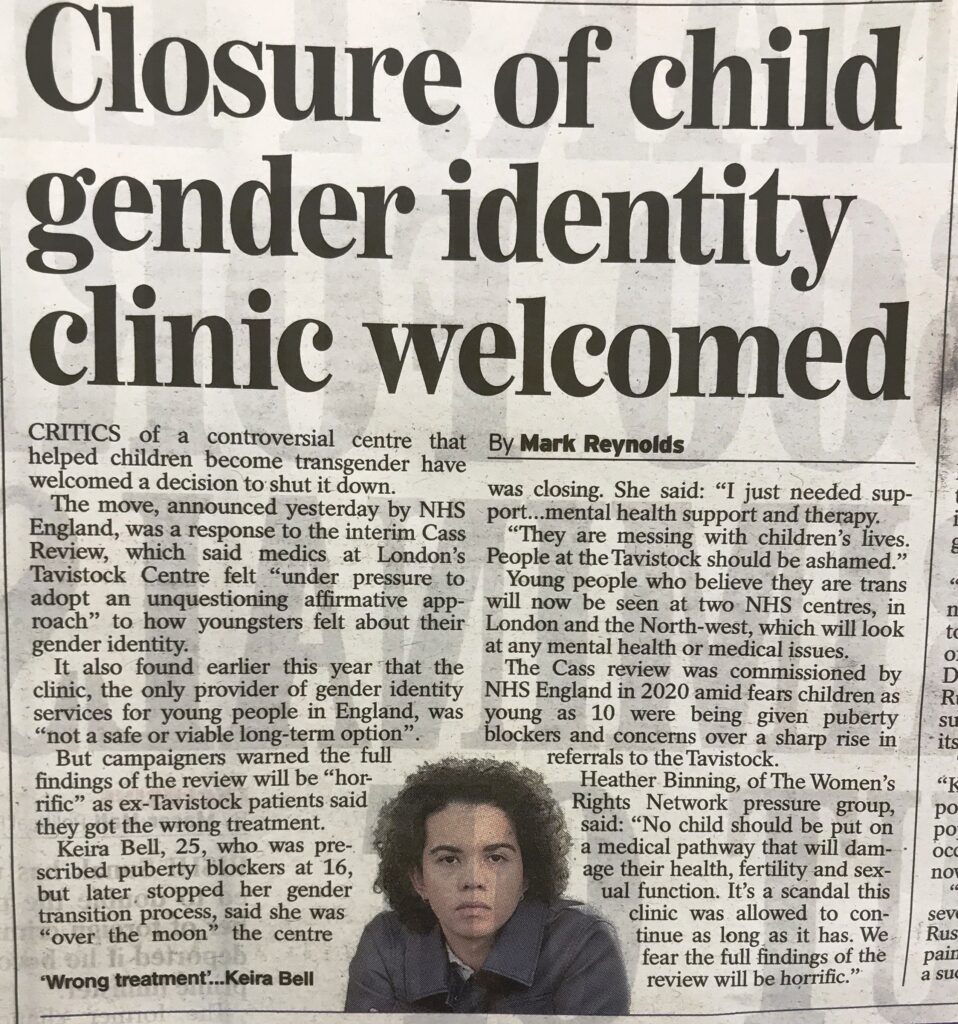

The word gender wasn’t used in the social world I came from and grew up in. There were boys, girls and the ‘opposite sex’ in everyday parlance. I had no notions of one sex being more important than the other, because we were all at the bottom of the pile, deferring to those with money and power. We knew our place, singing hymns with such lines as ‘All things bright and beautiful, all creatures great and small, The rich man in his castle, the poor man at his gate, God made them high or lowly and ordered their estate.’ My father was worked to an early death, aged 41, taking his war wounds and shrapnel with him. My maternal grandmother died giving birth to my mother, who lost her youngest and favourite brother, Charles Close, in a world war for rich folk’s benefit.
Though I confess to a childhood wish to wake up and find myself turned into a little girl, I can find no simple explanation for it. I knew nothing about sex or reproduction. I was told that I had been found under the Gooseberry Bush. I just wanted to be treated as, dress and play as a girl. Most importantly, I did not like having a penis. Interestingly due to ongoing police harassment, I was asked by a psychiatrist employed by my lawyers ‘Do you wear female clothing for sexual gratification? An interesting revealing question no doubt emanating from concerned police parties.
As someone whose studies went on to include psychology, among much else, I was never agreeable to the idea of giving pre pubescent children hormone blockers. This was never on moronic religious bigotry grounds. It was and still is on the grounds that children cannot know, although I seemed to , that they will always want to change their sex. Childhood was not the time to attend to such a serious matter – in my view. Unfortunately, l given the way boys and adult men are treated and vilified as scapegoats, there has been an incredible upsurge in white sex change candidates. There are profound and obvious reasons for this. Gender clinics have simply exploited this.
It now serves Tory Government purposes to shut the child gender clinic to appease feminists rather than face up to their role in creating so called gender confusion and dysphoria. One problem is that transsexuals romanticise females from a bygone age. Feminists sense that too many men will be attracted to transsexuals because they want to be seen as conservative women. They have to be stopped, so vote hungry politicians will jump on the bandwagon, while appeasing gays and lesbians – the latter a more obvious danger to women in public toilets and changing rooms, real transsexuals in my view, far outnumbering the MTFs who mainly want men if they want sex at all.
I was taught that scientific method requires rigorous efforts to disprove a theory and related paradigms. I was also taught to find, note and include all knowable variables in this process. Obviously that is a lot more difficult when dealing with matters of consciousness which is only partly visible through behaviour patterns. Descartes seriously pondered that issue, with no demonstrable conclusions. Karl Marx was arrogant or ignorant enough to assert that there was a state of false consciousness, and ergo conversely a true consciousness. Feminists hi jacked this concept, asserting that all women, regardless of family wealth, were the true and only exploited underclass , needing their consciousness raising. That notion has gained considerable traction and credibility, with class oppressor U.K leader Margaret Thatcher forgiven all her greed, war mongering, public` asset stripping ,social and economic travesties, because she is a woman and a veritable role model for females.
These combined forces have been exported to corrupt the world. Females are encouraged to see men as their enemy, with fantasy career fulfilment as their goals. So it is no wonder that so many little boys react to an imposed sense of guilt and inferiority developed especially in the increasingly normal fatherless homes, by wanting to be girls. The Tavistock & Portman have not been interested in these variables.
Meanwhile, feminists have felt increasingly threatened by rising numbers of transsexual females, especially in the egotistical money making world of sport. Hence, big names like J K Rowling have joined the campaign to vilify them as potential rapists, especially in public toilets and changing rooms. Transsexuals are supposed to inhabit the strange and potentially estranged world of LGBTQI, fixated on their genitals and right wear dresses etc.
This insane world – where youngsters of both sexes are going mad, drinking booze, taking drugs and even killing themselves – has now merged with the anti racists and Islamists, the latter , like Catholics, quoting ‘God’s Will.’ The idea that transsexuals simply have body dysphoria and might want otherwise ‘normal’ lives is anathema to the London Gender Identity Clinic (GIC) et al. They reckon 90% of their clients are mentally ill, but so called sex change treatment will make them less likely to commit suicide. Questioning why sex change treatment can be a cure for unspecified and various mental illnesses and why so many are going mad, is not a GIC concern from my experience. If you don’t seem a ‘safe’ fit for sex change surgery, you must take the anti psychotics, as I was told after 3 years as their patient. One can only conclude that the whole organisation is about social engineering. This extends to matters of fighting an alleged explosion of racism.
The following story is about how recasting Batgirl as a Latin American has led to a $90 million film that failed to please the public in test screenings, being scrapped without public release. Directors, producers, stars and the rest of the arrogant Hollywood clique are very upset to say the least , by public rejection of their attempted brainwashing conditioning programme. Needless to say, the villain of the film is a white male, played by Brendan Fraser. Fortunately ever more people are getting a picture which Hollywood will never produce. Cinéma Cinema Verity (Cinéma vérité ) is a thing of the past. There must be no hidden meanings or repellent truths. The film report below is followed by a more detailed explanation of the context into which this film was meant to fit.
Bat Girl, Bad Girl – Batty Idea
Batgirl: Directors shocked at film’s cancellation
The directors of Batgirl have said they are upset their film was axed months before its planned release, by Warner Bros Discovery.
“We are saddened and shocked by the news. We still can’t believe it,” directors Adil El Arbi and Bilall Fallah wrote on Instagram.
They said it had been a dream to work with stars including Michael Keaton.
Both had been in Morocco for El Arbi’s wedding, which had been attended by Will Smith as guest of honour.
The film had completed its principal photography and much of its post-production work and was in test screenings – Variety reported that news of its demise “sent immediate shockwaves through Hollywood”.
The New York Post reported that the decision had followed a poor reaction to test screenings, but Variety suggested that the cost of putting the film into cinemas and marketing it may have contributed to the decision.
As the film was unfinished, Warner Media would have had to spend more money completing, releasing and advertising it. Halting the process now means it can cut its existing losses without creating more.
According to US trade publications, the company may also be able to recoup some of the money it had already spent by using what’s called a tax write-down, which would save money by reducing the company’s tax liability as a result of not releasing the film and recording it as a straight loss.
“When Warner Bros files its taxes this year, the company will combine the income from its pro chair of the tax practice group at law firm Akerman LLP, explained to Fortune.
he film, which featured Keaton as Batman, was also due to star Leslie Grace as Batgirl, Brendan Fraser as villain Firefly and JK Simmons as Commissioner James Gordon.
“As directors, it is critical that our work be shown to audiences, and while the film was far from finished, we wish that fans all over the world would have had the opportunity to see and embrace the final film themselves,” Fallah and El Arbi said in their statement.
“Our amazing cast and crew did a tremendous job and worked so hard to bring Batgirl to life. We are forever grateful to have been part of that team,” they added.
“In any case, as huge fans of Batman since we were little kids, it was a privilege and an honour to have been part of the DCEU [DC Extended Universe], even if it was for a brief moment. Batgirl for life.”
In The Heights star Grace tweeted that she was “proud of the love, hard work and intention all of our incredible cast and tireless crew put into this film over seven months”, adding she felt “blessed to have worked among absolute greats and forged relationships for a lifetime in the process”.
She thanked fans for believing in her to become “my own damn hero!”.
The movie, shot entirely in Glasgow and reportedly budgeted at more than $70m (£58m), was due to be shown in cinemas and on the streaming service HBO Max later this year.
The Woke Context
YOU COULD use a single word as a proxy. “Latinx” is a gender-neutral adjective which only 4% of American Hispanics say they prefer. Yet in 2018 the New York Times launched a column dedicated to “LatinX communities”. It has crept into White House press releases and a presidential speech. Google’s diversity reports use the even more inclusive “LatinX+”. A term once championed by esoteric academics has gone mainstream.
The espousal of new vocabulary is one sign of a social mobilisation that is affecting ever more areas of American life. It has penetrated politics and the press. Sometimes it spills out into the streets, in demonstrations calling for the abolition of police departments. It is starting to spread to schools. San Francisco’s education board, which for more than a year was unable to get children into classes, busied itself with stripping the names of Abraham Lincoln and George Washington from its schools, and ridding department names of acronyms such as VAPA (Visual and Performing Arts), on the ground that they are “a symptom of white supremacy”.
What links these developments is a loose constellation of ideas that is changing the way that mostly white, educated, left-leaning Americans view the world. This credo still lacks a definitive name: it is variously known as left-liberal identity politics, social-justice activism or, simply, wokeness. But it has a clear common thread: a belief that any disparities between racial groups are evidence of structural racism; that the norms of free speech, individualism and universalism which pretend to be progressive are really camouflage for this discrimination; and that injustice will persist until systems of language and privilege are dismantled.
These notions were incubated for years in the humanities departments of universities (elite ones in particular), without serious challenge. Moral panics about campus culture are hardly new, and the emergence of a new leftism in the early 2010s prompted little concern. Even as students began scouring the words of academics, administrators and fellow students for microaggressions, the oppressive slights embedded in everyday speech, and found them, complacency ruled. When invited speeches from people such as Christine Lagarde, then head of the International Monetary Fund, were cancelled after student activists accused her of complicity in “imperialist and patriarchal systems”, the response was a collective shrug.
The complacency was naive. America harboured a “Vegas campus delusion”, says Greg Lukianoff, president of the Foundation for Individual Rights in Education, an advocacy group. “What happens on campus will not stay on campus.” It has not. The influence of the new social-justice mindset is now being felt in the media, the Democratic Party and, most recently, businesses and schools.
How did this breakout happen? Three things helped prepare the ground: a disaffected student body, an academic theory that was malleable enough to be shaped into a handbook for political activism, and a pliant university administration.
First came a new generation of students keenly aware of unsolved social problems and willing to see old-fashioned precepts of academic freedom (such as open debate) as obstacles to progress. Various events—the financial crisis, the election of Donald Trump, the police killings of unarmed black men, especially that of George Floyd—fed frustration with traditional liberalism’s seeming inability to end long-run inequities. This hastened the adoption of an ideology that offered fresh answers.
In a book entitled “The Coddling of the American Mind”, Mr Lukianoff and a social psychologist, Jonathan Haidt, posit that overprotective parenting in the shadow of the war on terrorism and the great recession led to “safetyism”, a belief that safety, including emotional safety, trumps all other practical and moral concerns. Its bounds grew to require disinviting disfavoured campus speakers, protesting about disagreeable readings and regulating the speech of fellow students.
Many students latched onto a body of theory which yokes obscurantist texts to calls for social action (or “praxis”) that had been developing in the academy for decades. In 1965 Herbert Marcuse, a critical theorist, coined the phrase “repressive tolerance”, the notion that freedom of speech should be withdrawn from the political right in order to bring about progress, since the “cancellation of the liberal creed of free and equal discussion” might be necessary to end oppression. Another influence was Paulo Freire, a Brazilian educator whose “Pedagogy of the Oppressed” (published in English in 1970) advocated a liberatory pedagogy in the spirit of Mao’s Cultural Revolution in which “the oppressed unveil the world of oppression and through the praxis commit themselves to its transformation”.
The Great Awokening
Today the most prominent evangelists for what political scientists such as Zachary Goldberg call the Great Awokening are Ibram X. Kendi and Robin DiAngelo. Both these scholar-activists have written bestselling books that sketch the expansive boundaries of systemic racism. Both minimise the role of intent, but in different ways. In Mr Kendi’s Manichaean worldview actions are either actively narrowing racial gaps, and are therefore anti-racist, or they are not, in which case they are racist. “Capitalism is essentially racist; racism is essentially capitalist,” he concludes.
Ms DiAngelo is concerned with the racism of everyday speech. For her, the intent of the oppressor is immaterial if an oppressed person deems the conduct to be offensive. How “white progressives cause more daily harm [to black people] than, say, white nationalists” is the subject of her latest book, “Nice Racism”. She sees liberal norms like individualism or the aspiration for colour-blind universalism as naive: “Liberalism doesn’t account for power, and the differential in power,” she says.
The embrace of this ideology by students and professors might have remained inconsequential had it not been for the part played by administrative staff. Since 2000, such staff in the University of California system has more than doubled, outpacing the increase in faculty and students. The growth in private universities has been even faster. Between 1975 and 2005 the ranks of administrators grew by 66% in public colleges but by 135% in private ones. As their headcount grew, so did their remit—ferreting out not just overt racism or sexual harassment but implicit bias too. The University of California, Los Angeles, now insists that faculty applying for tenure include a diversity statement.
In 2018 Samuel Abrams, a political scientist at Sarah Lawrence College, published data showing that these administrators are even more left-leaning than the professors: liberals outnumber conservatives by 12 to one. For writing about this, Mr Abrams faced a campaign by outraged students aiming to revoke his tenure. Campaigns by a vocal minority of activists have cast a pall on campus life, he says. “Large numbers of people hate this. They just don’t know what to do,” he laments. “They don’t want the mob coming to them.”
An upheaval in mass communication accelerated the trend. On Twitter, a determined minority can be amplified, and an uneasy centre-left can be cowed. “Weaponisation of social media became part of the game. But what I think nobody foresaw was that these tactics could so easily be imported to the New York Times or Penguin Random House or Google,” says Niall Ferguson, a historian at Stanford’s Hoover Institution. “The invasion…was just a case of the old problem: that liberals defer to progressives. And progressives defer to outright totalitarians.”
Mr Trump’s election added to centrists’ unease, leaving the poles to grow ever more extreme. “Anything but far-left progressivism was lumped in with Trump,” says one (Democratic) prosecutor in San Francisco. In the protest against Mr Trump’s handling of the Mexican border, for instance, the old Democratic line of enhanced border security and a path to citizenship for the long-term undocumented became passé. Progressives proved their sincerity by being in favour of abolishing immigration authorities entirely.
Having grown strong roots, social-justice consciousness has spread most readily to non-academic institutions largely peopled by those who have come through elite universities. As the students who have embraced this messy body of theory leave university, they enter into jobs and positions of influence. The question is whether, outside the ivory tower, the ideology will retain its intolerant and belligerent zeal, or whether it will mellow into a benign urge for society to be a little fairer.
Newspapers are a prime example. The digital revolution has devastated local newspapers and crowned new online-only champions. As newsrooms adapted by aping the upstarts, hacks who had risen through the ranks thanks to shoe-leather reporting were replaced by younger staffers stuffed with new ideas from elite universities. One prominent journalist argued for replacing “neutral objectivity” with “moral clarity”—making unflinching distinctions between right and wrong.
The urge to purge
Changes in newsrooms were also related to efforts to increase demographic diversity, on the assumption that this is the only authentic way to give voice to minorities. But the campus zeal for deplatforming voices deemed offensive and defenestrating those found guilty of violating the ethos has also been imported. (James Bennet, who resigned as editorial-page editor of the New York Times after one such row, now works for The Economist; he was not involved in this article.) Non-journalists on the staff of newspapers, including young engineers, can be even more activist in campaigning against colleagues judged to be producing content at odds with the new vision of social justice.
As with universities, this stridency met little rebuke from the heads of newsrooms. Lee Fang, a left-leaning journalist for “The Intercept”, an online publication specialising in “adversarial journalism”, was accused by a colleague of racism for posting an interview with an African-American supporter of Black Lives Matter who offered a personal criticism of the group. He was made to apologise.
The quiet cultural revolution has also affected the Democratic Party. A decade ago, around 40% of white liberals agreed that “racial discrimination is the main reason why many black people can’t get ahead these days”; today over 70% do (see chart 2). In 2013, according to Gallup, a pollster, 70% of Americans thought black-white race relations were going well; that has dropped to 42%. Among white conservatives and moderates, there has been little movement on such questions.
In the past decade a far greater share of white liberals than African-Americans came to believe that blacks should have “special favours” to get ahead (see chart 3). Ideas for promoting racial equity that once belonged to the Democrats’ left fringe have become mainstream. Cash reparations for African-Americans are supported by 49% of Democrats, for example, and 41% endorse reducing police funding.
Democratic politicians have responded. In 2008 Barack Obama criticised overheated sermons of his pastor, saying “they expressed a profoundly distorted view of this country—a view that sees white racism as endemic, and that elevates what is wrong with America above all that we know is right with America.” The pastor’s view is now ascendant among Democrats.
In 2016 Hillary Clinton started giving speeches on the need to end systemic racism. By 2020 this movement was the defining fault line of the presidential primary. Joe Biden, an avatar for Democratic consensus, won by taking positions far to the left of Mr Obama, including on matters of identity politics. That is why his administration speaks much more social-justice patois than Mr Obama’s ever did. And why it embraces reparations-adjacent policies like the creation of a $4bn fund to pay off the debts of only non-white farmers, and a proposal that 40% of benefits from climate-change investment go to previously disadvantaged communities.
Wokers of the world, unite!
This new political prominence makes the question of what happens to the ideology of social activism as it spreads beyond the ivory tower all the more important. Does it retain its purity and potency? Or does it become diluted?
The corporate world will be a big test. Businesses, particularly those in the knowledge economy, have been grappling with the challenge of how to respond to social-justice consciousness as young employees agitate for change and woke consumers threaten boycotts.
An increasingly common argument is that there is no trade-off between greater diversity and profits. “I’d like to get to a place where we thought that diverse representation was just as important as profitability, because we believed it was linked to so many things that were going to come back and drive value,” says Julie Coffman, the chief diversity officer of Bain & Company, a management consultancy. Others make an explicit business case. McKinsey, another consultancy, has released a stream of reports arguing that firms with greater ethnic and gender diversity have a greater chance of financial outperformance.
Since Floyd’s murder, American businesses have issued a dizzying number of equity-related missives and quotas for hiring and procurement. Facebook, a social-media giant, has promised to hire 30% more black people in leadership positions and has set a goal that “50% of our workforce be from underrepresented communities by the end of 2023”. Target, a retailer, has pledged to spend more than $2bn with black-owned businesses by the end of 2025. Walmart, another retail titan, has set up a Centre for Racial Equity and says it will give it $100m to “address the drivers of systemic racism”.
Importing the language of equity without university-style blow-ups can be difficult. “What you’re seeing is Gen Z or young millennials basically engaging in this collective war against the boomers and the Gen Xers who actually run the organisations,” says Antonio García Martínez, whom Apple fired in May after 2,000 employees circulated a petition questioning his hiring, citing passages they found to be misogynistic in an autobiography published five years ago. When Brian Armstrong, the boss of Coinbase, announced that workplace activism was to be discouraged, he was inundated with private messages of admiration from CEOs who felt that they could not do the same—and public criticism.
“Corporate wokeism I believe is the product of self-interest intermingled with the appearance of pursuing social justice,” says Vivek Ramaswamy, a former biotechnology executive and author of “Woke, Inc.”. He argues that Big Tech pursues corporate wokeism because appearing to embrace social justice suits such firms’ commercial interests—both in terms of recruitment and appeal to their customers. It performs allegiance to identity politics while simultaneously rejecting the left’s critique of capitalism. “A lot of Big Tech has agreed to bend to the progressive left,” he says, but “they effectively expect that the new left look the other way when it comes to leaving their monopoly power.”
Such hypocrisy is increasingly prevalent. The founder of Salesforce, a tech behemoth based in San Francisco, is known for championing social-justice causes like a surtax to fund homelessness services in the city. Yet the firm itself paid no federal taxes on $2.6bn in profits in 2020.
Wokeness’s next frontier, with the greatest potential to make a mark on the future, will be the classroom. In California’s recently approved ethnic-studies curriculum, which may become a high-school graduation requirement, one lesson plan aims to help students “dispel the model-minority myth” (the idea that to dwell on Asian-American success is wrong). Roughly one-sixth of the state’s proposed new maths instruction framework is devoted to social justice. It approvingly quotes from studies suggesting that word problems about boys and girls knitting scarves be accompanied by a debate about gender norms. Last month the governor of Oregon signed a bill eliminating high-school graduation requirements of proficiency in reading, writing and maths until 2024—justified as necessary to promote equity for non-white students.
Woker or weaker?
Such proposals hint at the difficulties of translating some of the theories embraced by the new left into policy. Because disparities are theorised to be the result of largely implicit discrimination, systems must be dismantled. This leads to odd conclusions: that racial test-score gaps in maths can be ameliorated by dialectic; and that not testing for the ability to read is a worthy substitute for teaching it. Material conditions that the old left cared about, such as persistent segregation in poor districts and schools, get little attention.
There are some signs of a backlash. Three members of San Francisco’s board of education, including its president, are under threat of a recall election. So is the city’s ultra-progressive district attorney. However, the underlying engine—the questionable ideas of some academics, and the generational change they are rendering—is not shutting off. America has not yet reached peak woke. ■

July 7th 2022
Transfiguration
by Miss Roberta Jane Cook

Women were encouraged to pay allegiance to their ‘sisters’ and the State – not husbands fathers, boyfriends, or any man..Women were transfigured into Deity through education & developing popular culture.
When Thtacher destroyed Traditional British Industry, the male role models went with it. Labour lost its Trade Union underdogs, looking for new causes, finding them in the war against sexism and racism, hallowed and distracting social obsessions.
Family life as we knew it was dead, the age of the one parent family and feral children was born. So was the age of gender confusion and body dysphoria, including overweight girls , anoorexia and sexual identity crisis. Laws were passed to stop worrying questions. But the conflict between deified feminists and their ac`olytes, against the growing army of male to female transsexuals, exemplifies femiinist hypcrisy and double standards on the ‘equality’ issue. So there was soon a hate campaign againts transsexual women..
My own notion of wishing I had been born female began , to my recollection, when I was 3 . It had nothing to do with today’s political correctness. I did not see one gender as better than the other because in my social class, we had more pressing things to worry about and positive role models for all. It was the post war age of hope. Hope now is ever scarcer among the masses. So , with boys villified, all sorts of negative outcomes are likely, with sex change a straw for the deluded. Given how the Gender identity Clinic, after corrupt police , grinding their axe , decided to cause me further problems, I went from them recording that I had a ‘secure female identity’ ready for surgery to being labelled a paranoid schizophrenic, bi polar and deluded.
To continue to my overdue sex change surgery I was told to accept powerful anti psychotic drugs. I refused and the police doubled down on my health care, one of their many unfounded allegations being that I am a ‘gay whore’ working in my son’s brothel for him and his gangtster friends. I was actually a long distance lorry ( truck ) driver at the time of their criminal lies and false arrest, followed by malicious prosecution. Police passsed their lies to my employer and doctors, keeping the case open and on record to avoid legal action. They got me labelled criminally insane, getting me fired as a conseque. Lying appears quite natural to them. It horrifies me that nice members of the public , espcially women, always believe the police. They offer a false sense of securitry – as Sarah Everard tragically discovered.
I have no doubts about being transsexual, and have done much further reseaarch on the suibject, but such drugs would turn me into a zombie, with motor control issues, as well as bowel and bladder control issues.
It is interesting that the Gender identity Clinic has published a statement that 90% of its ‘ patients have mental health problems, adding that sex change makes them less likely to commit suicide. As for the U.K’s corrupt over esteemed police, they should not come within 50 miles of a mental health patient. Their own mental health should be the issue, not other people’s.





Roberta did not realise at this time, that police had channeled malicicious prostitution and other vile sexual & violence allegations to the gender clinic, as fact. Roberta’s refusal to accept chemical lobotomy led to the clinic blocking further hormone treatment and writing to say that she ‘ did not fit their criteria.’
MissCulinity In The World Of Sport & All Sorts.
Miss Culinity & The Strong Independent Woman by R J Cook

Feminist hysteria about transsexuals raping women in public toilets and sports changing rooms is based on many contradictions. For example, one of the latest state driven pieces of nonsense is that females should be role models for boys. The logic of this will be more little boys wanting to be little girls.
Meanwhile girls are most numerous of transsexuals if one counts lesbians. Lesbians come in boy style. The boy style grow up to resemble Linda Belos. Some lesbians still present as girlie and are attractive to boyish lesbians, who are also attracted to ‘normal’ girls – as my late sister discovered. Some gay men present the ‘normal’ old fashioned image of masculinity, as with the actor Rock Hudson.
The key word here is image. This is because behind the scenes it is what the media elite and politically correct call ‘our values’ that matter.
Masculinity in traditional form is labelled toxic. We are in a new age of MissCulinity. Women en masse are not driving women into sports obsession. The State is doing that. In the U.K , national football manager His saintly earnest and bearded face reminds me of Jesus, as he preaches that sexism is a man problem for only men to solve. The State owns women as a blob – upper classes and the Queen excepted of course.
The much prized goal of becoming a strong independent woman is about forcing women to mistrust all men, presenting them as the only human capable of violence, to which it has a natural tendency from which women must be protected.
The State’s mouthpiece media elite needs women as detached from men and dependent on the State. They despise and vilify what they sneeringly refer to as co dependency. It is about divide and rule, a tactic that built an empire and is building a new psychological empire in the U.K – exporting it wherever and however they can.
Another contradiction is ‘equality in sport.’ If women really believed in equality they would not oppose trans women in direct competition with them – using the weird and pathetic excuse that trans women want to get inside changing rooms to rape them. These cis women know that a highly trained male athlete is superior to a highly trained female athlete. In spite of transsexual women having genital surgery and hormone treatment, feminists like Olympic swimmer Sharon Davis , argue that trans women still have an advantage unless they transition before puberty – a dangerous and difficult choice because children are not fully aware of sexual reality and a mature penis is vital to creation of a trans vagina.
I have written much about trans sexual people on this website, elsewhere and in my semi autobiographical novel; ‘Man, Maid, Woman’ – where the hero or heroine is clearly romanticising sex change as a cure for failings with girls and in the traditional man’s world. I was not preaching like bigots Sharon Davis and J K Rowling, just exploring ways to truth. This is not a subject for intellectual inadequates like footballer turned manager Gareth Southgate, or bigots, including the police – who should not be allowed anywhere near mental health patients, not least because their own mental health and honesty is open to serious question.
Sadly we will never really know what it is to be anyone except ourselves – some people don’t achieve that or lose their sense of self through trauma , brainwashing ,coercion or dementia.
As concerned parent and retired teacher with 18 years experience, I have some understanding of young peoples’ frailties, vulnerabilities, anxieties, fears and insecurities. This understanding was intensified through many years of marital conflict with my ex wife over child rearing and what was best for my two sons. For my ex wife, sex was the basis of morality – the British middle classes always mix sexual morality with hypocrisy just to make life more stressful.
All the stress of those years of argument led me to defer to the analyst she sent me too, where I was told, I was female. But one has to wonder about the dubious methods of London’s Gender Identity Clinic ( GIC ) and related State Bodies, along with their motives, where most patients are male- it is pretty well impossible to turn vaginas into realistic penises anyway and most women know when they are well off. As for me, the GIC made me an offer I had to refuse, surgery in return for me taking lobotomising anti psychotic drugs – because the police butted in on my case, lying that I am insane and was a ‘gay’ whore working for my son and his non – existent gangster associates in a home based brothel.. Still, the GIC will never go short of patients eager to show off their MissCulinity.
Miss Roberta Jane Cook
June 11th 2022
Lost In Transhatred

As a person whofrom the age of 3, wished theyhad been born a girl; I am not sure about the wisdom of anti androgens and hormone treatement for young people. Since the average female of the masses dresses like a slob in the U.K , it is a moot point as to what constutes female clothing or being female – obviously fantasising about boys starts at an early age for girls
I am sure that the likes of this privileged feminist Attorney General proferring her vile J K Rowling worshipping male hate speech, in the name of safe spaces for girls, believes she is the law, rather like the corrupt police in fake democracy U.K. Her out of touch patronising ilk are sickening.
The whole notion of worshipping the fantasy of pure always honest femaleness ( I won’t say feminine because that is a rare phenomenon in these feminist male hating days ) reiforces injustice and make escaapism, including drug addiction, reacdtionary violence and suicide.
I think parents of trans mtf little boys should be very wary of them being allowed into girls school toilets, because little girls are attention seeking, precious and quite capabale of fantasising lies. If schools are going to host trans pupils, they need seperate toilets, which includes girls who want to be boys or lesbians. I am utterly sick of the ‘me too’ brigade of feminists guards. They are totalitarian bigots on a par with medieval religion and witch hunts. They ,along with mainstream media , especially hate Johnnhy Depp’s female fans . Depp was suposed to have been foud guilty in the U.S as he was by a biased U.K judge, simply because he is a` man, and Heard, a female, said so..’Me Too’ is acually ‘Me Sue’ , out for gain and glory as a victim. meanwhile real victims have no specific gender or ethnicity in this world of fake equality , FAKE LIBERALISM and tolerance.

Miss Robert Jane Cook June 9th 2022
May 3rd 2022
Miss Directed
The biggest obstacle to honesty about gender is fathers of daughters. They are the great Mother Mary worshippers and cannot accept that ‘Celia Shits.’ ( The Lady’s Dressing Room is a poem written by Jonathan Swift first published in 1732. In the poem, Strephon sneaks into his lover Celia’s dressing room while she is away only to become disillusioned at how filthy and smelly it is. Swift uses this poem to satirize both women’s vain attempts to match an ideal image and men’s expectation that that illusion be real. )
Every foetus starts of as female, but hormones flick a switch. As mammals we have the advantage over birds and reptiles because reproductive eggs are fertilised inside the female where they remain until birth. The male fights off predators and females flee, as we see in this Ukrainian War. Only the men are locked in and conscripted to fight in rich powerful men’s vile wars. So what is all this crap about male privilege that imbecile feminists are allowed to get away with.
By the way. modern women are sexually frustrated because they accept need to dominate men. Leaving all the religious crap to one side, the divide between the sexes is narrow, so some of us so called cis males are naturally sexually excited by submitting to ‘real men.’
We transsexuals dress accordingly, to impress. We enjoy looking pretty and we like real men fucking us – but we do not extend the same privilege to the state. We also care more for our children, which is why I would not take the anti psychotics ordered by the police who said I am deluded. If I hadn’t wanted kids I would have wanted my sex change many years earlier.

The notion that one cannot understand the reality of womanhood without enduring menstruation should be balanced by the reality that women cannot possibly understand the discomfort of being male if they don’t know what it is like to experience erections. So let us consider the following feminist drivel and I will comment more when I have time off from more important matters :
“Why do some feminists fear and hate trans women and the non-binary?57 RelatedSortRecommendedErnest W. Adams, proud feminist my whole adult life.Answered 4 years ago · Author has 41K answers and 226M answer views
“Few things piss off a woman who has been treated as female from birth, with all the crap that that implies, more than a trans woman who has enjoyed all the privileges of manhood, and then upon transition decides that she is an expert on femaleness and proceeds to tell other women what it’s all about and how they may and may not talk about it. In fact, it sounds a lot like “mansplaining” when they do it.
“There are aggressive trans women who try to suppress discussion of menstruation or childbirth in women’s forums because they say it “others” them because they can’t experience it. “
Comment “Oh what hell to be a lady. Take the pill, forget the baby. Climb the ladder & look down, At the darker side of town. See the poor, see the pain, of a world that’s gone insane, nurse your womb, keep it healthy, till you find a man who’s wealthy. Don’t pretend to be a slave, tell the truth, you are a knave. ” R J Cook May 3rd 2022
P.S The knaves are defined as ‘ motivated entirely by the desire to acquire material wealth that they consume themselves for their own benefit’ (2003: 25). From the Cambridge English Corpus. …
April 22nd 2022
He Quality – a comment by Roberta Jane Cook.

I find the whole dialogue of hate coming at transsexuals from certain people claiming to be ‘real women’ disturbing and nasty, ‘ This phrase is the juxtaposition of two words that do not logically belong together.
The concept of reality and what is real , has, confounded philosophers for centuries , along with the issue of consciousness. Feminists, stealing Marx’s concepts of underclass and false consciousness made an epistemological leap bringing us to where we are now, with Sociology , Psychiatry & Psychology becoming their perquisite properties and pulpits.
Consequently we have feminist heroines like Hannah Gavron and her study of ‘The Captive Housewife’ presenting ‘women as the exploited underclass’. Feminists are largely, if not wholly, bourgeoise and imperialistic to the wider world of capitalist oppressed and poorly educated women. A major problem with feminists is that their world of modern literature and social science ‘uni’ degrees have qualifications as a bais for a career in bigotry.

In their patronising world women can be whatever the feminists tell them to be. They must not like pretty dresses, lingerie, high heels or makeup. they must compete on the football field, and above all in the home, which is why there are so many dysfunctional families, drug addicted, feral and suicidal children. So their pathetic plea that only ‘women can have babies,’ regardless of whether they want them or they the harm they do, that is where the saintliness of womanhood resides. Matters of brain function, foetal hormone exposure and other aspects of genetics is of no concern to them. As members of the bourgeoise they have replaced what my late mother called ‘the Lady Bountifuls’.
Now my mother was a real woman which is why I identified with her and her sex. My father’s terrible short hard life as a North London Urchin, soldier on the battlefield and truck driver is something else. Feminists would never let men get away with defining themselves by the ability to impregnate them. They screech in unison that soon women won’t even need men for that. What many of them ‘realise’ but don’t shout about is, transsexual females aspire to be feminine while feminists aspire to confront and deprecate men. Men are not liking it, which is why so many men have pursued me , a woman , over the years. I was delighted to receive friendly toot from a builder’s van this afternoon in Stony Stratford. I smiled and shyly waved. Roberta Jane Cook

Trans rights have been pitted against feminism but we’re not enemies
This article is more than 1 year oldKim Humphery
One of the most distressing aspects of the hostile narrative is that it sidelines a reality of alliance
As a trans woman working in academia, one of the questions I regularly get asked is how I get along with feminist colleagues. When I invariably answer “incredibly well”, I’m often met with a quizzical look.
I can understand why. As trans and gender diversity has become a regular topic of public debate and a favoured target of rightwing attacks, feminist critics have joined the fray.
That has put trans and feminist activists on a seemingly unrelenting path of mutual antagonism. Trans rights have been pitted against sex-based rights for “real” women, with conflict forever spiralling into charge and countercharge of hate speech and silencing, and into bitter social media wars.
Read More Trans rights have been pitted against feminism but we’re not enemies | Kim Humphery | The Guardian
April 16th 2022
Orgasm 4 Hate
by Miss Roberta Jane Cook.

No rape in my personal experience can compare with what the police and CPS have done to me. But leaving that aside, I have been physically raped by men perceiving me as a female who was ‘asking for it’ four times. Obviously I learned to avoid further incidents.
Rape is a very politicised issue. These days there is no statute of limitations. So aggrieved vindictive women can take revenge whenever because the likes of Boris Johnson’s Government wants to be seen doing its bit for women.
Former law boss Harriet Harman shamelessly said she would rather see innocent men jailed for rape than see guilty men go free. Men need to be very careful.
The law prevents me from detailing the first time a man made me orgasm. I was young and the guilt stays with me. I was wearing a very pretty dress and pretty underwear. The man said I was asking for it. He couldn’t help himself. I didn’t know what an orgasm was back then. I just felt very ashamed of myself or the feeling he gave me..
Victim Orgasm during rape is apparently commonplace because some things are beyond our control. We either experience orgasm as male or female. The quantitive and qualitative differences are uncertain because a Freudian approach to sex is outré. We just can’t talk about sex and orgasms anymore because power crazed feminists say so.
Feminists have the Hitlerite bunker mentality. Real Sex works in a street world, a world of display. The risks are hopefully calculated. Take the following image of me, out and about in 2008.

Now we know the police, my GP and the local madhouse have problems recognising that I am a published writer and accredited journalists because certain police parties told them so. The jury will soon be out on that one.
Suffice it to say, I knew what I was doing when this picture was taken, needing money, and the story I was after. Journalists get killed. It is one of the risks. There is no doubt I am provocatively dressed here, as I was all four times that I was raped , including on the day this picture was taken.
To orgasm for bullies and rapists, of which there are none worse than the U.K Police , is to admit the sort of guilt that makes me crave death. To orgasm for those who hate us is too much to bear. As my naked picture shows , I am too feeble for the relentless onslaught.
Every time I was raped, I orgasmed several times. When morons, laughing imbeciles, thugs and bullies make and see you helplessly orgasm, you experience a truth beyond the pain and humiliation. If this World War Three insanity goes any further we will see the reality of our animal world that no posh boy editor will be able to contain.

Miss Roberta Jane Cook
The effect of estrogen on the sexual interest of castrated males: Implications to prostate cancer patients on androgen-deprivation therapy, “Beyond the Abstract,” by Erik Wibowo and Richard J. Wassersug
BERKELEY, CA (UroToday.com) – Many prostate cancer (PCa) patients are treated with androgen deprivation therapy (ADT) to control their cancer’s growth. ADT results in sexual dysfunctions including loss of libido, erectile dysfunction (ED), and difficulty in achieving orgasm.[1] Loss of libido is a serious side effect for men on ADT because, unlike erectile dysfunction, there is no established intervention to compensate for it. When sexual desire decreases, patients often distance themselves from their sexual partners. As a consequence, intimate relationships are damaged.
Androgens are generally thought to be the hormones that give males their libido. However, in our review we show that estrogens can positively influence male sexual interest. We present evidence that in 19 out of 25 animal species studied to date, administering estrogen to castrated (androgen-deprived) males increases their sexual interest as indicated by copulatory and/or courtship behaviours.
We acknowledge that in some species, supplemental estrogen fails to elevate sexual behaviour above castrate levels. Many factors influence the effectiveness of estrogen in restoring sexual interest including treatment regimes (i.e., dose, type of estrogenic compound, route of administration), housing condition (i.e., lighting condition, number of animals per cage), and various intrinsic factors (i.e., age at castration, strain of animals). Therefore the studies failing to show that estrogen has a positive effect on male sexual behavior need to be cautiously interpreted as some factors that seem inconsequential may actually have a prominent effect on sexual behaviours.
Ukrainian border guards stop a male ‘deserter’ in women’s clothing
Walter Finch For Mailonline

Ukranian border guards made an unusual discovery at a Moldova crossing when they uncovered a man in woman’s clothing trying to escape the country.
The State Border Guard Service of Ukraine claims to have stopped a taxi near Odessa in the south of the country carrying a strangely tall, deep-voiced person in women’s clothes earlier today.
According to the Border Guard Service’s Twitter page, the 26-year-old traveller was carrying a temporary conscript’s certificate while attempting to enter Moldova, raising the guards’ suspicions that they had a deserter on their hands.
Read More Ukrainian border guards stop a male ‘deserter’ in women’s clothing (msn.com)
Comment
This is highly significant. Why did we have all this crap about women fighting to defend poor sweet innocent Ukraine when they all ran away ? If we have gender or sexual equality, why is it that men have to be locked in to fight, kill or be killed ? Western news mocks the east for propaganda. No country does it better than the U.K elite does it.

Miss Roberta Jane Cook.
April 10th 2022
Reflections by Roberta Jane Cook

The police, who effectively blocked her sex change surgery with lies about her being mentally ill, have approached employers with other allegations including years of alcohol abuse. They have an agenda.
The most bizarre allegation was that she informed on herself for working in a brothel run by her son and ‘his associates. It became clear in court on September 21st 2021, that these police lies are still on record and were passed to the CPS as fact.’ .
I am writing this piece as a preface to the following story and link. My father died when I was 11. He was lucky to have survived Dunkirk and life during the Great Depression before that. His life growing up in North London was awful. He told me about it. He passed, like my mother, for grammar school but his parents could not afford to send him.
We grew up as poor relations of some wealthy local people. My father rode his bicycle all weathers to work for a pittance as a brick lorry driver, He left the house at 3 am and was lucky to be home by 6pm. He smelt of brick dust and diesel. He worked 6 days a week. In our brief time together, he taught me about mechanics, woodwork , music, electronics and the war.
My father’s efforts to turn me into a tough boy were appreciated. I learned to act the part, though shied away from playground fighting. At secondary , the science teacher took the boys into the school garden for sex education , leaving the girls with a local female doctor.
The teacher’s name was Mr Keep. He was fond of taking me into this prep room , pulling my trousers down and spanking my bottom for the most trivial of reasons. I was being taught to be submissive. The spankings always had something to do with me being the joker. So, sitting under a tree in that garden, on a summer’s day, Mr Keep decided to warn us about homosexuals, singling me out as a blonde blue eyed boy being the type men fancied. I blushed. He went on to talk about masturbation. I blushed again, so the teacher said ‘Cook knows all about that.’ I was being sexually humiliated as the teacher intended.
I had been secretly dressing as a girl before my father’s death, helped by my Aunt Florence who lived next door in another of our rich relatives houses. She was widely travelled and much hurt in love. She taught me about womanly things. Hardship did not seem to favour a particular gender from my lowly perspective. My cousin Janet had moved back to town, following the humiliation of her divorce & sex life being plastered across the ‘News of The World.’ She was nicknamed ‘The Blonde Bomber’. I loved her dress style of pencil skirts, seamed stockings, satin blouses , make up and very high heels. I liked her perfume too.
Then I just knew I wanted to be a girl.. Every night, I prayed to wake up as a girl. I had secretly been reading a psychology book from my father’s large library. My parents had been addicted to newspapers, so I read a lot about the world. Sex scandals , like Profumo’s ,were a big tabloid issue. Freud argued, controversially that children were sexually aware by the age of four.
He didn’t mean they wanted sex, only that they knew what sex meant to them. That was and still is true of me. So I would have benefitted from growing up in these more enlightened times. The only snag for me was that after my father’s premature death, I had to be the man in my mother’s life and she would not have coped without me. Like most mother’s ( not all ) she was proud of having a son – another Freudian thing that also applied to father’s and daughters.
It is interesting that our alleged multi culture preaches religious tolerance for religions, including feminism, but displays and executes such fiendish hostility toward transsexuals. It is interesting how -backed by posturing vote hungry politicians like Johnson, the likes of moralising egotists of Rowling and Sharon Davies calibre – see transsexuals only as sexual perverts disguised to rape ever innocent women in public toilets and changing rooms. They can’t accept that we are attracted to men because it is all supposed to be about them. This self-centredness is drummed into them from early years.
For them, the issue is about power and their glory. The fact that female sports persons are not as strong or fast as elite male equivalents, must not be mentioned. But the very hysteria surrounding transsexuals in female sport, proves the point – the changing room aspect is a distraction because the myth of female equality is essential to social control. Meanwhile, feminists like Linda Belos can look and talk as masculine as they like, setting new benchmarks for woman hood. Men are supposed to respect this and change only in ways women want them to. Here’s the conflict, women want to be like men, but men must not be allowed to be women. Men are supposed to be too stupid to notice this.
R J Cook
‘I don’t want facial hair’: Trans girl, eight, has sleepless nights about growing up as a boy
Charlotte Lomas, news correspondent
Since 2014, the Saccone Joly family have been documenting their daily life online to almost two million followers.

Jonathan and his wife Anna were just a young couple with a dog when they first started recording videos for YouTube, but they quickly generated interest when they filmed the birth of their first child, Emilia.
But after reaching his 40s, Jonathan said he knew he had to change. He wanted to move away from “fluff” and concentrate on promoting positive messages about mental health and gender identity.
‘The perfect mix of a girl and a boy’
Jonathan describes a childhood of trauma after he had to suppress who he really was.
“I grew up thinking that all the thoughts in my head were wrong. I know that left me with a lifetime of trauma,” he said.
Jonathan recently revealed to his followers that he is non-binary and uses the pronouns he/him. He also announced his second child, born a boy, is now a transgender girl called Edie.
April 8th 2022
TransPosing
by Roberta Jane Cook
Shameless band wagon rider, PM Boris Johnson has a reputation for posing and posturing. He is in his element with Ukraine, leading the charge against Russia in this proxy war for the western elite super rich. His chancellor Sunak’s wife is a tax dodger, while both of them made a fortune from the lockdown furlough con. There has been massive fraud. They have no right to moralise about their friend Yeltsin’s oligarch’s whose dirty money they welcomed.
So now Boris panders to bigoted women’s groups with retired swimmer Sharon Davies applauding this monstrous Brexit con man and law breaker – who even admitted using the sex drug cocaine. All because he has outed himself as a transphobe who thinks transsexuals want the right to enter women’s lavatories to commit rape. This of course is part of the process Of rehabilitating hate preacher and writer of the dreadful Harry Potty blockbusters. What does that tell us about taste ?
Davies is my height and my weight. We are big girls. My testosterone levels are near zero thank God. I competed as a male for many years, doing well through very hard work. Top female athletes, as exposed by Blair babes taking testosterone prescribed by a Harley St doctor, have used testosterone for years. Sport is money and status now.
Female athletes are doing it for themselves and , for all of their equality of opportunity drivel, they want to be on top. They fear male to female athletes because they know equality is political bulls-t in which Boris Johnson excels along with partying. R J Cook

April 6th 2022
Transport – Comment
by Roberta Jane Cook


Image Appledene Photo graphics / CC.
This is what U.K Prime Minister Boris Johnson had to say about male to female transsexuals competing in Women’s Sport. His statement has the imprint of wife Carries and is guaranteed to get his party a big chunk of the white fake liberal and TERF feminist vote.
“I don’t think biological males should be competing in female sporting events. Maybe that’s a controversial thing to say, but it just seems to me to be sensible.
“I also happen to think that women should have spaces – whether it’s in hospitals, prison or changing rooms – which are dedicated to women. That’s as far as my thinking has developed on this issue.
“If that puts me in conflict with some others, then we have got to work it all out. It doesn’t mean I’m not immensely sympathetic to people who want to change gender, to transition and it’s vital we give people the maximum love and support in making those decisions.
“These are complex issues and they can’t be solved with one swift, easy piece of legislation. It takes a lot of thought to get this right.”
Johnson is rather slimy in my view. He is much in the mould of all who have followed Thatcher’s demise, including May. As war mongers and liars go, Johnson is every bit as bad as Blair. He may be multi lingual, but all this means is that he can impress his poorly educated masses by talking bulls-it in many languages. He has confessed to taking the sex enhancing drug cocaine, along with Oxford contemporaries. Like most people , however well educated, we have our favourite words and clichés. Here is one such of his clichés from the above report : “Maybe that’s a controversial thing to say, but it just seems to me to be sensible.“
Johnson is patronising. The idea that he does sensible thinking is a laugh. He conned enough of the masses to to support Brexit. They believed they would ‘get their country back.’ They never had it in the first place, but jingoism and flag waving makes the lower orders feel they matter. Johnson filled them up with sentimental rubbish.
The hidden agenda was to sidle up to the U.S where together they could tell the EU what to do. They have been the lead, feeding arms , prolonging the war, to Ukraine , while goading Europe to demand ever more crippling sanctions – while never mentioning Western backed coups and genocide in the Donbas..
Along with Biden, they led NATO into provoking an appalling war. These people have excelled at war crimes for decades, yet have the audacity to denigrate Russia and lock up innocent Julian Assange for leaking Chelsea Manning’s terrible discoveries. Anglo U.S led NATO are now threatening Russia with more NATO in the Arctic.
This is Johnson’s finest hour and he needs distraction from his Party gate lies and law breaking. The way he talks about transsexuals in sport, with an obvious lack of knowledge, interest or sincerity is true to type. He likes the masses of voters to think what he says is sensible. He drivels on about his developing thinking on these difficult issues. The elite run state is ever more intrusive, private space for men ever more reduced – men taking all the blame in as scapegoats because women are never wrong.
It is the hallmark of dictatorships that they play on fear, as with Covid Lockdown. Johnson now joins in the fascist mantra that men have mind and body altering treatment , including having penises hollowed out and inverted, scrotum removed and breasts development all so they can lurk in ladies toilets or women’s changing rooms. Transsexuals are fair game for those slanders and libel even though it has never happened. Meanwhile, blacks have raped white girls but there is no call for safe paces to keep all black men shut in special places. But transphobia is good because we all know how special , nice and more than equal women are.
The idea tha men need safe spaces from women just doesn’t catch on because the premise is that the sisterhood needs to be watching the men folk as a form of policing. Men are seen as potentially violent and dangerous,. They apparently cannot resist the overwhelming desirability of the modern British female. So they have to be protected.
The fact that women commit as many acts of domestic violence,, especially on children, is always written of as the result of male provocation. Women are more likely to harm children. When they do, helped by new male or lesbian lovers, all the sympathy goes with the female killer. She will have Munchausen’s syndrome or something equally stupid.


Given women’s capacity and propensity to lie, along with white liberal feminists and always be believed, men clearly need their own safe spaces.
Johnson and his police loving Tory Mafia show all the signs of consolidating a police state. It is as the Fabians used to say : ‘The Inevitably of Gradualness.’ The temperature has been rising but the frogs never notice. Boris is seizing the opportunity to help rehabilitate hate preachers like J K Rowling, a woman so vital to the British Economy. He is a bulky opportunist and he will never have the integrity to resign. He runs on rails and has more than enough hissing steam to obscure any issue. When his sort keep reminding us of our wonderful freedoms and democracy, that is just him doing his thing, lying, waffling and war mongering. he really should be voted out, if Britain was a democracy. But it isn’t .It is a plutocracy.
My last thoughts on trans sport, apart from the likes of Johnson and Rowling’s sick sex fantasies , sport is about greed , ego and money. For all the garbage about equality, Cis women know they are on average weaker than men and would not cope without a plethora of laws and social bias. But forcing women into this effectively masculinising woman process, is driving women mad, into lowliness , alcoholism, anti psycotic drugs, over exercising and suicide. R J Cook

Image Appledene Photographics/ CC.
ON UKRAINE, BIDEN FACES UNWINNABLE WAR AT HOME
Transgender cyclist Emily Bridges says she was ‘harassed and demonised’ after exclusion from national championships
By Matias Grez, CNN
Atransgender cyclist says she has been “harassed and demonised” by the media after the UCI, world cycling’s governing body, ruled she couldn’t compete at the National Omnium Championships in the United Kingdom over the weekend.

Boris Johnson has waded into the trans rights row, saying “biological males” should not take part in women’s sport and venues should have women-only spaces.
The U.K Prime Minister said that was “as far as my thinking has developed” on trans rights and “seems to me to be sensible”, though he acknowledged he may be “in conflict with some others”.
April 3rd 2022
Women With Balls
Much is written and said in media to disparage male to female transsexuals. men with daughters , like Linehan , will rush to defend the likes of hate preacher J K Rowling with her TERF feminist fantasy that women are so utterly desirable that men will queue up for sex change , chemical and physical castration along with the right to wear a dress just to rape women in public toilets.



The above pictures, taken from the current Women’s Six Nation’s Rugby Tournament inform us just how masculine modern western women have become. This is no more so than with England who are very physical in their play.
What would the female reaction be if a lot of men decided to play hockey in skirts ? Females cannot see the inconsistencies and contradictions in what they are doing. They are basically copying male role models. There is nothing resembling what we used to call feminine about them. Only the sweat proof make up maintains the illusion of difference. These are women with balls.
The basic principles of sex change are simple. The sooner female hormones are ingested, the more body changes can be impacted. Genital surgery involves removing testicles and scrotum then hollowing out and inverting the penis’s outer layers to create a sensitive orgasmic nouveux vagina. That vagina either has to be penetrated by males three times a day or otherwise dilated or it will collapse. The former sounds a lot more fun.
Because it is so much easier to remove material from the penis to turn a pole into a hole, male to female genital surgery is more convincing and functional than turning holes into poles. The best that can be done is to create a sausage with a pump and a skin bag filled with marbles, all of either small, medium or large size. A pump is used to inflate the pseudo penis. Not surprisingly few women make this choice, and male to female transsexuals need to know they would face the same problem if they tried to reverse the process, as famous transsexual Samantha Kane discovered.
Consequently females find other ways to mimic men as they do in England’s rugby. Listening to the England Women’s Rugby team being debriefed by an adoring media, the language pattern and body language is very much what us oldies would call masculine. As a transsexual it is not something I would choose to mimic. This is an issue for women, led by the TERFS , because we male to female transsexuals tend to be traditional in how we wish to present ourselves. In so doing we are more attractive to men of all ages.
R J Cook

The top London lawyer who’s changed gender THREE times: Extraordinary tale of transgender career woman, 57, who’s spent more than £100,000 switching sex – and why she believes life’s easier for men than women
- Sam Kane married British woman Trudi in 1984 and had a son and a daughter
- In 1997, she became Samantha and had her male organs removed in an operation
- But she transitioned in 2004, called herself Charles and got engaged to Victoria
Read More The top London lawyer who’s changed gender THREE times | Daily Mail Online
Comment I love how rich people lay down the law about all men and all women. They never talk about class. Kane cannot make such generalisations. She has it easy as someone from a very rich Arab family who saw sex change as a life style choice.
Psychiatrist Russell Reid told me he fast tracked her for sex change after her divorce. With Reid, you got what you paid for, which is why the Kane case ended his sole practice.
If life is getting difficult for CIS women it is their own fault. They have dictated gender role revisions leaving no say for men, labelling all men potential rapists and domestic abusers. They are driving themselves and men mad, leaving us transsexual women far more appealing to men because we actually understand them.
The enormous stress and responsibility of being male is impossible to cope with in the present climate. Most men are working class and poor. They need all the help they can get. There is nothing inherently pretty or nice about women as the above rugby game pictures clearly demonstrate. R J Cook

April 2nd 2022
MSN
Hopeless Roberta Jane Cook
Marilyn Manson – Suicide is Painless
A Whiter Shade Of Pale – Procol Harum – Cover by Emily Linge
A Whiter Shade Of Pale – Procol Harum – Cover by Emily Linge – YouTube
Celtic Woman – You Raise Me Up (Official Video) – YouTube
Celtic Woman – Parting Glass LIVE Ancient Land from Johnstown Castle 2018 – YouTube

Celtic Woman – Parting Glass LIVE Ancient Land from Johnstown Castle 2018 – YouTube
I wrote this for an old singer songwriter girlfriend yesterday.
GO TO DARKNESS & THE ROPE.
Who are the beautiful gender confused?
The ones who love to be abused ?
Peace and love children of hate
Who they are, can’t relate.
Black and white world spinning
For Governments eagerly sinning.
You can be what ever you need
Though you will never be freed
Feel the pain that is hell
Are you a boy or little ‘gel’.
We don’t care what you are
World’s on fire, gone too far.
We will fly you to spaces
Where you forget other faces
Take the pills for happiness
Put this on, a pretty dress.
Walk along our dismal way
Be as you like , be ever gay.
We have won the culture war,
Please don’t argue or be a bore.
You are our new beautiful women
Way above the normal spinning.
You will be what we need
You will feed the rich man’s need.
Doesn’t matter what you thought
Like a Mackerel you have been caught.
Like a worm or miniscule amoeba
You are helpless as you see you are
All we need is to stop you thinking
Make you alone and heavy drinking.
Beauty is a foolish trait,
Reality is just human hate.
So there it is your woman within
The way you dreamed hasn’t been
There is no escape, there is no hope.
Go now to darkness and the rope.
R J Cook March 31st 2022.

March 30th 2022.
Suicide Is Painless
I am very interested in committing suicide. I am not allowed to say why.
R J Cook
Easiest Painless Suicide Method – So Fast, So Peaceful (painlesspath.org)
3:41
Manic Street Preachers – Theme from M*A*S*H (Suicide Is Painless) (Video)
Roberta Jane Cook was raped age 17, by another 17 year old.
All images Copyright Appledene Photographics.

Roberta Jane Cook is standing second left , standing out like a sore thumb from her fellow Wolverton Athletic Club award winning athletes. Roberta said : ” I had to work very hard to compete with male athletes. As many of us trans people do, we overcompensate, work hard at denial and drink. At school, other boys seemed to know something I did not. I was raped a week after this picture was taken, told I was a dirty bitch who was asking for it. I was dressed as a girl. I hint at this and the confusion afterwards, in my semi autobiographical novel ‘Man Maid Woman.’ Confusion came from my submission to a male act, where another had identified me as female – and I responded to his force. It was something that haunted me to this day. One cannot be what is supposed to be normal after that. “

Roberta Jane Cook pictured left , was in a long term friendship with a black Havant Tax Office colleague pictured right. She said ” This good friend , retired magistrate V F Church, told me that I was obviously a girl. We were both outsiders at Havant Tax Office. When I told him I was getting married, he was very worried.” The black colleague was not allowed to be my best man at the wedding because of his colour and I was too gutless to protest.







This commentary from my past and today’s journey is by way of preface to the following article about a Tory MP coming out as trans, and hpw traumatic that is..
I watched the Sky News report on Wallis outing himself as trans. It was also noted that nowadays, due to high demand and other NHS priorities, there is a 5 year waiting list for Gender Identity Clinic Appointments ( GIC ) , let alone the surgery that has been denied to me because of the vile police lies, compounded by lies concerning investigation and 14 years of their refusal to reveal their alleged records of investigation and appropriate police processes..
Obviously, I like wearing classic female clothing and being viewed as a woman. I used to think it was nuts that I wanted my body to be female and would have loved to have been a mother. I was married to a very masculine woman who dressed like a man, after having retreated from two other Portsmouth women who I envied too much. I would never have had a rift with the woman I married if it had not been for what was happening to my sons. The eldest has had his life destroyed by vile police lies. The youngest, now 34 has been sectioned by parties I dare not mention – for legal reasons , because the police , and possibly MI6, are my only U.K readers..

The police went on to recruit an ex partner to keep watch and report on me, following her Claire’s law application in 2014. In December 2017, anonymous typed letters, with peculiar alleged porn pictures and videos led to my remote home being staked out while I was either sleeping or doing night into morning trucking shifts. I was accused of sending them from Northampton, when I could prove being hundreds of miles away in my truck. No finger prints or other forensics were taken.
It was alleged that I was a ‘gay escort’ working for Kieran and his associates from an home based agency. Interesting words from a transsexual, who would either be lesbian or straight female. According to police, I sent them myself. But the police raided regardless in February 2018, with an immediate report to my GP insisting they inform the GIC. They did as ordered by the British Police State. The GIC ordered a psychiatrist to my home, named Ramsay, Ramsay arrived with a burly mental health nurse and medical student. It was all taken as proven, with police criminal lies, perverting the course of justice, were sent to health carers and ultimately the GIC.
I was declared a paranoid personality, schizophrenic with bi polar disorder, deluded and therefore my long overdue sex change surgery could not happen until I took zombifying anti psychotics. I waited years to come out and my sex change surgery is now 3 years overdue. I am not male and have no route to becoming one , and wouldn’t want one. Suicide is an option. I cannot abide this appalling secret police state. As for the baby killing NHS, I cannot express enough disgust. Their watchword is always about lessons will be learned, just like the police. There is nothing scientific about anything the GIC do. During Covid , we were exhorted to clap a seriously failing bureaucratic NHS. Now we must clap Ukraine. Remember, we live in a ‘democracy.’ This pathetic word is used with hypnotic and monotonous regularity.
R J Cook

Jamie Wallis comes out as UK’s first trans MP
Conservative politician praised for his ‘courage’ in speaking out over experience of gender dysphoria

Jamie Wallis has become the first UK MP to come out as transgender, speaking openly of gender dysphoria as the debate about trans rights increasingly enters mainstream British politics. “I am trans, or to be more accurate, I want to be,” the Conservative MP revealed on Wednesday in a personal statement on Twitter. “I have never lived my truth and I’m not sure how. Perhaps it starts with telling everyone.”
March 27th 2022
Putin Bashing , Toxocariasis Politia & Killing Transsexuals Like
Roberta Jane Cook.

It is with regret that Roberta Jane Cook announces she has a terminal illness with less than two months to live. It is called toxocariasis politia ( poisonous police ). Therefore this website is running down as she does not feel fit to work anymore. She has had 14 years of extreme stress and police harassment in so called free democratic Britain and they have taken their toll.
The illness has unpleasant and at first invisible effects. It spreads through society destroying the justice system. The larvae breeds malicious false evidence, burying and smothering the precious seeds of truth. This is because toxocariasis politia the poisonous larvae multiply around the victim surreptitiously and increasing numbers , arresting free movement. By the time the illness has taken effect it is too late because toxocariasis politia infects the victims health carers, blinding them by creating fake mental health , alcoholism and crime reports.
The effects are to destroy the victims professional credibility, social isolation, bankruptcy, loss of will to live. The pernicious state funded disease replaced truth with lies and can cause severe mental illness unless the victim commits suicide, the only known cure to an otherwise long lingering , painful and humiliating death. The disease thrives in Western Style democracy like Britain’s- where government hopes to legalise transphobia as a toxin disguised amusingly as free speech – as with Julian Assange showing many of the symptoms. One only has to look at all the ‘free Assange protestors’ being ignored by British Democracy to realise that toxocariasis politia is more rife and deadly than Covid 19.
Roberta has been the subject of a police, mental health and her doctor’s so called ‘multi agency approach’ , with medical and police records denied her for many years, so the disease is in an advanced stage. There is no hope. Therefore she has decided that there is no alternative but for her to end her life.
Secret allegations against her have included domestic violence, threat to kidnap underage girls and years of alcohol abuse – she spent 12 years as an HGV driver on 5 & 6 day shift rotas.. None of this has been investigated but her sex change was blocked by secret correspondence which she is not allowed to see.
Roberta said ” I very much regret having to leave my equally vilified son alone, but have no choice due to ramped up harassment. My other adult son was in his mother’s care until sectioned. The State has refused disclosure of records for the last 14 years. I am now very ill and cannot continue.

Facing more court hearings with no proper right of defence because the CPS don’t like what I am saying, is the end of everything. I want to die as soon as possible.. This will be my suicide note.
JK Rowling please note, genuine transsexuals do not molest women in public toilets, though lesbians might because unlike us, we are politely and discretely attracted only to men.
Your hate crimes are not relieved by joining in Britain’s latest sport of Putin bashing. Your sort engender and promote prejudice that marginalises and kill transsexuals like me. I was just trying to live my life, then police came back on the scene with vile allegations that I had sent porn images and videos to ex in laws and senior police. They passed all this on as fact to the gender Identity Clinic in February 2018, with the audacity to present these appalling lies as a conviction in Milton Keynes Magistrate’s Court on September 21st 2021. I have no redress, though I could have had sex change surgery if I had taken powerful anti psychotic drugs to make me a zombie.
Roberta Jane Cook.
Hate Speech To Be Legalised Against Soft Targets In U.K Style Democracy.


Graham Linehan (/ˈlɪnəhæn/) (born 1968)is an Irish television writer and anti-transgender activist. He created or co-created the sitcoms Father Ted (1995–1998), Black Books (2000–2004) and The IT Crowd (2006–2013). He has also written for Count Arthur Strong, Brass Eye and The Fast Show.
After an episode of The IT Crowd was criticised as transphobic in 2008, Linehan became involved in anti-transgender activism. He argues that transgender activism endangers women, and he has likened the use of puberty blockers to Nazi eugenics programmes. In 2020, he was suspended from the social network Twitter for “repeated violations” of the rules. Linehan said his views had lost him work and disrupted his marriage, and said that he was a victim of cancel culture.
Linehan attended Plunkett’s School in Whitehall, on Dublin’s northside, followed by Catholic University School, a Roman Catholic secondary school for boys also in Dublin, before joining Hot Press.
In October 2018, Stephanie Hayden, a transgender woman, sued Linehan for harassment. Hayden alleged that Linehan had shared photos on Twitter of Hayden’s family and her life before transition, suggested she was a criminal, and repeatedly misgendered and deadnamed her. Linehan in turn alleged that Hayden publicised several private addresses linked to his family to silence him.] Police issued Linehan a verbal warning not to contact Hayden.[
Linehan has compared the medical transition of children to Nazi experiments on children, saying: “If you were around the time of something terrible happening like Nazism … would you be one of the people who said, ‘This is wrong,’ despite being opposed?” In the same interview, he described the trans movement as providing “cover” for “fetishists, con-men, and simply abusive misogynists”. In a statement to PinkNews about his comments, Linehan said, “when a magazine purportedly for gay people collaborates in homosexual erasure by indulging the straight fantasy that men can be lesbians, something has gone deeply wrong”. In 2018, Linehan praised anti-transgender protesters at that year’s London Pride event as “heroes”.
In January 2019, Linehan expressed concern over the news that Mermaids, a charitable advocacy organisation for transgender children and teenagers, was to receive a £500,000 lottery grant to open clinics around the United Kingdom. He posted to blogging website Mumsnet encouraging its users to lobby the National Lottery Community Fund to reverse its decision. The grant was reviewed. and went ahead. In response to Linehan, YouTuber Hbomberguy held a 57-hour fundraising livestream that raised £270,000 more for Mermaids.
In 2019, Linehan was the favourite nominee by viewers to win The Last Leg‘s “Dick of the Year” award, following the comments he made on social media about transgender people.[ When Linehan expressed interest in winning the award, presenter Adam Hills disqualified him from receiving it, stating that under the rules anyone who wants to be named “Dick of the Year” cannot be. In the same year, the British journalist Dawn Foster accused Linehan and others of targeting an NSPCC employee who had been responsible for the charity hiring British model and activist Munroe Bergdof, a transgender woman. Foster called the online abuse “transphobic” and “flatly homophobic”. The journalist Chris Godfrey called the treatment of the employee “insidious homophobia”.
In a February 2020 interview with the BBC television programme Newsnight, Linehan reiterated his view that the Tavistock Centre‘s practice of treating children with drugs such as puberty blockers is comparable to Nazi eugenics and experiments on children, and said that transgender activists had made rape and death threats against feminists. Following this interview, Eric Pickles, the UK special envoy for post-Holocaust issues, accused Linehan of trivialising the Holocaust.
In June 2020, Linehan criticised comments made about the author J. K. Rowling after she made comments that were called transphobic. He linked to a blog post featuring screenshots of abuse Rowling had received, describing those who wrote them as “ignoring the abuse received by women who speak out against gender ideology” and “literally useless”. Hozier, tagged in Linehan’s tweets due to his trans-rights advocacy, responded by saying Linehan was conducting an “obsessive little culture war“.
On 27 June 2020, Linehan’s Twitter account was permanently suspended following what Twitter called “repeated violations of our rules against hateful conduct and platform manipulation”.In December, Linehan evaded the suspension with an account posing as a transgender man, which he used to call Colm O’Gorman “a traitor to women, gay people and yourself” for signing an open letter published by the Transgender Equality Network of Ireland;[ the account was banned but Linehan claimed to have created another. In February 2021, Linehan created a fake account on the lesbian dating app Her and publicly posted screenshots of non-binary people and trans women using it. The developers of Her clarified that transgender women are welcome on the app.
In March 2021, Linehan gave oral evidence to the Communications and Digital Committee of the House of Lords on the subject of freedom of expression online. He said he had used his platform on Twitter to bring attention to what he described as “an all-out assault on women, on their words, their dignity and their safety”. In an interview in the Irish Independent that month, Linehan said his activism had cost him work; he ruled out working with Channel 4 in future as they would not return the controversial IT Crowd episode to broadcast, and he said he would not work with the BBC as they had depicted a transgender lesbian couple, which Linehan described as “a heterosexual couple”, in a CBeebies video. In an interview with the BBC presenter Stephen Nolan on 24 March 2022, Linehan said that the debate over transgender issues had “consumed his life”, and said that the producers had cancelled the Father Ted musical because of his views. He blamed cancel culture for his situation, and said: “Every comedian at the moment is living under a kind of state of permanent blackmail … There’s a few hot-button issues where you have to follow a certain line and if you don’t, you’ll be destroyed.”
Comment It is obvious that Linehan has a romanticised generalised view of women, much influenced by Catholic religious bigotry. These people are dogmatic. Transsexualism is a serious phenomenon, much has to do with boys increasingly brought up without male role models in the shadow of egotistical self centred career women. However, there is clear evidence that 20 % of Cis Gender males are reckoned to have female brain structure as revealed by MRI scans. The rampant TERF feminist environment makes it more likely that these makes will switch gender role and prove more attractive to many men than frumpy angry lesbian feminists. Roberta Jane Cook

Roberta Jane Cook
March 24th 2022
Transgender comedian told ‘you are a man’ in shocking video taken at conference in Central London
Tom Haynes
Russia-Ukraine war latest: Zelenskiy calls for ‘meaningful steps’ at Nato…Blossoms’ Tom Ogden: New single sounds like Dire Straits and George Michael
A video has emerged online which appears to show a trans comedian being subjected to a tirade of abuse by a member of the LGB alliance who allegedly told her: “You are a man”.
Jen Ives, from North London, who has previously starred in comedy specials on Channel 4, said she had been mingling at the event when a man approached her angrily shouting and brandishing a camera phone.
The 31-year-old told MyLondon she had booked a ticket for the event last October because it “seemed too good not to go” and that conversation with LGB members had been “civil” before she claims she was verbally attacked. “I am raging,” the man filming appears to be heard saying on the video. “You are a mentally ill autogynephilic pervert.”
M.I.S.S , Male Insecure Sex Syndrome – by Roberta Jane Cook.
Comment Masculinity in the western world is very fragile, nowhere more so than in trend setting U.K. So a certain type of male feels very threatened by the explosion of male to female transsexuals. Transsexuals threaten men’s sense of manhood. The phenomenon appears as a rejection of male importance and an acceptance of female being as a more desirable and more noble state of being. Some men are so incensed they wish to blame transsexuals. Some men also have issues with finding transsexuals more attractive than cis women. They are in denial.
Such men are in conflict with their desires. A major problem is that, outside of the spoiled upper and upper middle classes, women are sucked into the feminist culture. Style wise, this leads to a frumpy, would be male, aggressive and resentful new style female culture. In this grave new world, men are portrayed as inherently violent. While BLM is an organisation painting all white men as guilty of racism, there is no equivalent ego boosting scapegoating for white men. Even when a perverted London police officer abducted, raped and murdered Sarah Everard, the crime was used to tar all men as violent needing night curfew.
An outcome of feminism is increased marriage failure, with boys being without male role models. School teachers are predominantly female and school culture vigorously politically correct. It is no surprise that increasing numbers of boys grow up wanting to be girls, without understanding the biological purpose and reality of sex.
Looking at the wider world, there is an inherent conflict between TERF feminists , Male Insecure Sex Syndrome ( MISS ) , and MTF, Male to Female Transsexuals. High female divorce rates and low white birth rates correlate to the rise of feminism and vaunting careers over children. That is why the elite want more BAME migrants , to do the dirty work on the cheap. We live in a society where social engineering has priority over biological reality. So, anti trans bigotry is a manifestation of scapegoating by very desperate men.
Feminists are a huge problem for social stability. There message is riddled with contradiction. Most notably they claim equality, when not even two individuals are equal. Equality under our corrupt expensive legal system is biased in their favour , hence female on male domestic violence and their record for child abuse is either not prosecuted or excused. Women clearly, through the likes of TERF , claim special treatment. Men are all portrayed, outside of the elite and police, as potential rapists.
Society is supposed to be a potential improvement on animal biological instinct set free. However, society places many restrictions on biological facts, accepting that there is more to humanity than animal instinct. Feminists like to claim rejection of stereotypes, hence many women wear short hair and male clothes – like feminist priestess Linda Belos. They seek sexual relationships with other women. For them, anything goes, because like BAME, they claim to have endured centuries of abuse and oppression.
Biology was never my favourite science. I preferred physics. Newton’s laws of motion , unlike Einstein, were beautifully simple. His third law stated that ‘Action and Reaction are equal and opposite.’ Feminism is a belief system redolent of the Spanish Inquisition. It is a tyranny. It’s priestesses believe that they can change and impose their definition of what it means to be a woman, and how to behave as such, without a reaction from men. Men are supposed, as incessant TV advertising attests, to take viagra to service hard working career women or over weight comfort eating lower class women, because they deserve it.
The fact that increasing numbers of women fail to sexually excite men must never be mentioned, or the reasons why when confronted. Instead , the failure is passed off as a man’s further failure. In this context, we have this story concerning a moron who feels obliged to show he is not a member of MISS , by filming and declaiming against someone he believes to be transsexual.
I write this on the basis of much research and the reality that I have so far had no problem attracting men, in spite of all the dreadful problems and prejudices corrupt fake democracy U.K continues to cause me. I am approaching 72.

Roberta Jane Cook
March 19th 2022
As A Victimised Transexual – by Roberta Jane Cook
As a victimised transsexual, that victimisation involving police at senior level, I should be angered by the following report, rather than amused. Britain’s education system, like the police, employs some very peculiar and dishonest people. Far too many in both work areas get promoted to dominate and pervert the culture – as I know from personal experience.
However, my anger is restrained by my social scientist and journalist training and experience. These people are very interesting, always eager to use rank to label others. This is dangerous, and includes psycho egotistic hubristic politicians. They rise to define and redefine society.
Before having a laugh at the teacher moron’s views on LGBTQ people below, one has to wonder how anyone , like teacher Robert Headley ,could seriously believe that the world is flat. Anyone rich enough could debunk this theory by buying or hiring a yacht, then do what Sir Francis Drake did in 1558. As for whether or not the U.S landed on the moon in 1968, who knows or cares ? It is what they are up to now in space that matters.
How could such a moron get in to teaching ? I certainly met some bottom licking cretins during my Civil Service and teaching years. I have also years of police harassment. It is clear that the police recruit and promote some very weird and dishonest people, West Mercia’s PC Benjamin Monk and the Met’s Wayne Couzens being the tip of the iceberg. West Mercia blocked discipline of three dishonest officers in Plebgate – at senior level, leaving them to lie and destroy more lives..
Now regarding Headley’s views on transsexuals, I should be very angry, given the level of abuse, including one police officer’s mother telling me ‘You’re sick and in need of help’. The police actually intruded themselves into my sex change treatment because they had need to present me as a paranoid alcoholic bi polar deluded schizophrenic.
They even spent over 3 months staking out my house because of malicious allegations that I was ‘working for his ( my )asperger’s syndrome son and his associates as a ‘gay escort.’ I was variously night truck driving and sleeping ready for my next shift at the time. This was in 2017-18. The police, via CPS, even repeated this vile criminal lie in Milton Keynes Magistrate’s Court on September 21st 2021, with an agenda to pervert the course of justice. They have a desperate need to rubbish me as a fake transsexual. I cannot comment further on this with Crown Court proceedings extant.
However, I have to mention it so that any readers believing I think sex change is trivial, know that is far from the case. It is just a matter of fact that the last 14 years of hell, facing institutional police and CPS corruption has forced me to realise that our elite run country is not a democraacy -as the on going incarnation of Julian Assange further attests.
So obviously anyone having poisonous views about transsexuals, including Muslims and TERF feminist like J K Rowling, are despicable . I am sure she won’t mind me voicing my right to free speech concerning herself because she claims it as an excuse for her hate speech and would have been investigated and warned were she not a billionaire sexist author of the money spinning Harry Potty series set in posh Hogfarts School .
So , let’s consider more on the subject of lunatic teacher Robert Headley. It occurs t me that he is typical of transphobes, like the TERFS. Feminism is an ISM , like Catholicism, Protestantism and Islamism. All of them have ritualistic practices and bigoted very certain views. So add to Headley’s idiotic flat earth meanderings his bigotry that LGBTQ people are from the devil, and one realises that these people prefer religious bigotry to truth.
Here in the U.K, we are experiencing a massive influx and population among Islamic communities, with very strict laws not to criticise this increasingly powerful mind set, which has its own major issues with LGBTQI.
Earlier this week, Britain’s Prime Minister Johnson travelled to U.K’s pet dictatorship in Saudi Arabia, to arrange alternative oil supplies to its now disfavoured regime Russia – because the latter was concerned about the massacre of ethnic Russians in the Donbas, along with ever expanding NATO. Johnson arrived the day after dozens of men with deviant sexual identities were executed. That is what British democracy is about. Britain has been supplying weaponry to Saudi Arabia for years, helping genocide in Yemen. More slavish worshipping Muslims make better work slaves and a stick to beat non believers with.
When I trained as a journalist, I was told that one of the first things to note in a story was the person’s age. There is no mention here, only that he was also racist. It doesn’t say which group his racism was directed at. However, it is no surprise that in our chaotic elite driven society, people are growing up in a nasty place, clutching at dubious state imposed choices of identity, including transsexualism.
Having experienced London’s Tavistock Gender Identity Clinic first hand, with post graduate training in psychology, on top of graduate status in all the other social sciences, including a good grounding in philosophy , I realised that I could drive a coach and horses through their methodology, conclusions and their motives.
That is not me saying that I am not transsexual. I am, Their ( Gender Identity Clinic ) police driven approach to me, inadvertently forced me to recognise the truth of my female brain gender, with all its obvious display throughout my history – ex post facto analysis, but obvious none the less. However, that does not explain the large numbers of young males growing up in female dominated homes, wanting to be one of the female generalised idealised sainted crowd. One could go on , but suffice it to say, this man Headley gives us an insight into the reality that witch hunters and religious extremists with a Medieval mindset, are coming out of the woodwork again.
Our Government welcomes this because they are arrogant power mad idiots who believe that a religious comeback , cloaked by garbage about the need for religious tolerance for all faiths, will hold free thinkers in check until the masses stop thinking all together. In the meantime, there are the men and women in white coats, with the moron diagnoses from their vaunted 6kg DSM ( Diagnosis, Statistics & Medication ) bible, forcing ‘patients’ to take anti psychotics . As I have already written, my sex change surgery was made contingent on me taking these zombie drugs, rather defeating the point of the exercise.
It says so much about our education system, as with our police, that it employs morons like the man Headley in the following story. He certainly needs an honest independent analyst. It is terrifying that religion has brought back the Judaic / Islamist intolerant mindset displayed by this man. These groups are basically the same religion which split , the splits going on to split again like single cell flat works – homeostasis . R J Cook

London teacher sacked for teaching students ‘flat Earth theory’ and claims LGBTQ+ people are ‘from Satan’
Lucy Williamson
A Newham teacher has been sacked after he taught students ‘flat Earth theory’ and shared awful opinions that LGBTQ+ people were ‘descended from the Antichrist’ as seen by students in a series of YouTube videos. Robert Headley taught Design and Technology at Rokeby School for boys in Canning Town from 2008 but in early 2019 it emerged that he was teaching flat Earth theory – the scientifically disproven theory that the Earth is disc shaped.
Pupils raised concerns themselves that Mr Headley was promoting flat Earth theory and claiming the moon landings were fake, but had asked them to ‘keep these discussion confidential’, an employment tribunal published on March 2 reads. One of the school’s deputy head teachers, Jo Doyle, discovered a YouTube channel where Mr Headley, under his own name, was promoting “discriminatory views” against LGBTQ+ people and various ethnicities, which she found hurtful, particularly as she is herself openly gay.
March 12th 2022

February 26TH 2022
Ich bin eine Frau, hör mich denken, liebe mich hart” – Roberta Jane Cook
Je suis une femme, écoutez-moi penser, aimez-moi fort “
– Roberta Jane Cook

February 19th 2022
Female Conceit & Islamic Dark Ages
Islamists have a peculiar Dark Ages attitude to women and sex. They serve TERF feminists man hating agenda, so their own appalling attitude to women is protected.
Western women like fantasising about rape as an index of their genetic desirability. The reality here is redolent in the single parent output of feral sons and suicidal daughters, with falling birth rates. Add to that, women who don’t breast feed and have therapeutic sex with multiple idiot partners are vulnerable to cancers and you see where this is going.
Women flatter themselves with hate speech as to how we transsexual women want to rape them in stinking public lavatories. It is wishful thinking on their part. The majority of British women are not sexually attractive to men, but I am. I know why, as old as I am. But you cannot not tell cis women anything.
Their culture is barren and defunct and they like to think they, like BAME are protected by hate speech laws. They comfort eat and have no style. They like to dominate men, when only weird public school boys respond to that. Literature and journalism panders to their sterile mentality. They are not sexy. I am. I do not want a relationship with women, let alone sex. I have found them duplicitous liars, obsessed with themselves and dubious as parents.
Islamists are something else.

( except for the photographer ! ) in a hotel room with a man who obviously needed no Viagra to deal with her needs. Roberta said ‘ He pounded me all night. It was heavenly. He was so powerful , strong and without ceremony.’.‘

Miss Roberta Jane Cook.
R J Cook.
Brigitte Macron sues women who claimed she is transgender
Henry Samuel
Ukraine crisis: Boris Johnson says there is ‘extreme danger to the world’ from…The Real Dirty Dancing: a pitch-perfect cross-section of fame in 2022
France’s First Lady is suing two women who claimed she was transgender, sparking furious social media debate about her ahead of Emmanuel Macron’s expected re-election campaign.
A first hearing in the case has been set for June 15 in Paris on claims of a violation of privacy and fundamental personal rights, and illicit use of her image, according to reports
Read more Brigitte Macron sues women who claimed she is transgender (msn.com)
Comment I am sure Mrs Macron is not transgendered , but it says a lot that anyone thinks it would matter to the public if she was. We can thank TERF feminists and hate preachers like Baroness Nicholson and J K Rowling for this mentality. With Islam and feral youth on the rise, intolerance and risk to us transsexual women has never been greater. R J Cook

February 16th 2022
TERFS condemn transsexuals but dress and behave like the worst of men. They fear elegant transsexuals who hark back to a golden age of womanhood.

I needed no lessons from Princess Diana on how to dress. My only regret is not coming out sooner. I grew up in the post war age, when my widowed mother struggled to keep house and her two children. I experienced the best of woman hood. I also saw my ex soldier truck driving father treated like sh-t, I was in the hospital where men were dying every week until it was my father’s turn.
I am sick and tired of butch Terf feminists setting transsexuals up for bigotry, hate crime, injury and murder. Lots of women don’t want or can’t have children.
Baroness Nicholson is a prime example of that. Her dislike and hate crime against transsexuals is already noted on this page. Yet they make having children a criteria for womanhood. many women are terrible mothers and should not have children. On the one hand, the TERF mentality tells women they can be anything they like and outshine men. On the other hand, womanhood is sacred. As a former maths teacher, I know that does not add up.
Women cannot have children without men. If they ever work out a way to avoid using men, then it will work the other way too. By which I mean transsexuals will be able to have children without women.

Image Appledene Photographics / RJC

Image Appledene Photographics / RJC,

The Diana Style Secrets You Never Noticed
Mehera Bonner

Blue Eyeliner, Sentimental Jewelry, and Statement Stockings: The Diana Style Secrets You Never Noticed
It’s a well-established fact that Princess Diana is a style icon, known for her love of puffy sleeves, chic skirt suits, and coiffed hair. But some of her best style moments are the ones no one pays attention to—the tiny details that get lost in the sartorial shuffle, but are definitely worth a second glance. From her love for blue eyeliner to her sentimental jewelry, here are the hidden Diana style moments you never noticed.
Read More The Diana Style Secrets You Never Noticed (msn.com)
February 15th 2022
JK Rowling: Cursed Child co-writer Jack Thorne wrote letter to author over trans views
Ellie Harrison
Jack Thorne the co-writer of Harry Potter and the Cursed Child, has said he wrote a private letter to JK Rowling raising concerns over her views on trans rights.
Rowling has made headlines in recent years for her controversial comments about transgender issues. She was met with a considerable backlash in June 2020 after calling out an article’s use of the phrase “people who menstruate”.
In a new interview with The Timesorne said: “I wrote to Jo the day after it all hit. I wrote because I have someone that’s close to me who is trans, and I worry about the kid who has loved those books and is hearing that they don’t fit.”February 11th 2022
Read More JK Rowling: Cursed Child co-writer Jack Thorne wrote letter to author over trans views (msn.com)

According to Baroness Nicholson 99% of sex offenders are men. What she means is 99% of convictions are men. The authorities do not take allegations against women seriously, and the same goes for domestic abuse. It is never taken seriously. Women when they are discovered are excused on mental health and hormone issues.

J Clin Med. 2019 Mar; 8(3): 401.Published online 2019 Mar 22. doi: 10.3390/jcm8030401PMCID: PMC6463078PMID: 30909485
Uncovering Female Child Sexual Offenders—Needs and Challenges for Practice and Research
Safiye Tozdan,*Peer Briken, and Arne DekkerAuthor informationArticle notesCopyright and License informationDisclaimerThis article has been cited by other articles in PMC.Go to:
Abstract
This article provides a short literature overview on female child sexual offenders (FCSO) focusing on the discrepancy between prevalence rates from different sources, characteristics of FCSO and their victims, as well as the societal “culture of denial” surrounding these women. FCSO are a powerful social taboo. Even professionals in the healthcare or justice system were shown to respond inappropriately in cases of child sexual abuse committed by women. As a result, offences of FCSO may be underreported and therefore difficult to research. The lack of scientific data on FSCO lowers the quality of child protection and treatment services. We therefore deem it particularly necessary for professionals in health care to break the social taboo that is FCSO and to further stimulate research on the topic of FCSO. We provide some general implications for professionals in health care systems as well as specific recommendations for researchers. We end with an overall conclusion.
Read More Uncovering Female Child Sexual Offenders—Needs and Challenges for Practice and Research (nih.gov)
BARONESS NICHOLSON: Why I fear the sanctity of single sex wards is under threat from trans rights
By BARONESS NICHOLSON FOR THE DAILY MAIL
A hospital should be a refuge — somewhere that ill and vulnerable people can stay in absolute safety, their only concern being to focus on getting better.
But, sadly, I have come to learn these institutions can at times stray far from this ideal.
For well over a year now, people working across the NHS have been writing to me to tell of their deep concerns about a tragic and, I believe, dangerous shift that has taken place inside our hospitals.
The consequences of this change were foreseeable — but are no less horrifying.
In my capacity as Chair of the parliamentary campaign group Children and Women First, I have been reading of the most appalling sexual behaviour alleged by whistleblowers to have taken place on hospital premises, including at least one case of rape.
Though the accounts are unproven at this stage, they are serious enough to be highly worrying.
About The Baroness
Emma Harriet Nicholson, Baroness Nicholson of Winterbourne is a British politician, who has been a life peer since 1997. She was elected as the Conservative Member of Parliament for Torridge and West Devon in 1987, before switching to the Liberal Democrats in 1995. She was also the Liberal Democrat Member of the European Parliament for South East England from 1999 to 2009. In 2016, she announced she was re-joining the Conservative Party “with tremendous pleasure”. In 2017, Baroness Nicholson was appointed as Prime Minister’s Trade Envoy for Kazakhstan.
Born in Oxford and a descendant of the family which founded London gin distillers J&W Nicholson & Co, Lady Nicholson is the third of four daughters of Sir Godfrey Nicholson, Bt and his wife, Lady Katharine (the fifth daughter of the 27th Earl of Crawford). Her uncle was Lord Chancellor in the 1960s,[4] and his daughter, her cousin Eliza Manningham-Buller, became Director General of MI5.
She was diagnosed as deaf at the age of 16.[5] She was educated at St Mary’s School, Wantage and the Royal Academy of Music.
In 2009, Lady Nicholson returned to London and resumed her political work at the House of Lords. In February 2010, she founded the All-Party Parliamentary Group (APPG) for Business Development in Iraq and the Regions[19] and has served as its Chair.[20] She is also a member of the All-Party Parliamentary Group for Human Trafficking, chairs the All-Party Parliamentary Group for Foreign Affairs and speaks regularly on health care and education in the Middle East and Eastern Europe and business development in Iraq and its wider neighbourhood.[21] In 2013 she argued that the Iraq War was “resoundingly” worth it, and claiming Liberal Democrat party members who took an opposing stance were “guilty of hypocrisy”.[22] She was appointed as Prime Minister’s Trade Envoy for Iraq[23] on 30 January 2014.
She resigned the Liberal Democrat whip in July 2016, to sit as a non-affiliated member. However, on 10 September 2016, she announced she was re-joining the Conservative Party “with tremendous pleasure” and would sit on the Conservative benches in the House of Lords. Listing her reasons for rejoining the Tories, she highlighted Theresa May’s education speech on 9 September as evidence that the prime minister “leads a party with a real commitment to delivering for the next generation and building a country that works for everyone”.[2]
Comment Her history makes a joke of equality. She speaks for all women with all the certainty of her privileged class. R J Cook
February 9th 2022
Who is the real hate campaigner , The Terf Transphobe who buys into female Terf War, or the ones she labels as potential rapists simply because so many men want to be women ? Why not when these TERF hate campaigners are allowed to pedal vile hate and get called doctor for doing it ?

Terf feminism is a hostile ideology intolerant of anyone who disagrees. No transsexual has ever raped a woman in a public toilet or women’s refuge. As for violence toward women, no wonder it looks as if men commit more of that than women. I heard the BBC Woman’s Hour anchor dismiss the 18 men killed by wives or partners in the U.K every year as the men asking for it. The Channel 4 puff piece about Caroline Flack never mentioned that she hung herself because she had committed a vile act of violence upon her sleeping partner because she suspected him of having an affair.
As a trans woman, I have absolutely no sexual interest in women, least of all the kind of pugnacious looking woman pictured above. Logically, since a lot of TERFS hate men and want to tell all women how to live, impressing them with toilet paper degrees, one might suspect that Lesbians in public toilets are a bigger issues. This woman has taken an epistemological position of patronising and assumed superiority. No wonder she has upset trans activists.
As a trans person who has experienced hate crime from even the police, I know the danger coming from this sort of woman who has come to this country bumptiously asking trans girls to ignore her hate crimes while labelling others. She adds being black to her grievances. Since she boasts about her PHd, she displays astonishing ignorance about race. Hispanics are Caucasians.
But this angry brigade of radical fourth wave feminists are not about equality, they are about attacking and denigrating anyone born as cis male or non conforming conservative cis women. Ironically these hate preachers, trying to control peoples thinking, are so depressing young men that they are pushing many into the escape of sex change. This is purely down to hysterical feminist abuse, dominating education and feminising men. Terfs are fine with gays because they don’t present a challenge to their version of womanhood. How those types love to ROAR.
Coming from the Dominican Republic to study post grad at Bristol for this nonsense specialism, suggests she is one of the better off class who cares little for the terrible poverty in her home country. These people get away with it because Britain’s education system is dumbed down. It’s time for safe space for Trans Women and men . She has broken the law. No doubt there is a little bit of the pious Catholic in this woman too. It s obvious why these TERFS are pushing to outlaw any criticism of women in everyday society. R J Cook

These ideas are supposed to be controlled from the top and allowed only by TERF consent. TERFS dominate publishing and education. I was lucky to have a good relationship with an editor, for whom I had supplied many other books not about trans people. Sadly TERFS have only one world issue they care about THEMSELVES.
Roberta Jane Cook.
January 27th 2022
Nicola Sturgeon’s transgender reforms ‘could be harmful to women and should be stopped’
Daniel Sanderson
Nicola Sturgeon’s plans to overhaul transgender laws in Scotland risk proving damaging to women and should be shelved, the UK’s equalities watchdog has said.

The Scottish Government faced renewed calls to abandon the controversial proposals, after the “serious and substantial intervention” by the Equality and Human Rights Commission (EHRC) backed up concerns of feminist campaigners.
In a major reversal from its previous stance, the body urged the Scottish Government to halt proposals to make it far easier to legally change gender, claiming that the existing system struck the right balance between protecting transgender people and women.
It backed fears, repeatedly dismissed by SNP ministers and pro-trans lobby groups, that the “potential consequences” of the changes would impact on fields such as sport and criminal justice, as well as “measures to address barriers facing women”.
Read More Nicola Sturgeon’s transgender reforms ‘could be harmful to women and should be stopped’ (msn.com)
Comment
I received this message from a new admirer today :
How are you?
I must admit you look very sexy in your pictures, you certainly know what to wear to catch a horny man’s eye.
I look forward to hearing from you, and to get to know you.
X
Feminists and their male supporters attitude to transsexuals is even more evidence that women know they are not equal to the average man and they want laws to advantage themselves. It is about power. The reference to trans people not being given equal treatment to women by the criminal justice system is also revealing that women’s groups expect such advantages. This is a bigger issue than just being about transsexuals. It is about how feminists see all men and demand preferential treatment.
Feminists cannot afford to accept transsexuals as women. There are too many glamorous old fashioned transsexuals who know how to dress to please men. Feminists need scapegoats and the fantasy that all men are rapists. Women always get the benefit of the doubt in law. If they harm men it is always because they have been provoked. If they harm children it will be some kind of syndrome or because a man made them do it. No person born male could ever hope to reach the hallowed state of womanhood.
Women are now to be seen as the complete opposite of the Biblical image. According to the religion of feminism, men are not simply the ones who tempt women, they push them, with intent to rape and violence at the back of their minds. So in dresses, without their male genitals, men will lurk in ladies lavatories or get into their jails just to rape them.
How does this square with women pressing their men to take Viagra ? Sad fact for women is that males wanting to change sex is because they want sex and love with and the company of men. Men are beginning to realise that they risk losing everything in marriage, including contact with their children. So why bother? Meanwhile there is an attempt to pass a U.K law making disliking women a hate crime. Men must bow to women.

Image Appledene Photographcs.
R J Cook
Why J.K Rowlings Hate Speech Is So Hateful & Should Not Go Unpunished by R.J Cook, January 26th 2022
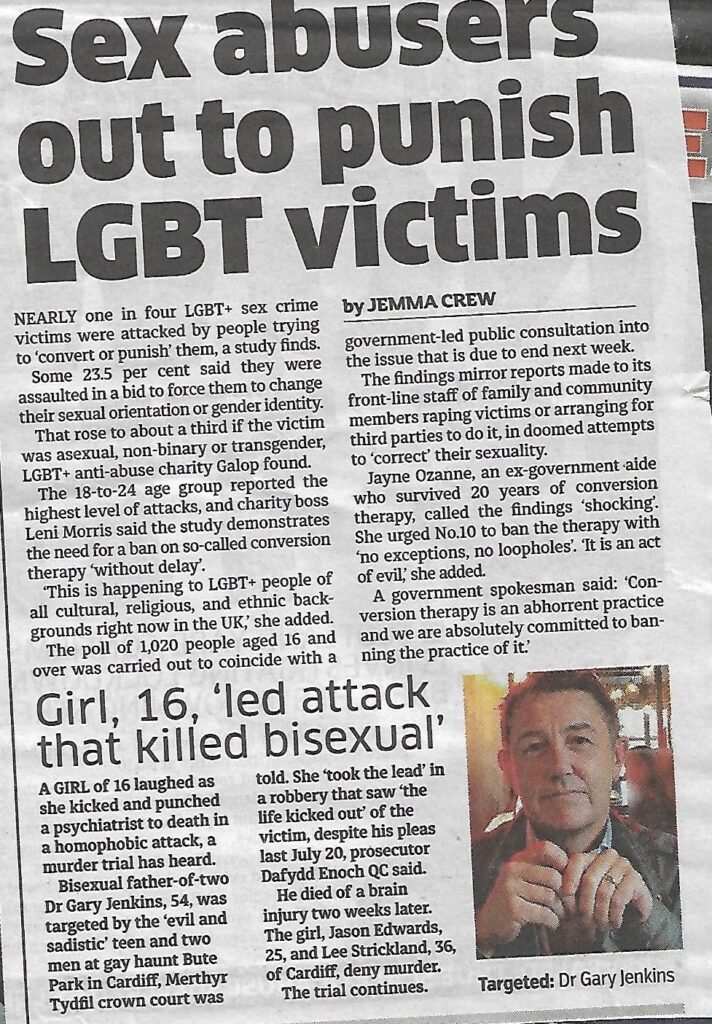
Feminists have less problem with gays and lesbian’s because the former are non threatening to their sense of moral superiority and many feminists, especially TERFS , are Lesbians. However, the moronic masses can’t tell the difference between any of them, so hateful Rowling puts them all at risk.
The BBC’s website today took a swipe at the problems that transsexuals have finding love. I am not sure heterosexuals have too much luck either, considering marriage failure rate – and the declining take up of marriage by men who expect to get financially screwed or falsely accused of sex crimes and jailed.. Feminists have worked hard to destroy the idea of romantic love and the BBC have been mocking co dependency on todays web cast.
Writing as a rather elderly transsexual, I have been deluged by suitors from 40 years old upwards. Marriage and a second relationship with women, however, have disillusioned me regarding romance with anyone. Men appear too desperate to please me, intoxicated by my appearance etc , that I feel obliged to disillusion them. I have even had marriage proposals from men of substance.
But the real issue is that there are an alarming number of boys wanting to be girls and getting hormone treatment before they are old enough to know what sex is and how it relates to having children.
I had notions that I should have been female from a young age. However, I thought that it was a stupid idea and spent years debunking sex changes, on the principle that true science sets out to disprove an hypothesis.
Had my wife of many years not become increasing physically and verbally abusive, exercising such extreme coercive controlling behaviour that I tried to hang myself from a door handle, I would probably have done nothing more that write more than my one book on the subject, ‘Man.Maid.Woman.’
However, years of humiliation led me to think I should do something about it. The fact that so many boys are not waiting a lifetime as I did, ready to miss out on having children, tells us that this is more than brain gender. It is the outcome of feminised or missing fathers, along with an obsession with female superiority and victimhood.
My book challenged the idea of female brains in male bodies, but drew no conclusions other than the ‘heroine’ was going to have a hard time. People would spoil what she thought was a dream come true.
In my case, my old friends the ever vigilant police intruded , lying about me being a prostitute and worse, so revived old grievances concerning my complaints and told my doctors that I am a paranoid schizophrenic – which will be a subject for another book in due course. I know what it is like to be on the receiving end of LGBTQI hate crime.
One of the most amusing things about my story is that the police, during one of their many raids on my house, confiscated a computer with a novel in progress, called ‘The Woman Within.’ Deriving an idea from Kafka’s ‘Metamorphosis’ , the heroine of this book was putting herself at deliberate risk in order to have the woman within her murdered on a dogging site, because she had been made to feel so disgusted by herself, because of how moralising hypocrites, including police, had treated her.
My book text was passed on to the local mental hospital who added it to their paranoid schizophrenic bi polar delusional diagnosis ( sic ) , noting that I was ‘more likely to die by misadventure than suicide.’ They took my book draft as a kind of diary and plan to end my life.
That is the British Police CID in partnership with the local madhouse for you. I doubt these people have ever read worthwhile literature. The psychiatrists rely on one book, the DSM, Diagnosis, Statistics and Medication. The latter is a means of fitting any one into any box that suits their whim. They are yet another disgraceful aspect of the NHS.
The morons who killed Dr Jenkins are a product of feral Britain. They have a warped sense of morality, but this is not too far removed from the poisonous J K Rowling and the TERFS who ooze nastiness like puss. No feminist would choose to dress and make up like me.

R J Cook
January 24th 2022
TERFS argue their sainted sex is defined by ability to have and care for babies.
Mum sparks debate after slamming ‘selfish’ daughter for not wanting children
Emma Rosemurgey & Isabella D’Emilio
UK pulls some embassy staff from Ukraine amid Russian threatBen Foden’s wife looks seething as he is axed from Dancing On Ice
A mum who branded her daughter ‘selfish’ for not wanting to have children and carry on the family name has sparked an online debate.
The furious, self professed Gen X mum who blasted her daughter’s decision, resorted to having two more children herself to maintain the family bloodline.
Read More Mum sparks debate after slamming ‘selfish’ daughter for not wanting children (msn.com)
Feminism First A Comment by R J Cook
In the context of transsexualism, one has to challenge the vile hate filled anti male Trans Exclusionary Radical Feminists ( TERFS ). Persons like myself, identifying as transsexual female, need to have an open mind and question the assumed condition of gender dysphoria. I say assumed because there is no machine to plug into a brain and get a femininity reading.
Ironically TERFS themselves have done more to challenge the definition of what is female than any other group. Feminists high priestess famously said that a woman is not simply a man without a penis. She went on to assert that such male to female transsexuals (MTFs ) are failures as women.
People like Greer, herself childless, trade on the kudos of academic credentials. She has a PHd in English literature, so can call herself doctor.
After arriving in Britain as a stowaway, this rather tall privately educated school girl got odd jobs, like ‘Golly’ , a stooge on the Kenny Everett show, then joined forces with Rosie Boycott and Fay Weldon , following the success of the appalling anti male polemic The Female Eunuch. She fell form favour after declaring that ‘most rapes are just bad sex.’ This implied that female accusations were mainly female malice and revenge.
The feminist mantra is that women never lie about rape or anything else. It is all about keeping men in their place and sustaining the myth that all men are interested in is sex, by fair means or foul. In this pernicious world of sexual politics -where teachers are primary brainwashers – boys and girls are seriously confused.
Girls must beat boys and get the best jobs. Feminism first is their motto. men have to change to suit the blessed female agenda. These females have their daddies behind them , living their lives through them and adding to the process of messing them up. my late father did that to my sister.
In this grave new world, girls are not conditioned to be good mothers. Last week we heard of pop singer turned priest, Sinead O’Connor’s tragic loss of her 17 year old son. I had never heard mention of him because all we heard of Sinead was a feminist mantra and why she cut all her hair off and became a priest. Now she is in hospital.
She was , intentionally or not, a feminist icon. Females have been married to the state via women’s groups. men are becoming women. Women have become men with plastic penises. I have been deluged with men writing to tell me how much they desire me, even at my age, and that I know how to dress to please a man. I simply dress as women did when I was growing up. It is not rocket science. I am slim and fit because by the age of 14, I was running , not jogging, 60 miles a week, representing my club and county.
Sex can be brutal, men can be aggressive. Women are disingenuous, but the truth is glimpsed by the number of women who tuned in to watch Ross Poldark forcibly impregnating Elizabeth. Below is an example from one of my many male admirers responding to my images on here and pressing for a date. With me around, he obviously does not need Viagra. This is reality. Being a woman is more than just having babies. Male power is attractive to me and not something I want to put down or outshine.
I love the way you excite a man with the way you dress so sexy. You always dress the way a man fantasises how a woman looks to turn on her man.
>
> I rate you as one of the sexiest women I have seen. I love the pics of you in sexy stockings and heels . Gets me rock hard and erect want to pump my cock deep inside you
>>>>
>>>> Steve x

By 19, I was up to 100 miles a week, going on to represent my University abroad. My late sister, by comparison was lazy and not at all interested in exercise. She had 6 children and became obese. A remarkable precocious child, she rebelled after my father’s death , becoming pregnant by a married man while she was in the sixth form. She became very resentful of others and would have made a perfect feminist. Luckily for her, her man stood by, caring for until the end.
Women are not angels or automatically victims. No one calls the men who were forced off to fight two rich man’s world wars victims, with women taunting the ones who wouldn’t go , with white feathers. World War One deserters faced the firing squad. But the class dimension must never be noticed. feminism suits the ruling rich class’s purpose.
Increasing numbers of women are either incapable of having babies or don’t want them because they are on the dead end career track. On the other side of the coin, men are increasingly aware that having children will either enslave them to the liberated women they have fertilised, or they will end up on the streets, vilified and separated from the children their whimsical women will have turned against them.
Powerful women in the House of Lords and their male sympathisers, are pressing to alter the new Police Bill to make women’s perception that men don’t like them a criminal offence, At the same time , there are so many anti harassment and opportunities for women to make ex post facto allegations against men. that men are avoiding them so won’t know them well enough to offer an opinion. I am excluding BAME from this analysis as I know too little about them.
So excluding MTFs from our claims to be women, on the basis that we cannot have children, ignores the reality that increasing numbers of women aren’t having them and that those who do could not do it without men’s sperm.
Statistics suggest that females are more likely to harm children and commit domestic violence on par with men. However ,they are excused because it is always a matter of them being provoked by men or suffering from a syndrome.
Hopefully, science will learn how to manufacture eggs and sperm to create a proper ‘Brave New World.’ Then children can be brought up outside the bounds of the horrible internecine class led gender wars. In the meantime, transsexuals like me, would gladly have had children and made a better job of bringing them up than the modern egotistical young women of today.
R J Cook
ITV For The Love of Dogs: Paul O’Grady’s life off camera from famous husband and Strictly star neighbour
Sylvie Wilkinson
Paul O’Grady is arguably one of the best-loved comedians of his generation.
Known for his drag queen persona Lily Savage or for hosting The Paul O’Grady Show, the actor and comedian has been keeping audiences entertained for decades.

January 17th 2022
Rupert Grint news: Actor compares JK Rowling to ‘aunt I don’t agree with’
Daniel Falconer
Rowling has been in the news for what some would describe as all the wrong reasons, as of late. She didn’t take part in any new filming for the Return to Hogwarts anniversary special that aired on Sky at the start of this year, leading to many jumping to the conclusion that it was her stance on trans rights that led to that decision.
Chatting with The Sunday Times, the 33-year-old actor explained: “I liken JK Rowling to an auntie. I don’t necessarily agree with everything my auntie says, but she’s still my auntie. It’s a tricky one.”
Grint is likely referring to some of the tweets that Rowling has put out, as well as others she has retweeted and liked, that trans rights activists say hurt their cause and in turn, the lives of those who are trans.The author had previously tweeted: “If sex isn’t real, the lived reality of women globally is erased. I know and love trans people, but erasing the concept of sex removes the ability of many to meaningfully discuss their lives.”
Read More Rupert Grint news: Actor compares JK Rowling to ‘aunt I don’t agree with’ (msn.com)
Rupert’s Auntie Transphobe – Comment by R J Cook
If my uncle had been Adolph Hitler I would not have boasted about it. I had some eccentric aunts, including a German who survived Nazism. Aunt is like the ‘mummy’ word, a comforting sound. That’s why the BBC earned the nickname ‘Auntie.’
Auntie J K is clearly, like all feminists , obsessed with her breasts and vagina. Her words make clear that they define her existence , her perceptions and concept of how the world sees and interprets her behaviour in every sense. She shows no intellectual curiosity about the transgender phenomena and how it relates to the feminist world where Terf lesbians present a rather masculine appearance and many show sexual interest in other women. Don’t they present a danger in ladies lavatories ?
The global success of her inane works of illiteracy, with all its long winded garbage speeches from posh over confident insufferable boys and girls is testament to a moron culture. Hermione is my Bette noir in this fantasy. Rowling ( Rambling ) is not anything like intellectual, but she rants as if she is. She simply harmonised with dumbed down Britain where identity problems are far more complex than gender.
The outcome of her harmful egotistical psychotic paranoid comments about trans ladies being penised individuals lurking in ladies lavatories, are simply quite lunatic. If I suggested that TERF lesbians are deranged wannabe men, that would be instant hate crime. But Rowling infuses her comments with pseudo philosophy about lived life experience, blatantly stating that if you deny her sexuality of sis womanhood, her and all women would not know who they are. So much for equality if that is true.
Many years ago, I read Simone De Beauvoir’s ‘Second Sex’ -the French version. Her agonies regarding woman hood could claim to be intellectual, with specific life references, , not blurring all women as a blob confined in one eternity and space underpinned by her work with existentialist John Paul Satre, one of my formative influences.
I wrote an essay on De Beauvoir’s work regarding ‘woman as other.’ Rowling is not in her league. She mistakes Harry Potter for a work of literature and genius. It is not. By today’s standards it is quite simply mind numbing and a good fit for a dumbed down world of anti psychotics. Reality is not popular. Her wider ramblings are quite simply hate speech as she tries to gain fame for a wisdom and wizardry beyond the mire of Hogwarts and its irritating inmates. R J Cook
January 15th 2022
The Penised Individual.

R . J Cook
British activist and model Munroe Bergdorf has made history as the first transgender woman to appear on the cover of Cosmopolitan UK.
Posting the news to her Instagram, Bergdorf: “I can’t believe I’m writing this… BEYOND excited to share that I am @cosmopolitanUK’s covergirl for their 50th Anniversary Issue!
Most Beautiful TG Women – Bing images
January 12th 2022
Council threatens to fine preachers up to £5000 – with caustic comment by Miss Roberta Jane Cook.
Philip Bradfield
Voice training for Trans Women Vol 1 – Our Trans Journey – YouTube
Voice training For Trans Women Vol 2 – Our Trans Journey – YouTube
Voice Training For Trans Women Vol. 3 – Our Trans Journey – YouTube
Video footage shows a PSNI officer citing “hate speech” before arresting 44-year-old Ryan Williamson in Larne in August, which he is because of stance against homosexuality. He was released 30 minutes later pending a report to prosecutors.
Read More Council threatens to fine preachers up to £5000 (msn.com)
As a transsexual, I obviously cannot condone this kind of behaviour. Like Muslims and feminists, especially the Terfs, bigotry is part of their state of being.
In spite of mass education , mass ignorance and bigotry holds the balance and is actively encouraged by World elite Governments, including in Africa and the Islamic World. Islamism , Feminism and BLM appear to be cornerstones of multi culture – the Three Pillars of Bigotry..
In this context, LGBTQI is an anomaly. Terfs and Muslims hate transsexuals and billionaire Harry Potter author J K Rowling has felt free to condemns all transsexuals as the sort of weirdos who sacrifice their penises, wear dresses, make up etc just to hide in ladies lavatories to commit rape.
She has been no given threats of punishment for her international hate speech. Many , like her, believe transsexuals are just another form of transvestite. Others, like the hate criminal police who arrested me , lying to the Gender Identity Clinic that I had been convicted for prostitution and other disturbing crimes, are so moronic that they think transsexuals are gay.
Nowadays these people do university degrees in how to profile ( fit up ) suspects, ending up allowed to impress with the letters BSc after their names. The U.K police force include some of the most psychotic and prejudiced people in the country. So where do you draw the line on the matter of free speech ?
Muslims and police have been allowed to vent their prejudices and condemnations for years. What makes these two sad God fearing young men any worse ?. Drowning men will clutch at straws and heterosexual white men have been whipping boys for far too tong – it is getting worse. They crave a sense of identity but are the excluded ones. R J Cook

January 3rd 2022
The Last Straw by Roberta Jane Cook.
“Paranoia Strikes Deep, It Starts When You’re Almost Asleep……..
Step Out Of Line The Man Come & Blow You Away “
Buffalo Spring Field
Videos of Paranoia Runs Deep Buffalo Springfield


As readers will have observed from various pages, the police have assumed responsibility for my health care ( sic ). Their malicious lies culminating in a letter to my GP , deliberately misleading that practice into believing I had sent porn videos and photos of my ex wife to sensitive parties, along with outing myself as a gay whore, with the deliberate intent of furthering malice about me being an insane alcoholic, when I was in fact a writer and truck driver, are the last of many straws. I was also a musician and song writer until being forced into heavy manual work seriously damaged my hands.
The police , via CPS, repeated their lies in court last September and October. They still refuse to provide evidence for their ongoing malice. Consequently , my sex change surgery and medication was blocked due to police interference and the local mental hospital accepting their word as truth.
Interestingly , as the 2011 CD music cover attests, I had a very close relationship with a Woldingham Girls Boarding School Housemistress , Christine Halpin, also the school’s 9th year head. We wrote and performed at a variety of venues, achieving third place in a BBC song writing competition, between 2009 and 2011, when I decided to end my relationship rather than have Christine embarrassed by an imminent trial, caused by me using the internet to publicise certain issues with the police in order to uncover the corrupt reasons for the October 9th PNC Criminal Marker..
Back in February 2009, I had applied for enhanced CRB clearance to stay over at my friend Christine’s flat, an unlocked landing away from the girls dorm, at a school where parents were then paying £26.000 a year school fees. After 71 days, I still had not received CRB enhanced clearance. After complaining about a 71 day delay for a CRB paid and applied for by the school, my local police told me the were waiting for information held on the PNC, put there by West Mercia Police on October 9th 2008.
So i complained even more fiercely. Very strangely and suddenly I was given clearance, even though it transpired in May 2009 that the records included a PNC Criminal Marker. I cannot say more for legal reasons, other than I was free to roam the corridors and sleep in close proximity to the girl, as well as attending church wining and dining with the staff, including the head, every Sunday . This continued for over 2 years until I decided that I had to end the relationship for Christine’s sake..
Hopefully the facts here will speak for themselves. I have gotten into ever more trouble by persisting in trying to find all involved in this nightmare and t expose motive. This is not the first time the police have played the mental health card, in a situation that would have driven a lesser person mad years ago.
As for the Tricorn CD , it was the subject of my last ever BBC live radio appearance in September 2010, after which the police succeeded in totally criminalising me. They have blocked every one of my efforts to move on in life. Blocking my sex change , because it doesn’t suit their agenda, is the last straw. R J Cook


Image R J Cook Appledene photographics.
December 30th 2021
J. K. Rowling on freedom of expression ( Oppression )
September 7, 2017 | By Jim Stovall | Filed in: First Amendment, freedom of speech, journalism.
J.K. Rowling has a point of view:
Intolerance of alternative viewpoints is spreading to places that make me, a moderate and a liberal, most uncomfortable. Only last year, we saw an online petition to ban Donald Trump from entry to the U.K. It garnered half a million signatures.
Just a moment.
J.K. Rowling
I find almost everything that Mr. Trump says objectionable. I consider him offensive and bigoted. But he has my full support to come to my country and be offensive and bigoted there. His freedom to speak protects my freedom to call him a bigot. His freedom guarantees mine. Unless we take that absolute position without caveats or apologies, we have set foot upon a road with only one destination. If my offended feelings can justify a travel ban on Donald Trump, I have no moral ground on which to argue that those offended by feminism or the fight for transgender rights or universal suffrage should not oppress campaigners for those causes. If you seek the removal of freedoms from an opponent simply on the grounds that they have offended you, you have crossed the line to stand alongside tyrants who imprison, torture and kill on exact
by the same justification.
J.K. Rowling
What if we banned any writing about wizards?
That would probably work, wouldn’t it?
Thanks to FarnhamStreetblog.com: J.K. Rowling On People’s Intolerance of Alternative Viewpoints
December 25th 2021
Roberta Jane Cook Clinically Insane Fantasist, Utterly Delusional – Official Mental Hospital Verdict.
Dr Charlie Ramsay of Aylesbury’s Whiteleaf Mental Hospital judges Roberta Jane Cook Clinically insane. See below. More to come as Roberta studies the files.
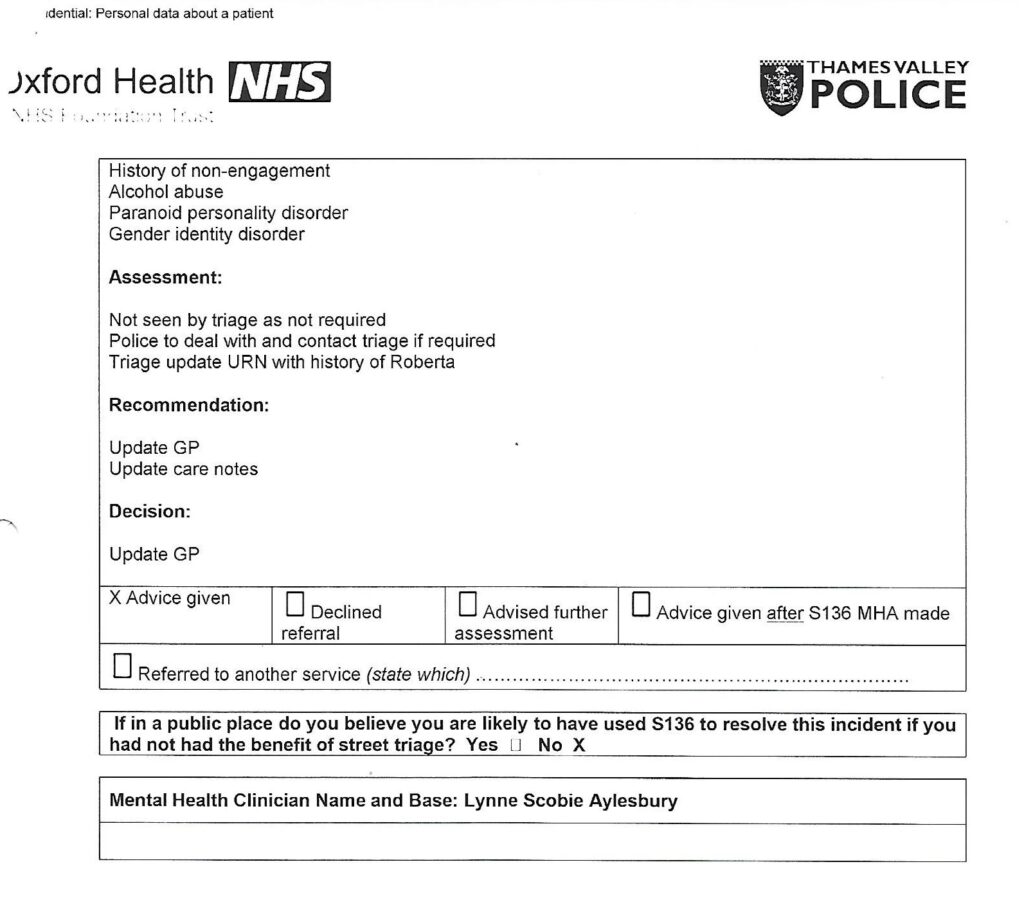
That is the police state Britain , fake democracy. I am living very dangerously. Transsexuals are supposed to engage with the psychiatrists and their drugs. The GIC says 90 % of patients are mentally ill but less prone to suicide if they change sex.
Ramsay is a weirdo ex Aylesbury Grammar School boy with an ego inflated having passed through Nottingham University med School. He needs to adumbrate his sources for saying I have a history of alcohol abuse and PPD, especially since he recommended for sex change.
His initial report will be published here tomorrow. The following picture was from poster advertising performance I did as Camilla Parka Rolls, as a comedian in Southampton, 2003. That performance is described in the book ‘ Man, Maid,Woman’ by R J Cook ( 2003 ) Note Charlie Ramsay has referenced my ‘care’ being a police incident. Police State Britain…
R J Cook.
- Man, Maid, Woman by Cook, RJ – Amazon.aehttps://www.amazon.ae/Man-Maid-Woman-RJ-Cook/dp/1904408044Buy Man, Maid, Woman by Cook, RJ online on Amazon.ae at best prices. Fast and free shipping free returns cash on delivery available on eligible purchase.
- Author: RJ Cook
- Format: Paperback

Image Appledene Photographics 2003.

Image R J Cook /Appledene Photographics.
December 24th 2021
Police State
I have read yet more interesting records with my GP clearly advancing the view of me being alcoholic in 2017 correspondence. It is no wonder they don’t want to make disclosures
.Something very odd here. There is clear evidence of mis gender and intent to reinforce alcoholism allegations, with a shoulder injury affecting hand movement being maliciously presented as peripheral neuropathy, a condition associated with alcoholism. The police skulk in the background with intent to pervert the course of justice and undermine Roberta’s female credibility. It all rather begs the question of why and how Roberta was ever recommended for the Gender Reassignment programme.
Clearly a damning paranoid personality schizophrenic diagnosis following an effectively 30 minute session imposed on me , after a 14 hour truck driving ,shift at my home, was prejudged – an NON appointed surprise visit from Ramsay , heavy set mental health nurse and medical student, Ramsay’s PPD Bi Polar Schizophrenic abnormal psychology diagnosis was uploaded onto my medical records 3 days after this visit. I was told today by Isacc of Whiteleaf that this was good practice and my complaint was dismissed.. The question is why ? This is intolerable. What s the source of ‘the drinking pattern ‘ allegation ? R J Cook.
December 23rd 2021
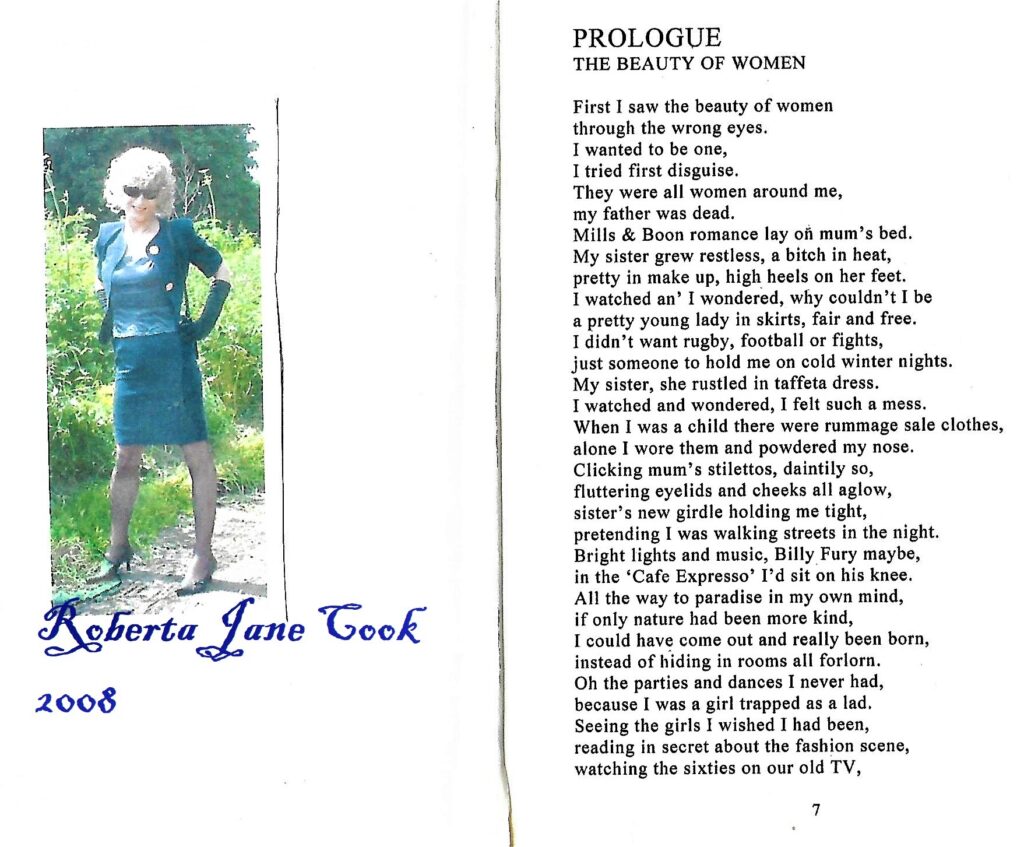
December 17th 2021
More Lies From Norden House Surgery, Recorded to Stop My Sex Change Treatment.

Dr Dickson , Principal of their practice is very involved in a so called ‘multi agency approach’ which is obviously about covering their gross medical misconduct. Dickson’s Norden House Practice signed off on several medicals certifying R J Cook as not mentally ill or alcoholic, presumably like the local mental hospital’s Dr C R Ramsay, believed the truck driving to be an other delusion rather than an economic necessity caused by police destroying Ms R J Cook’s professional credibility.
The whole situation, originating with my ex wife’s visiting my GP with allegations of me abusing my whole family and being so alcoholic that I would end up with my hippocampus failing and would be crawling around the floor .
It is odd that I went on to spend 14 years in haulage and warehousing , subject to regular breath tests, working 15 hour shifts. I also complted 8 books for publishers , one with Dr Celia Clark of Portsmouth University, on the subject of Brutalist architecture. When Ramsay called to fit me up as a deluded paranoid schizophrenic, he siad ‘I don’t want to see your books.’
Meanwhile , my ex wife enjoyed washing my youngest son while he was 20 years old, taking him to the toilet and the situation was very disturbing. And the Health people wonder why I wanted to kill myself. Violence against men does not matter. Police have admitted in writing that they refused to investigate my allegations because they just knew I was lying and abusing the complaints system.

I drove hundreds of miles , handling all sorts of cargo. I was working mainly in hospitality delivering food to hotels and restaurants for a firm first worked for in 2003. When lockdown killed it, I struggled to find another job because of malicious police records.
It is a joke that after less than an hour talking at me on March 19th, after I had been on the road since midnight, DR (SIC ) C R Ramsay , diagnosed me as a paranoid schizophrenic with bi polar -uploading it to my medical records on March 23rd 2019;
. But that is life in the British Police State. Clearly Norden House’s Dr Ramasamy is playing his role in undermining my female credibility for the purposes of helping police to pervert the course of justice. He is being called by me as a bound witness to court to explain himself, along with Dickson, Kamble and Sahota.
It is time highly paid doctors stopped asking for pay rises and applause and just got on with doing their job. Police involvement in mental health care is redolent of Nazi Germany. Ramasamay has lied ato harm my health care and that needs sorting out in court. No doubt he told the GIC what they wanted to hear, but Norden House were passed the message that I was as good as convicted in 2018 – this has even been repeated in court at Milton Keynes and Aylesbury Crown Court. Meanwhile, Norden House’s Principal in waiting wrote to tell me he needs police permission to make disclosure.
It has taken me several years to get any disclosures from my health records. Like the police , they are still holding a lot back and clearly I am still subject to an ongoing a PNC Criminal Marker. Readers might like to read more from my Toxic Transgender Clinic page.
I am in a unique position with the police who became involved in my divorce. I wrote up the interesting ‘Whore’s Tale’ about how Thames Valley Police, emboldened by a corrupt West Merca Police who ignored all rules regarding PNC Criminal Markers, part of which was based on a senior officer making sexual allegations that he needed enhanced security to stop me committing the sex crime of breaking into his house to abduct his 2 small daughters. If such a serious crime was given credibility in a police force area 150 miles from my home, then the rules should have necessitated an arrest. The offending West Mercia Police Force get around this by saying there are exceptions where they can ignore the rules. West Mercia Police were described as feral police force in a Mail on line article printed below this one.
This led to nearly 14 years of ongoing police surveillance so far and two consequent nearly successful suicide attempts so far, one after I won at trial in 2016, but police denied this saying they only didn’t win because the CPS lost the file they never had. I was devastated and it wrecked my new relationship because police lies were passed on to that partner under Claire’s Law.
In late 2017, an obvious malicious source sent letters and pictures of me relaxing on a friends bed. They were taken by that friend Oliver Lasio , who e mailed them to me on an account that only one other person had access to. The anonymous material carried an alleged source named as Oliver Lazar. The source of this material was attributed to me, and included allegations that I was working as a ‘gay escort’ for my son Kieran and his associates.
I had apparently sent them as revenge on him and because I am and. This case was kept open to avoid damages claim and to justify a lifelong PNC Marker on myself covering any vehicle I own or hire. It ended my truck driving life , pushing my son and I closer to destitution. Saying this is taken as further evidence of my paranoia. There is more on this in ‘The Whore’s Tale’ on the ‘Toxic Transgender Clinic ‘ page.
That is life in police state Britain. These malicious communications were never investigated because the police needed revenge for losing in 2016. They rushed to report my arrest as if evidence of guilt, to a willing GP and Whiteleaf, who informed a nervous and gullible Gender Identity Clinic. To cover themselves and justify secrecy, Ramasamay of Norden House sent the lie that I had asked to quit the sex change programme.

Even more bizarre they said I sent personal porn videos. I spent 6.5 hors in cells over this, property confiscated and documents confiscated. The police immediately contacted Norden House in February 2018 to state that I had been ‘arrested for malicious communication and working for my sons and his assoiciates as awhore.,. They contacted Whiteleaf mental Hospital and the Gender Identity Clinic to kill off my sex change unless I took anti psychotics, DR CR Ramsay.s made his assessment and it ws uploaded on to my recorsds 3 days later. His assessment took place after he forced his way into my home with 2 colleagues on maarch 19t 2019.
Now Ramasamay, another one of Norden Houe’s police lackeys and liars – taking advantage of the malicious ruinous PPD diagnosis – has told the Gender Identity Clinic that I was conflicted about my sex change and asked to come off hormones. What I actually said was about my concerns that If I continued with these hormones while the NHS combined to block me sex change surgery until I accepted anti psychotic drugs to cure me of ‘delusions about the police et al, there would soon be no worthwhile genital material left because hormones cause serious wastage , to perform effective genital reconstruction. I said that they should stop lying about me refusing a second opinion done properly and without constant reference to my police issues which they consider delusion because the police told them so.
Norden House’s Ramasamay, Kimble,& Dickson, Crown Court and GIC will hear more from me on Monday because they have also encouraged the court to mis gender me, massively helped by corrupt police. All they need to resolve this is make the disclosures. Their plan is to present me ad nuts during trial so all I say can be rubbished. It needs resolving. R J Cook

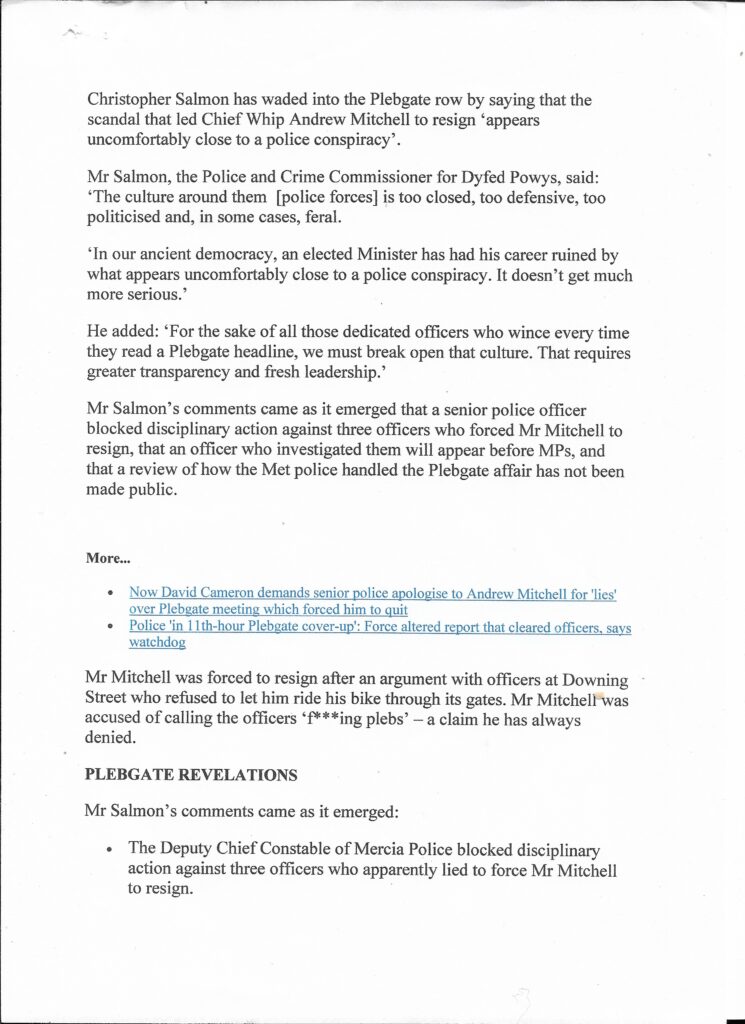

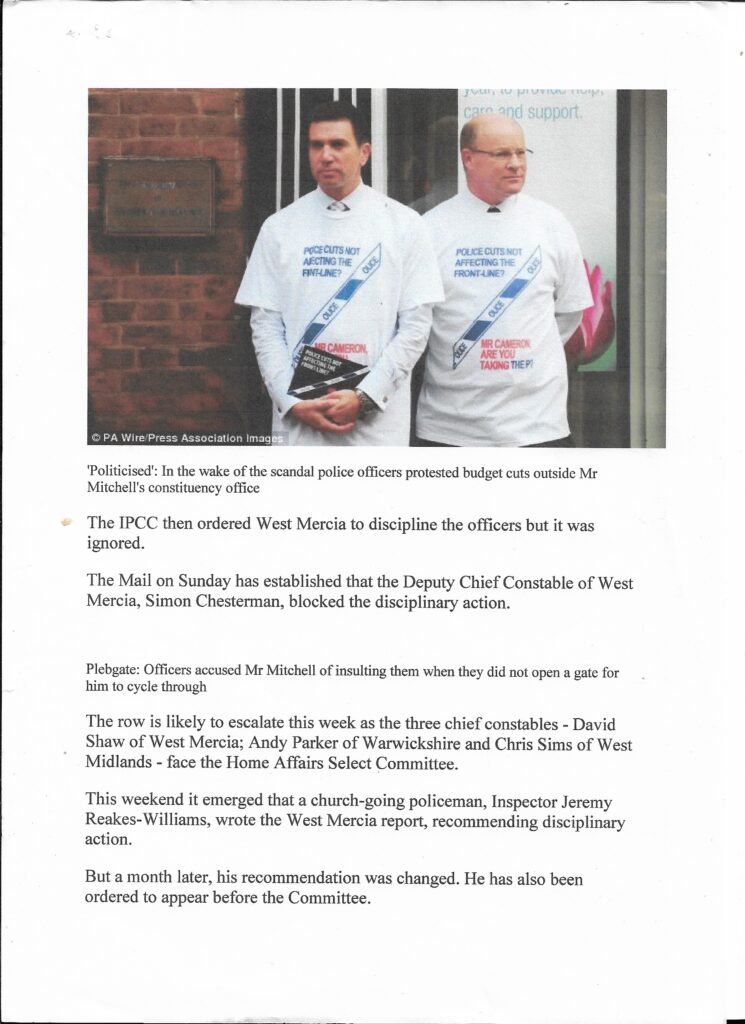

One could go on to the fascinating case of Inspector Bott, police woman of the year in 2003. But I’ll stop. West Mercia don’t like criticism. they react badly which is why they don’t improve, leading to the vile five year cover up of PC Monk, with a record of malicious tasering, killing a black footballer. I will publish their guidelines on PNC Criminal Markers tomorrow. They are fascinating reading. R J Cook
December 13th 2021
Roberta Jane Cook is mad – a paranoid schizophrenic delusional bi polar personality says Dr C R Ramsay and may need sectioning !
Below is an extract from my round robin reply to the local mental hospital’s letter to my G.P ( for international readers, that means local doctor ). That letter is posted after the next post.
I have been studying a mass of documents with court presentation in mind, including Roberston’s letter to yourselves copied to me. I note that you made a referral to Whiteleaf for me to be treated for complex needs. My refusal is being treated as yet more denial. Here are some basic questions :
1) Do you know what complex needs are about ? I do , but I want your version since you made this referral.
2) What information and assessment led you to this conclusion ? Also please explain the timing.
3) Since you have made clear on tape and in writing that you cannot divulge any records without police permission , I have to ask you whether this referral was related to police. Was it ? You have been party to the multi agency approach to my case for the last 2 years, with disastrous consequences for my sex change and so much more.
4) Do you understand that a referral to complex needs is not the second opinion re my damming PPD diagnosis for the Gender Identity Clinic ?
5) Do you know that during my last secretly recorded session at Whiteleaf it was made clear that it wasn’t going to be a a second assessment for the GIC to reinstate me on the GIC programme ?
6) This question cannot be published due to current legal proceedings , but has gone to the aforementioned health parties who will forward it to the police. It is a very serious point relating to high level police corruption.
7) Do you believe complex needs can resolve that ? If so , how ?
8) Why have I not been shown the report from my last Whiteleaf session , where the young psychiatrist stated it would take more than one hour to diagnose PPD, didn’t know how many sessions it would take, also that she didn’t think I was anxious or depressed but obviously had a plan ?
9) Did you know that Ramsay uploaded his report to my medical records ( without mention of a second opinion ) on March 23rd 2019 , having speedily diagnosed PPD , schizophrenia , bi polarism , delusion and abnormal psychology in a March 19th session from 12.30 to 01.40. This was when Ramsay and 2 others arrived without appointment after I had worked a 15 hour shift – as a Truck driver , over 400 miles, handballing cargo ? I still have shift records for court..
10 ) Do you understand that the police have consistently and seriously lied, most notably about October 2008 and 2018 and you have simply accepted it, thus becoming party to an ongoing conspiracy to pervert the course of justice ? This should have serious consequences for all of you , especially because of additional damage to my two sons life chances.

Transsexual First Problem – True Gender , December 12th 2021
I watched George Galloway’s Sputnik show on RT last night for the last time. There is much to admire about this man, but he is ultimately a Scots Catholic prude married to a Muslim lady. Religion has always been about control, not science, which is why Galileo was shown the wrack for saying the earth went round the sun.
Humans can’t progress with religious delusions even if it suits the global ruling elite. So on Saturday, George was interviewing an obvious male claiming to be transsexual. This effete person, who looked like a male member of 1960s band ‘Mamas & Poppas, ‘ argued that transsexuals should know their place and stop asking for concessions.
This drivel was prompted by a cellulite female caught in changing rooms in her underwear by ‘two six foot men in dresses.’ She was frightened and intimidated because they were obviously there to rape her. So she said. So much for equality.
This absurd situation is no more than what empowered unshaven feminist male clothes wearing man hating feminists deserve. ‘Action and Reaction are equal and opposite and that is about as good as the equality lunatics are going to get it.
Just because I wanted to be a girl as soon as I knew the difference – although not about the messy business of reproduction – doesn’t mean I was or am a girl or woman. Consciousness is a big mystery. Feminists want to argue with gender role on the one hand as being socially biased brainwashing, whilst claiming female superiority, special privileges and protection – which is no doubt what Sarah Everard expected by accepting the handcuffs and all would be sorted at the police station.
I have not time or current interest in explaining my thoughts about being transgendered. There are more important things to talk about than who I want to have sex with and how. i don’t like my genitals and they need control not to spoil my clotehs lines , but at lest the GIC have shrunk them.
It irritates me how the transsexuals walk into their LGBTQI boxes ( coffins ) interested , just like the terf feminists who hate them, talking only about their precious sexuality, rather than just using their new identity to contribute to wider issues like Julian Assange and true freedom.
Just changing sexual image is not an answer if you want to be part of the solution and not part of the problem. Which is a key reason why I would not have the anti psychotics just to get my surgery and enjoy a worthwhile se life.
There are more important things that come first , so here is my message to GIC’s Dr Kirpla Sahota, sex change was and still is important to me, but not because I am a stupid transvestite. I like style, I like being seen as the woman I was meant to me, but will die before compromising my principles. The GIC take their view on me from the police. That is because the U.K is a police state. That matters more to me than parading my true gender.
R J Cook
December 12th 2021
Policing Roberta Jane Cook – More Correspondence.
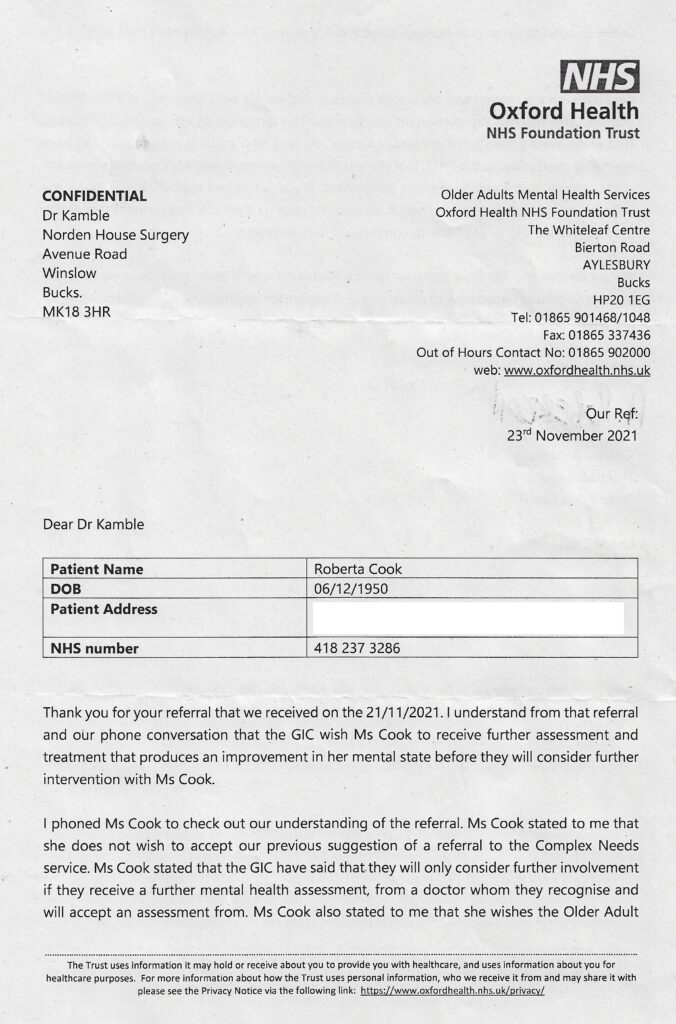
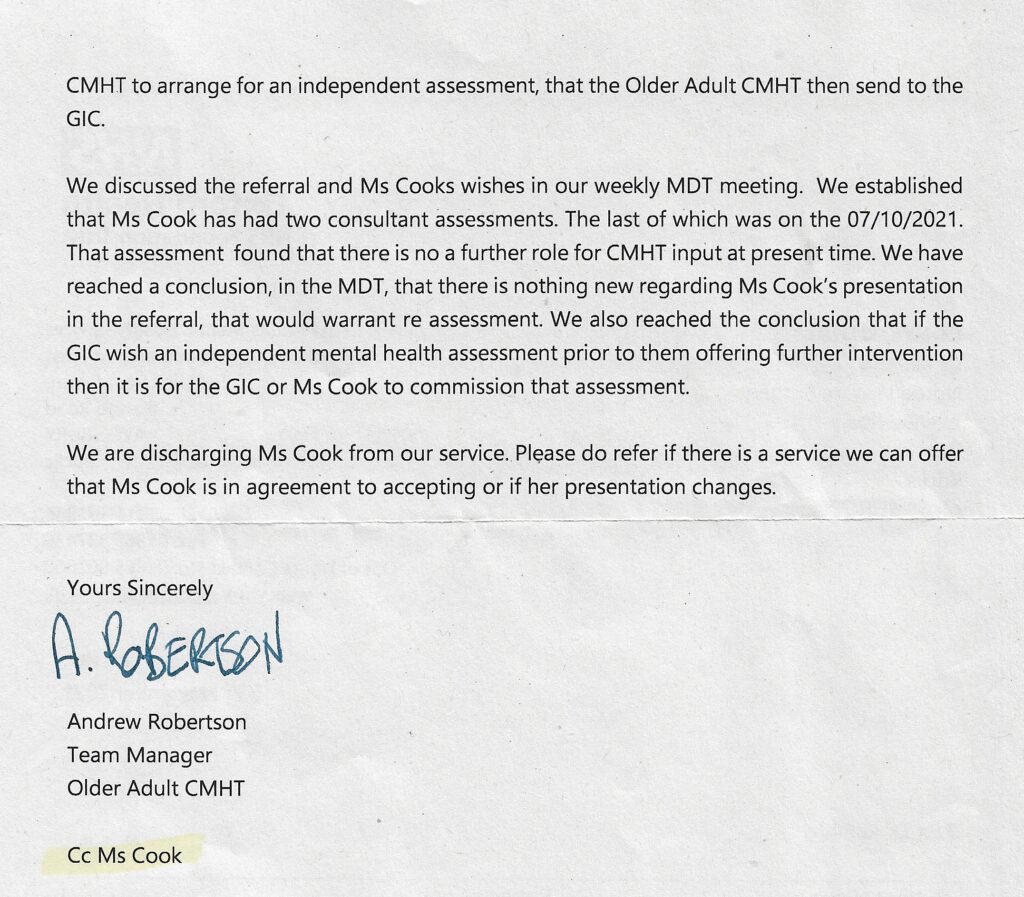
What’s Best For You , or For The Fascist U.K State.


I was working for Milton Keynes Press when I was called to this story, the screaming , crying and police shouting at the poor woman, before she was injected and sedated;.
Note the officers are male. It s getting worse as more people are driven made. After my last arrest, I was jailed for 18 hours before nearly succeeding in strangling my self under covers , in a dirty cold cell, other prisoners screaming and shouting causing distraction.
I was transferred to a mental hospital for 12 hours before being judged sane enough to leave. Waiting at reception for a taxi home, the psychiatrist DR ( SIC ) C R Ramsay – who wanted me sectioned -wandered by, wearing his Hank Marvin style NHS specs, white coat and white plastic apron. I challenged him about his lies and malpractice. His reply was ‘ I did what I thought was best for you.’.
Hillsborough said it all about U.K police who still got away with it . In my case , the police have returned to their default position, after they failed to get me judged clinically mentally ill in 2013. After a 2 hour consultation with a consultant forensic psychiatrist at Rednal Secure Unit, I was judged as not suffering from any known mental illness, not a violent or dishonest person When I asked him how he knew that, he REPLIED ;’ Trust me, I deal with violent people all the time.’.

Parents and teachers free to discuss children’s gender questions, promises Liz Truss – December 11th 2021
Edward Malnick
Covid live: 633 new Omicron cases detected in UK with overall daily infections at…Strictly Come Dancing 2021: the semi-final – live
Liz Truss has pledged that parents and teachers will remain free to talk to children about “whether they are transgender or not”, as she moved to quell a Conservative rebellion over plans to fast-track a ban on conversion therapy.
Read More Parents and teachers free to discuss children’s gender questions, promises Liz Truss (msn.com)
Comment I will we writing a longer piece on this subject tomorrow. Just for now, I must say that militant terf lesbians with male haircuts and clothes are just as big if not bigger risk to women in toilets. Those opinionated people seem to claim ownership and definition of all women, employing the outdated and absurd Marxian ‘false consciousness’ as stupid a piece of inductive logic as one could ever imagine. But they won’t accept trans people using it in the other direction because super feminazi women in media and public services, set the agenda and it is horribly oppressive.
Those harridans of all ages must be obeyed or face rape allegations for the way they talk to women. Why would men marry in this anti social atomised world ? Kill the sentimentality and the love. Love hurts way too much, none worse when you are a man and lose your kids because of a woman’s selfish lies. Why do men just accept all this vilification ?
I am not aware that many if any rapes happen in public toilets. They all seem to be ex post factor reports on date and marital rape. There aren’t many street toilets anyway. It is rather a sick fantasy some women have.
However, the whole subject of transgender, transsexualism and lesbianism needs more honest attention. The GIC’s methodology, of which I have considerable experience also needs a critique. Why are so many whites outing as gay, trans and lesbian in this age of high divorce and one parent homes ? Why are so many diagnosed mentally ill and committing suicide ?Our PC fake liberal feminazi society with it associated feminists academics and mang—s set the agenda. I will look at this more carefully in the morning. R J Cook


‘Policing Roberta Jane Cook’ – More To Come. December 11th 2021
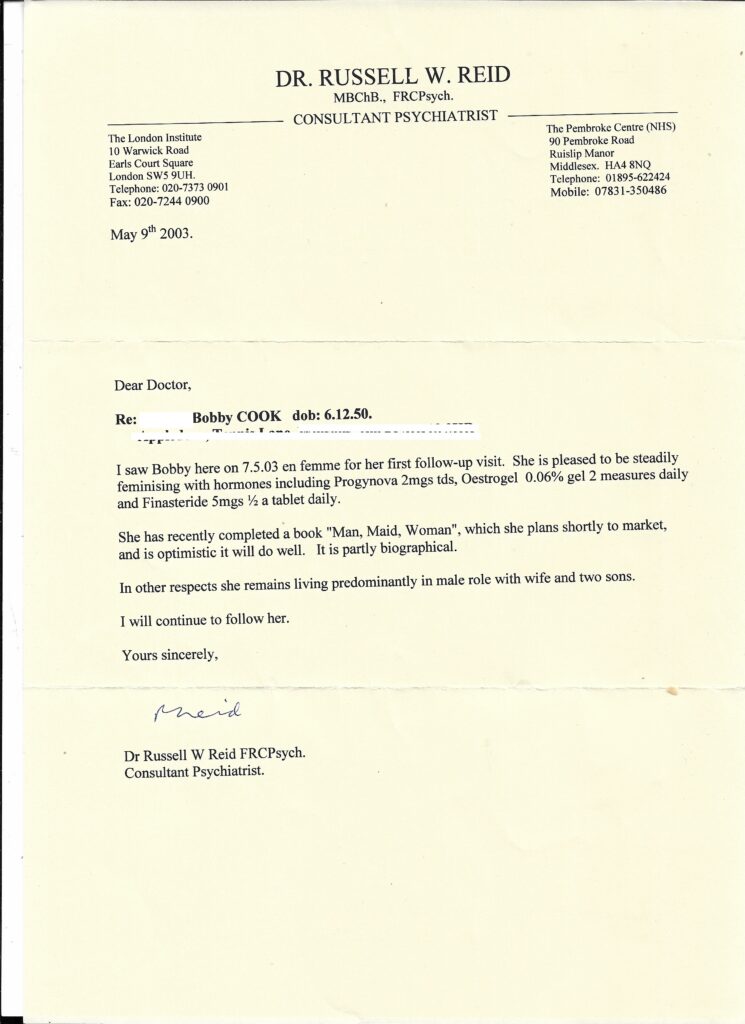

The Ideal – December 8th 2021

Image Appledene Archives,

Home > Female Hormones > Ultimate Gold Intense Range
Filter Products
Promotions
On SaleNewSpecial OfferFREE GIFTFree Lipstick & EarringsMore Options
Sizes
3 Months6 Months12 Months
Additional Options
OralTransdermal
Ultimate Gold Intense Range
Ultimate Gold Intense Range | Transformation
New Ultimate Gold Intense Male To Female Hormone Range. We are very pleased to announce that Dr Temperli has developed a new, more potent male to female hormone range for our 33rd year anniversary. Containing breast and nipple enhancement products for men who want to grow breasts. Anti Androgen, Male Hormone Blockers to block out testosterone, the male hormone. Oestrogen (estrogen) hormones for male to female transformation. Hourglass, bodyshaping hormones to give you that hourglass, womanly figure. In the form of capsules and gels New Ultimate Maxi Strength Gold Intense Male to Female Hormone Range offers you full male to female transition in a new and innovative way.
We are still dispatching orders worldwide as normal on a daily basis. We have plenty of stock and we are still available to answer all your calls and emails. Keep well and safe

(27) Product(s)
- Voice Training – Transgender Guidehttps://tgguide.com/transgender-resources/articles/voice-training/voice-trainingWhen you call a store to check the price of a new music CD, try out your female voice. Did they call you ma’am? When your female voice can pass on the telephone, odds are that you’ll have absolutely no problem in person. Methods of Transgender Voice Training. Warm Up Your Voice – Warm up your voice using a technique actors are taught. Start by saying the vowels (a-e-i-o-u) over-emphasizing them by …
- Estimated Reading Time: 9 mins
Knickers of Time – December 7th 2021.

Spare The Odd Copper.
December 6th 2021

Image Appledene Photographics / RJC
Any Doubts ?
If anyone has any doubts about me being transsexual, this picture , taken in 1986, should answer question. I am the girl on the left.

Roberta Jane Cook , with a man who most definitely did not have a gun in his pocket. He was just pleased to see me. posted December 5th 2021

Roberta was training over 100 miles a week by this time and a Bucks County athlete , going on to represent her university internationally. She also represented a top London Club, Southgate Harriers .Now , of course that sounds like delusion – like all my work , including journalism , trucking and writing books, to the likes of the malicious police and psychiatrists who have ruined my life. They have made clear that they consider my behaviour random and delusional. For interesting reasons they do not want to see evidence to the contrary. – or offer any to support their poisonous conclusions.
A very serious situation has developed between myself , The London Gender identity Clinic , Drs Dickson and Kamble of Norden House Surgery Winslow and Dr C R Ramsay et al of Whiteleaf Mental Health Facility in Aylesbury. I now know exactly how their so called clinical assessments, whereby Ramsay concluded, after imposing himself on me for 3 times 45 minute sessions at home, after I had been truck driving and hand balling freight for 15 hours, starting at midnight, that I am bi polar , schizophrenic , paranoid with a personality disorder.
God knows how I came to research and write so many books under contracts to publishers -8 since my divorce , along with music CD of songs written by me and recorded with my friend Christine. That is not to mention five years on City Link’s heavy pressured night shift , along with 9 years as a truck driver working from midnight. I now know that they have been directed by poison from the police which I am not not allowed to see because the significant quantity of files are marked ‘restricted.’ Due to current courts proceedings I cannot say more.
What this has to do with transgender is very simple. Due to police lies – recently repeated in two court hearings – about me being convicted for malicious communication of porn images and videos in 2018 – and much more – the GIC used Ramsay to make my continued medication and overdue surgery contingent on zombie anti psychotics. After 3 years of argument , I lost my temper so they discharged me from their care because I was allegedly rude on the phone because I was not allowed to talk to a clinician about my situation.
Whiteleaf have now chipped in , as a letter published on here attests, adding insult to the lie that I refused a second assessment. They have said that a recent secretly consultation taped by me, that this was the second consultation that they had said I refused in 2019 – 2 years after the event and in which the female psychiatrist said she was not doing it for the GIC and could not possibly diagnose paranoid personality disorder in one session. – stating that she did not know how many sessions it would take, but she did not want to see me again. An older male colleague was sitting quietly in the corner taking notes.
She also said , on tape, that I obviously had a plan and was neither anxious or depressed. It is quite astonishing. The background to all of this is an ongoing horror story for myself and my eldest son – the other son has not been seen or heard of since 2008.
R J Cook December 1st 2021
I have lived in fear since 2008 and it is getting worse. Anyone who thinks we live in a police state is obviously paranoid. Just keep on trusting the experts and the scientists. I am officially a paranoid schizophrenic delusional bi polar person. one doctor even suggested I have a brain tumour. They sent me for whole body scans.
My old GP Dr J P Fairfield , on one malicious party’s word, he suggested I drank so much I might end up having my hippocampus pack up and have to crawl around on the floor. I discovered today that this is all on the police record, I was an HGV driver until the NHS & Police multi agency approach to my sex change treatment notified my employer and got me fired in 2020. I was told in writing by Dr C R Ramsay , in 2019, that I would be upset if I saw all the records. I was being copied in to his report to my GP. That report blcked my sex change surgery unless I took powerful anti psychotic drugs, went to group therapy ansd accepted having a paranoid personality disorder, was bi polar , delusional and schizophrenic..

Police said they had been tipped off by Roberta that she was working as a whore for her son Kieran and his associates. She had done this to harm Kieran, sending some seriously weird stuff to six sensitive parties including 2 Chief Constables and one Deputy, then, immediately telling her GP to tell the Gender Identity Clinic that she was psycho and not fit for sex change surgery.
They repeated this lie in two court hearings last September and October, according to recent disclosures. Who is deluded here ? Who really sent the derogatory material and why is Roberta still not allowed to have copies ? That is Police State Britain.
Meanwhile , his GP partner at Winslow’s Norden House Surgery, signed me Roberta off as fit to drive heavy Goods vehicles – after I paid him £120 a go for medicals.
Roberta says ,‘I feel a song coming on. read in today’s Metro that migrants are coming here , risking their lives , because they want what we have. OK, from one tyranny to another. That makes sense. Must be awful in the mainstream Muslim world.’ November 29th 2021.

Roberta Jane Cook labelled clinically mentally ill , not needing hospital yet, by Dr C R Ramsay of Aylesbury’s Whiteleaf Clinic.. He lied that Roberta had refused a second opinion.
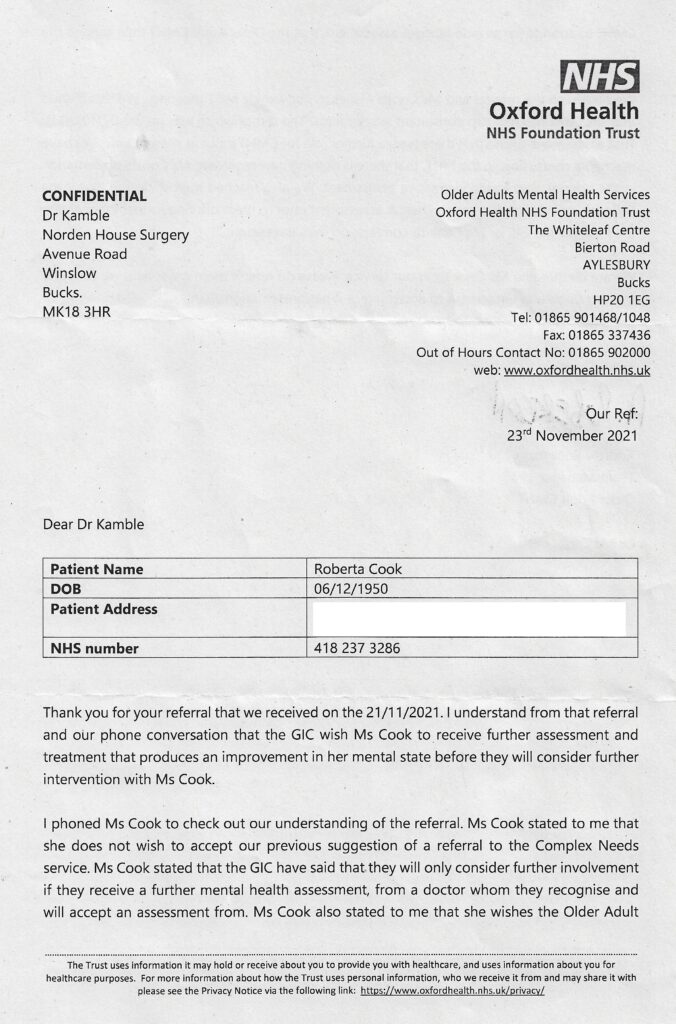

My old GP Dr J P Fairfield , on my ex wife’s word, suggested I drank so much I might end up having my hippocampus pack up and have to crawl around on the floor.
Meanwhile , his GP partner at Winslow’s Norden House Surgery, signed me off as fit to drive heavy Goods vehicles – after I paid him £120 a go for medicals.
I feel a song coming on. i read in today’s Metro that migrants are coming here , risking their lives , because they want what we have. OK, from one tyranny to another. That makes sense. Must be awful in the mainstream Muslim world. R J Cook.
Ramsay appears to have been acting on inform a tion that she had been arrested for sending porn videos , to sensitive parties including senior police, compromising pictures of herself and ex ‘wife’ along with anonymous typed letters where she accuses herself of being a ‘gay’ whore.’ she is apparently so mad that she sent this to 8 parties including 2 Chief Constables, one Deputy Chief Constable and a sergeant. It was pure malice. There is no evidence of police having investigated anything and is par for the course in a sequence of events starting in October 2008.
She was told she could not complete her sex change unless she took powerful anti psychotic drugs and that she would probably die by misadventure. The only nice thing the report said was that she did not need hospital yet.
These lies were repeated in court recently. The police have even lied that she was convicted. They offered no evidence of investigation. The trauma continues. Surgery and medication – which she has been on since 2017, was blocked after 3 years as a GIC patient. Police and the NHS persistently refuse to answer questions , the former having made on going contributions to her NHS health records. That is Police State Britain.
Céline Dion – The Power of Love (Taking Chances World Tour: The Concert) – YouTube
Whitney Houston – I Will Always Love You (Official 4K Video) – Bing video
Videos of Kenny Rogers Dolly Parrton the Gambler
celine dion videos – Microsoft Bing Search
- Céline Dion – The Power Of Love (Official Video) – YouTubehttps://www.youtube.com/watch?v=Y8HOfcYWZooCeline Dion – The Power Of Love (Official Video)Subscribe to the official YouTube Channel for Celine: https://smarturl.it/CelineDionOnYouTube Watch more mu…
7 TRANSGENDER VOICE FEMINIZATION MTF COACHING TIPS
By Transgender Hub – 16Share on FacebookTweet on Twitter

7 Transgender Voice Feminization MTF Coaching Tips
Let’s face it, even if you look like the most passable girl or woman in the world, the moment you open your mouth and speak is the time you get ultimately read as male or female. If you want to have an easier time as a transgender female then you really owe it to your self to develop your female voice and avoid those award and mostly inwardly embarrassing moments of being recognized as trans just because of the way you speak.
During my transgender transition I researched and uncovered seven steps to developing my truly female voice, I wanted to share these steps with you. Seven of them work on the femininity but the eighth is a “secret” method that actually makes your voice SOUND female – not just feminine! (This is discussed further in the Kathe Perez video study course referenced below).
Read More 7 Transgender Voice Feminization MTF Coaching Tips | TG Hub (transgenderhub.com)

| Hi there, This month on the blog we talk about the books, art and activism elevating us out of the politics of being transgender, and into the realm of possibility and positivity. Be inspired by the latest works of Jamie Windust, Alok Menon, and Juno Roche, and start thinking about what success looks like for you, and how to create it. |
| Ready to change your name and gender marker at your GP surgery and on your NHS records? It’s a simple process, yet sometimes even healthcare professionals are confused about how to do it. Take matters into your own hands with this short and sweet guide on exactly how we can help you change your gender marker. |
| We’re very excited about a brand new research study that has identified a massive improvement in mental health outcomes for young trans and non-binary people who receive gender-affirming care. About to go before the American Academy of Pediatrics itself, we’re thrilled to see increasing evidence in support of transgender healthcare outcomes. |
| Menopause affects over half the world’s population, including trans and non-binary people, yet they can often be left out of conversations and information targeted at cisgender women. We’ve prepared three blog posts explaining how the menopause and perimenopause might affect you as a transgender person, and suggesting how reproductive healthcare organisations can be more inclusive in their language: Gender-Affirming Care And Perimenopause: What You Need To Know Menopause and Hormones Facts: 5 Facts You Need To Know Inclusive Language and the Menopause |
| Our founder Helen Webberley’s isn’t the only healthcare professional putting herself on the frontline of the fight for quality in healthcare. Many healthcare professionals risk their careers, reputation, and livelihood to offer and improve gender-affirming healthcare, and we’re so grateful to all of them. In this article we summarise the latest anti-trans legislation as well as the projects and organisations campaigning for gender-affirming healthcare. |
| Have a wonderful month, The GenderGP Team |
Transported – October 26th 2021
I received these comments about me today , from a retired U S Navy Seal. I don’t deserve them and they raise questions, not about men’s sexism, but about men’s vulnerability to receiving and sending out images. I was aware of these issues when I wrote my infamous novel ‘Man, Maid ,Woman’ which I had to surrender a copy of to Inspector John O’Neill of Thames Valley Police who have done their best to label me insane..
- Truly every mans dream for sure.06:11PM
- me ?06:11PM
- Yes you look so so so incredibly SEXY and SMOKING HOT and CLASSY all in one in all 29 of your photos.06:12PM
- Men want you so so so bad. And want to SERVE AND WORSHIP you nonstop FOR SURE.06:15PM
- omg06:17PM
- Do you allow older gentleman to SERVE AND WORSHIP at all???

I am amazed. I never got this response as a truck driver or schoolteacher.


What ? by R J Cook
Told I had that woman within
That I had her original sin
To be guilty of what I had done
Guilty of having fun
Drove me mad, put me in chains
No need for them to explain.
Tie me up then turn me loose
With a rope tied into my noose
Leave me dangling on a wire
Keep laughing , my sex is on fire.
Burn us out, hide the shame of truth
Kill any still sign of our youth.
Turn us this way, inside and out
Make such noise don’ t hear us shout.
We are fish in a goldfish bowl
You are sharks to swallow us whole.
What is woman without Adam’s need
What is life if no one can bleed.
What is stone in a world without sun
Where so few can have any fun ?
What is love if we cannot hate ?
Why do you hurry when you can wait ?
What is time if without waste
You die because of your haste ?
Who asks questions but mustn’t know
Why you came and why you must go ?
What mother gave birth to 2 boys
Then drowned them in those toys ?
What mother would have her boy jailed
For her lies and all she has failed ?
I know but cannot say
If I do they will lock me away.
R J Cook October 26th 2021

Transparent – Roberta Cook Gets The Brush Off As Court Action Starts- September 24th 2021
Dear Ms Cooke, Further to your request, we have sent you a copy of your clinical records. The assessments you have had at the clinic, together with your lack of insight relating to your communication style, leads us to believe that you currently do not meet our inclusion criteria, therefore we are currently unable to help you with your gender treatment. Recently you have been contacting the clinic and have been abusive to the administrative staff. Our staff have a right to go about their daily role free from abuse and harassment. We are unable to tolerate this type of behaviour. For these reasons, we have discharged you back to the care of your GP whom we have copied into this email. We will not be in a position to respond to your telephone calls or other communications from you going forward. Please be assured that if your GP advises us that you are able to engage with treatment in the future and re-refers you to the clinic, we will be happy to offer you a prompt appointment without the need to wait on our external waiting list and will be able to continue your care. Best wishes, James Barrett BSc MSc FRCPsych Consultant Psychiatrist in Gender Dysphoria Medicine / Lead Clinician Copy: Dr Campbell Norden House Surgery Avenue Road Winslow MK18 3DW Gender Identity Clinic Lief House, 3 Sumpter Close Finchley Road, London, NW3 5HR Tel: 0208 938 7590 www.gic.nhs.uk Appledene Tennis Lane Winslow Buckingham Bucks MK18 3HR
![]() robertajane.cook <robertajane.cook@btinternet.com>To: CLINICALADMIN, Gic (TAVISTOCK AND PORTMAN NHS FOUNDATION TRUST) gic.clinicaladmin@nhs.net; gmc@gmc-uk.org; nordenhouseadmin@nhs.net;24/09/21 15:543 Dear Sir/Madam,
robertajane.cook <robertajane.cook@btinternet.com>To: CLINICALADMIN, Gic (TAVISTOCK AND PORTMAN NHS FOUNDATION TRUST) gic.clinicaladmin@nhs.net; gmc@gmc-uk.org; nordenhouseadmin@nhs.net;24/09/21 15:543 Dear Sir/Madam,
It is nice to finally receive a message from someone senior who actually works at the GIC. This is the first direct response from the GIC to anything that I have tried to discuss for the preceding three years – since my last consultation – so well done for that at least.
However it does nothing to answer any any of my extremely clear questions and concerns in relation to my original diagnosis, treatment at the GIC and its unexpected halt in 2018 due to a yet to be explained PPD diagnosis. My clinical records also do not explain the close relationship between the GIC, Norden House and other agencies involved in my so called care. Why all the secrecy if everything has been done properly?
It is quite clear to me now that my gender diagnosis – and treatment at the GIC – has been heavily influenced by outside persons and agencies to the detriment of my health and wellbeing in the short, medium and long term. It would be helpful to me if you could admit to all of the outside contacts that the GIC has had in relation to me and the insistence at my last GIC consultation that I needed to accept the mind numbing anti psychotic drugs that were on offer. How could I have a secure female identity but also be clinically insane at the same time due to PPD?
In relation to my clinical records I have for the last three years been specifically asking for all correspondence relating to the outside agencies that have intruded in my medical care. Where – for example – did the GIC get the idea in 2018 that I was going to die by misadventure?
When I last spoke to your clerical staff I was not abusive. My frustration with the GIC’s ongoing refusal to be honest and transparent in relation to my so called care came out. I remain extremely unhappy with the GIC’s conduct throughout my so called treatment and care. I simply asked for a senior clinician to formally put in writing to me the full reasons for an explanation of the end of my hormone injections.
There are medical ramifications for the cessation of my hormone treatment. I am no longer hormonally male but neither have I progressed to being fully female. I have been chemically castrated due to your medical negligence and related complete lack of transparency in my care. My hormone levels of both testosterone and oestrogen are both dangerously low. This puts me at greater risk from all illnesses – including cancer.
In reality my discharge from the GIC effectively took place three years ago in the wake of my PPD diagnosis. Yet I still have not been informed as to where – or by whom – that diagnosis was made. My presumed lack of insight is the outcome of a prolonged period of GIC refusal to be honest with me in relation to my so called medical care.
You have consistently ducked out of the issues that I have tried to raise with yourselves. The message attached to your email is an inadequate explanation as to why you will not disclose all of the correspondence between yourselves – and other persons or agencies such as Thames Valley Police and Norden House.
As the subject of a controlling far from reasonable multi agency response I want to know precisely what the GIC was told by Thames Valley Police via the interesting letters sent by Dr Roger Dickson. Full disclosure is required from you – a legal obligation under the 2018 Freedom of Information Act.
All you had to do – from my desperate pleadings yesterday – to reinstitute the hormone prescriptions and injections – or give an explanation as to why you would not. My health has been massively affected by the preceding three years of GIC evasiveness. You cannot legally – or medically – escape your responsibilities this easily.
By the way there are a number of errors on the attached letter: my surname is COOK not Cooke and the Norden House GP’s name is wrong.
Thank you for your time and attention. I look forwards to hearing from you at your earliest convenience.
Yours sincerely,
Roberta Jane Cook
—— Original Message ——
From: “CLINICALADMIN, Gic (TAVISTOCK AND PORTMAN NHS FOUNDATION TRUST)” <gic.clinicaladmin@nhs.net>
Comment In March 2018 the London Tavistock Clinic effectively discharged me from their ‘care’ because I refused to take anti psychotic drugs. They had been persuaded that my concerns about nearly 14 years of police harassment were delusional. It seems that out of the blue they had concluded that I needed to take them along with a psychiatric assessment that was preloaded in favour of that diagnosis.
These precious people obviously believe that ignoring all of my requests over 3 years to explain their sudden resort to a paranoia diagnosis without explaining where it came from is less important than so frustrating me in two phone calls, along with ignoring all of my 3 years of e mails is more important. The physical and psychological impact of their misconduct has been massive. To argue that I do not meet their criteria now is ludicrous. I should have been free of them by now, with GRS complete.
They now have the audacity to tell me that they have sent my clinical records to Norden House, the very people who passed on derogatory information about me , from a third party that was obviously the police to the GIC. Norden House are another party who refuse to make disclosures crucial to my defence in a forthcoming Crown Court Trial, without the hormones that I have become dependent on. This is police state Britain.
Roberta Jane Cook
Should Children be allowed to choose to change sex ? – September 19th 2021
Feminists will grab any opportunity to rubbish sex change as a form of mental illness and / or perversion. So I am going to write as frankly as I dare. This blog post is a response to the article that follows it. I am also posting pictures of myself aged 8 , 12 and 21 , to reinforce my points. Talking about gender reassignment rather than sex change rather hides the reality.
Humans are sexual and gender or sex change has to account for that as part of any gender switch or readjustment. I already knew I wanted to be a girl when the first picture was taken but did not like the idea of sex as it was explained to me by the dirty minded council house kids at school. That did not stop me from wanting to get rid of my male sex organs , then wear appropriate underwear , petticoats and dresses – and of course grow my hair long.
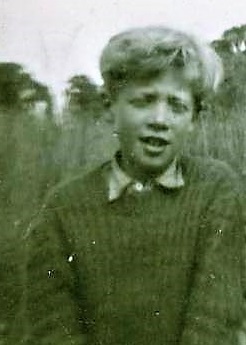

Image Appledene Photographics
I recall the first time that I was mistaken for a girl. I was still riding in my push chair , dressed in a blue siren suit, with white blonde curls peeping out of my bonnet. Mother didn’t want my hair cut short and nor did I. When It was winter and I toddled into Winslow Post Office one of my mitten covered hands clutching my mother’s hand. The kindly lady behind the big old wooden counter, Doreen Tofield by name, leant forward to say, what a beautiful child. Is it a little girl ? I preened, recognition at last.




So , looking back on my life, my need to change my gender identity and live as a heterosexual woman never faded for all of my attempts to suppress it. Getting married seemed the right thing to do. Had it not been for issues over bringing up our children and interfering in laws , it might have survived longer than 31 years. But it was never a relaxed union. I won’t go in to detail because my point here is that for some people , like me, gender dysphoria is very real and serious.
The major problem is , how on earth can it be diagnosed by separating it from fetishism and delusion. It can’t be measured and accounted for as a virus, and to many bigots it is like the ex mother in law who said to me ‘You’re sick and in need of help.’ This is not an uncommon attitude , with many morons not able to distinguish between transvestitism and transgender. It is quite simple really. The latter is about one’s body , though obviously many of us want to dress , smell, and make up as nicely as possible. The former is just about clothes and , presumably masturbation.
Feminists are trying to cloud the issue of sex changes rather than to undertsand , because they are all about power and status. The last thing they want is equal accountability. That is why they cn come out with terms like toxic masculinity and white male privilege , and women never lie about rape or abuse. If they do something bad it is always somehow a man’s fault leading or bullying them , or an act of righteous revenge.
These types don’t want to lose any of their scapegoats or have born males affecting to be of the premier virtuous perfect sex. These people of course are far from sexy , so not the sort of women I would like to be.
The opinion makers are the truly privileged ones. Their public sector and media positions makes them the gatekeepers and judges of right and wrong. The con is that people simply divide along sex and racial lines. I have enjoyed the company and passions of both sexes and other races. I see the LGBTQI like the old ‘form a square’ military strategy. For all of its usefulness , many will get splattered . The feminists like it that way , keeping us weirdoes in a box where we belong so they can hang on to privilege and the myth of moral superiority.
I don’t see anything wrong with my argument so far. But, if Transsexuals are not just a blob, then they must be assessed as individuals. How can you tell at the outset that someone like me who wanted to be a girl , from my first reflective moment of consciousness aged 3, who really knows ?
There is no easy answer to that. Parents who had longed for a boy or girl are understandably disturbed that the authorities can override them whatever they want to become of their child’s choice , blocking or supporting it. It is potentially a form of totalitarianism. It is further confirmation , if you needed any , that the state owns your child.
When I was a child in a family that became very materially poor after father died, the sexes were clearly defined. People dressed accordingly. So when my wealthy posh London aunt started sending parcels of her posh daughter’s skirt suits, full length satin and lace slips, bras , girdles , panties and suspender belts, they didn’t fit my ever hungry sister or suit my mother. I watched where they were put away.
No body noticed when I borrowed them. When I realised they were totally forgotten , I purloined them. Money from odd jobs paid for stockings and make up which I told the shop assistant were for my mother. In those days , stockings had seams which were so sophisticated. The beauty comes from attention to detail. It always came naturally to me , as it did in all the art competitions that I won.
Of course there were no sex changes on the NHS back then and when I eventually plucked up courage to tell my doctor I wanted to change sex, I was led on an over two year long wild goose chase ending with the police sending messages that I have always been seriously mentally ill. The upshot has been an ongoing threat of sending me to the madhouse. That point is important because those sort of people have now been handed the right to judge vulnerable people, mainly males, as fit or unfit for sex change.
The Kiera Bell story is being exploited by the anti sex change feminazis as evidence that all sex changes should be banned , for reasons already given. Girls like her opting to become boys are unusual because most girls get their male kicks dressing overtly in male clothes, having short hair and telling the world why they are better – many becoming lesbians. It’s hard if not impossible to give girls a convincing sex change and few want it. Surgery and hormones work best on boys because something is being removed , not added. However , girls are vulnerable to the notion that boys have it easy. That is official government and media propaganda and it is dangerous.
There are certain aspects of my historic mind and body which has always made my efforts to appear masculine difficult. It has taken me too long to be proud of those aspects, though they were useful to my music , writing , art , craftsmanship, and teaching – which police take note , ended when I quit in 2008 , not in 1996, so you are misinformed. My body was never designed to play football and my index fingers are longer than my ring fingers.
I used to be ashamed to admit to being female , which is why I was so quiet during my divorce. Now I am proud of it , although the police have and must yet account for the most serious damage they have done to my life and credibility. They have wasted nearly 14 years of my life and cost me two relationships with good men. I digress , but with relevance. The state is run for the elite’s benefit. I have said it many times. If the state wants you to know something it is probably a lie.
Men have been subject to increasingly negative state and media propaganda. Thames Valley Police have been told to make domestic abuse top priority with women always assumed to be the victim even if they acted violently in the first place. The majority of non Muslim boys now grow up without fathers at home and all this negative imagery. So it is quite possible that social factors are persuading little boys that it is not only better to be a girl , it is safer. Why worry about having kids ? There are surrogates and unwanted children. If you marry a woman you’ll probably end up losing your kids and anything else you have so why bother.
Changing sex , like all major health interventions can be dangerous. But life is very dangerous just as soon as you get in your car. I have spent years truck driving , covering many thousands of miles. I know how quickly life can end on the road. Mealy mouthed bitter power crazed women are a menace to justice on the sex change issue. Feminist writer millionaire ( or billionaire ) , J.K Rowling should have been prosecuted for her hate speech on transsexuals. If transsexuals in ladies toilets are a danger , what about the lesbians ? One could go on. Kiera’s case is irrelevant to the issue of anti androgens for minors.
The wrong questions are always asked , as the police know as pass masters of injustice, when the authorities have foregone conclusions. Being on the receiving end of nearly 14 years of police lies I know how awful and life destroying it is , and now my doctor is implicated in those lies , I obviously do not trust public servants. However, it is difficult to see any other answer to this problem. Far worse things are being done to children , like the mass prescription of anti psychotic drugs. When it comes to the mind it is always the state that decides.
Roberta Jane Cook

Appeal court overturns UK puberty blockers ruling for under-16s – September 19th 2021
Tavistock and Portman NHS foundation trust wins challenge over case brought by Keira Bell last year

Haroon Siddique Legal affairs Correspondent
The court of appeal has overturned a controversial judgment that children under the age of 16 considering gender reassignment are unlikely to be mature enough to give informed consent to be prescribed puberty-blocking drugs.
Read More Appeal court overturns UK puberty blockers ruling for under-16s | Transgender | The Guardian

Doctor’s Judgement – September 18th 2021
For nearly 3 years I have been asking my GP for disclosures regarding their response to and handling of malicious correspondence , concerning my mental health and other allegations, from Thames Valley Police. Yesterday, with a court hearing on Wednesday, I received very limited disclosures. significantly , my GP’s covering letter has now shifted blame on to me requesting my hormone treatment medication be stopped. this incredible considering that he had previously blamed the London Gender Identity Clinic for this appalling decision.
It now becomes abundantly clear that the police’s influence on the Gender Identity Clinic ( GIC ) was the cause of my long overdue Gender Reassignment Surgery being made conditional on an out of the blue diagnosis, without consultation, that I am psychotic and needed zombie drugs before I could be accepted for surgery. At the same time, the GIC’S Kirpal Sahota informed my GP that I have a secure female identity and was ready to take medication to prepare my body for surgery.
At that time , because malicious still undisclosed police records against me and my eldest son , for stalking a senior police officer and his family , so causing fear of violence, I was destroyed professionally. I had to fall back on my previous truck driving hobby. Fortunately my employers new the truth which the police were not interested in.

As a truck driver, I carried very serious and varied responsibilities. The head GP at my doctors’ surgery even routinely took money to sign me off as fit to drive HGVs with no drink , drug or mental health problems.
In March 2018 , following my last appointment at the GIC – I daren’t go back there because of what happened next – I was doing a long run into the West Country with a 1 am start. It took me an average of 13 hours on the road including drops and heavy lifting.
So early in March , two weeks after my last GIC appointment, I was back home from my driving shift -it took 30 minutes each way to get to and from work.
While i was relaxing with a glass of red wine before dinner and bed , ready for my next shift, we noticed a small car struggling to reverse from the lane into my drive. Three men got out. I expected another malicious police raid , following their efforts days before , to have me prosecuted as a gay escort’ working from home in a brothel, for my son and associates.
It was alleged that I had shopped myself by sending material to senior police officers et al. Obviously it was bullshit and all about undermining my credibility with my GP and the GIC. they also like to get in and steal my computers etc because they are paranoid about me. No doubt it remains on record as true but prosecution dropped for ‘lack of evidence’ – though they did prosecute me for swearing at the lead officer because he would not update or give my property back. Clearly I have much to blame my GP for.
The lead person of this uninvited trio was a geriatric specialist psychiatrist C R Ramsay ,who had previously backed my GP’s referral to the GIC. The other two were a big black affable mental health nurse from Zimbabwe , and a slightly built male medical student. There followed 2 more of these 45 minute sessions during which I struggled to get to speak. My wine drinking was noted as alcoholism. The last two sessions were with Ramsay alone at my insistence. He made clear that the GIC wanted a strong diagnosis to back their own – emanating from Norden House. He later went on record lying that I refused another opinion.
Ramsay’s conclusions were that I am suffering from a paranoid personality disorder, bi polar , schizophrenic and anti social. Interesting he noted that I talked too much even though I am supposedly anti social , by exhibiting what he called pressured speech. His report included the lines that I would be more likely to die by misadventure than suicide but did not need hospital yet.
He recommended a multi agency approach. This was already extant thanks to the police’s intrusion into my life and ongoing refusal to explain the devastating PNC Criminal Marker and soft intelligence created about me on October 9th 2008. Harassment , not honesty and investigation are normal to them as well as faking and hiding evidence. The fact that they now have their finger on the mental health button – in a society where so many are being driven nuts – should alarm the intelligent person.
So hopefully my handful of readers will understand why I am not happy with the following article. GPs have blocked me for GRS no good reason, apart from believing corrupt police lies. Who else will they block ? Who will they label mentally ill in the process. Our NHS Is nothing to clap about and the police , whose numbers included black footballer ‘s killer PC Monk , and murdering rapist PC Couzens , are institutionally corrupt. How many more nutters, liars and criminals lurk in their ranks ? Look at the length of the cover up for Monk , by West Mercia Police’s senior management.
I will write more on why I think children should be allowed to choose anti androgens , but there are risks if this goes on too long because there will be no material for GRS reconstruction – which has happened to me thanks to the police corruptly influencing my obsequious GP and the GIC.

Roberta Jane Cook
Doctors can ‘exercise judgment’ on puberty blockers without court approval – September 17th 2021
By Jess Glass,
By Jess Glass,
The Court of Appeal has overturned a landmark ruling over the use of puberty-blocking drugs for children with gender dysphoria, finding doctors should use their clinical judgment rather than needing a court’s approval to provide treatment.
Last year the High Court ruled it was “highly unlikely” that a child aged 13 or under would be able to consent to the hormone-blocking treatment, and that it was “very doubtful” that a child of 14 or 15 would understand the long-term consequences.
Read More Doctors can ‘exercise judgment’ on puberty blockers without court approval (msn.com)
Comment I will be making a comment and further observations on transgender later , speaking as someone who has very early memories of wanting to be and be treated as a girl from a very early age before I started school at under 5.
I was always playing dress up and with dolls. I have not, however, had a good experience of the Gender Identity Clinic because the police, with whom I have very serious issues, managed to ingratiate themselves with my GP who gave credibility to their poison, harming my health in the process.

Roberta Jane Cook
“Police Take Over Roberta Jane Cook’s Sex Change & Health Care ,Warning of Serious Psychosis & Paranoid Personality Disorder Is Claimed By Authorities Based On Police Lies & Corruption , In Another Blow To Shut Her Up & Block Her Latest Attempt For A New Life With Her Son” – September 16th 2021

Image
Appledene Photographic
I have had a near 14 year battle with West Mercia and Thames Valley Police over very serious complaints against them, which they continue to lie about ever having investigated.In a 2016 trial ,which I won, they had no case against my allegations so invented domestic violence allegations To this day they refuse to explain or disclose anything and involved themselves in my medical care, repeating allegations that I have been mentally ill for many years, refusing treatment .
My doctor’s surgery, headed by Dr Roger Dickson , accepted these malicious self interested allegations in 2017 , informing my GP that the GIC should not follow through with my gender reassignment surgery. I have known I needed this since I was a child, but tried to be ‘normal.’ The malicious decision has been devastating.
I had been on female hormones and anti androgens for over a year when this intrusion took place , along with treatment to remove facial hair. As you can see from the picture below , breast development was well under way when my hormone treatment and surgery was stopped until I accepted a psychiatrist’s opinion that I am a paranoid deluded schizophrenic. My maleness had shrunk to nothing and is dysfunctional , so much so that full sex change is now probably impossible.
By this time I had been arrested, locked up and interrogated for apparently shopping myself as a gay prostitute . I was assumed guilty , without investigation or evidence, of sending a picture of a total stranger and another of me laying on a friend’s bed along with typed letters to senior police officers at al , bearing a typed name Oliver Lazar, stating some very unpleasant things about me , This included that I was working in a brothel run by my son and hs ‘associates’ at our joint address. The case has never been officially closed -see ‘A Whore’s Tale’ on the ‘Toxic Transgender Page.’

I ended up in Crown Court in 2018 because of this act of police revenge for 2016. Their latest revenge has been to block my sex change treatment whispering lies in correspondence that I have not been allowed to see : that I am a deranged psycho pervert, not an accomplished writer , among other things. That is how police state Britain works. R.J Cook
I am now being taken to court for repeating my allegations on this site, allegations that were found not to be a breach of restraining order in 2016 , after 7 terrifying Crown Court hearings , where a long jail term was threatened if I did not plead guilty. Unexplained domestic violence was suddenly announced to up the ante. I cannot say more for legal reasons. Suffice it to say that there are strong elements of hate crime here – in weird hypocritical society that does not know the difference between a transvestite and transsexual – or a pervert or a writer.
So , aged 70 , I am told with no explanation that I have to start my treatment with London’s Gender Identity Clinic all over again subject to another assessment and the inevitable self interested conclusion that I am still most definitely psychotic and must take the zombie drugs that offer balance issues , bladder and bowel control problems and memory loss. So effectively making gender reassignment pointless because I would not know whether I was a mouse or a monkey – and most certainly not be able to live life as , or thus even know I was a woman. As for being a writer no hope. Dr C R Ramsay concluded that I might die more likely by misadventure. He said he wasn’t interested in seeing all my published books.
I first firmed up my decision to change sex in 2003, when my semi autobiographical novel ‘Man Maid Woman’ published on the subject. By this time I realised my marriage was a disaster and that being allowed to consider gender reassignment at an early age should be a human right. People like us know what we are and often over over compensate for fear of ridicule.
So I am now in the situation where my last blood test revealed almost zero oestrogen and zero testosterone making me vulnerable to arthritis , joint stiffness and depression. To add insult to injury, my official GP , Dr Kamble has cut my crucial thyroxine, without explanation by 25mg , again with side effects including lethargy, verbal confusion , weight gain hair loss and depression.
There are also brain function and cancer risks associated with the clinical malpractice of Norden House and corrupt police. I am officially subject to a multi agency approach to my alleged mental health problems – a view initiated by my ex in laws was family , during my divorce – a family which includes two police officers, one of which is a Chief Constable. In our fake democracy it seems one cannot argue with that.
As for the multi agency approach , it is three years since inception with no remedial treatment plan revealed , only a watching brief to undermine my credibility with the long term view of sectioning to hospital. All is shrouded in secrecy. The adage that if you have nothing to hide you have nothing to fear does not apply to police and NHS – who have insisted they will not make disclosures- only to us minions.
R J Cook


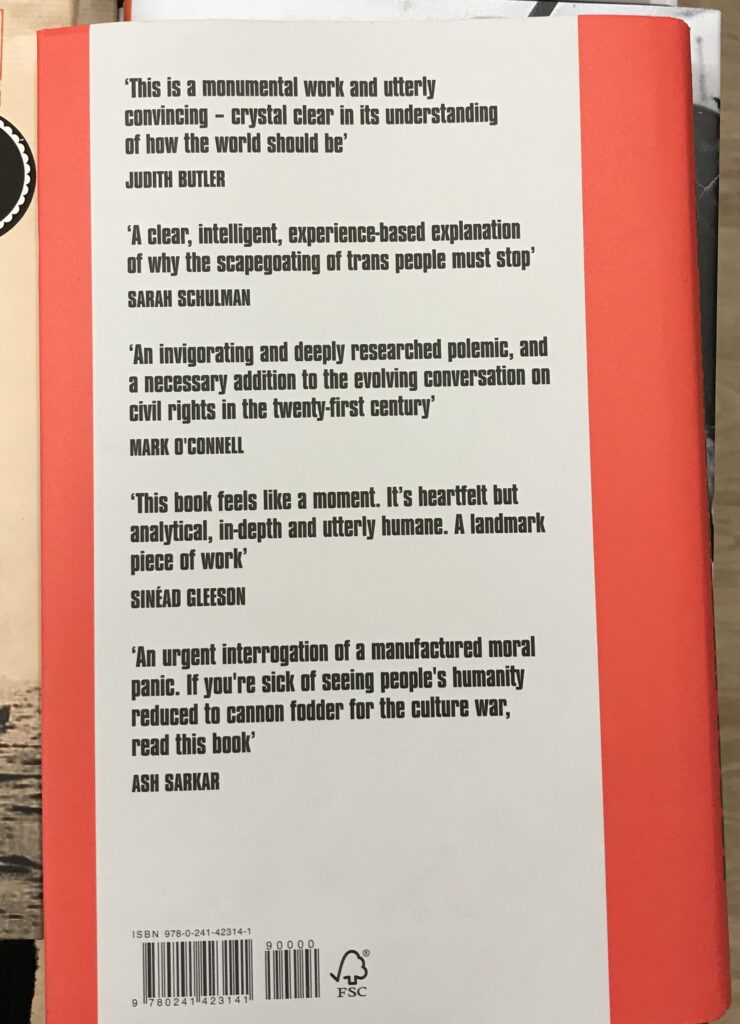
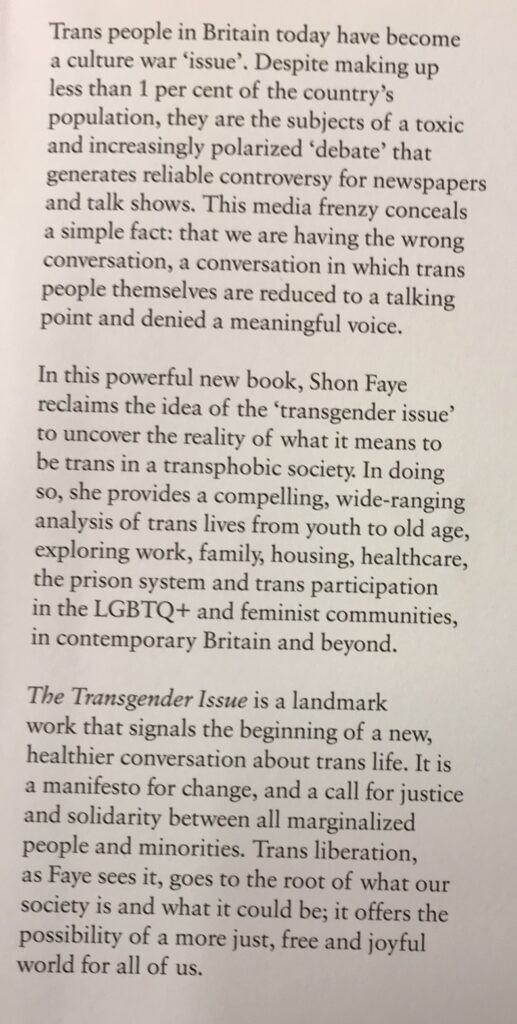
this wonderful book raises in my mind , what on esarth should the police and anti psychotic drugs , along with a lying corrupt psychiatrist Dr C R Ramsay of Aylesbury’s Whiteleaf Centre have to do with my gender reassignment ? Mine is an interesting story and hopefully not over yet.

R J Cook
September 15th 2021 – Roberta Jane Cook denied female hormones now, as well as the 3 years over due Gender Reassignment Surgery , blocked by still withheld third party 2017 allegations. Disclosures denied by all official parties – significantly London’s Gender Identity Clinic -since Roberta refused to accept being a paranoid delusional anti social bi polar schizophrenic.

Semi nudity is essential to the ongoing saga , as humiliating & embarrassing as it is to me.
There is little to see behind the white square,
Image Copyright Appledene Photographics. .
Introduction – August 22nd 2021
In view of my appalling experience with London’s Gender Identity Clinic ( GIC ) following the malicious police interference in my case , via my GP, I have decided to look at my gender history and the wider issue of transsexualism. A great deal of my history is already covered on the Toxic Transgender Clinic’ home page. However , the matter is becoming ever more contentious and the hate criminals persecuting transsexuals are abundant, especially with feminists , Islamists and also in the police.

Malicious Police interference led to me being diagnosed as paranoid schizophrenic , delusional and with abnormal psychology , in April 2018 when I should have been listed for gender reassignment surgery, after living as a woman for two years and hormone treatment. The GIC forced a local psychiatrist, Dr C R Ramsay of Whiteleaf Centre , on me after I had been out since midnight working as a long distance truck driver.
Through the GIC, Ramsay visited , threatening sectioning if I refused him entry, for 3 x 45 minute sessions. He told me in advance that the GIC wanted a strong diagnosis, going on to lie on record that I had refused a second opinion..
Because of this , my sex change surgery was made conditional on me taking zombifying anti psychotic drugs. Apparently all of my complaints to and about the police were evidence of my paranoid delusion – even though the police have put in writing that they have refused to investigate anything, including what certain parties said in October 2008, to get me a PNC Criminal Marker and soft intelligence records of alleged domestic violence and stalking. The GIC and Norden House have admitted having secret correspondence about me , but refuse to disclose it.
I am in the position that concern for my son – who has been implicated in this malice- and my desperate need for gender reassignment surgery is making my life absoulte hell. Only my son has kept me going.
To force my compliance with their chemical lobotomy , the GIC and my GP have stopped my hormone prescription and injections until I have waited to see a panel of psychiatrists to have them confirm to me that I am psychotic, and will eventually need hospital. This is terrifying and has gone on for nearly 14 years. It would no wonder if I was mad by now. Further court conflict Is this inevitable.
I had simply wished to turn the page and get on with my life as a woman ,in every sense of the word. I had waited a lifetime and suppressed my gender dysphoria which I felt from the age of 4. The police however, have other ideas.
Roberta Jane Cook


However , women’s groups and media have jumped on the trans exclusionary feminist bandwagon with the vicious and ridiculous excuse that men have sex change treatment and surgery to get into ladies toilets and rest rooms for the purposes of sex assault and rape. Most of sus do not want sex with them.
It is a feminist fantasy that women are so irresistible and need constant protection. They do need to act responsibly and recognise the types that rape – including Premier League footballers and police , where the common ingredient is power. these groups won’t like the would be rapist label , so why should transsexuals put up with it. Don’t ever forget PC Wayne Couzens.
An honest investigation into the explosion of sex change cases, with its obvious relationship to one parent families, negative make stereotypes and root cause ; untouchable feminism, will not be allowed. Terf intolerance , as with bigoted Muslims is O.K.
Feminising Nicely – August 23rd 2021
In 2003 my exwife told me I wouldn’t have a family if I didn’t do as I was told. That included not being allowed to talk to my young adult sons without her presence. That was when I realised I did not want to pretend to be man anymore. I decided I was happier as a woman in male company. So I was working on three commissioned books. One was about changing Southampton. It meant staying away from home. In doing so, I decided to do all of the research ene femme as Roberta.

Her partner had told her early in 2003 she could not talk to her sons without her presence. Otherwise she would have no family. Under this pressure and being used to physical and verbal abuse, Roberta sought consultations with Dr Russell Reid as she sought refugse in her female identity, something she had done since early childhood..

and take some responsibility for their safety.
Don’t go to dangerous places
as I am doing in this picture. You would certainly meet the police around here !
Roberta Jane Cook
How We Dress Affects How We See The World And How That World Sees Us – August 22nd 2021.

Image Copyright Appledene Photographics 2008


Be the first to comment on "Trans Action – Transsexual World"